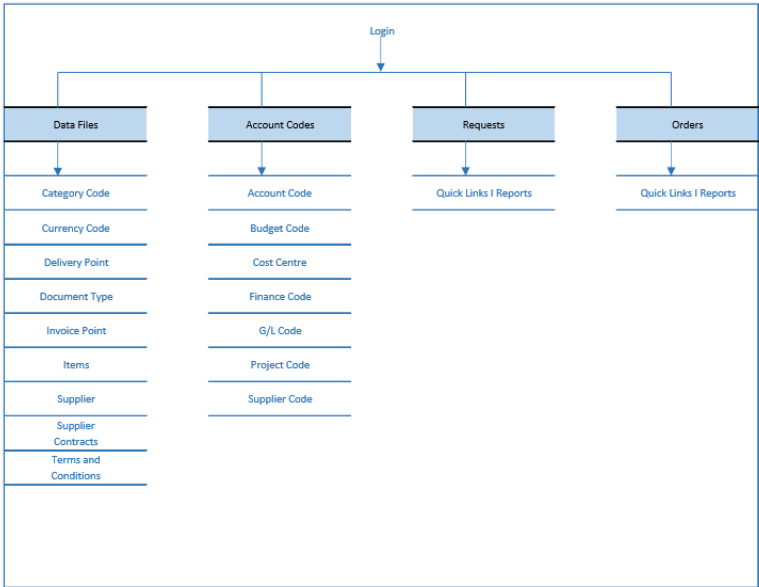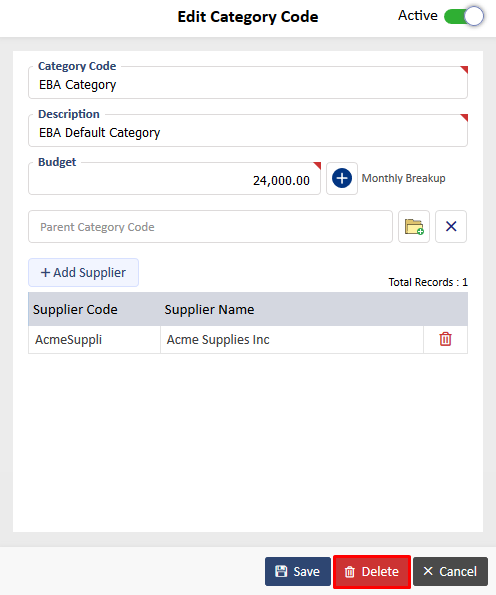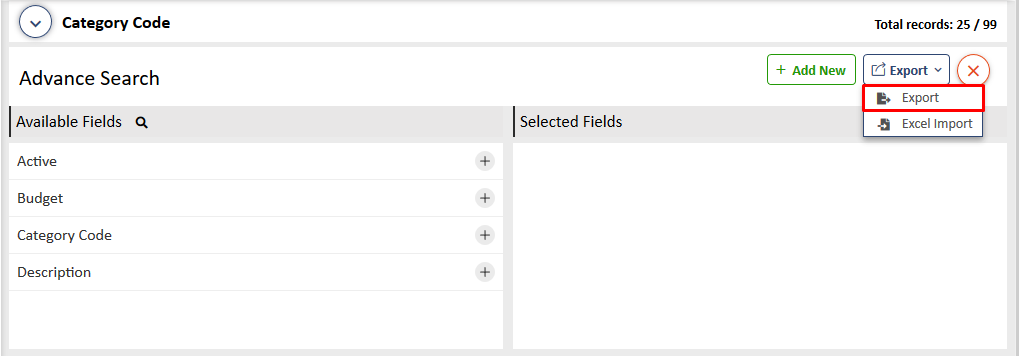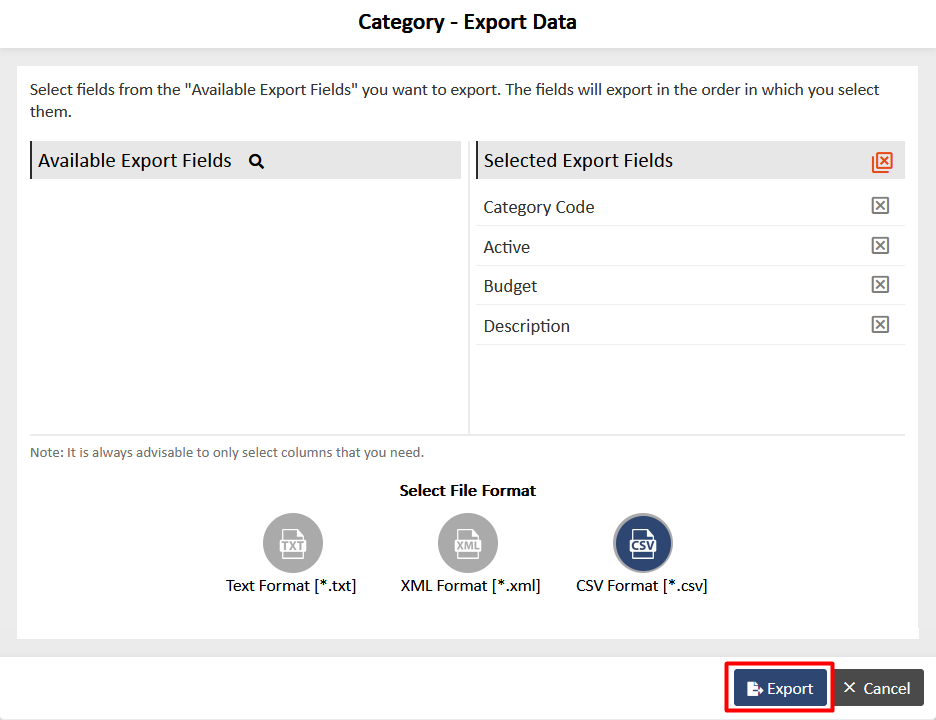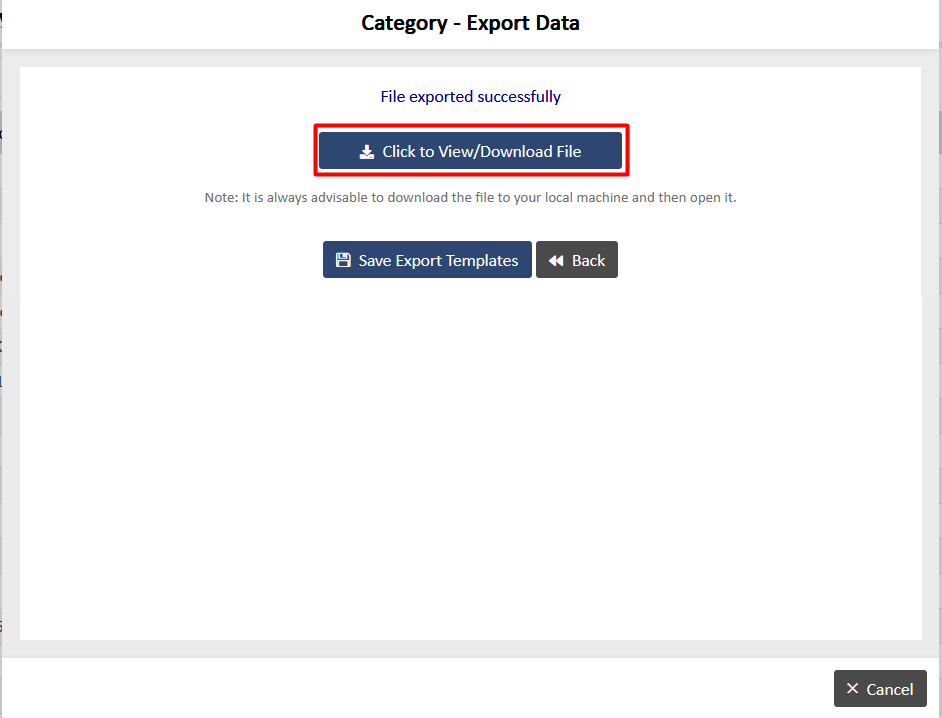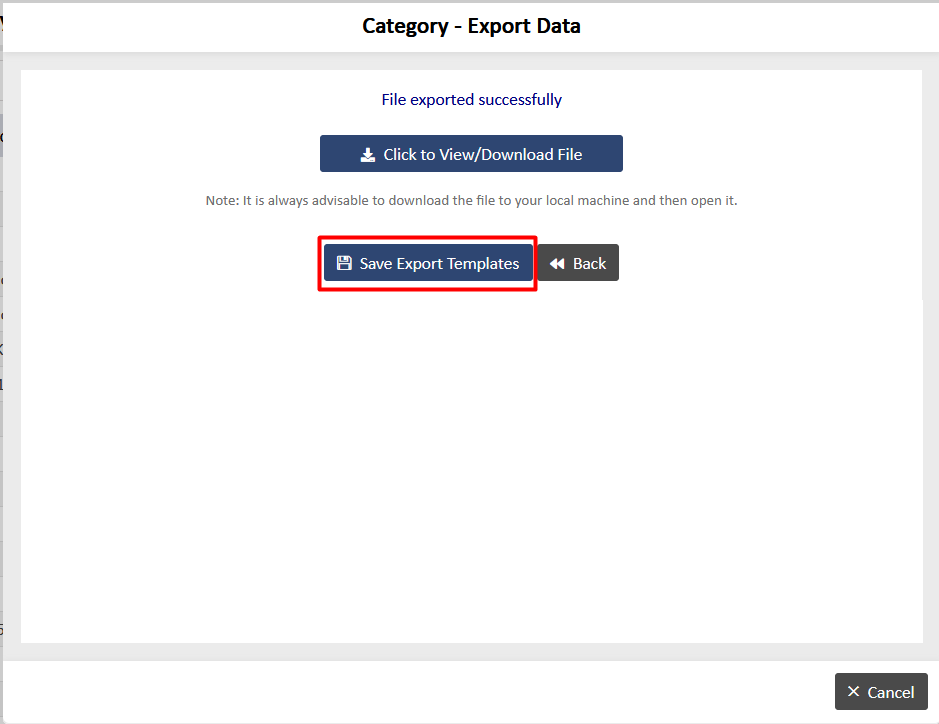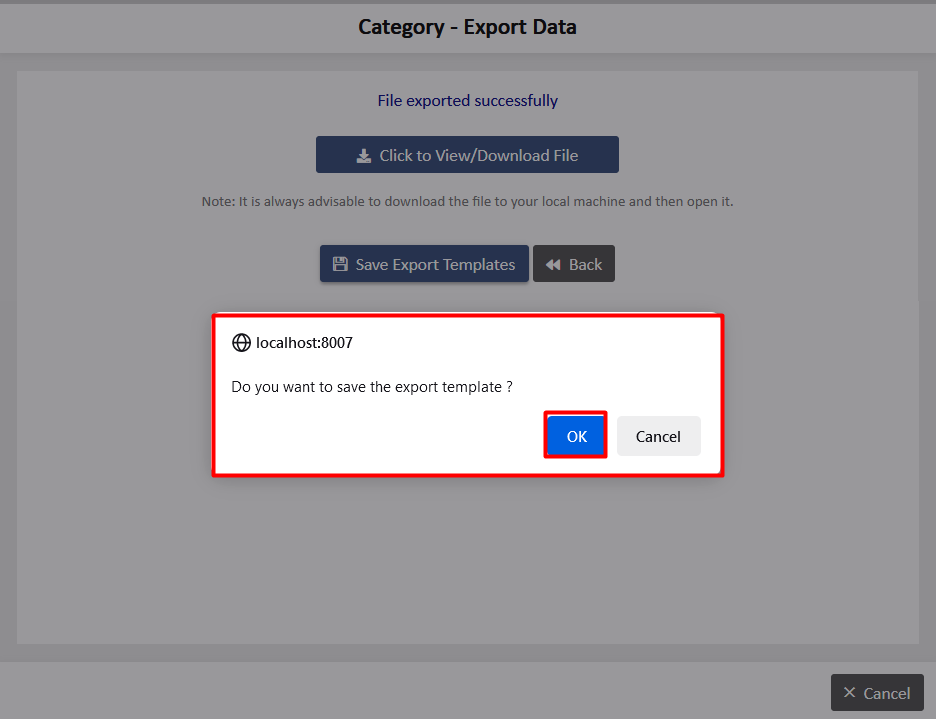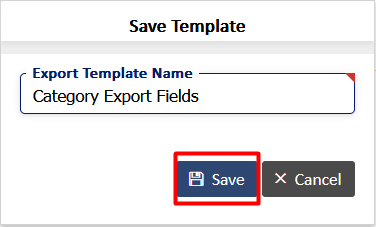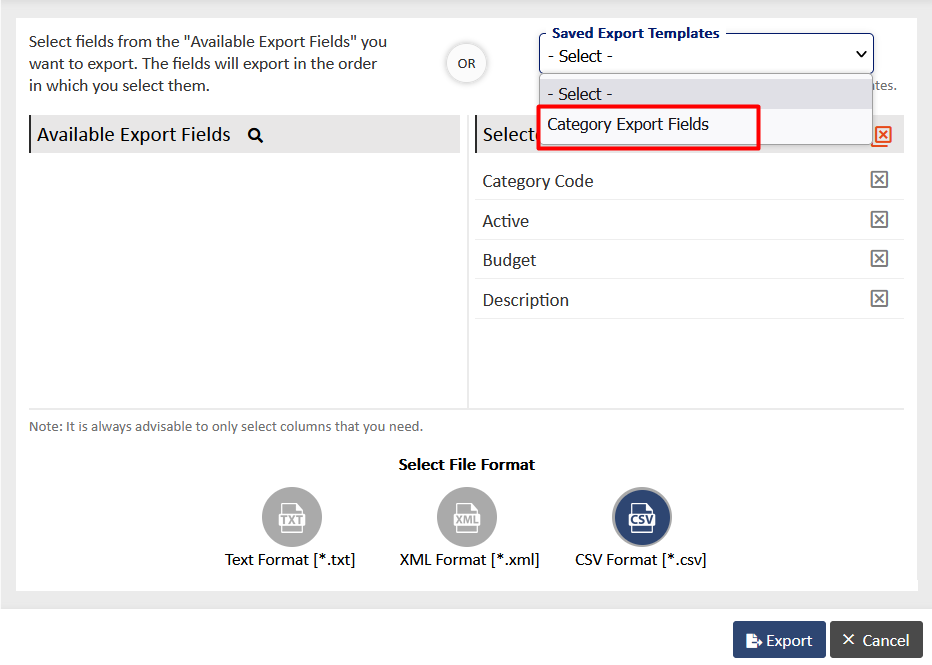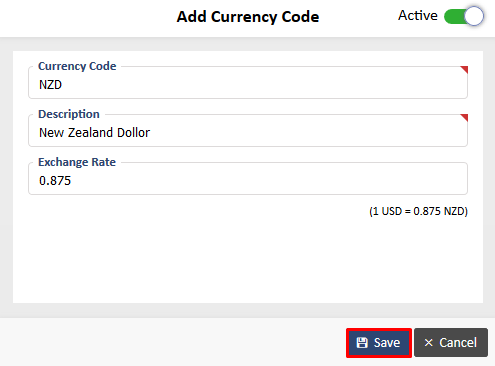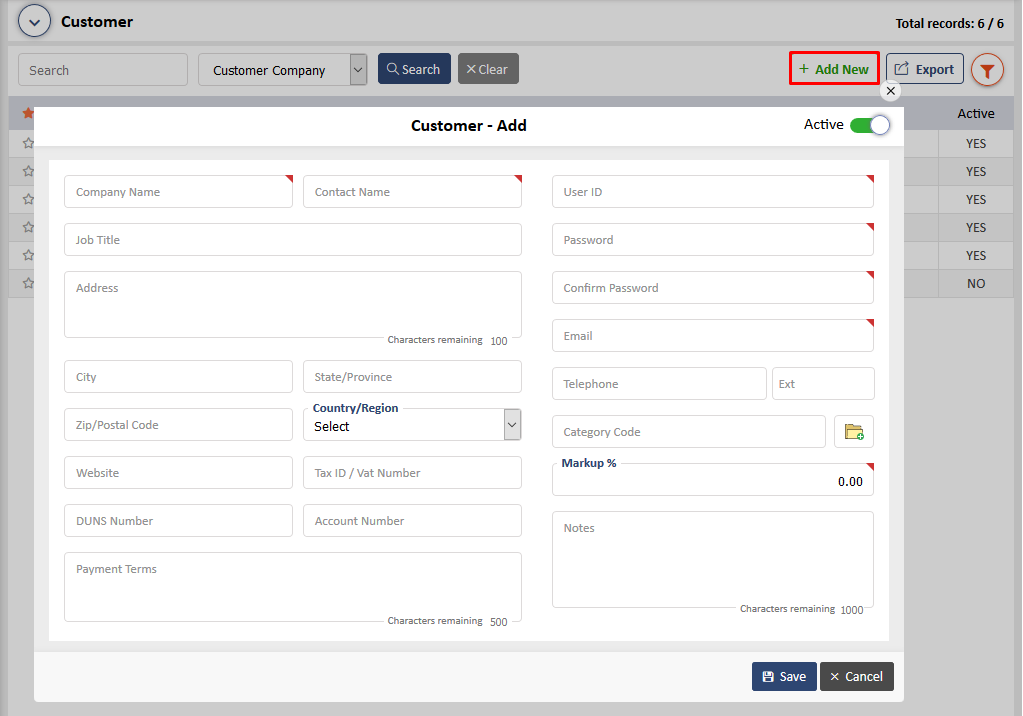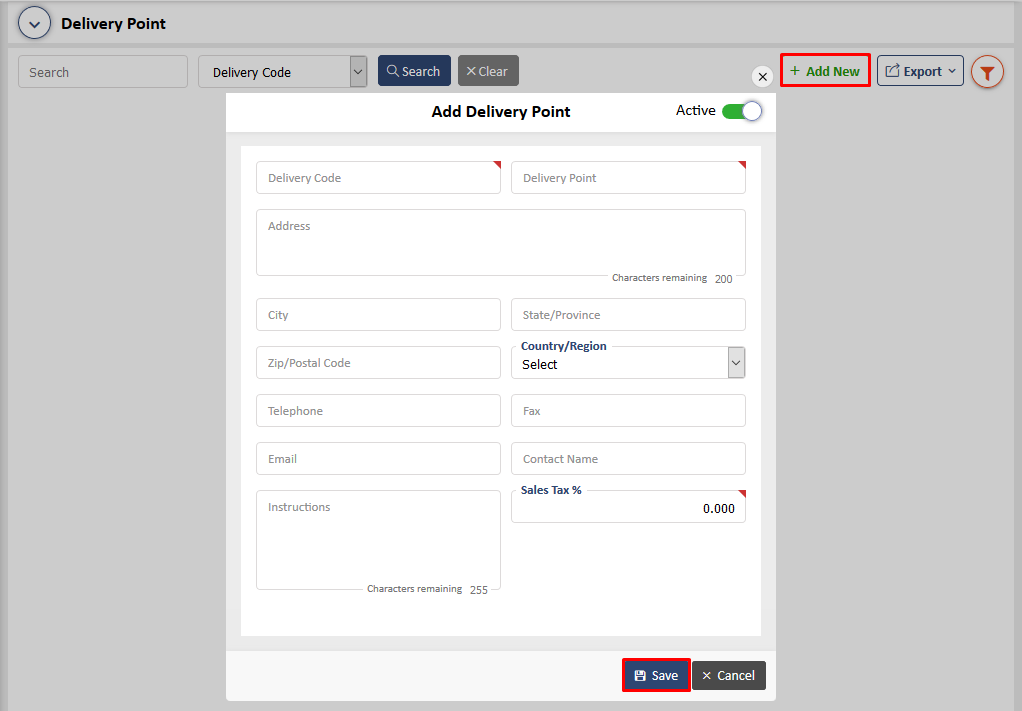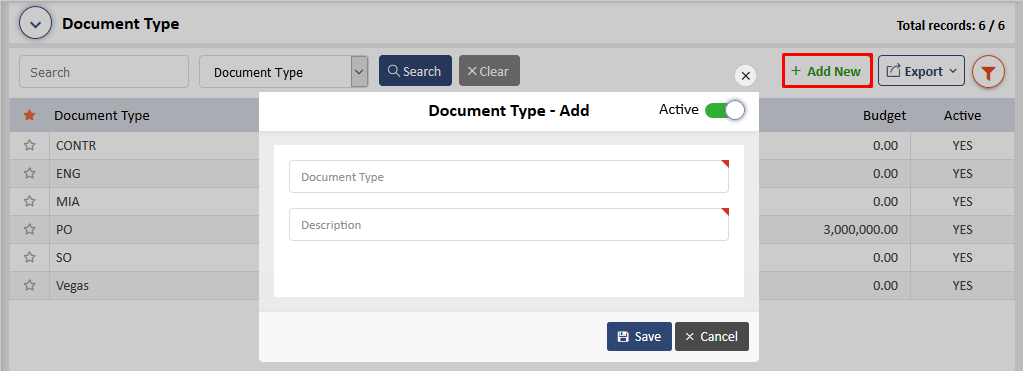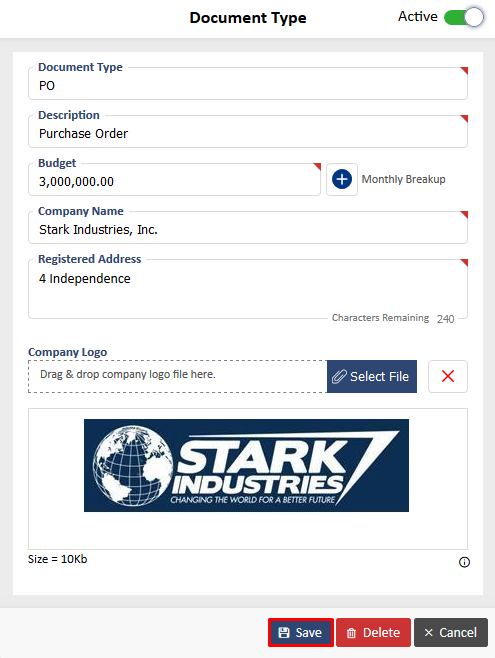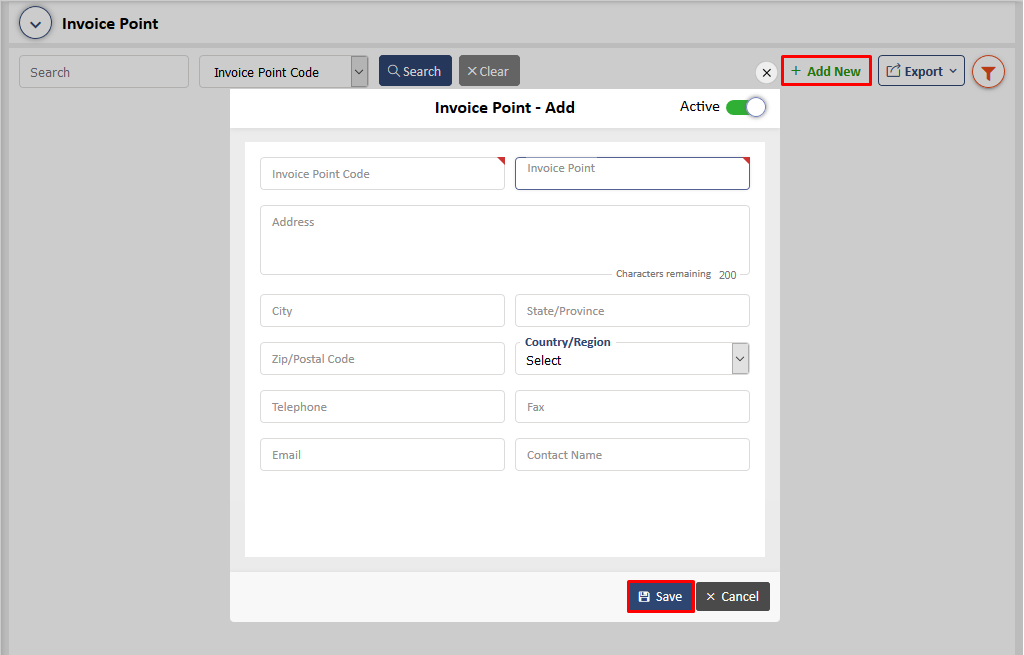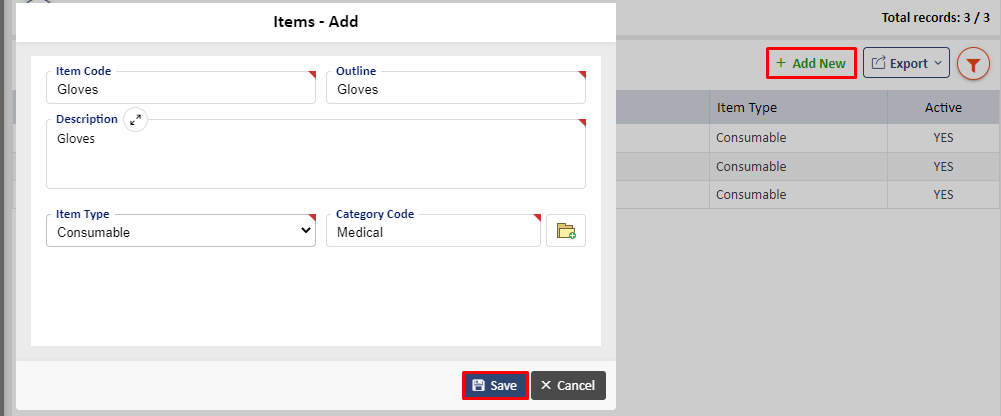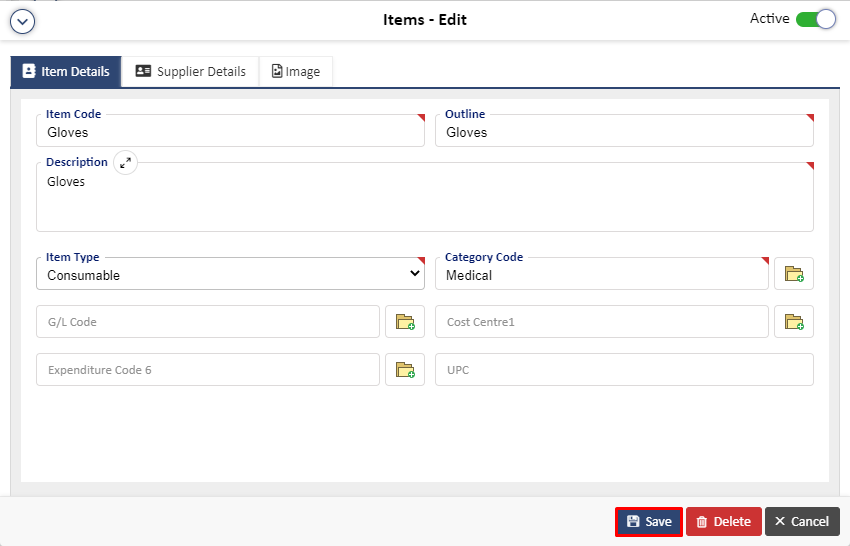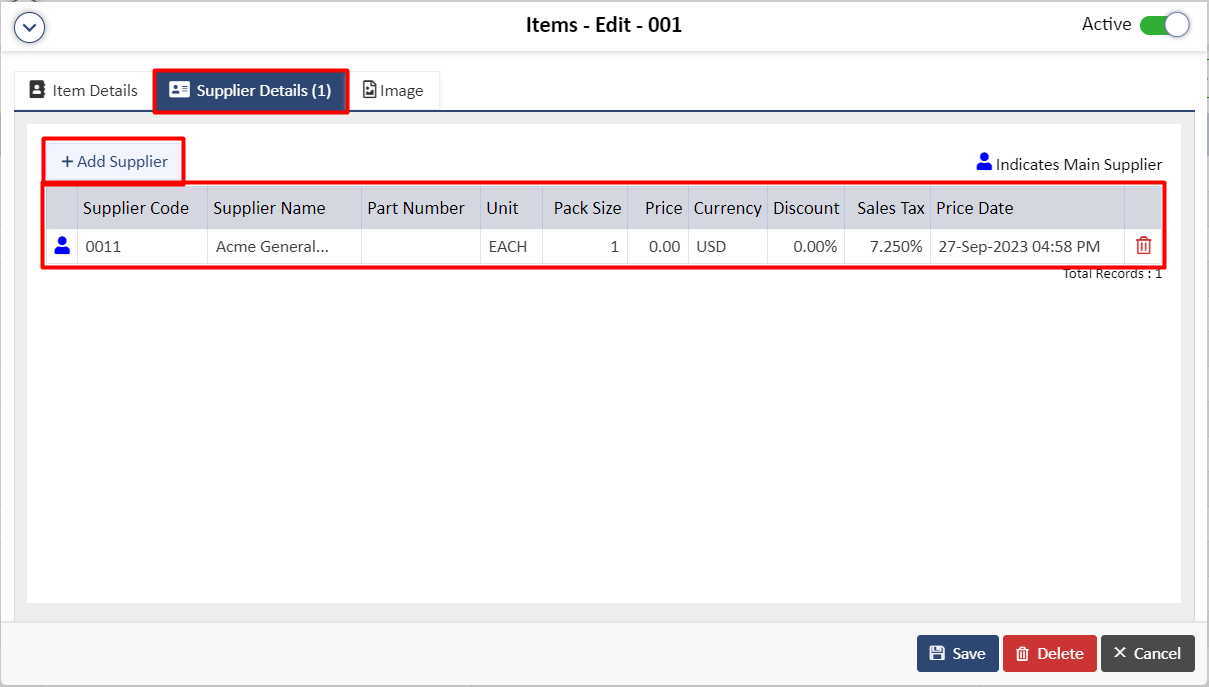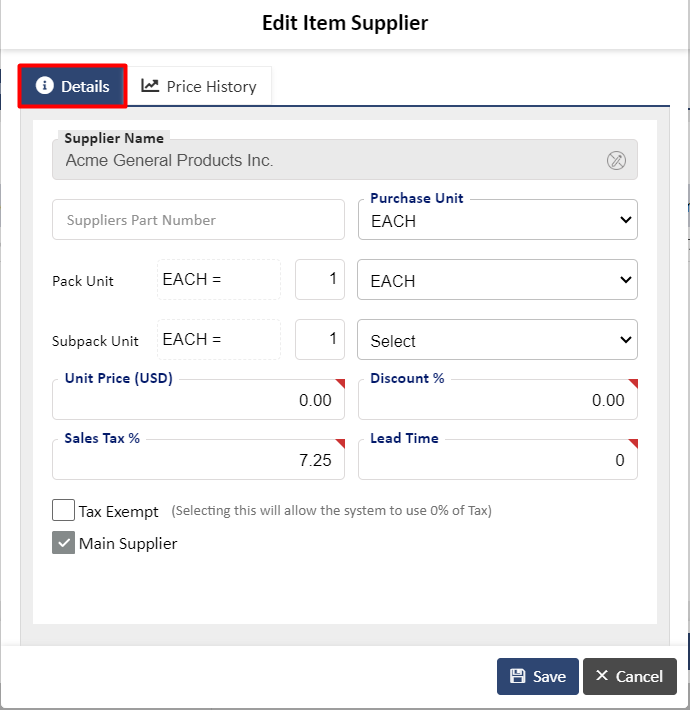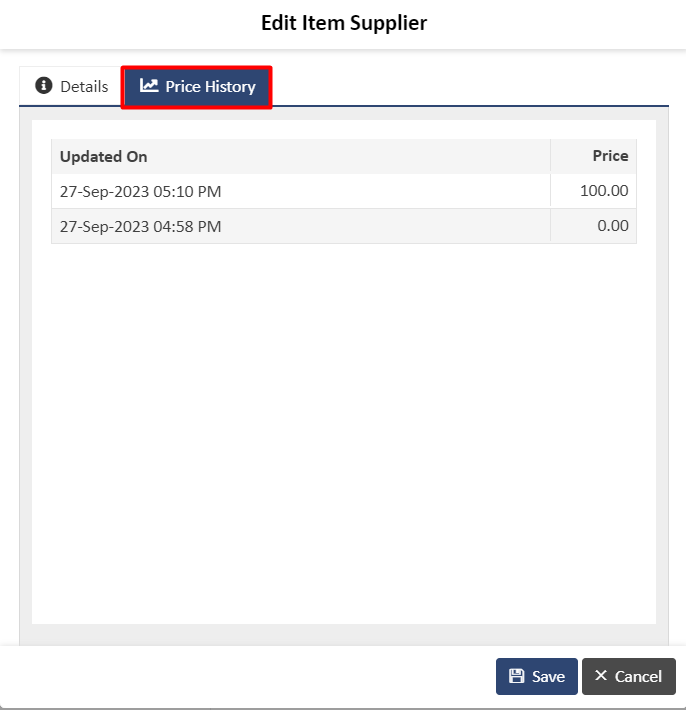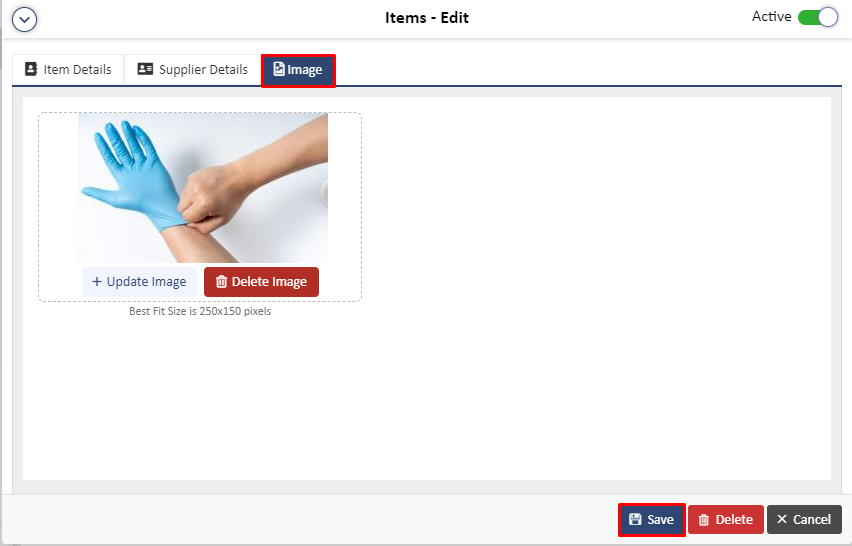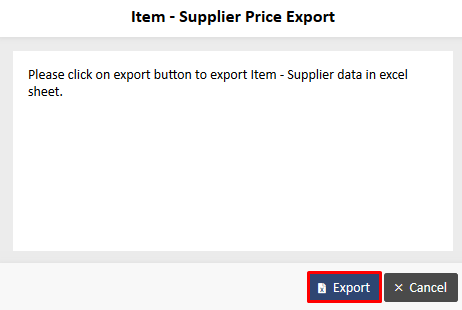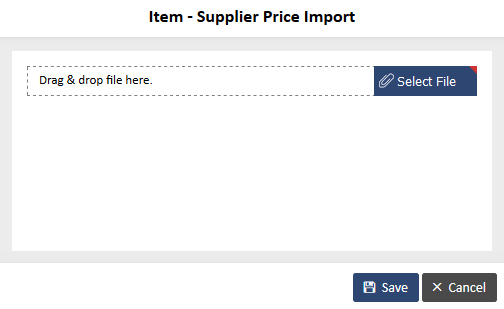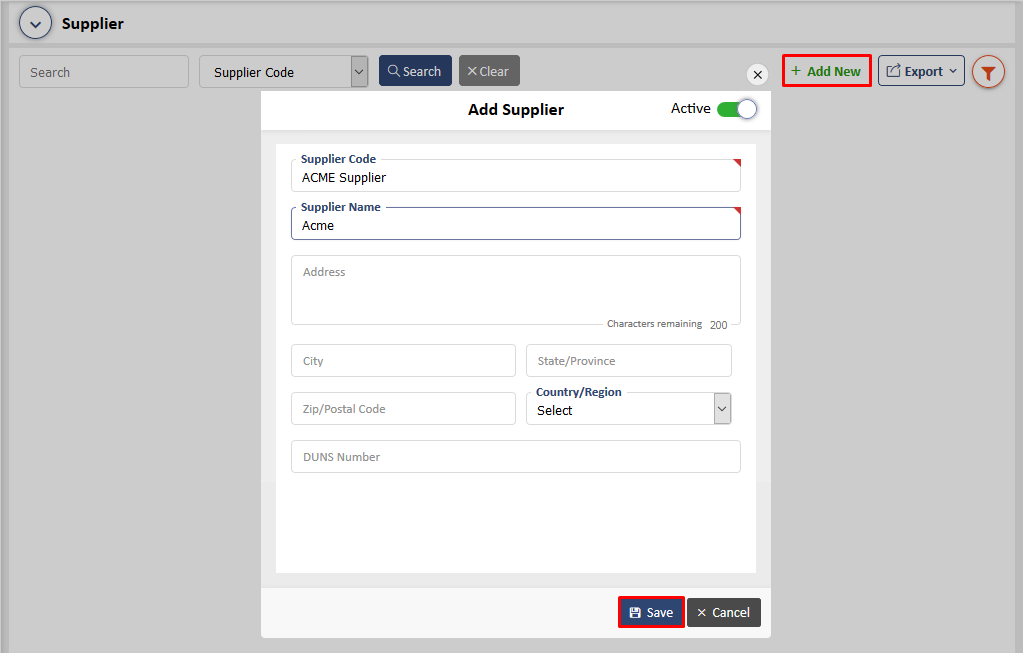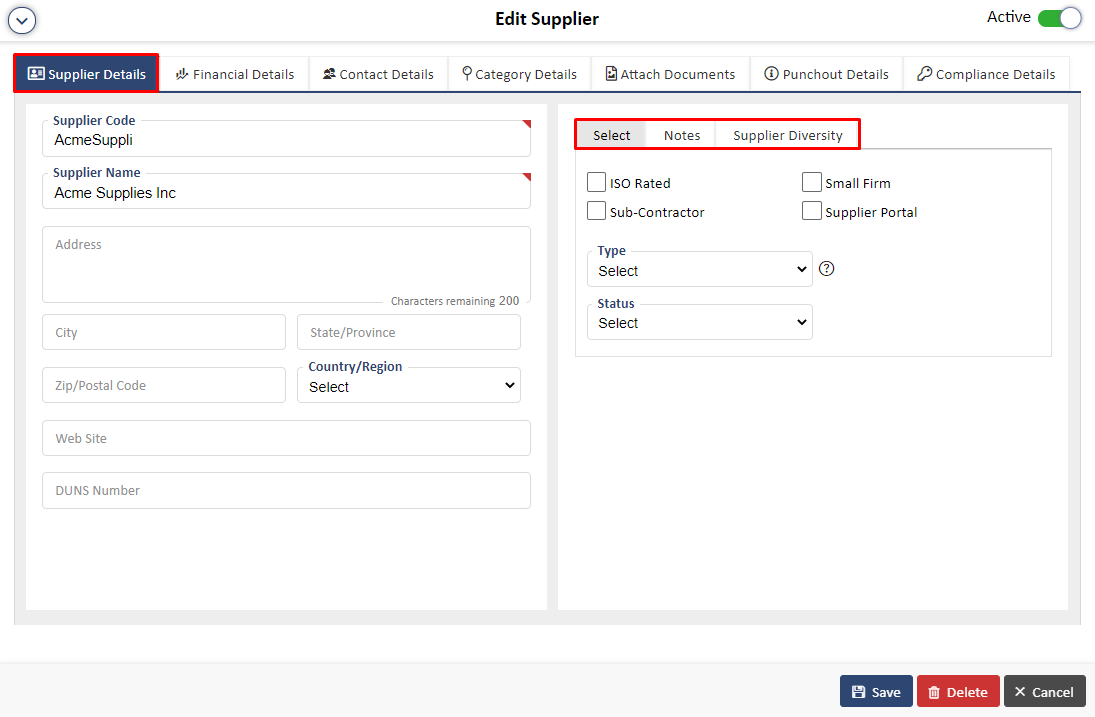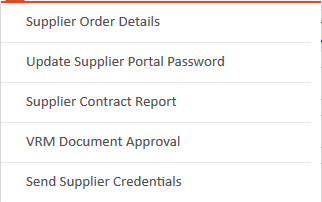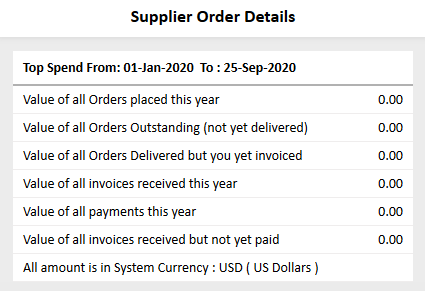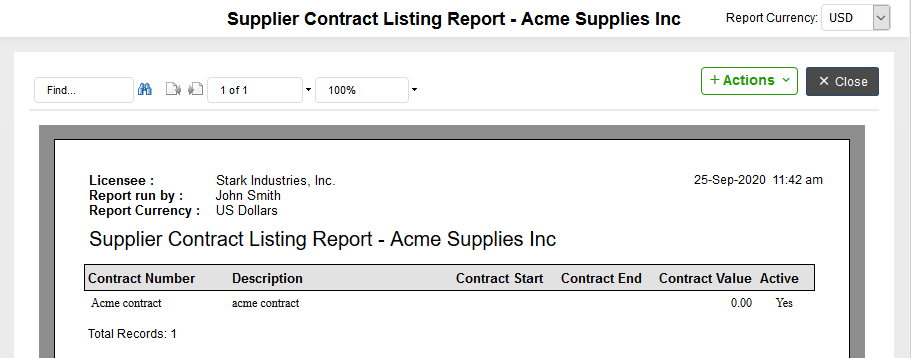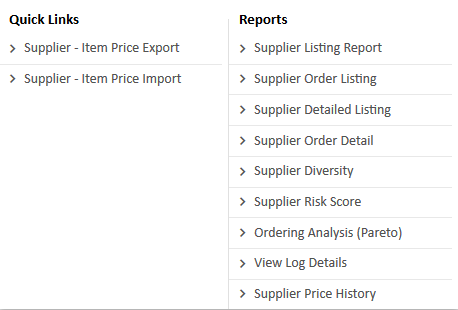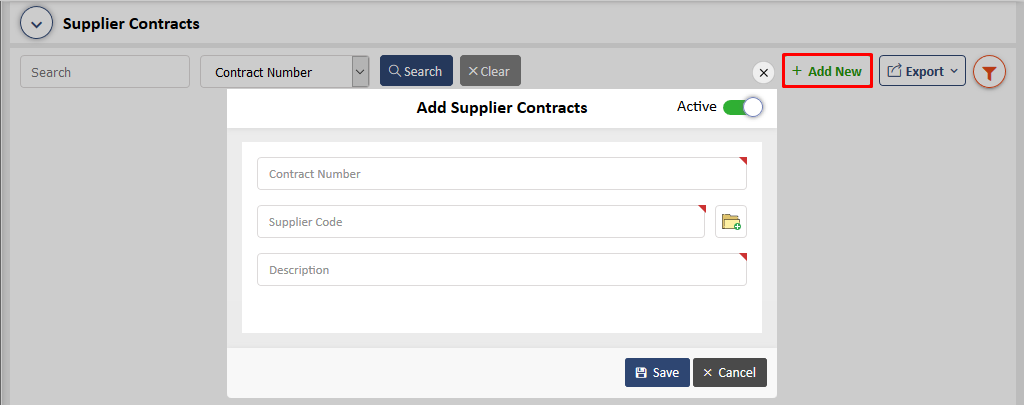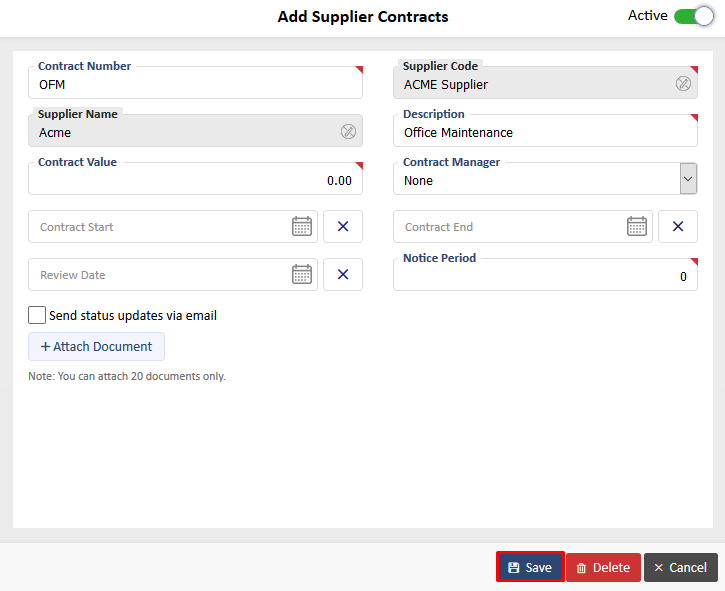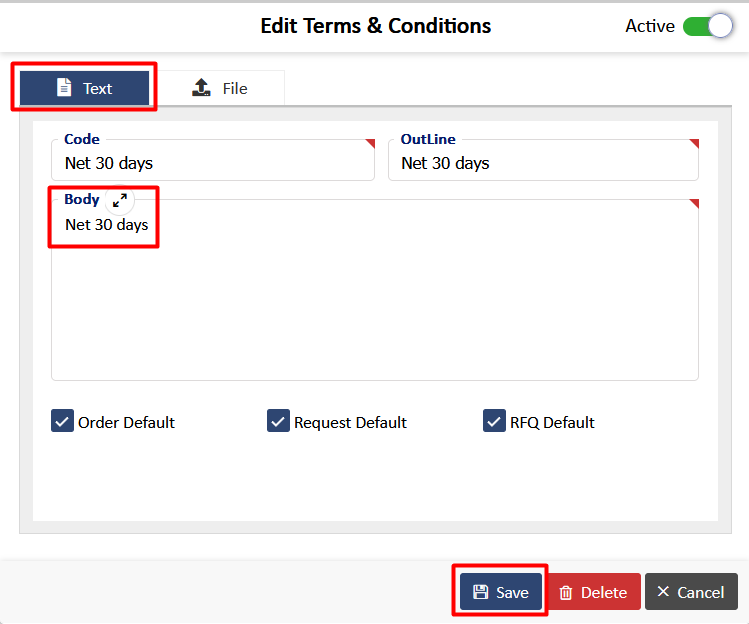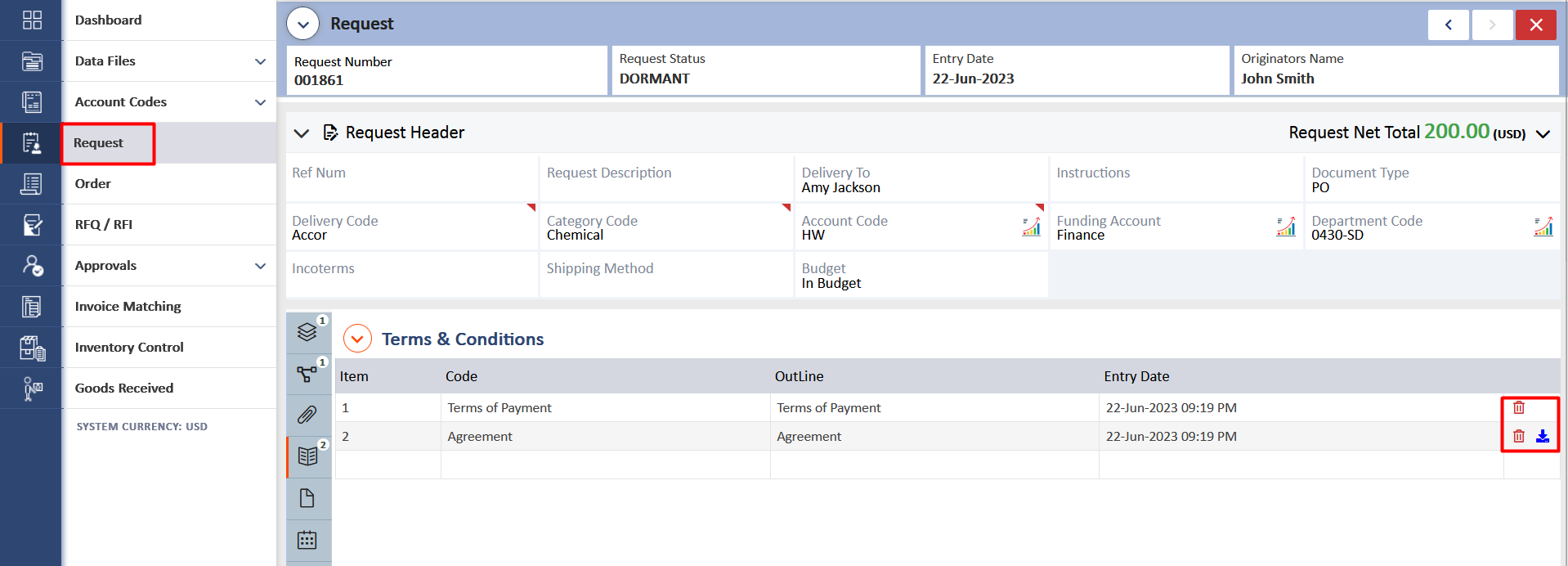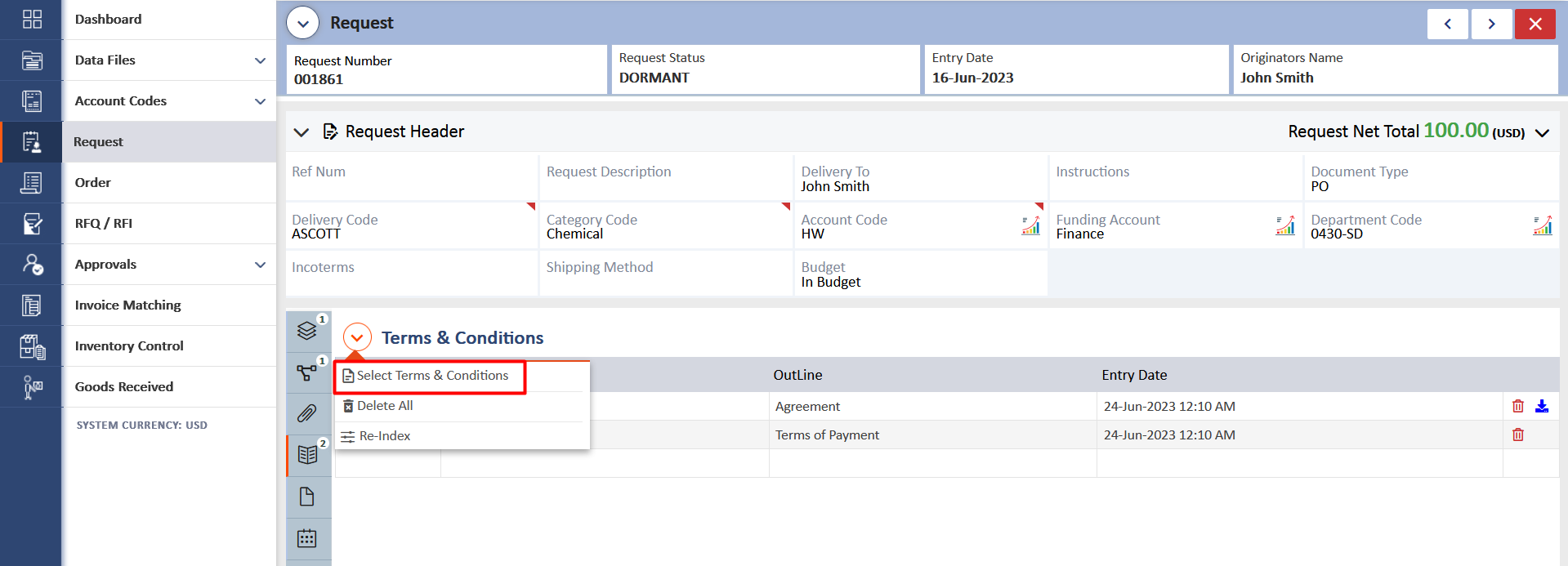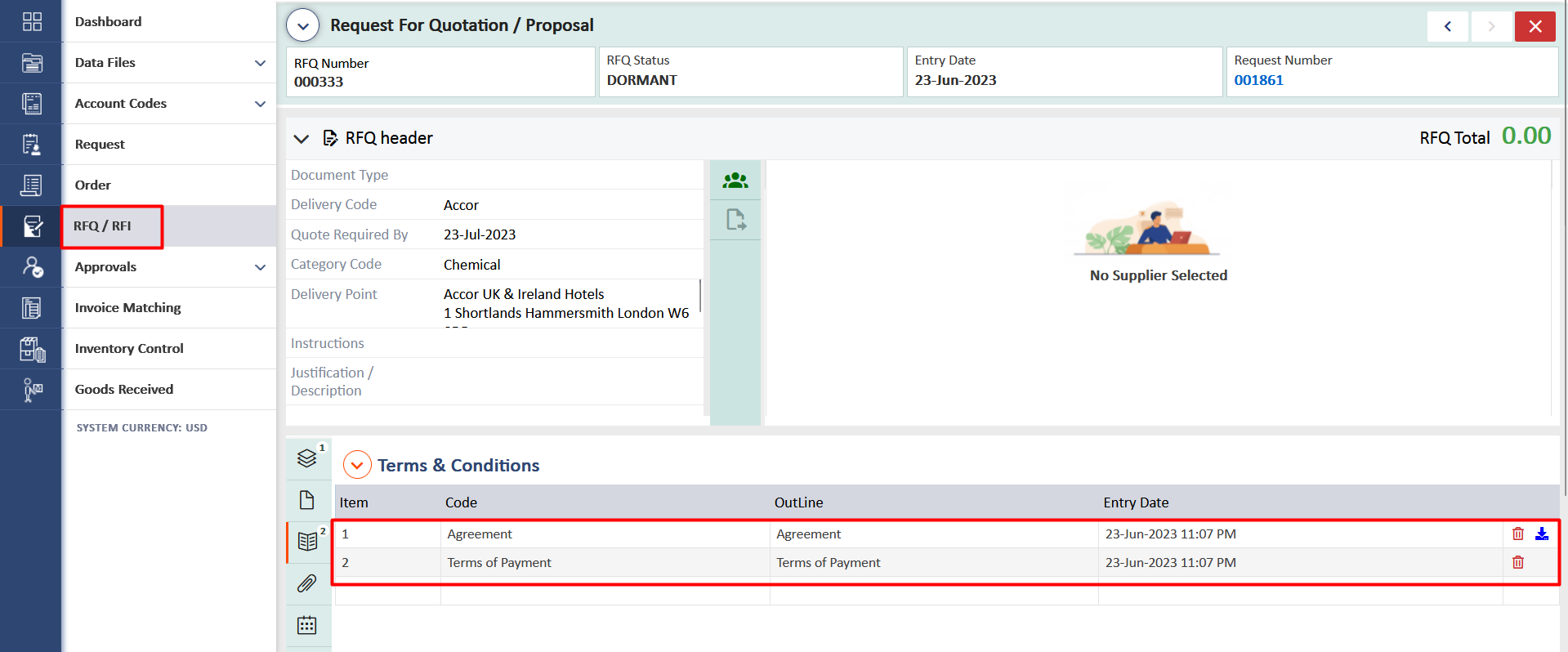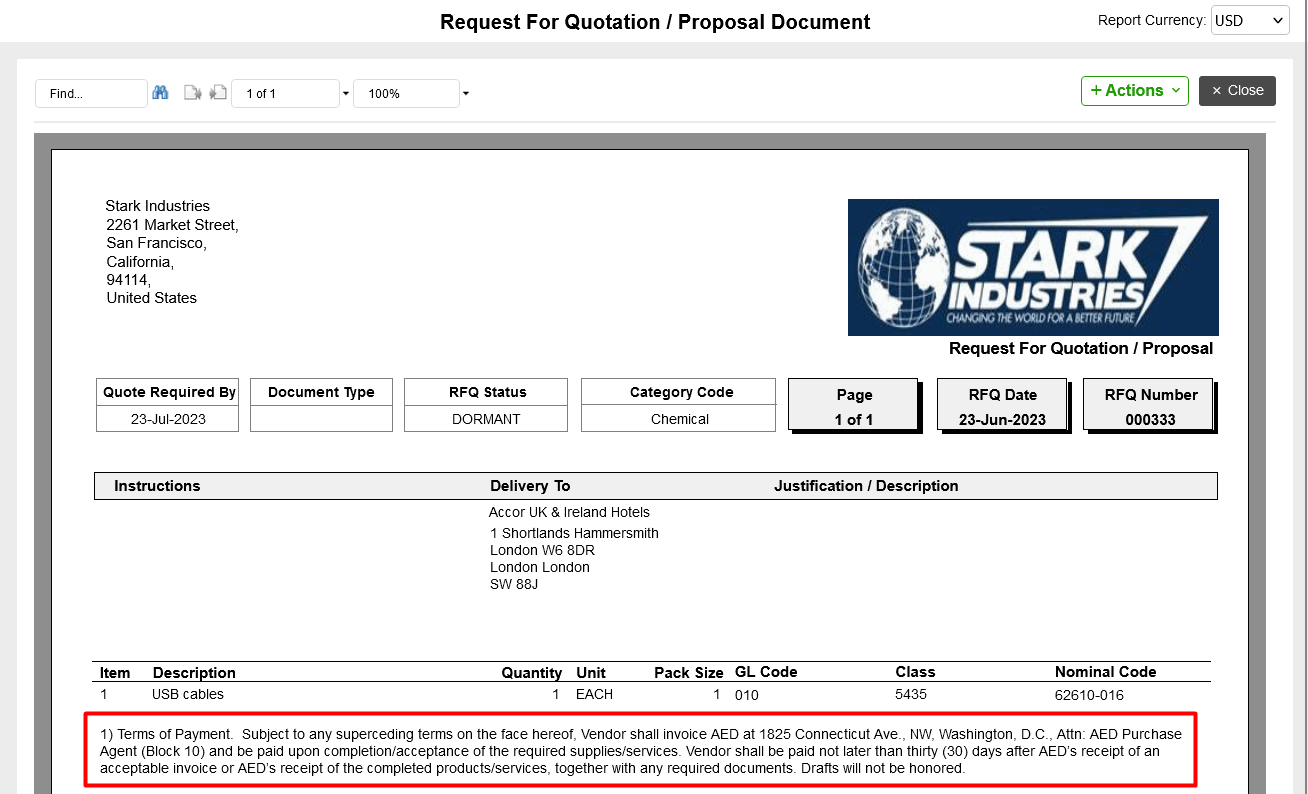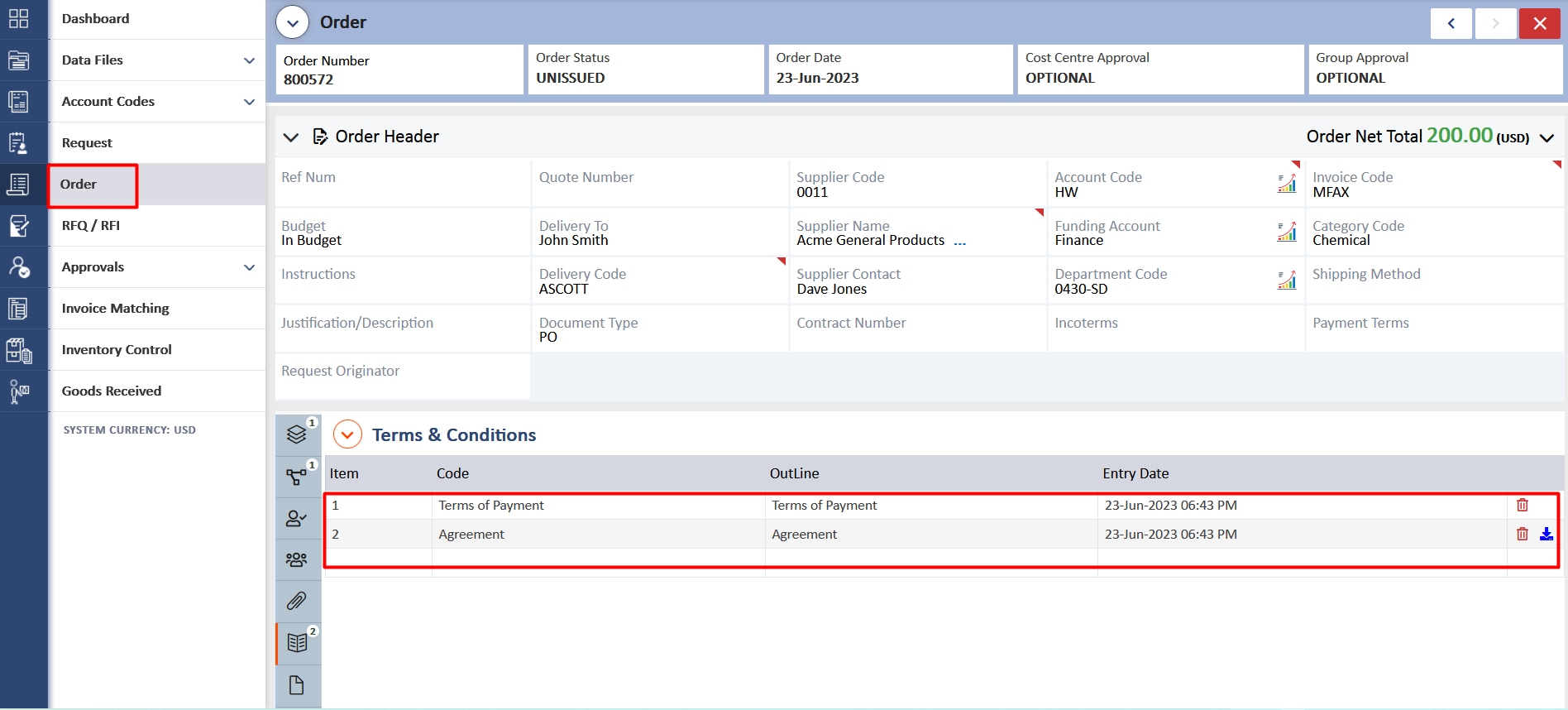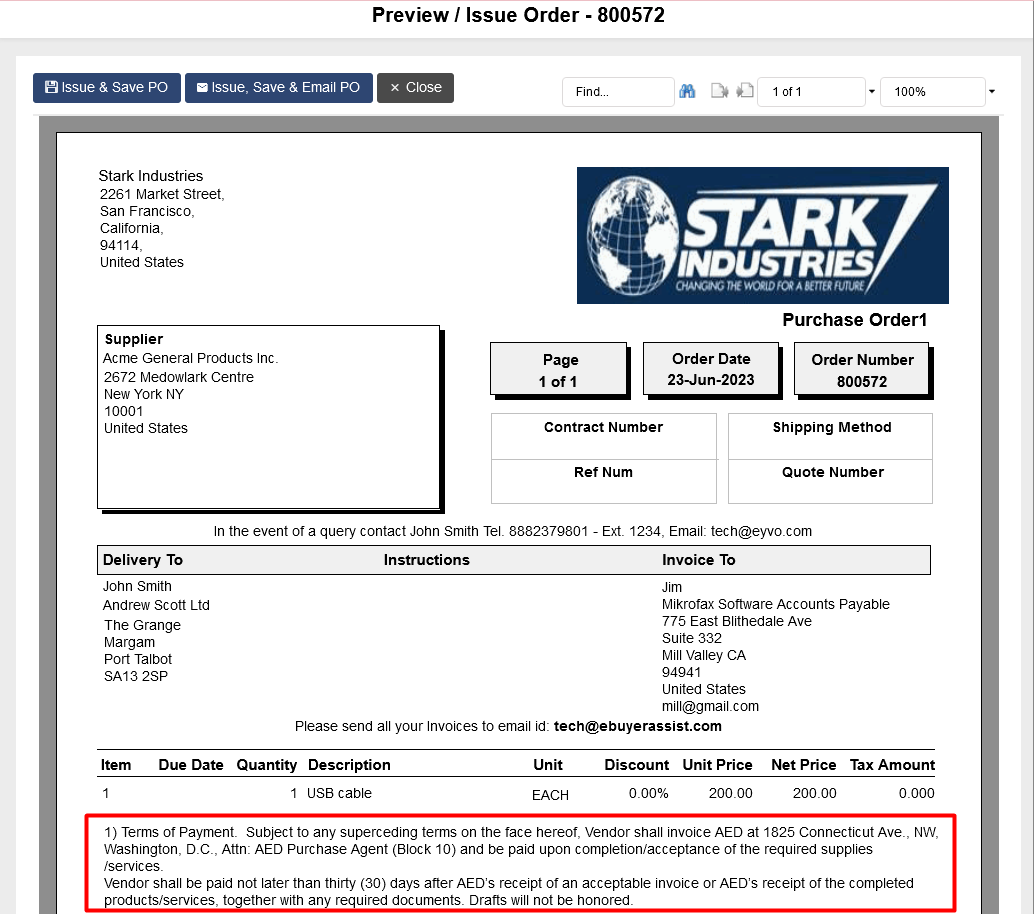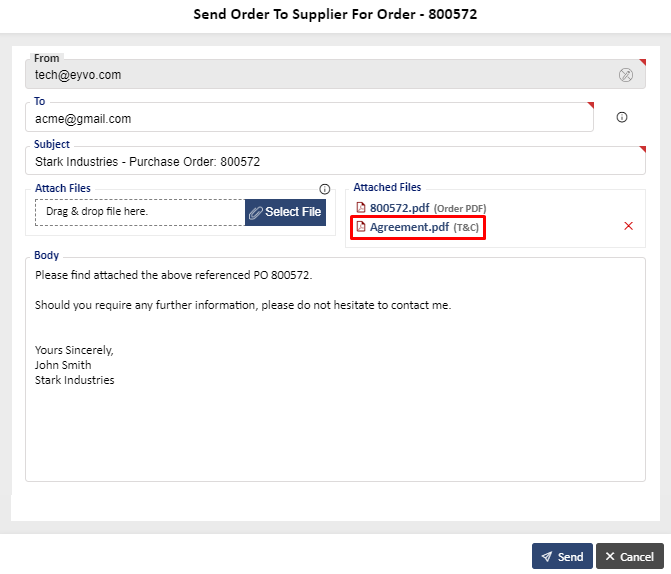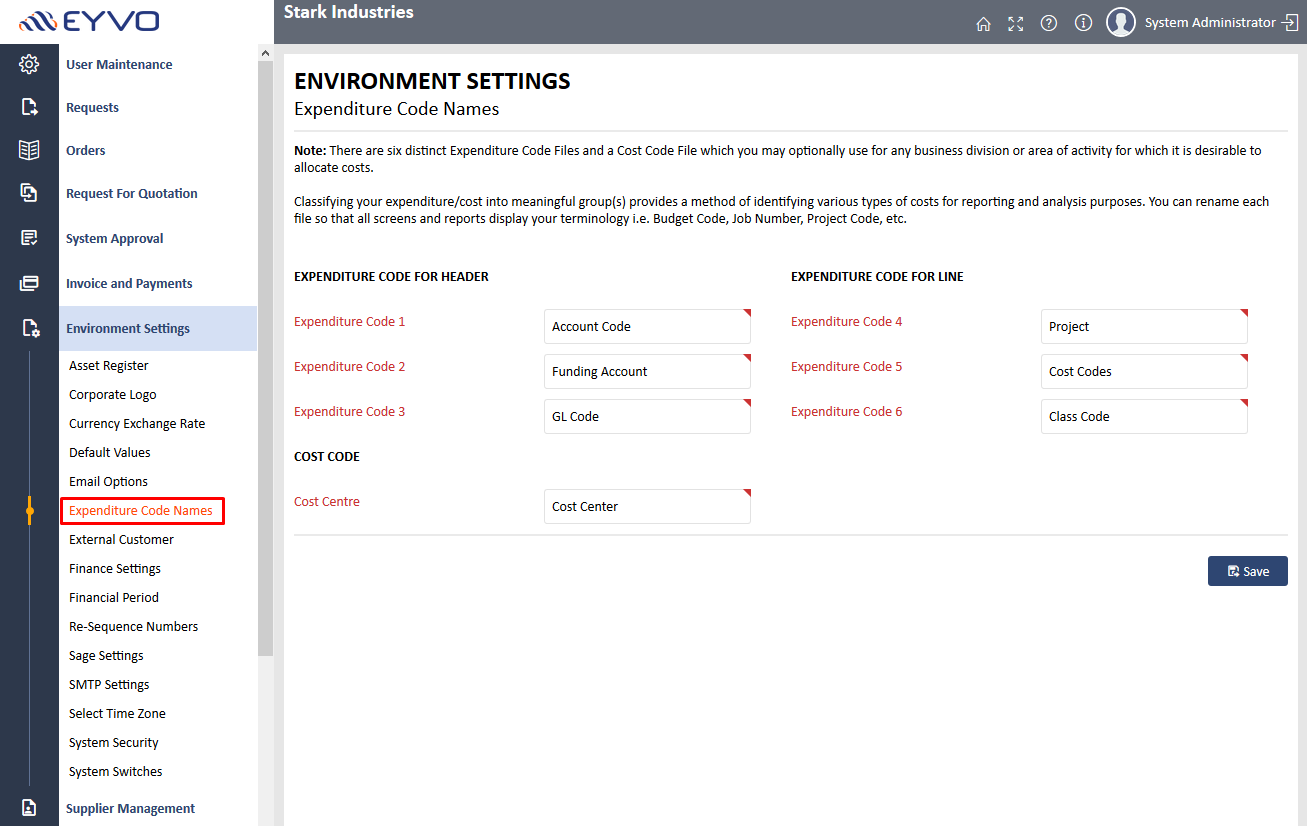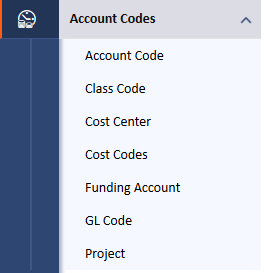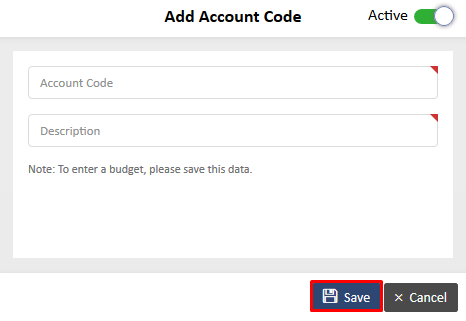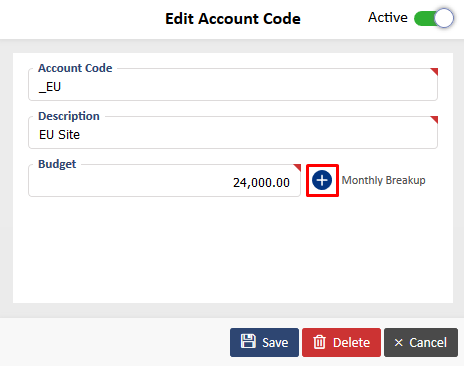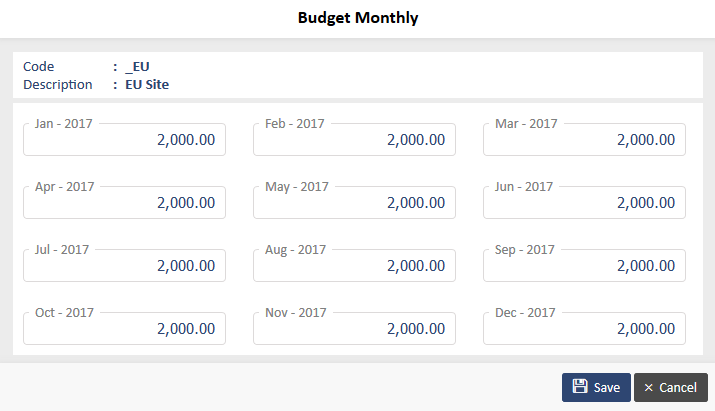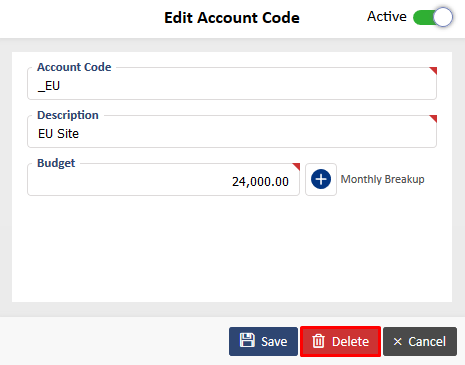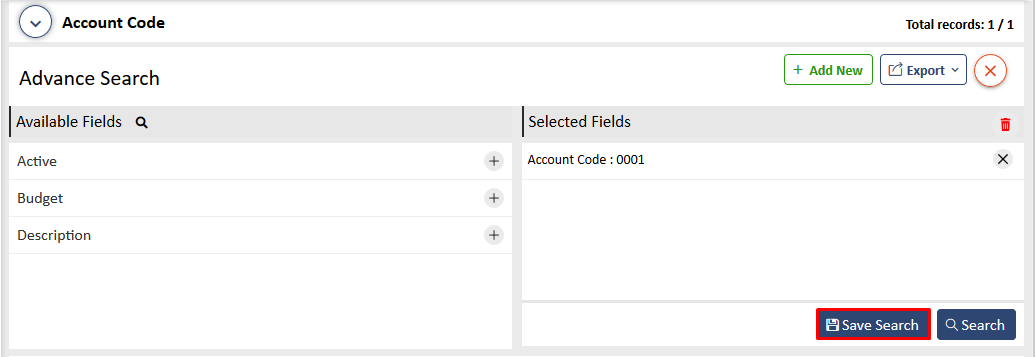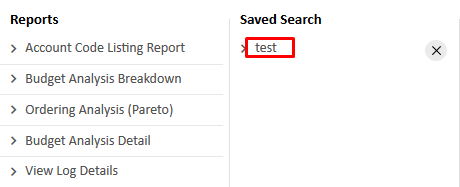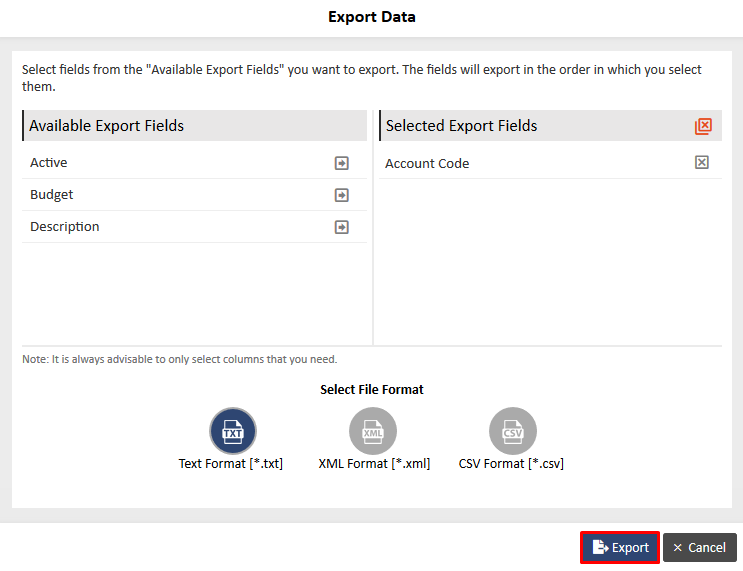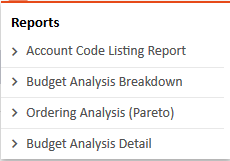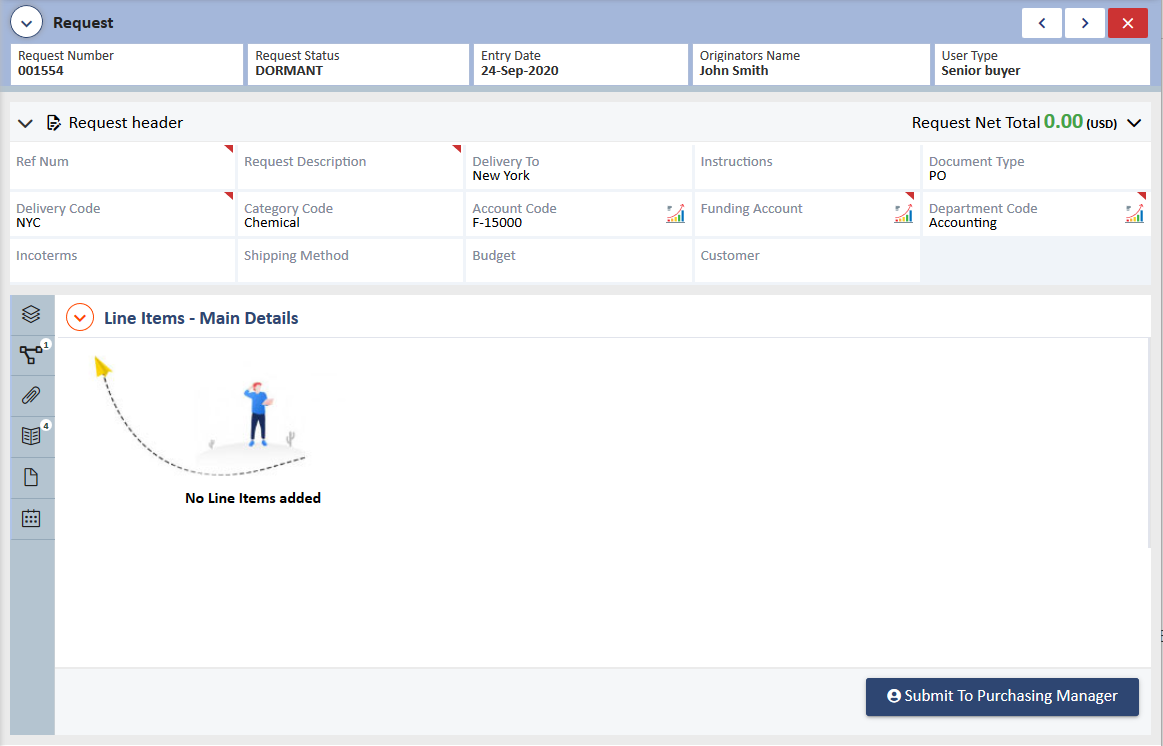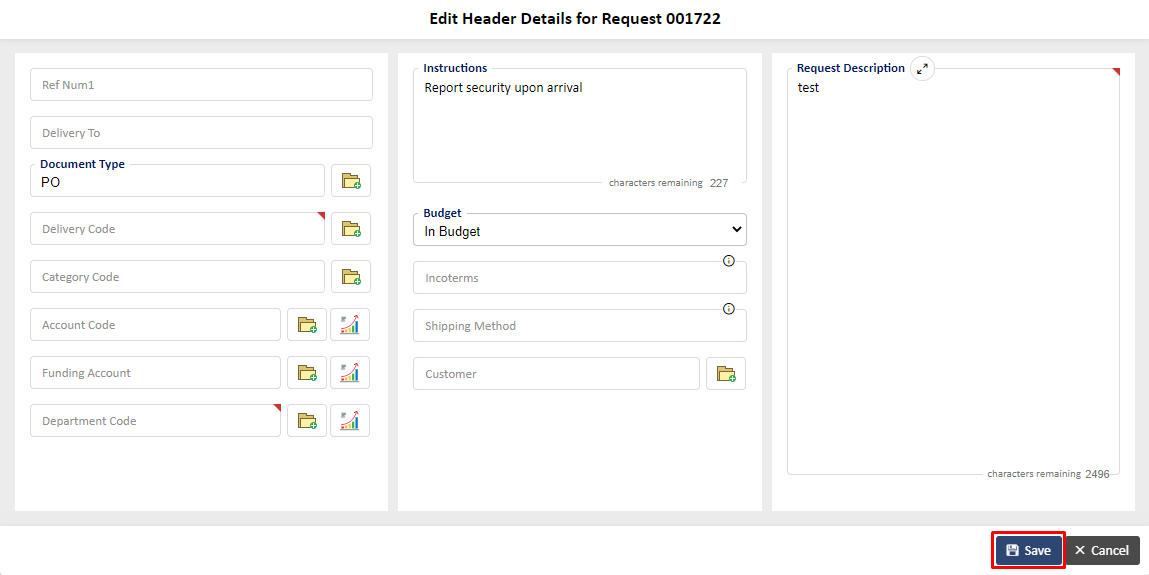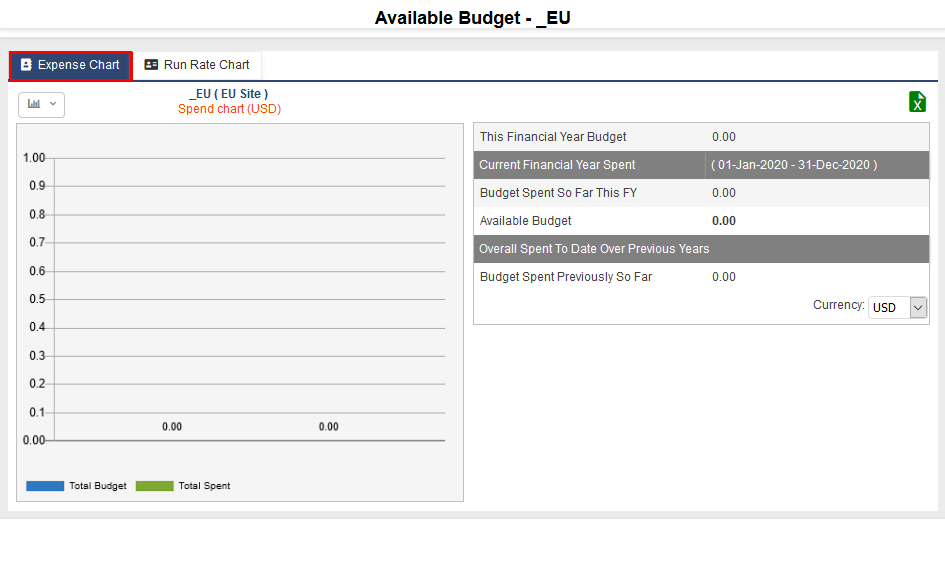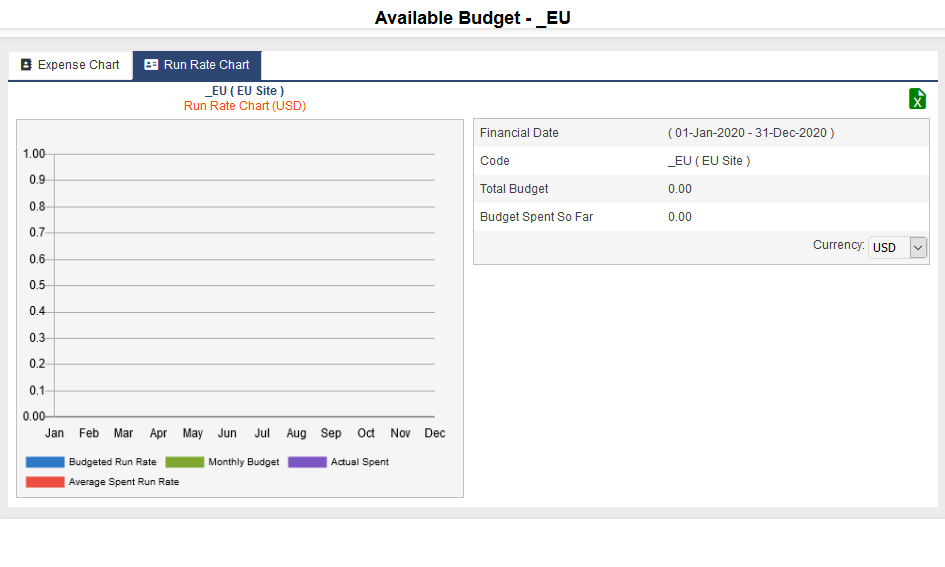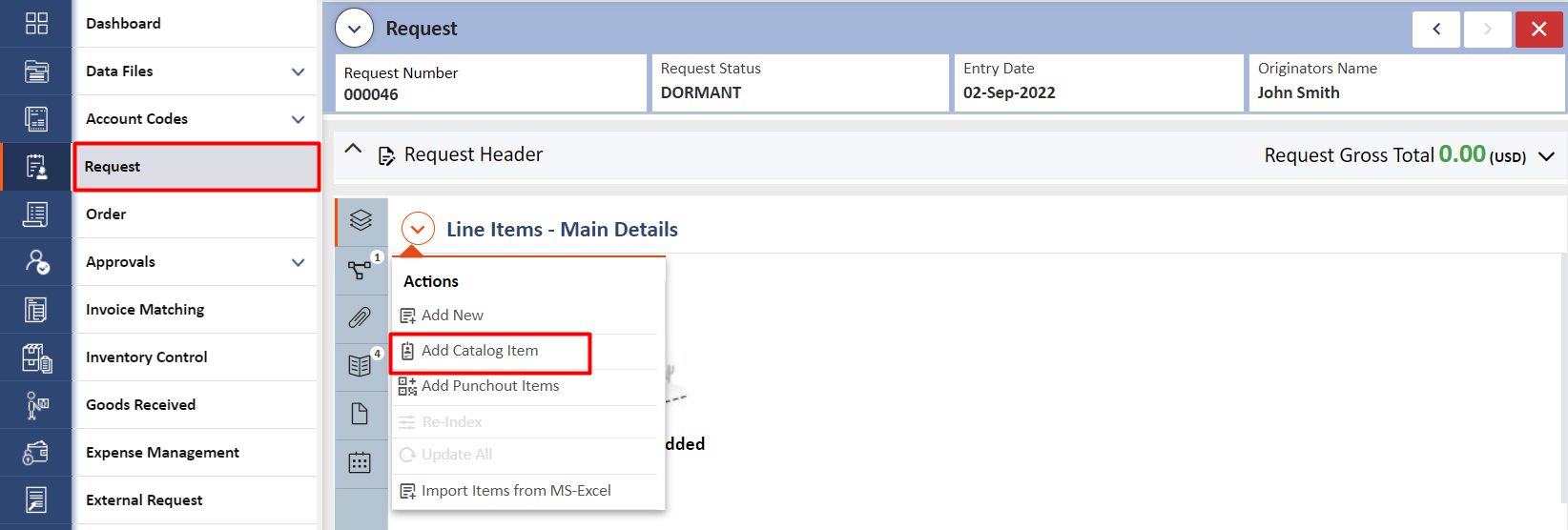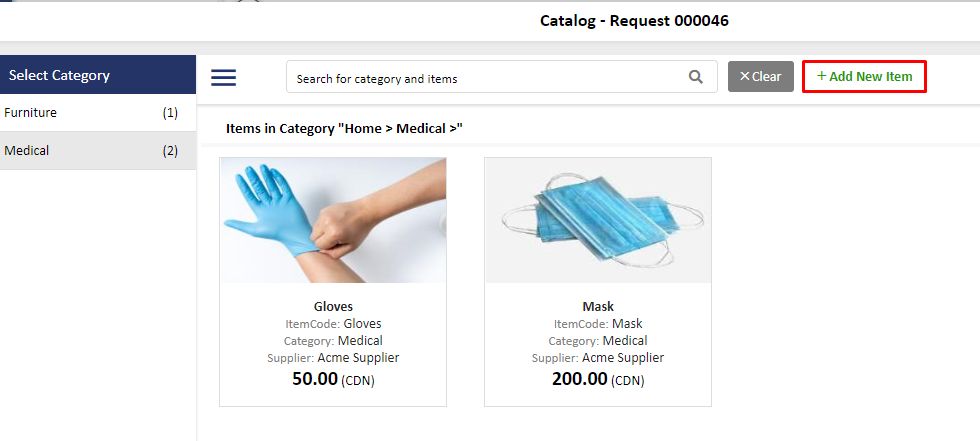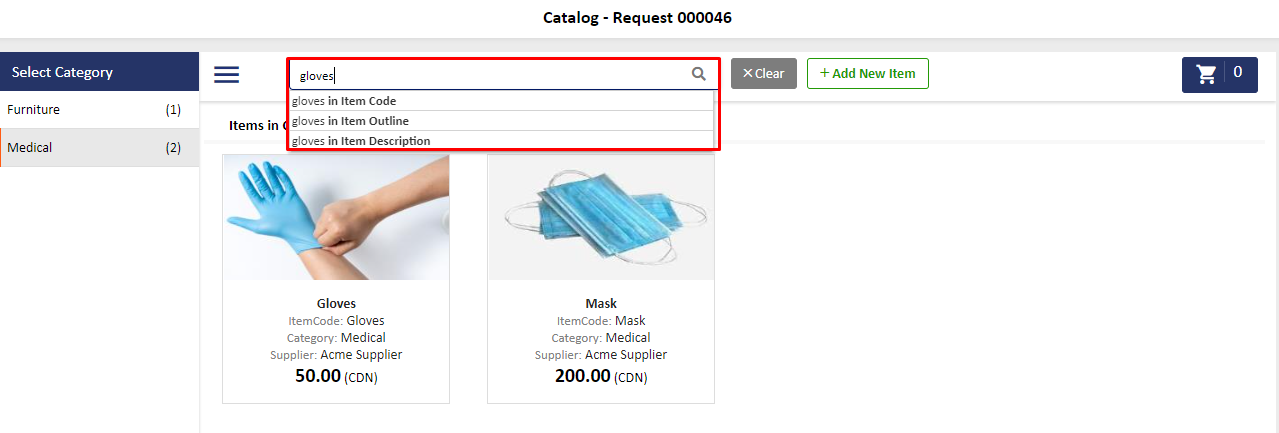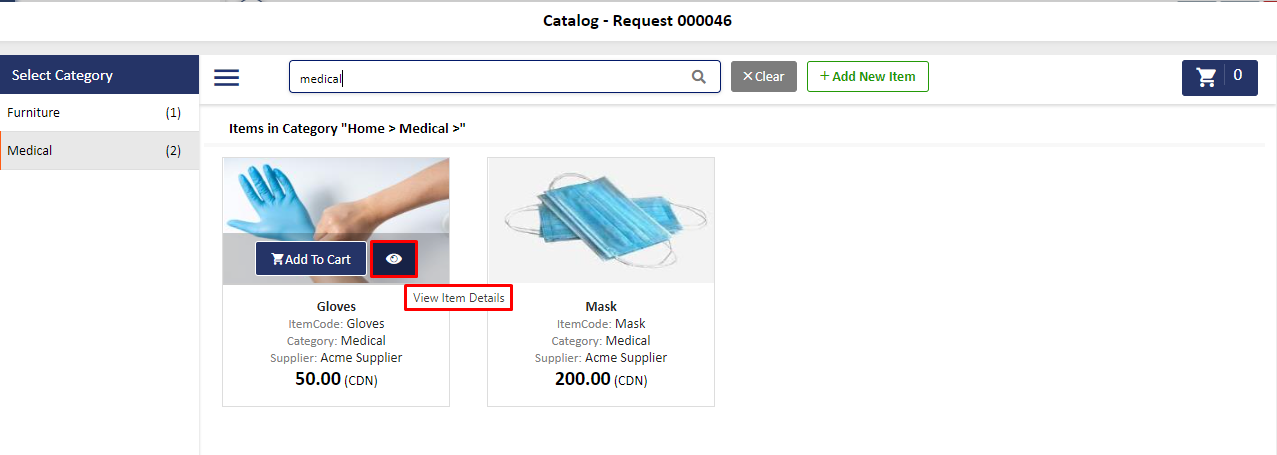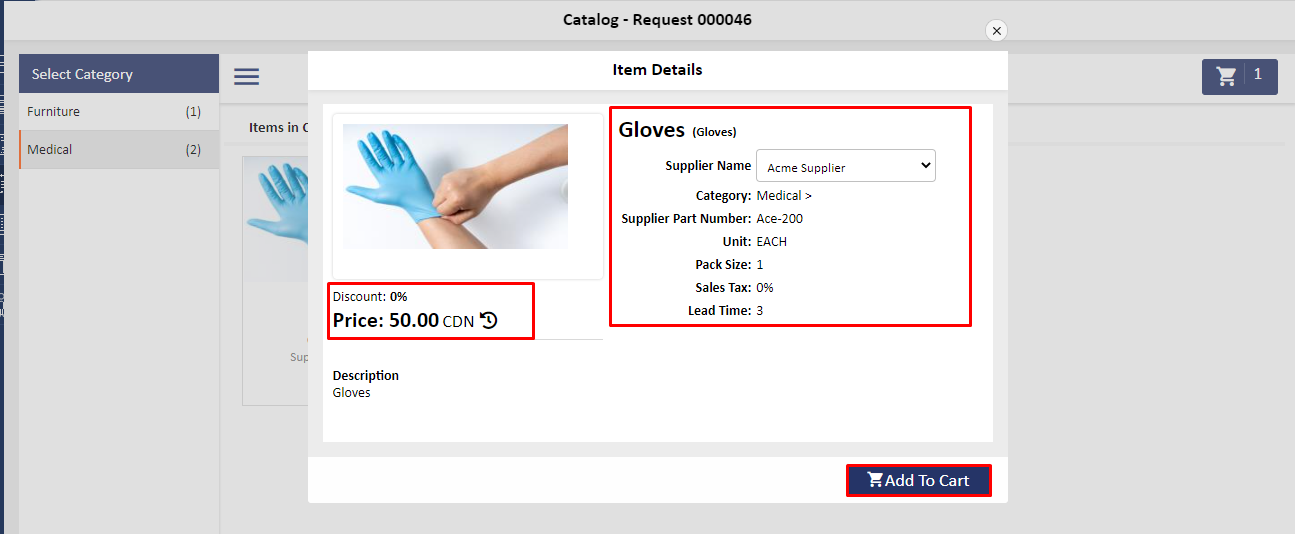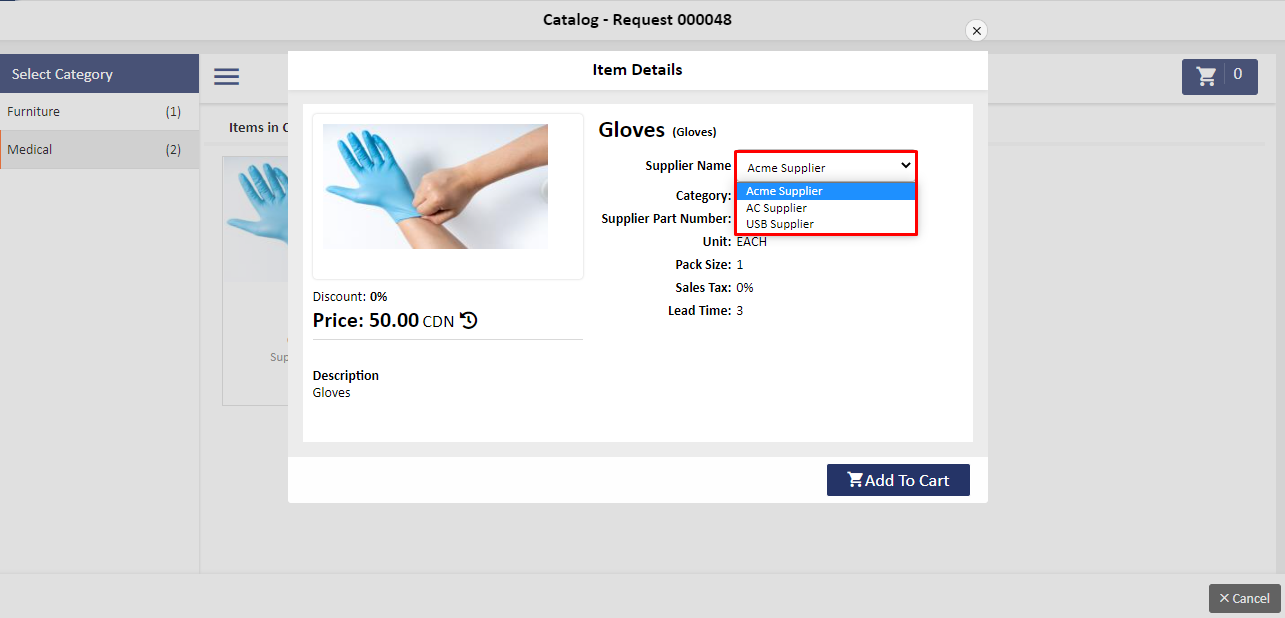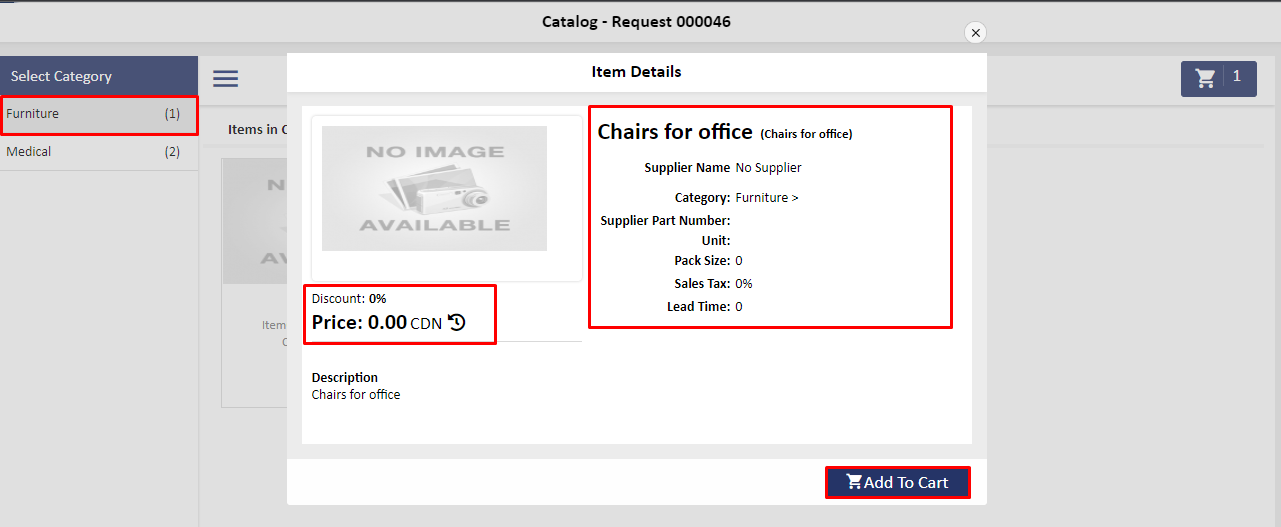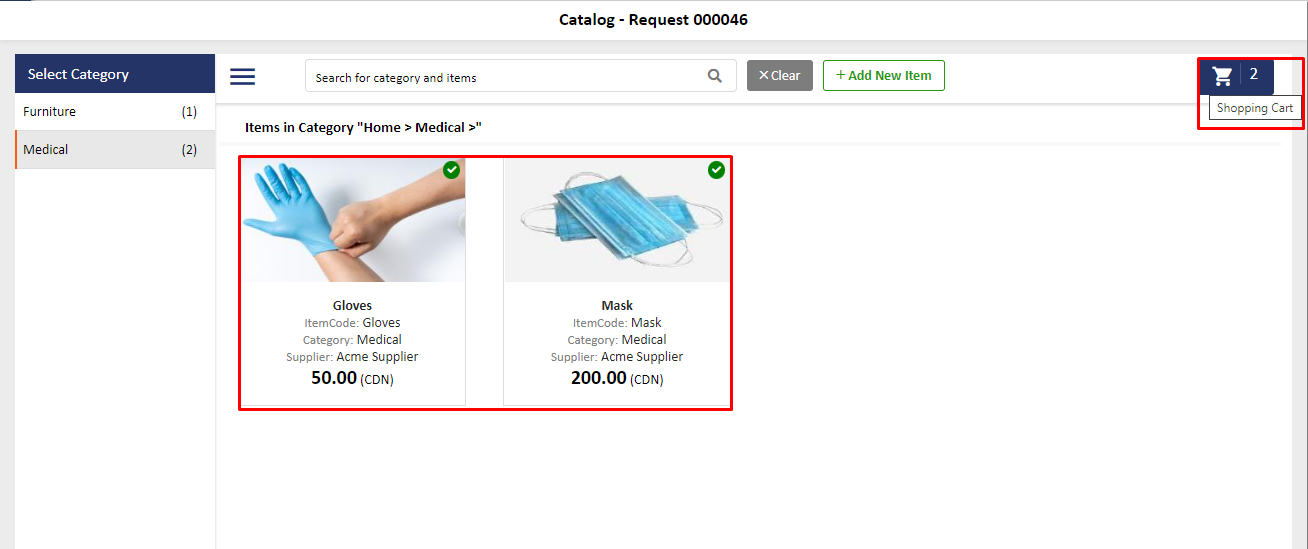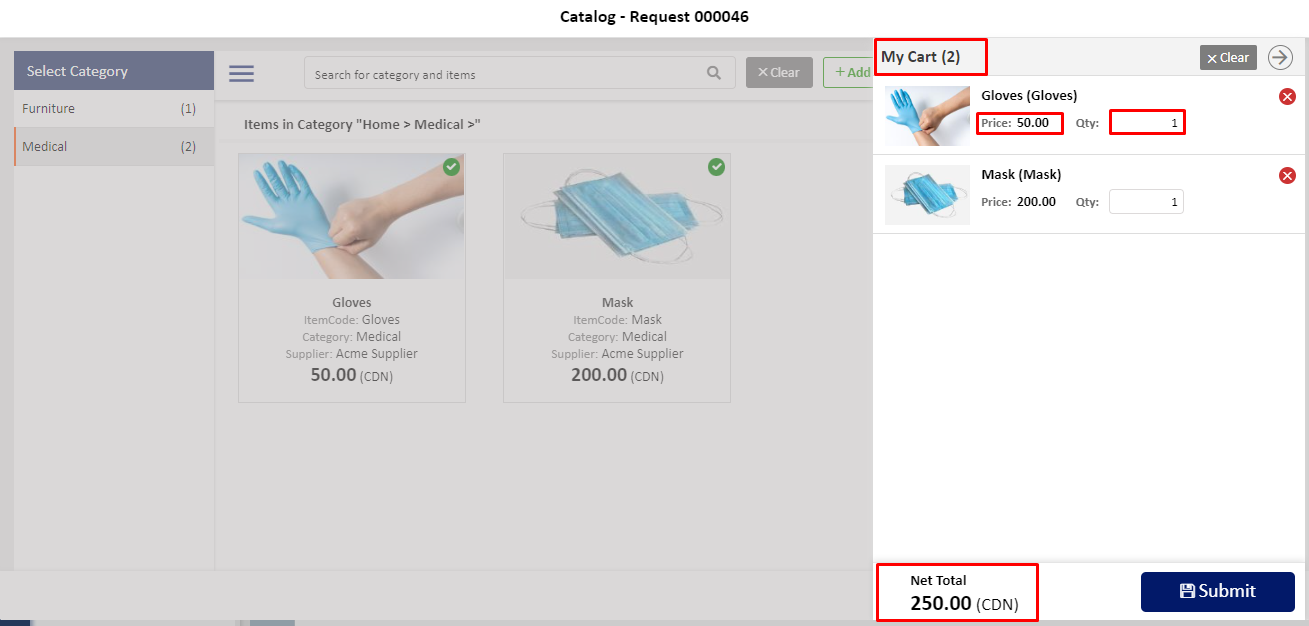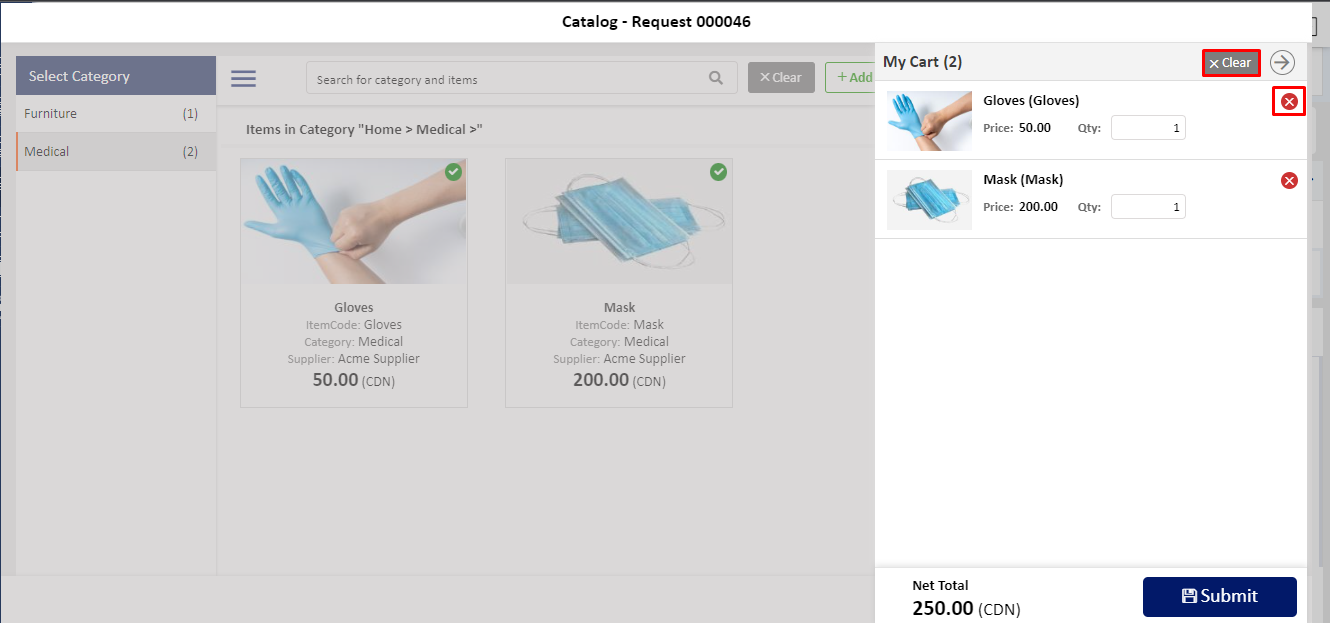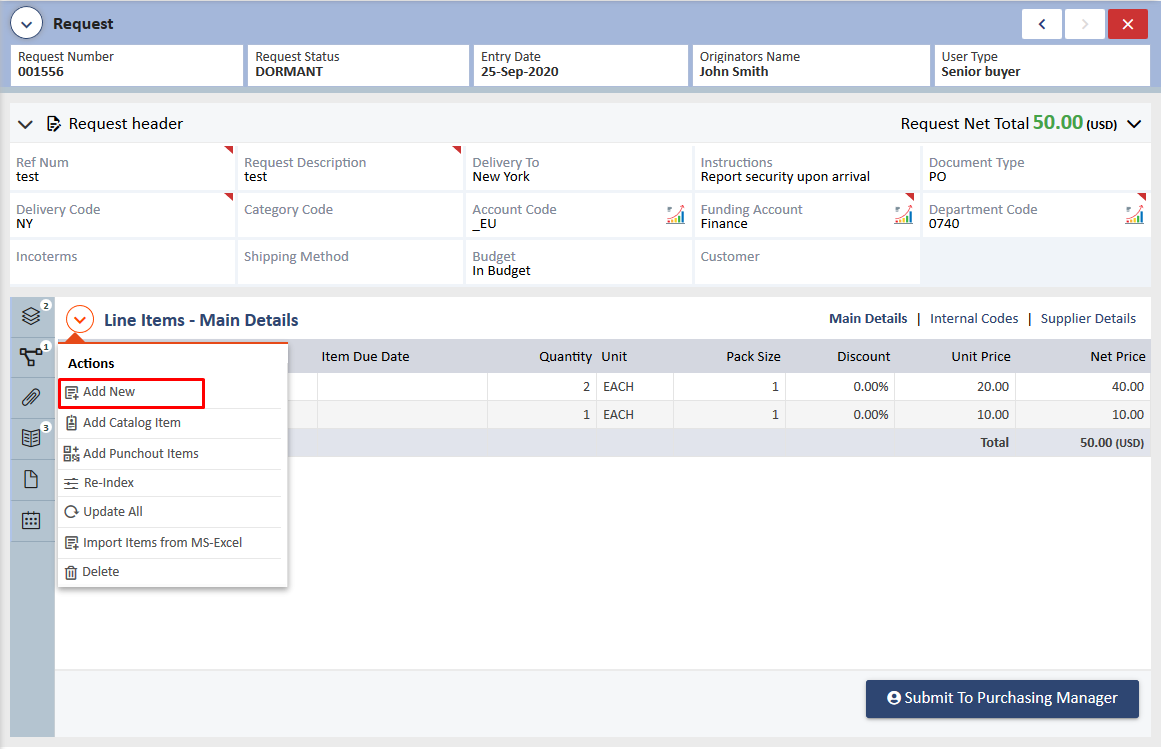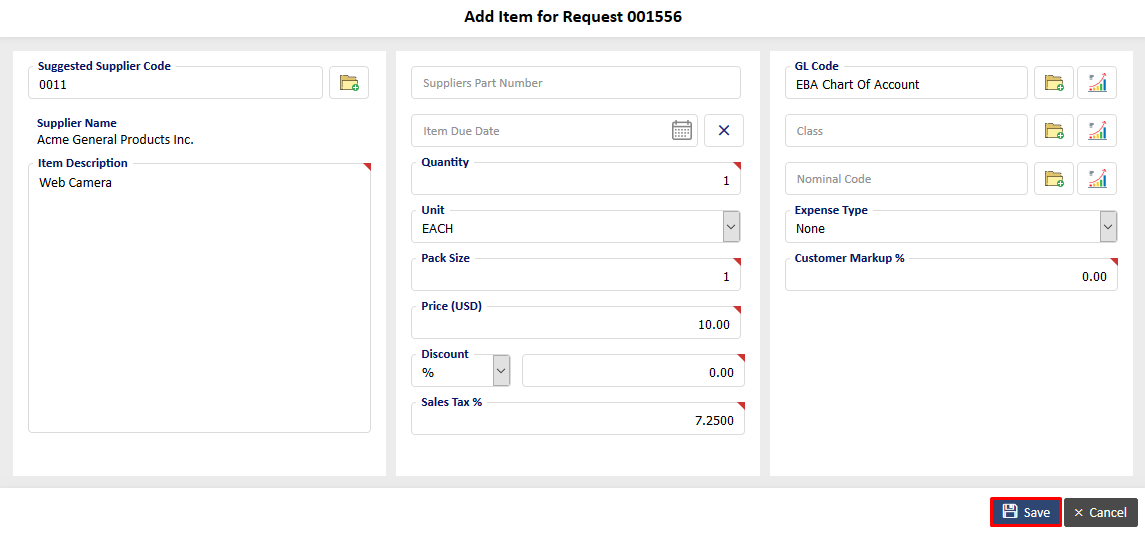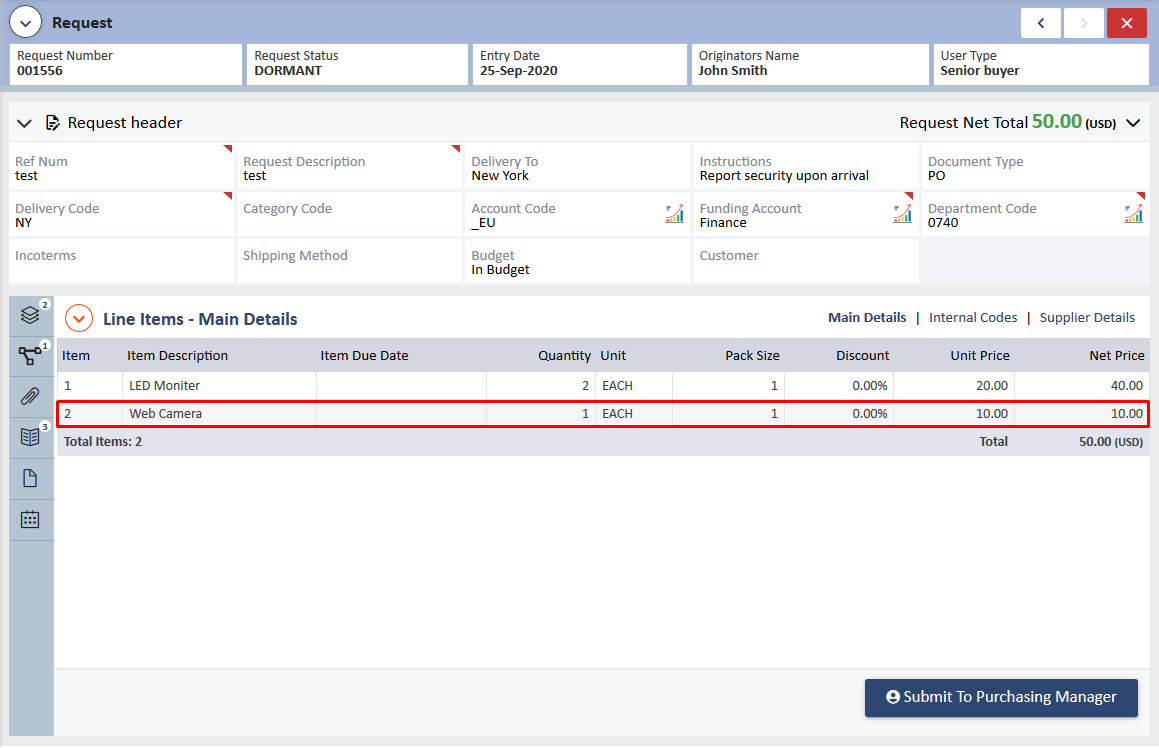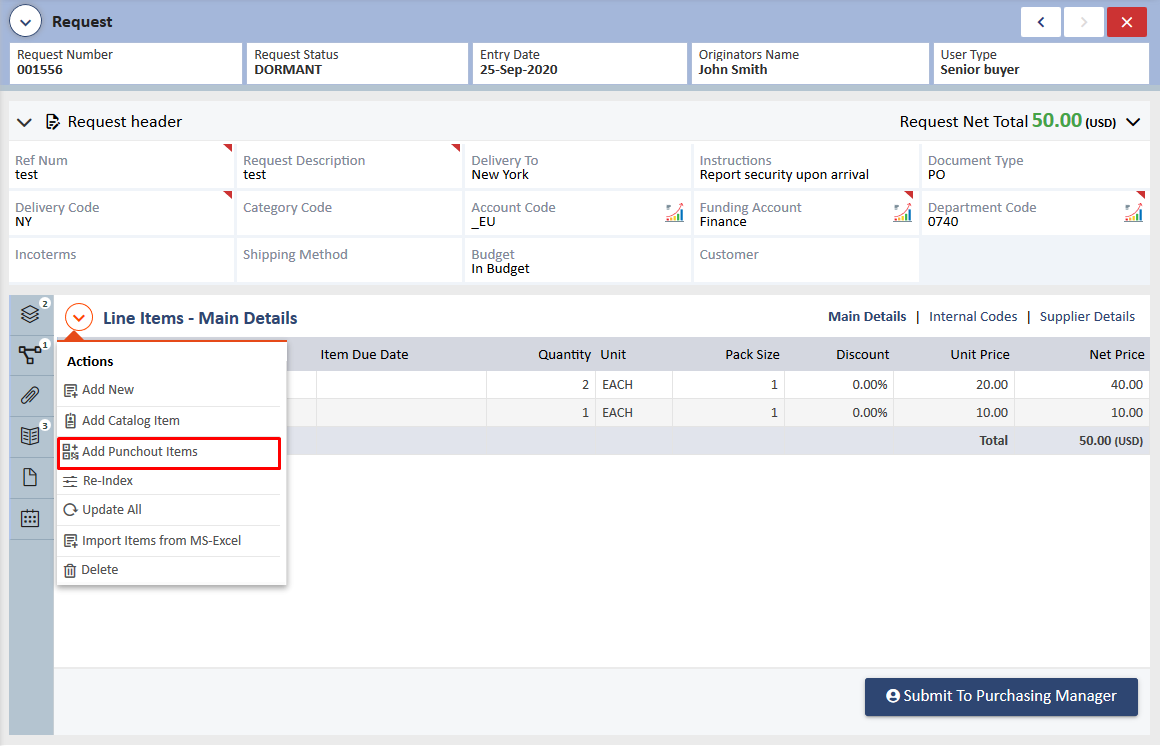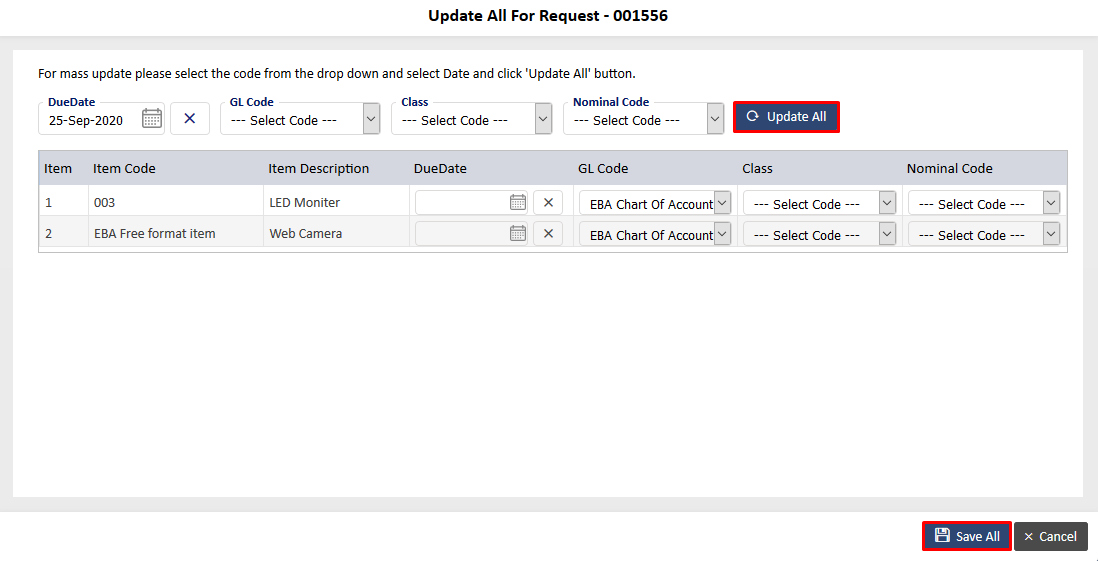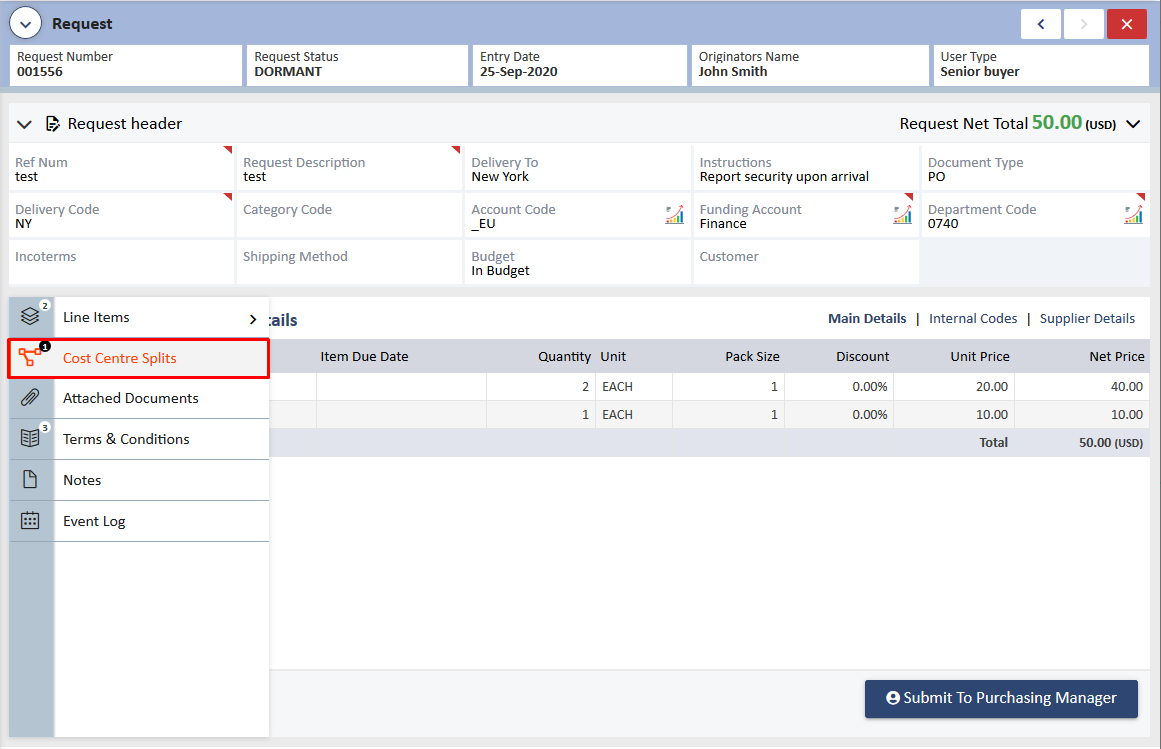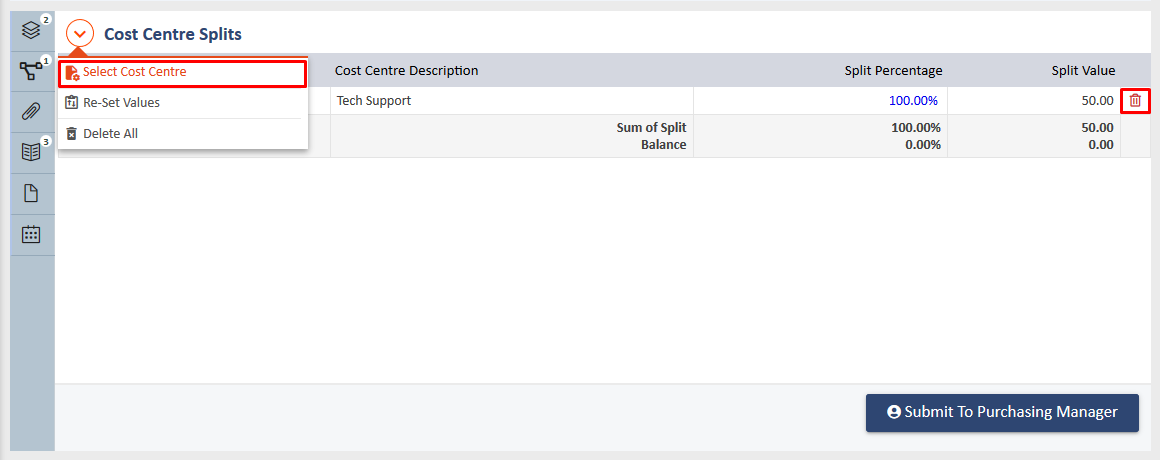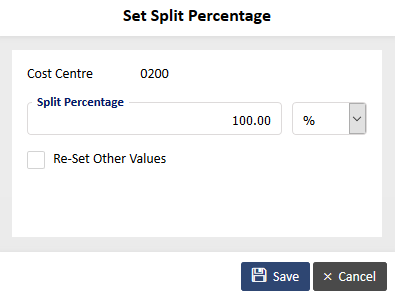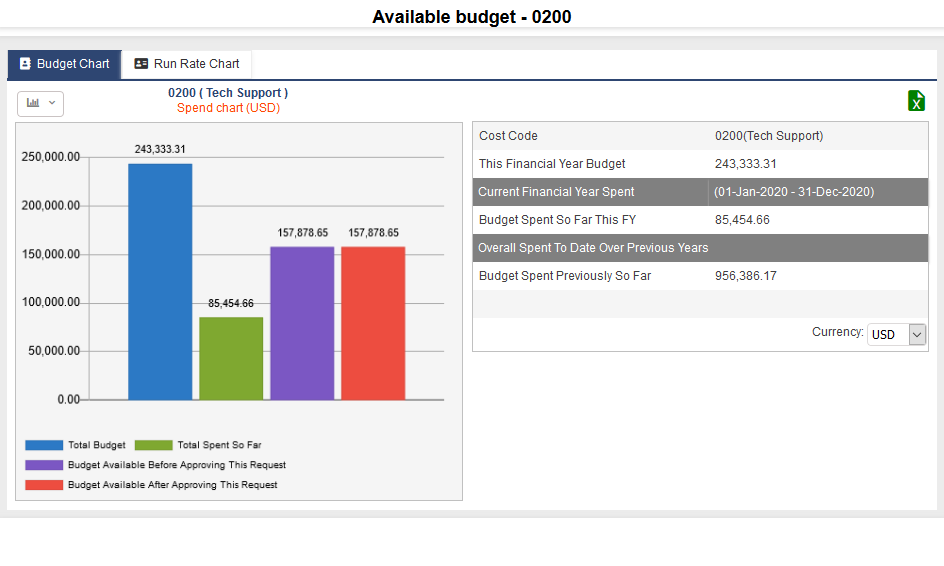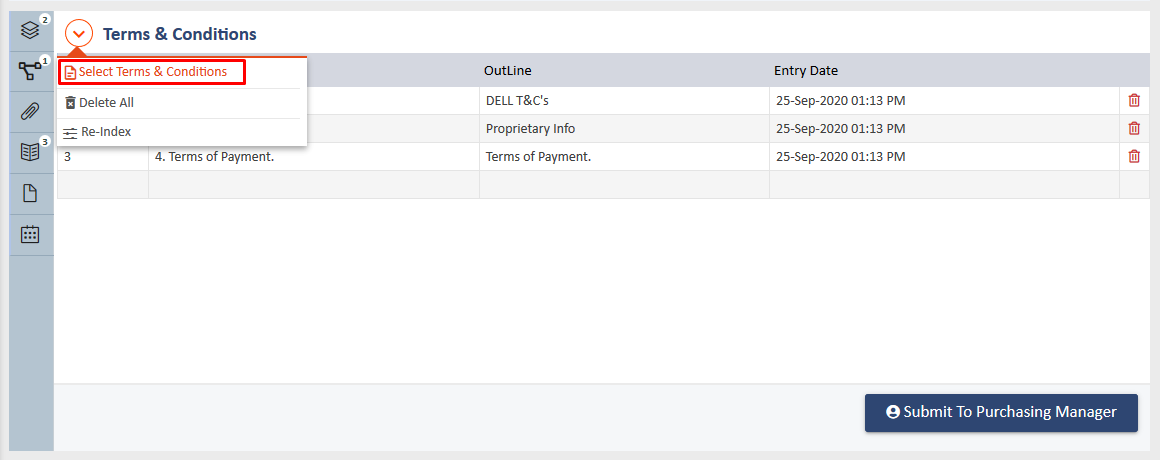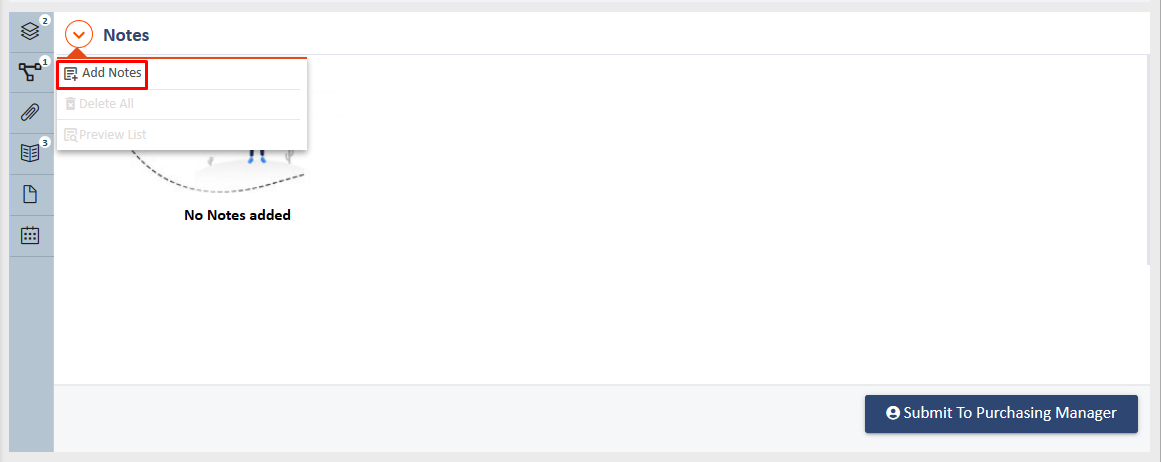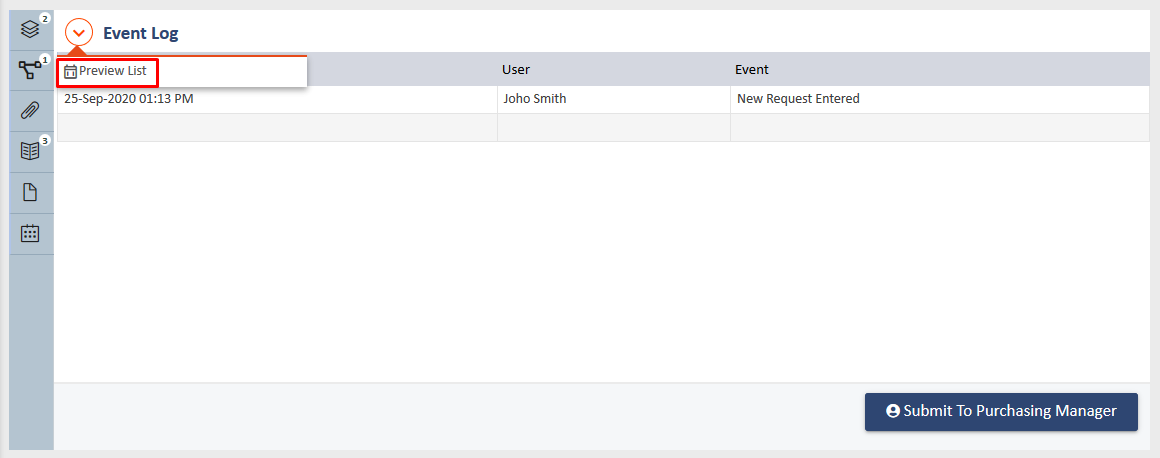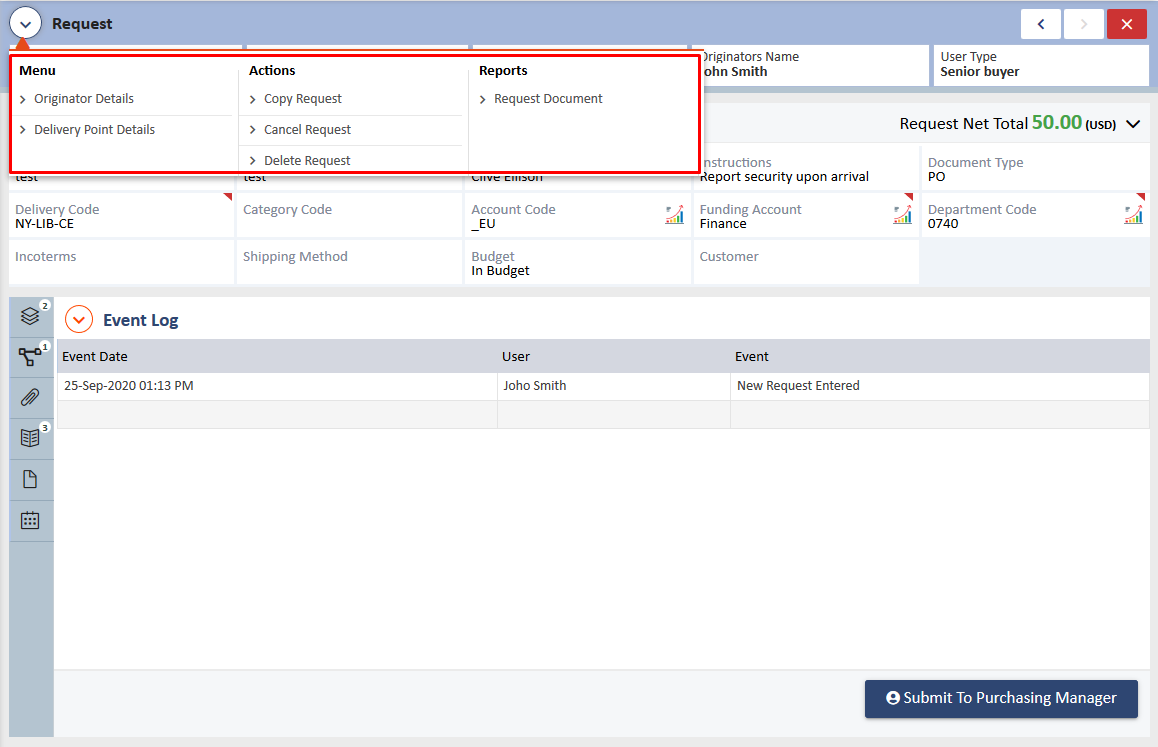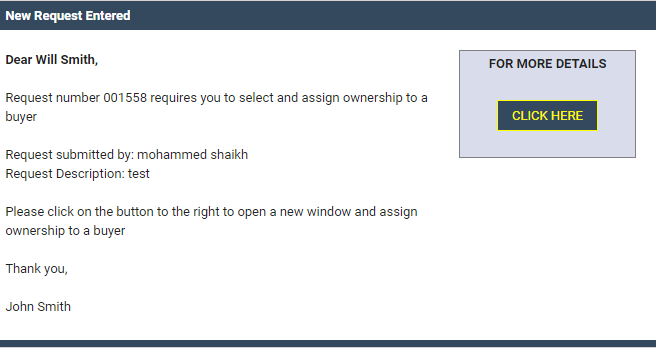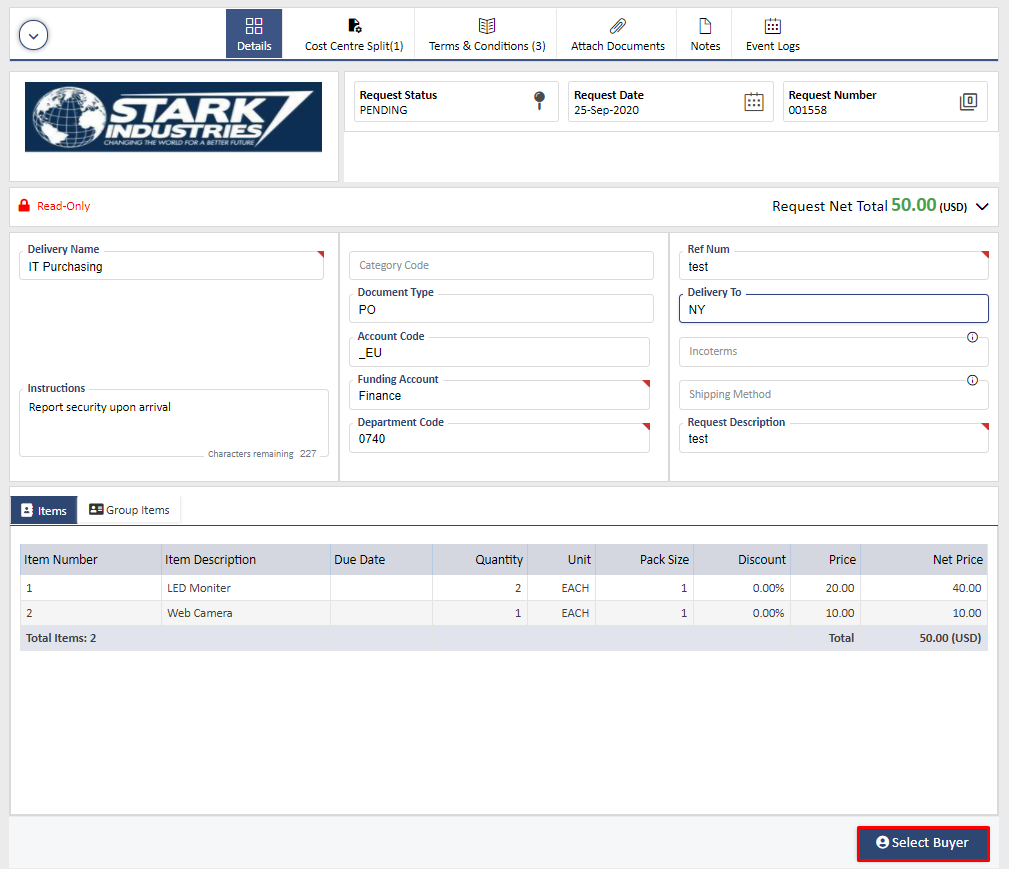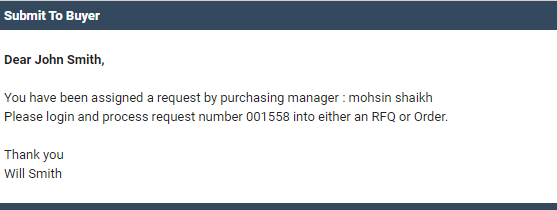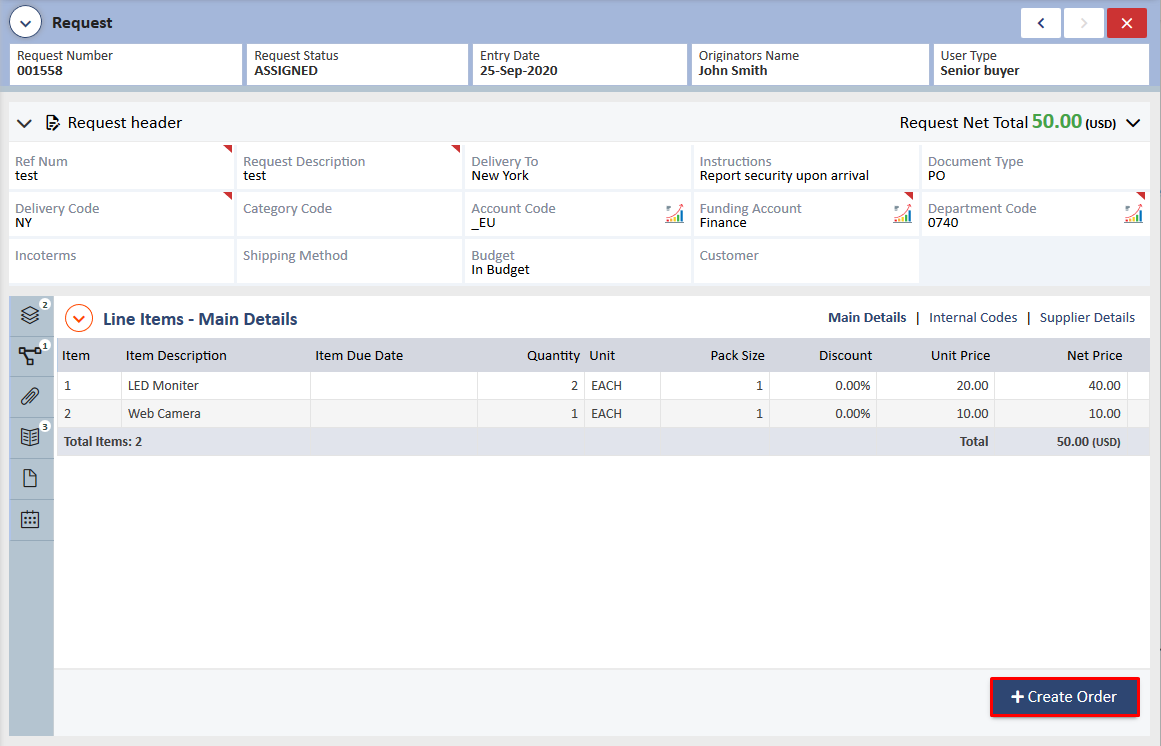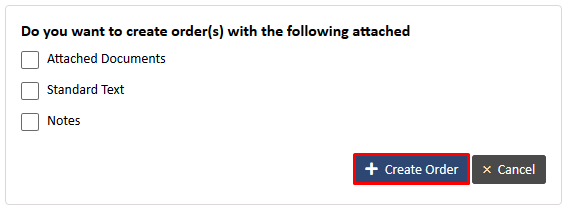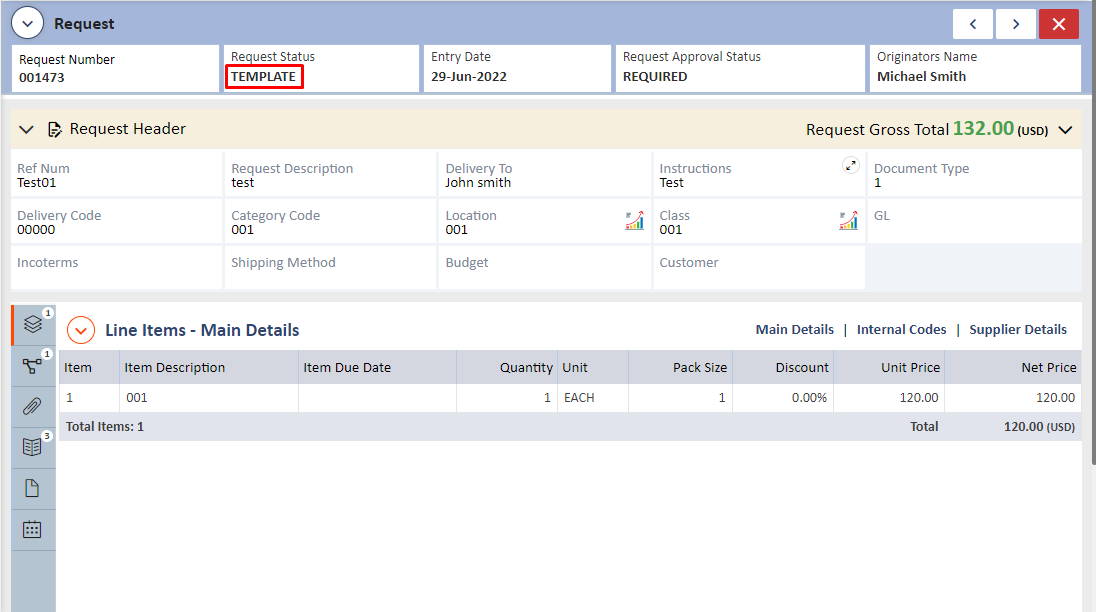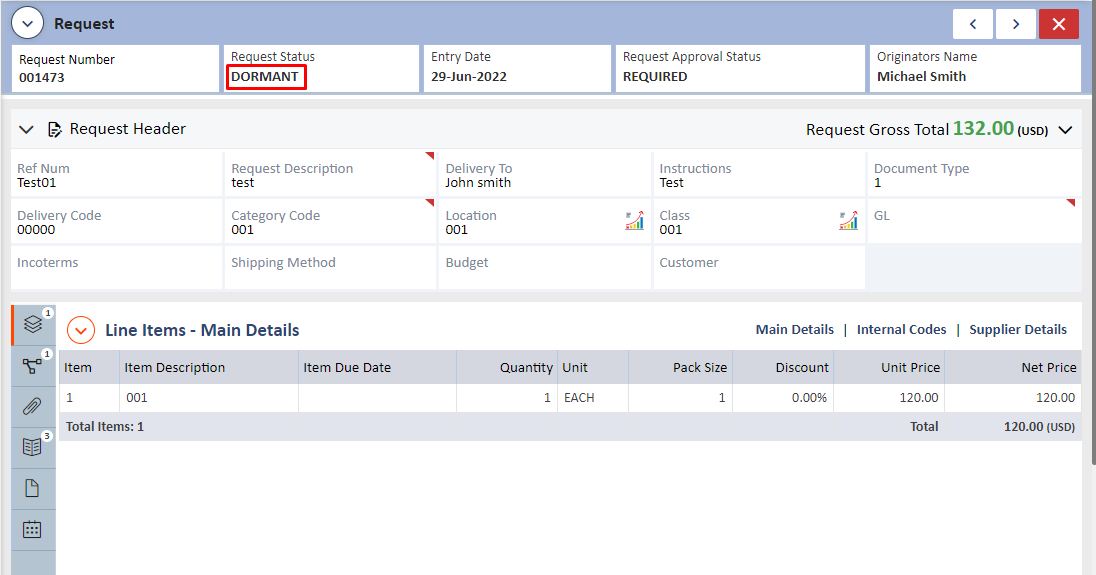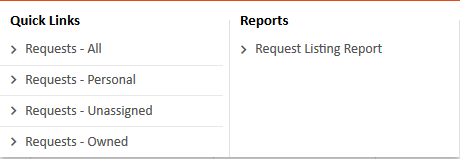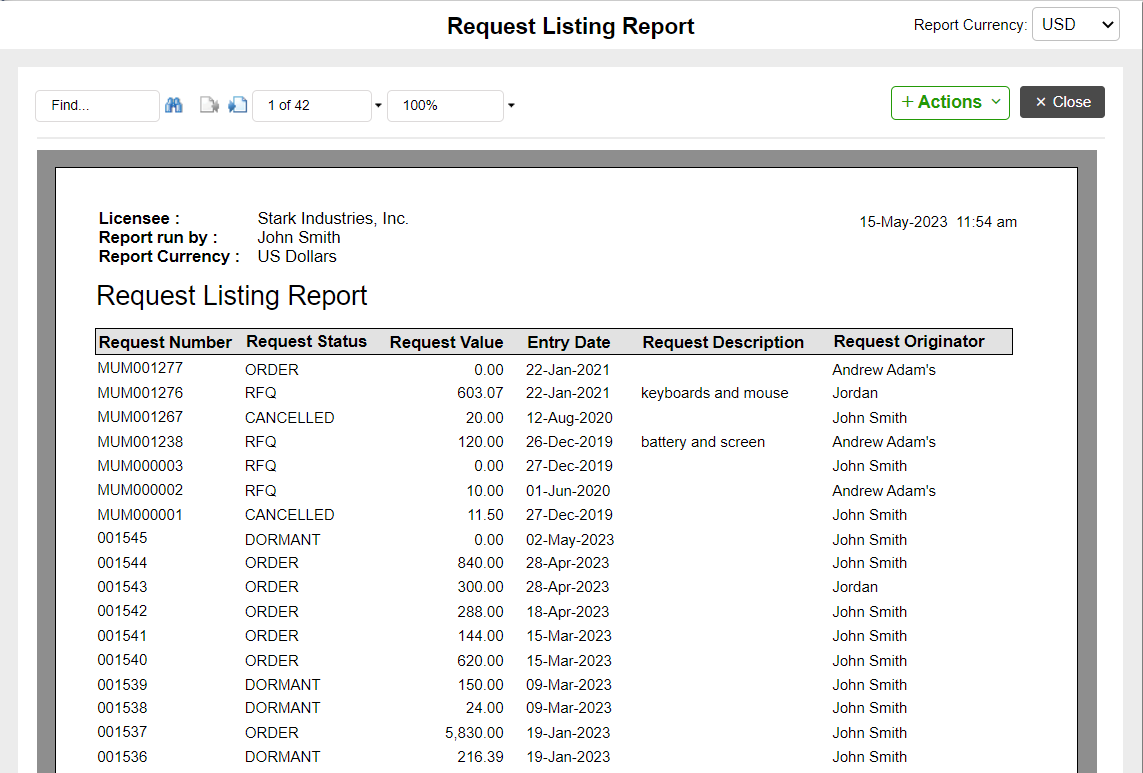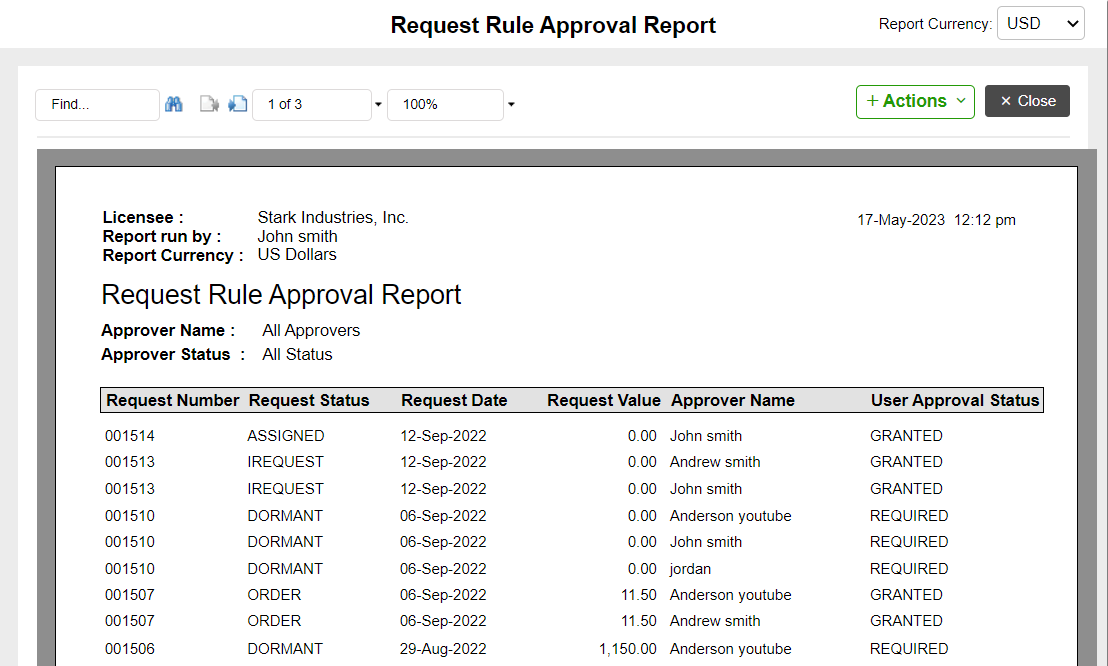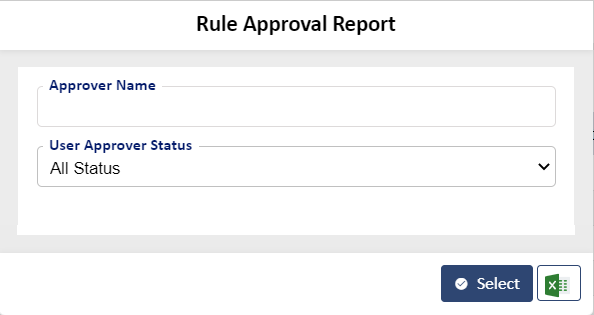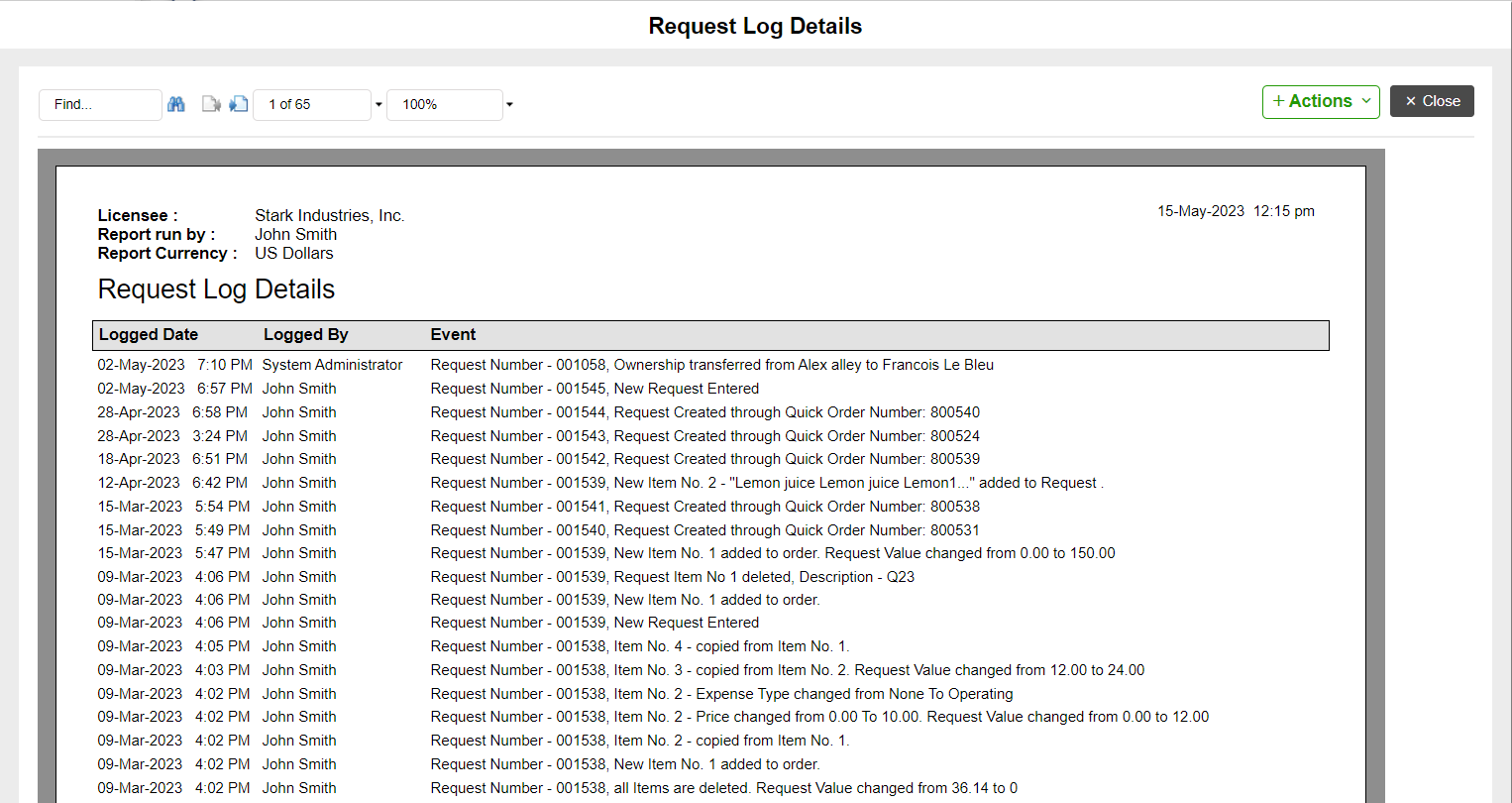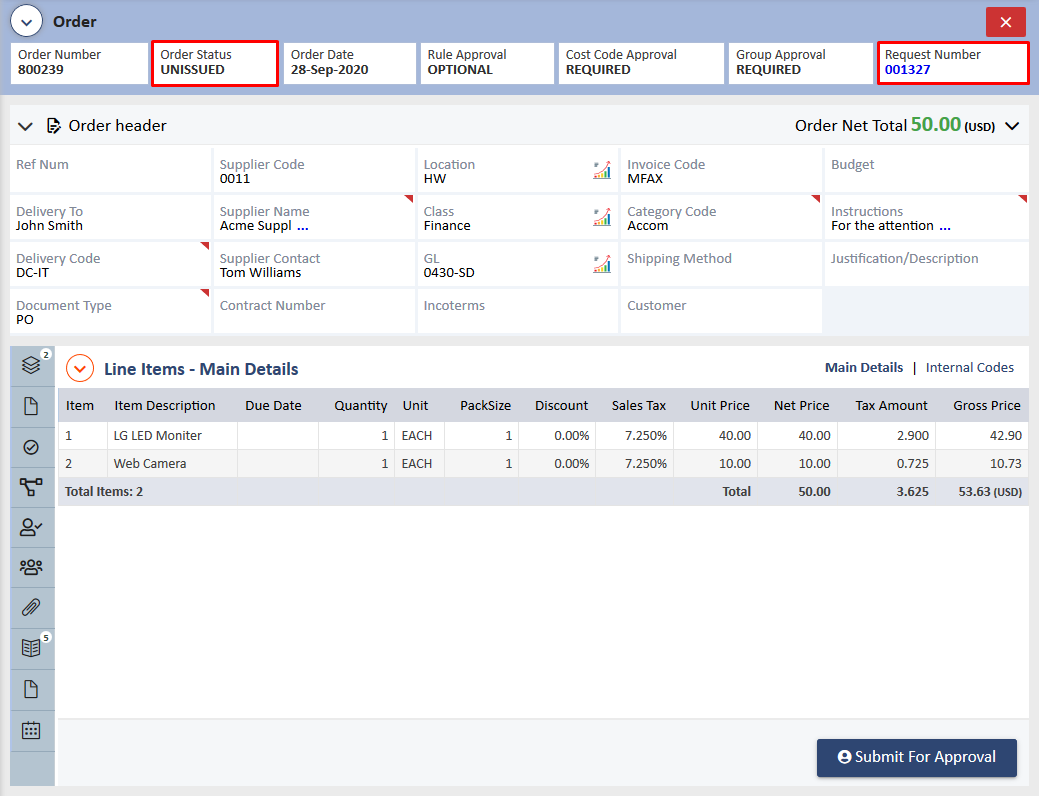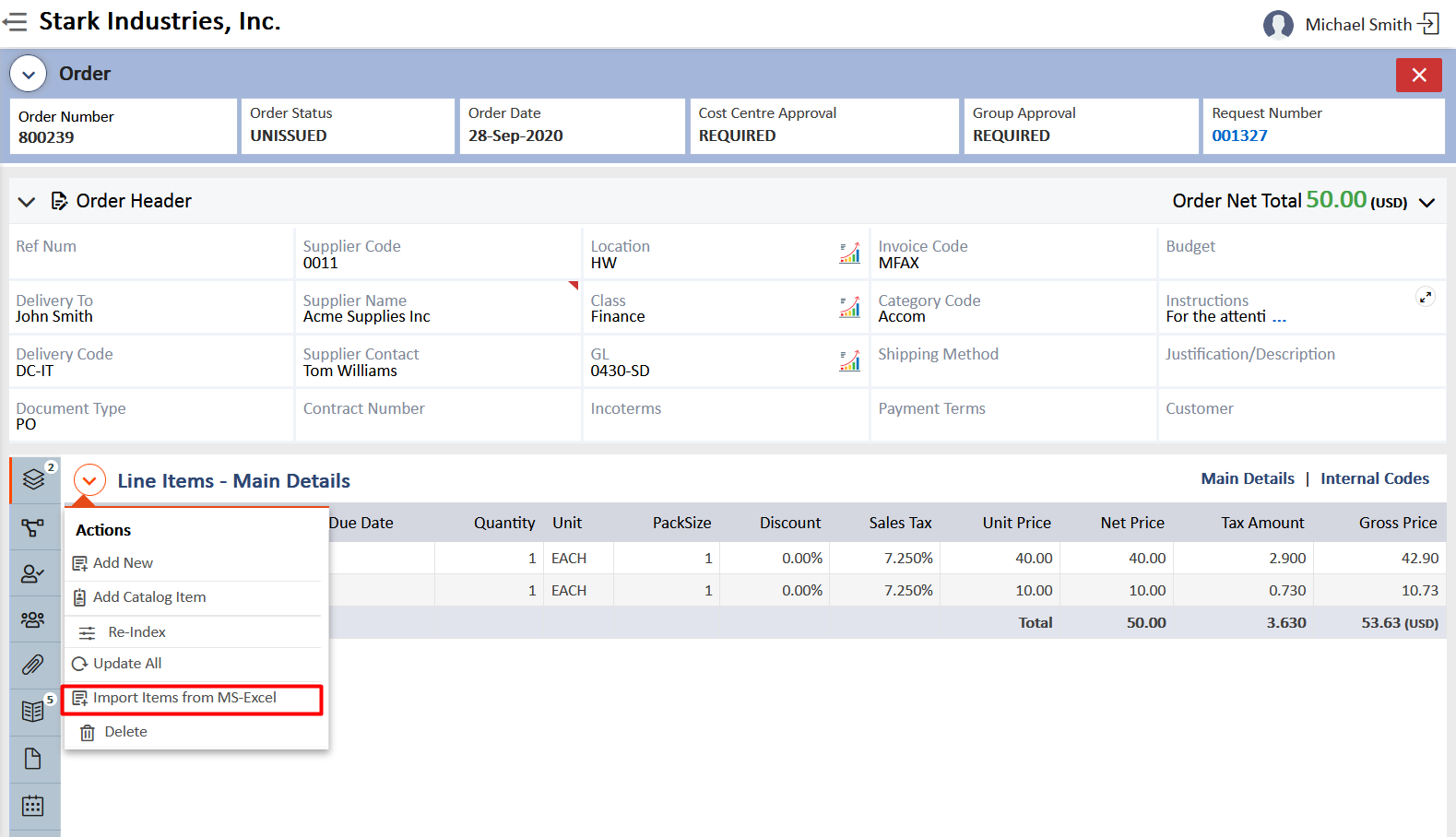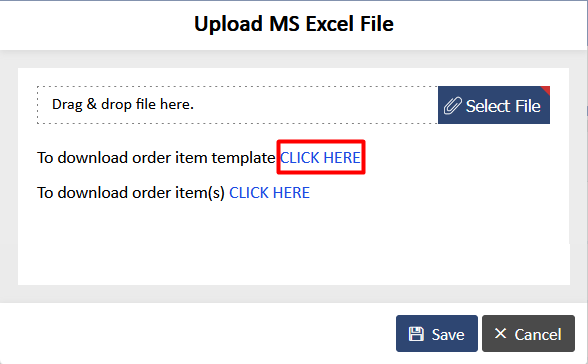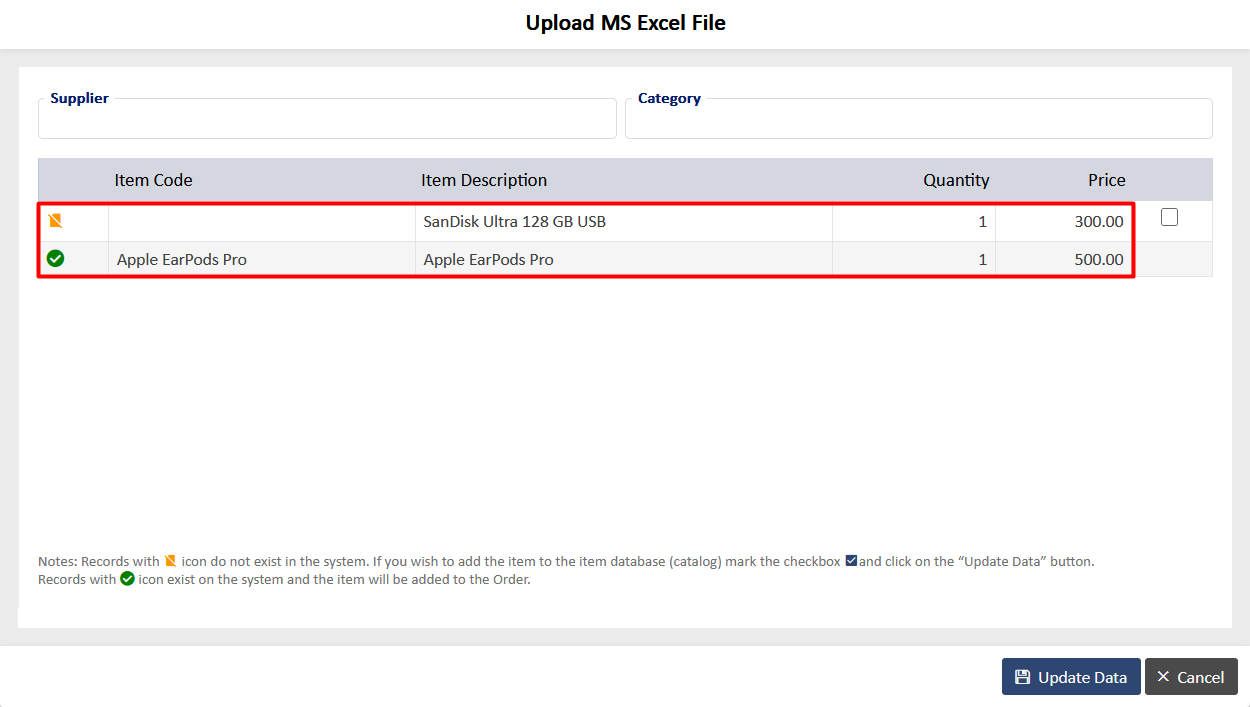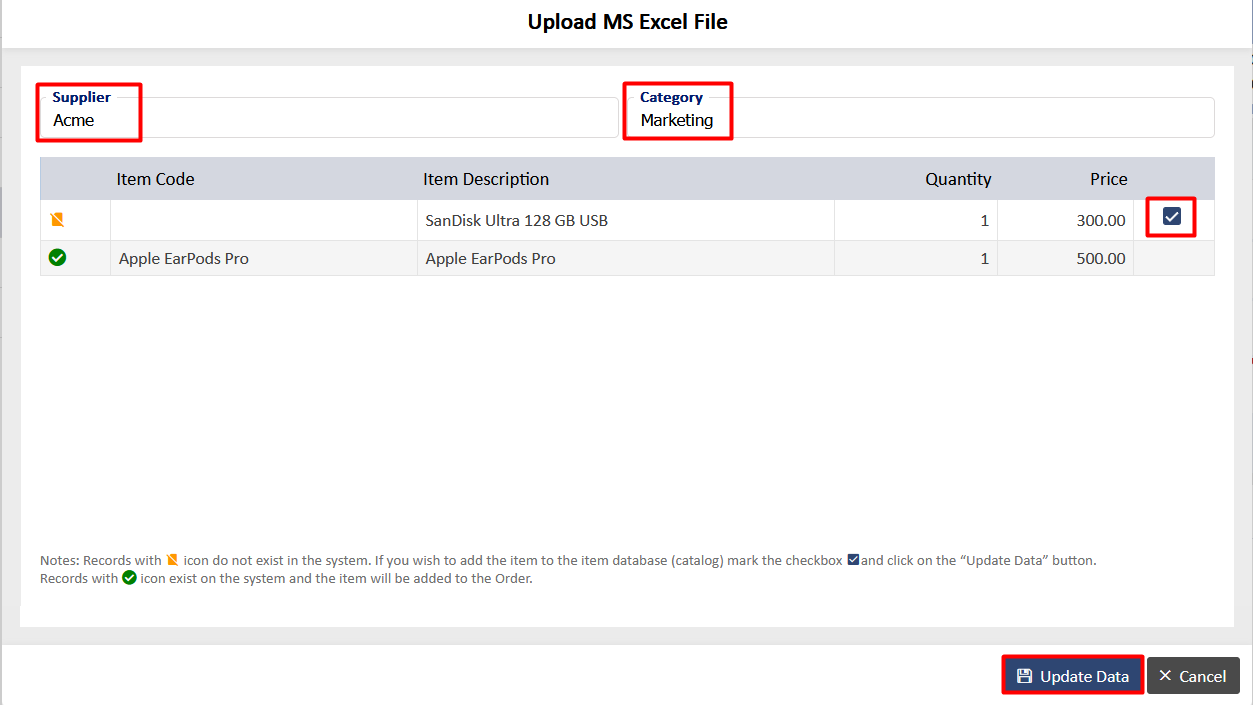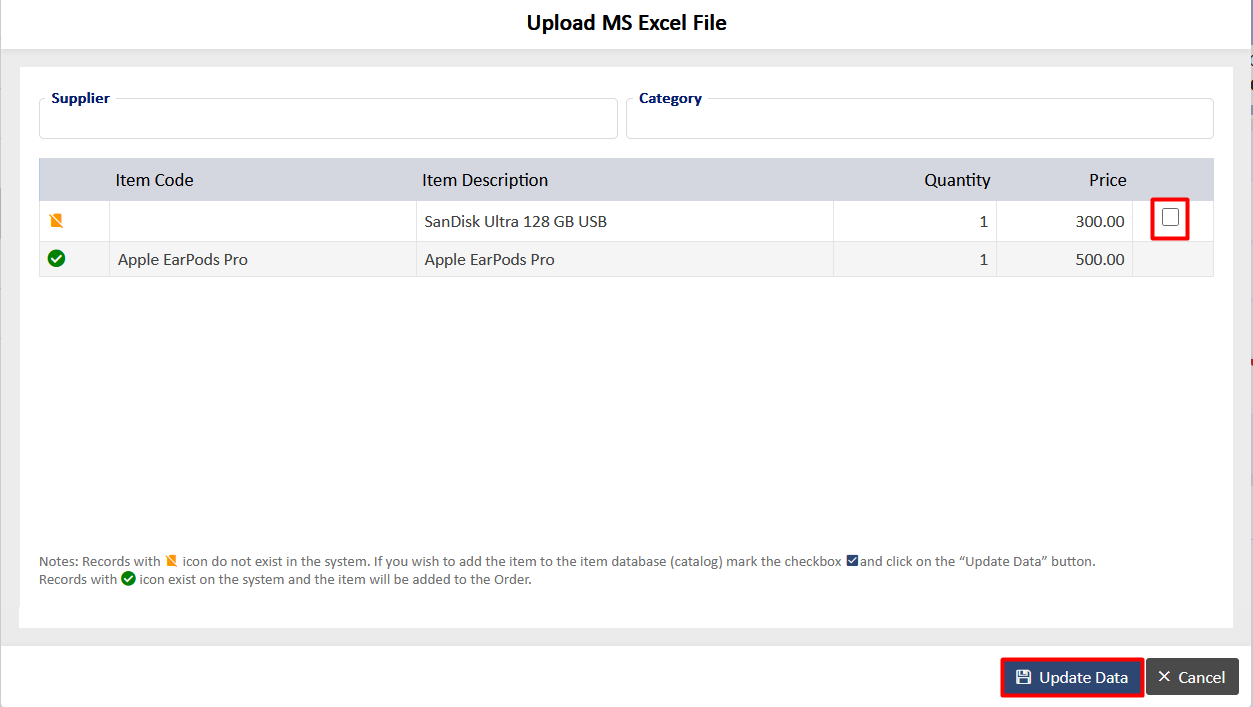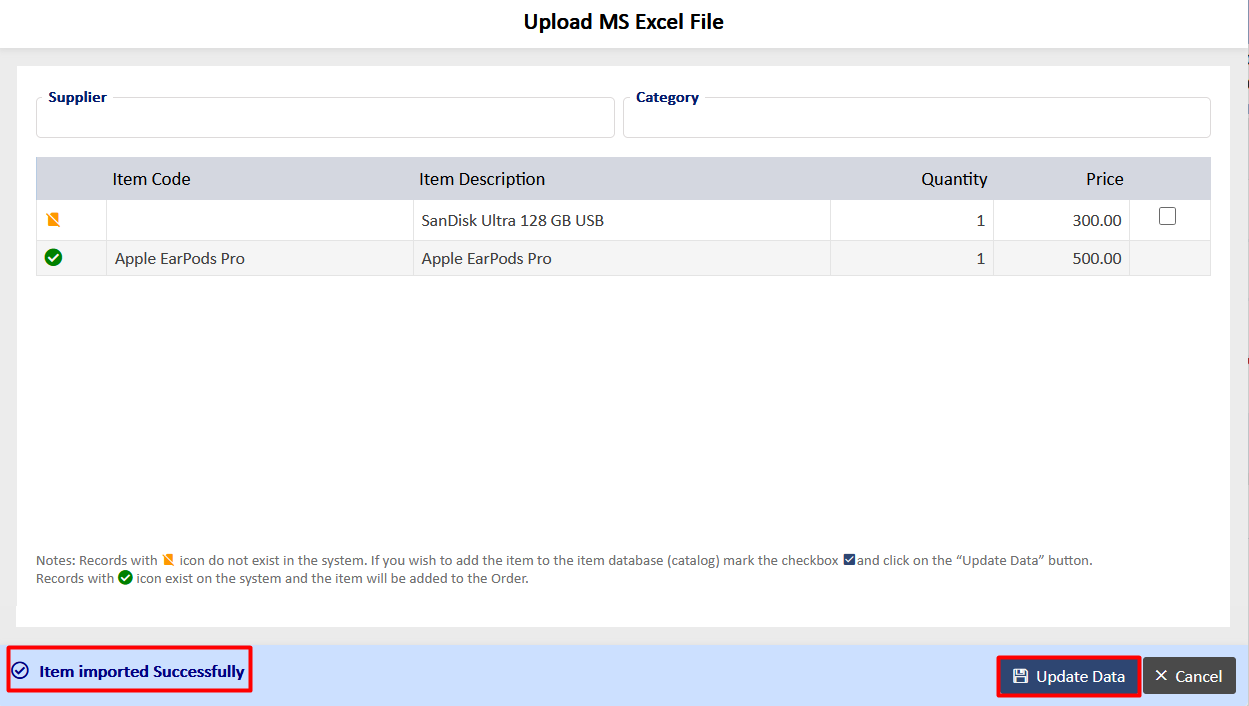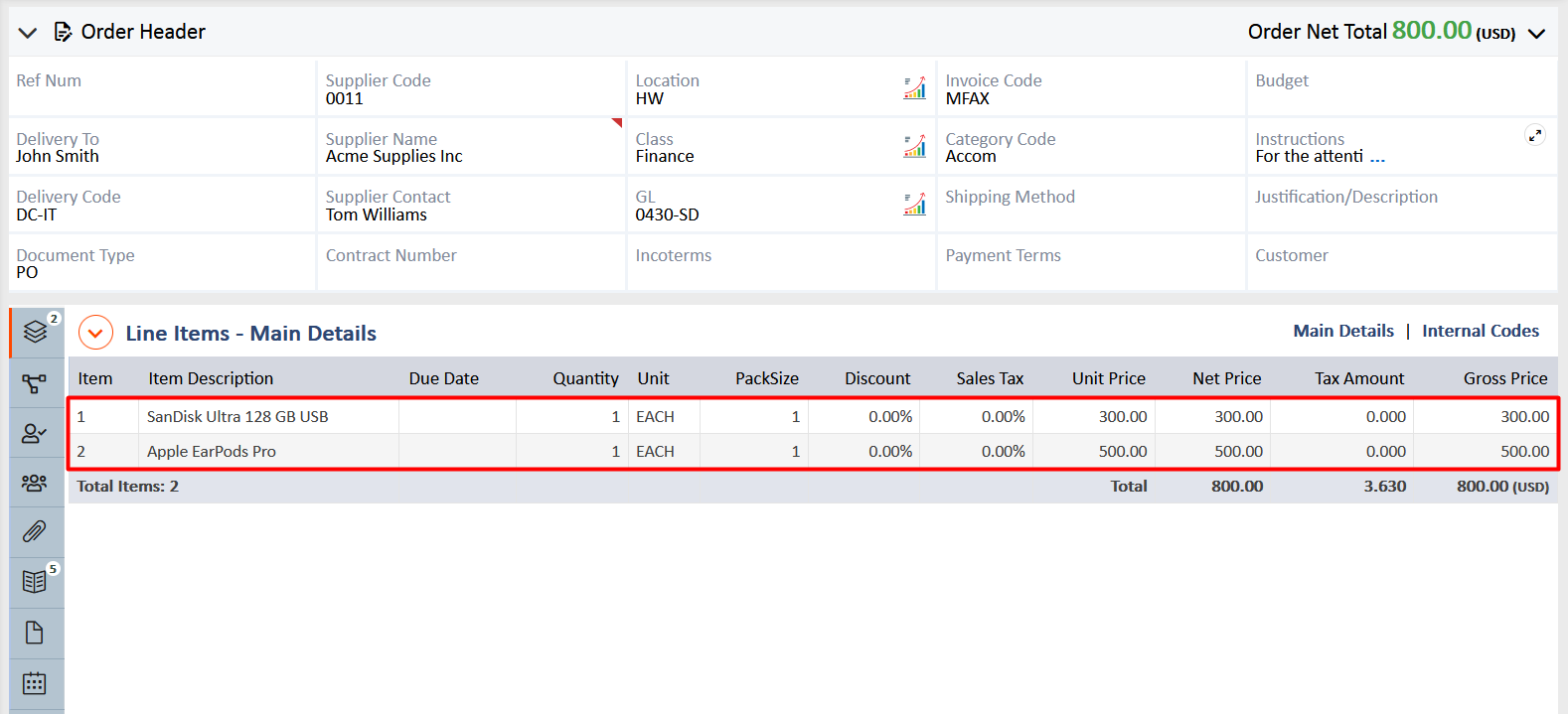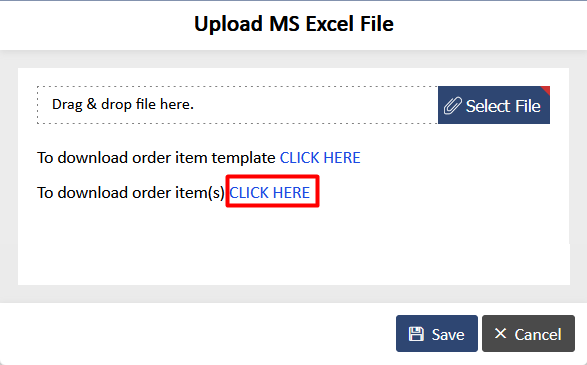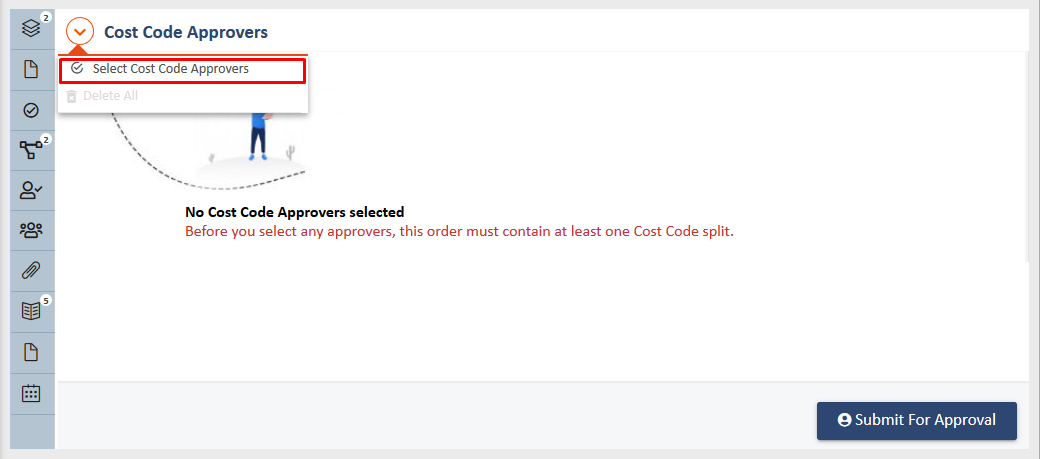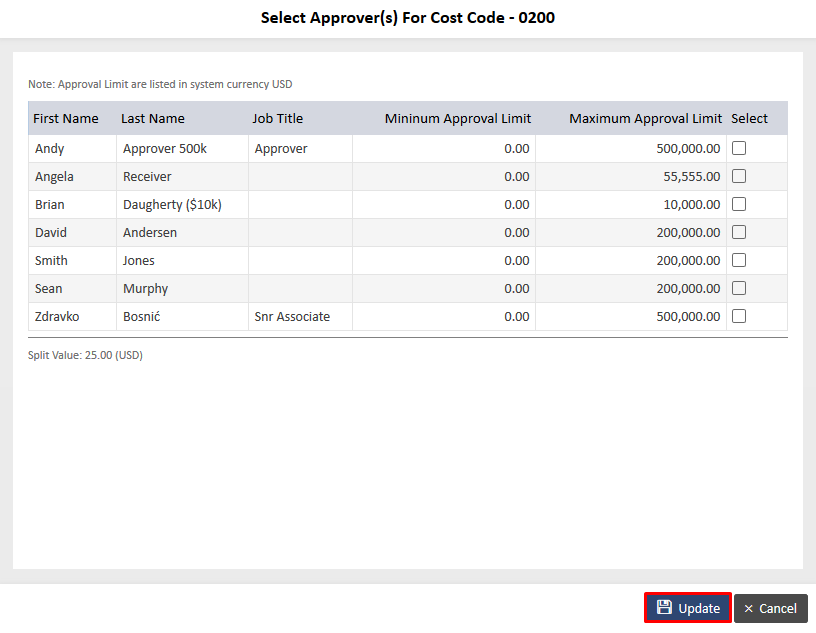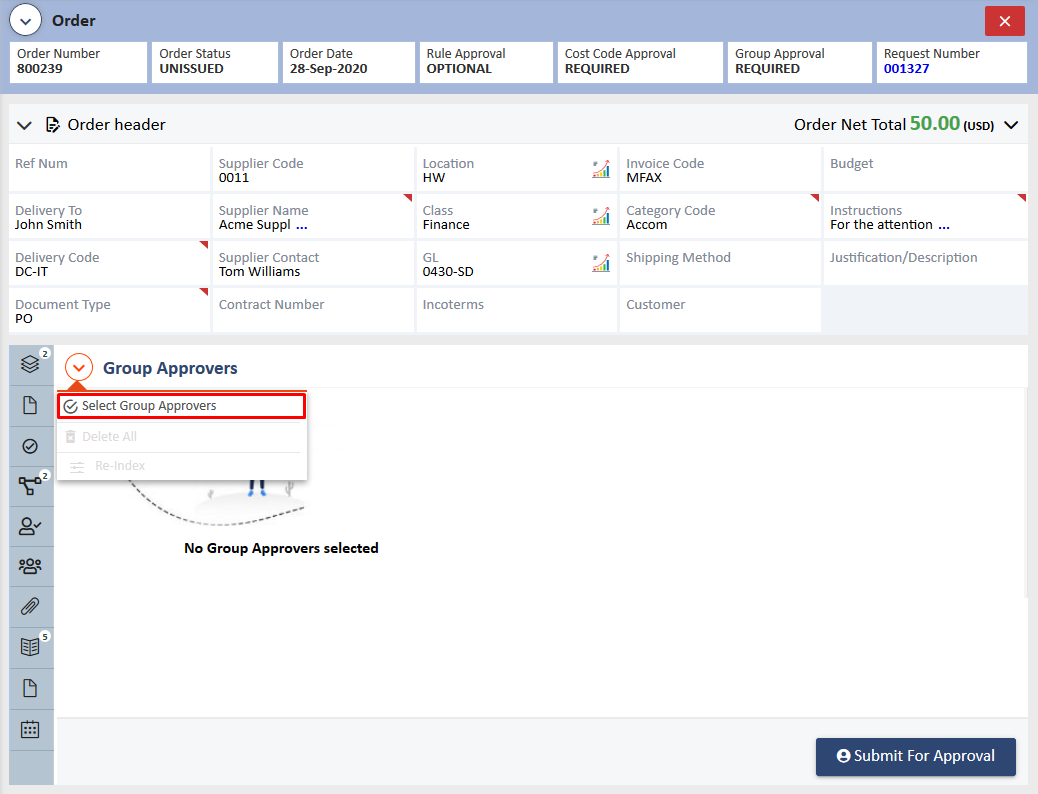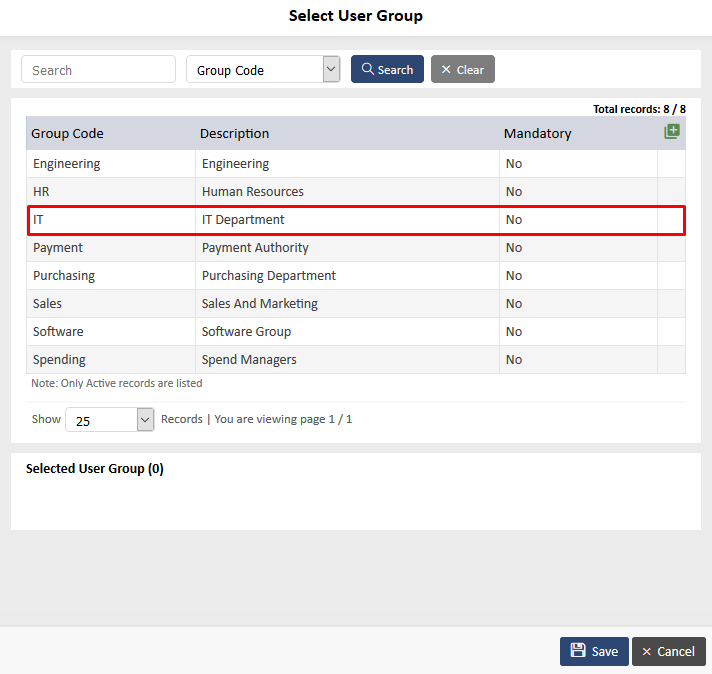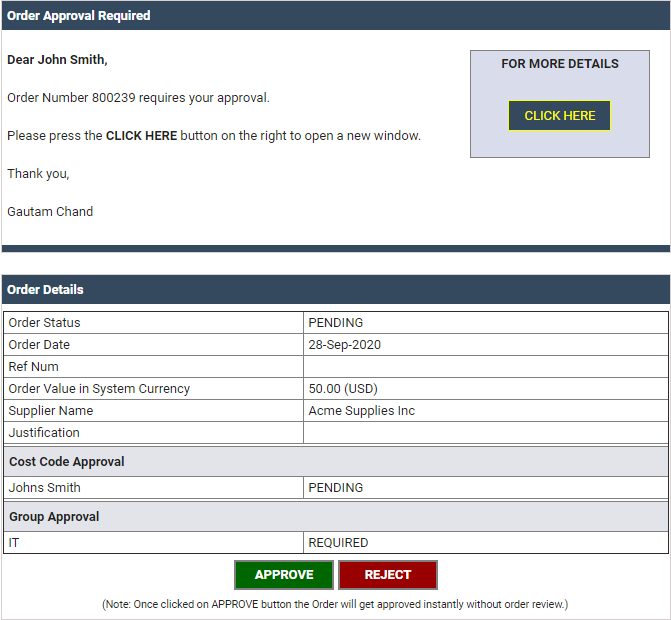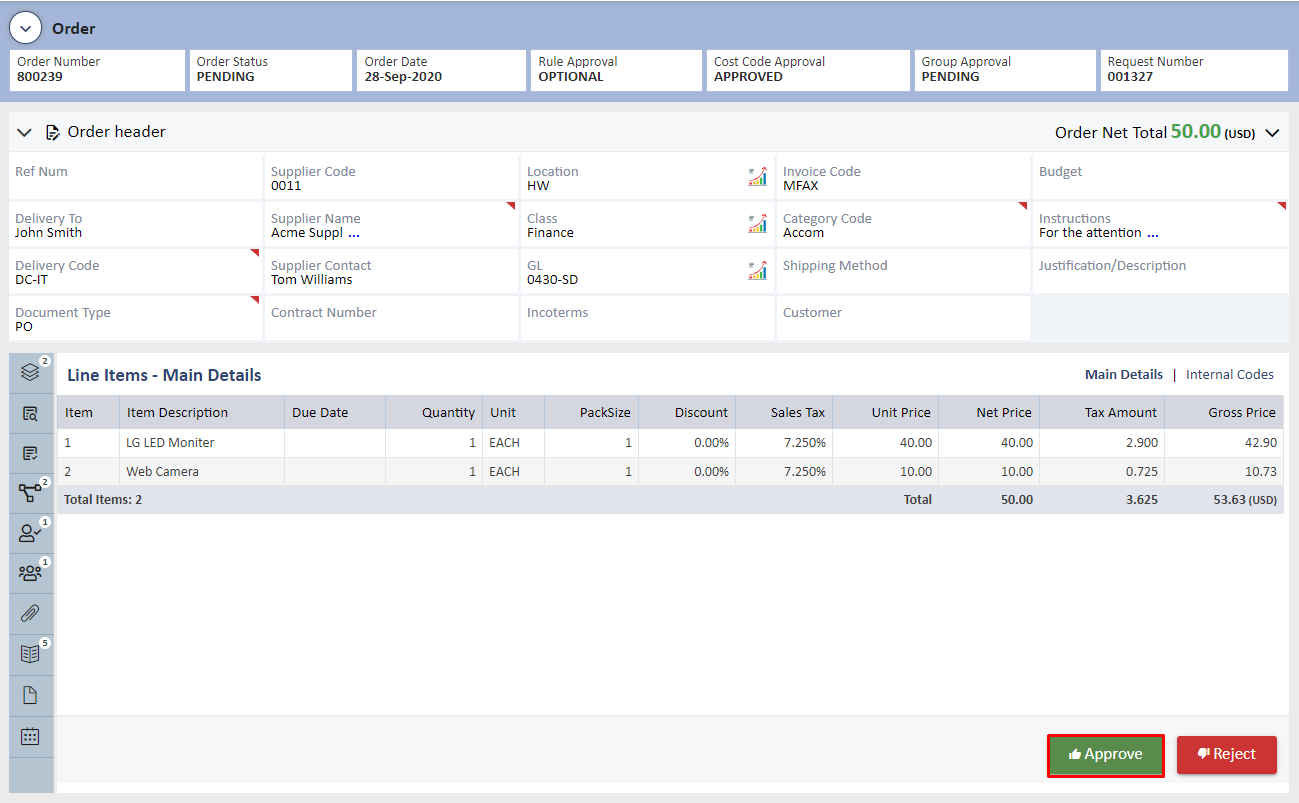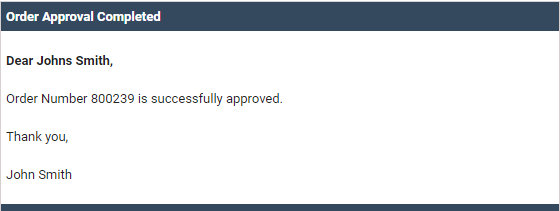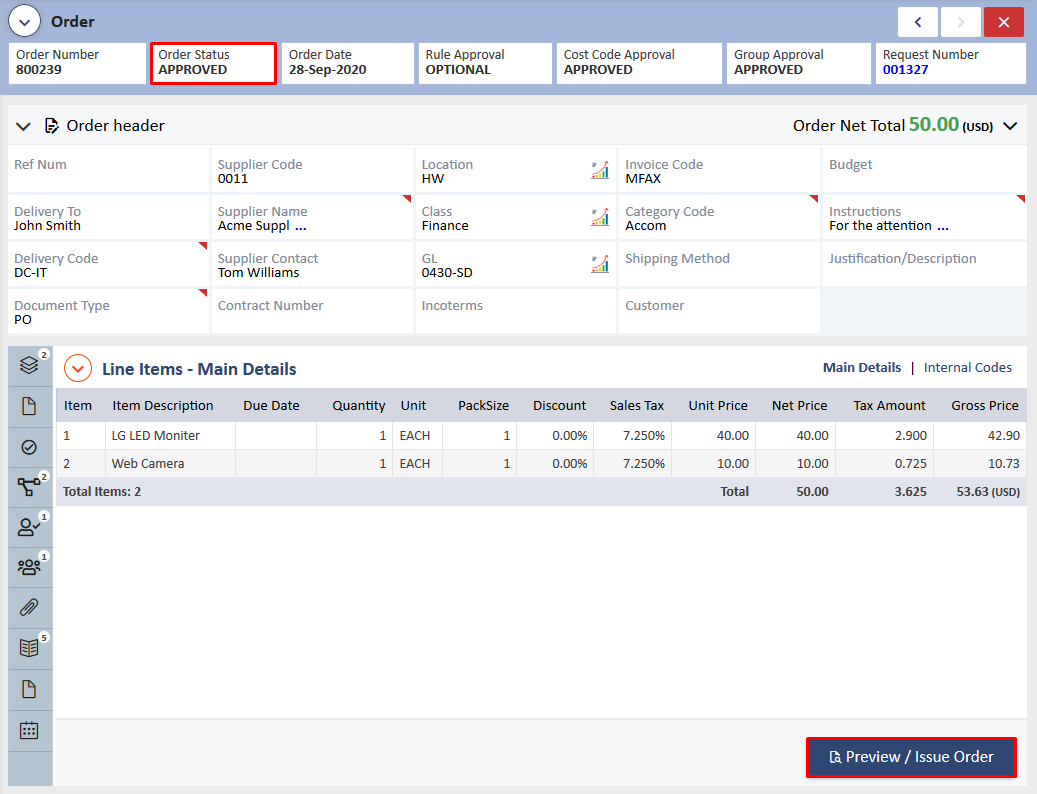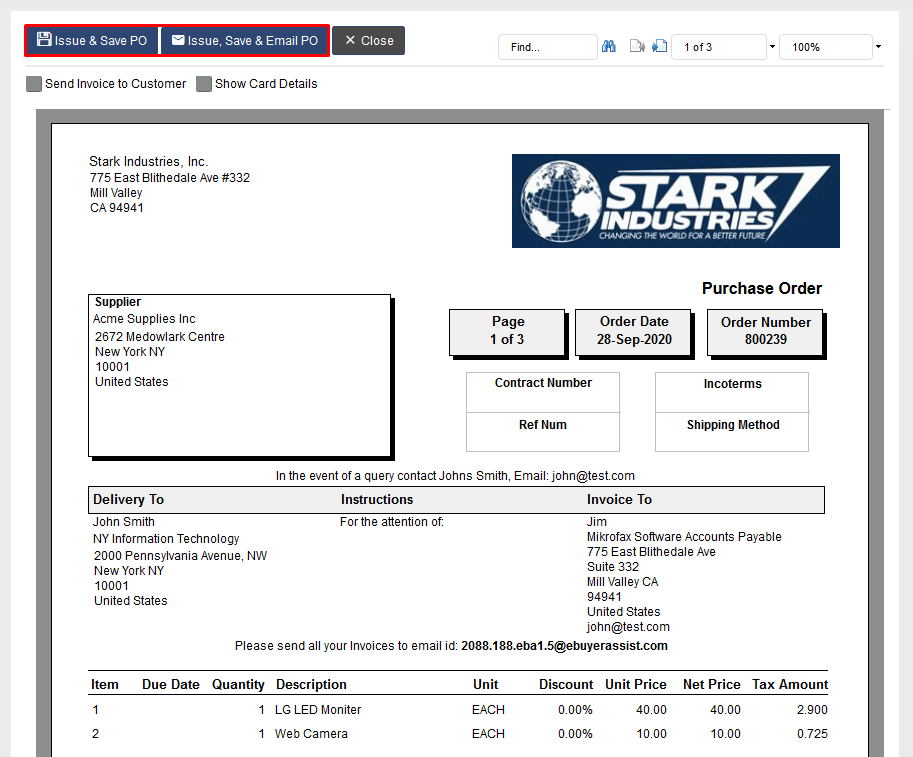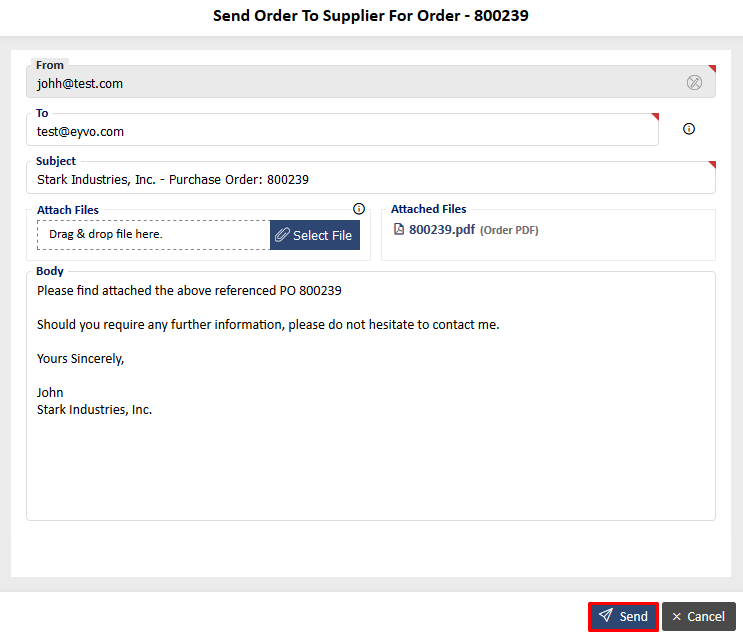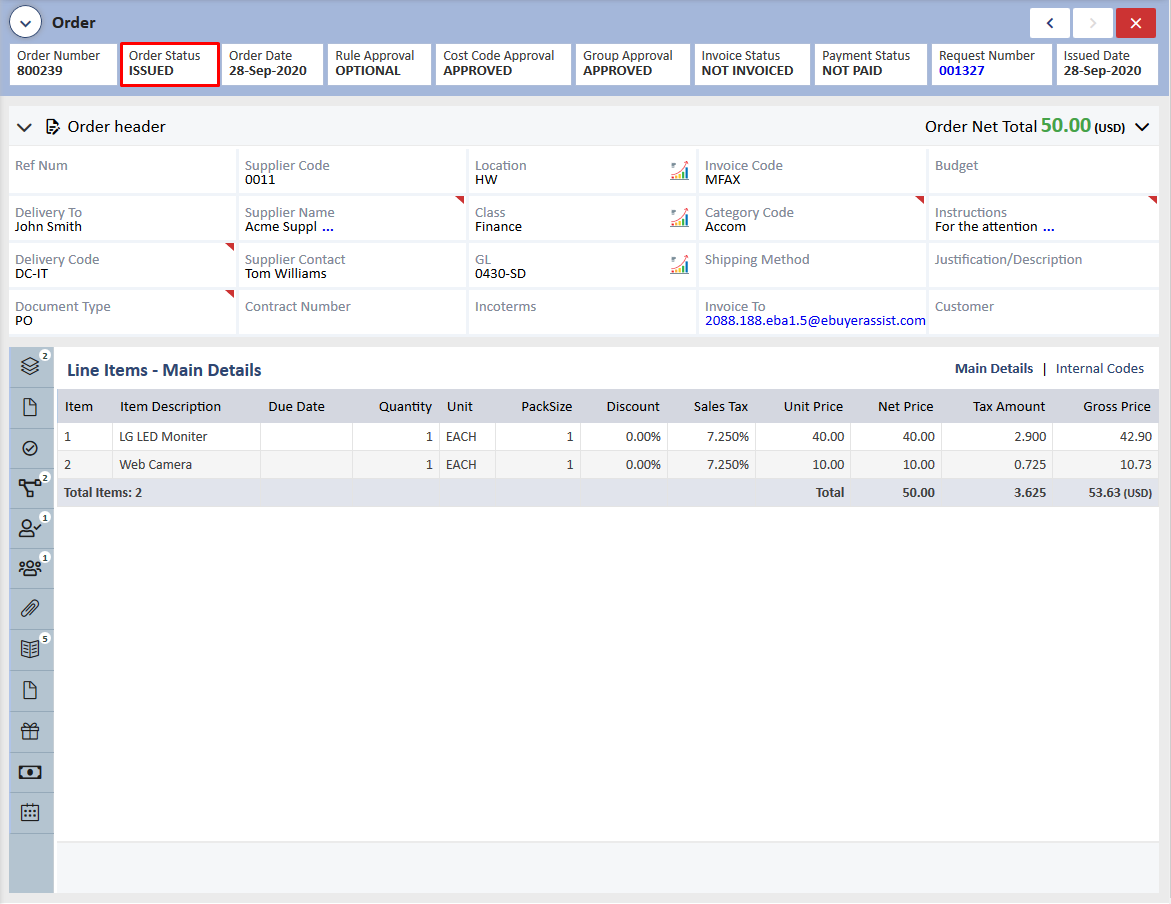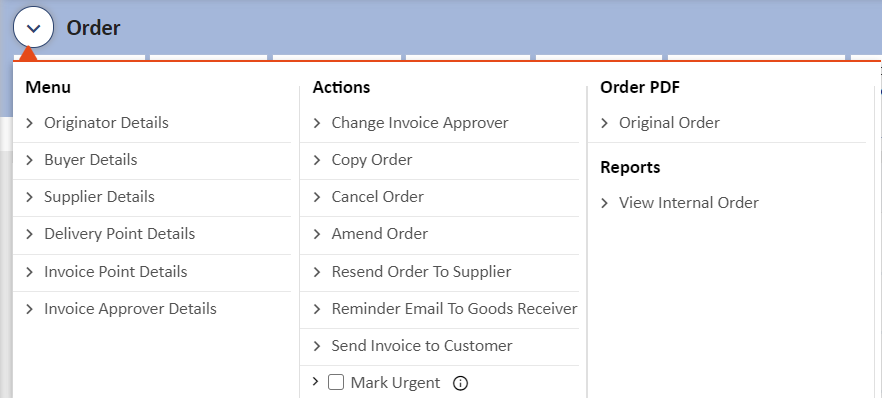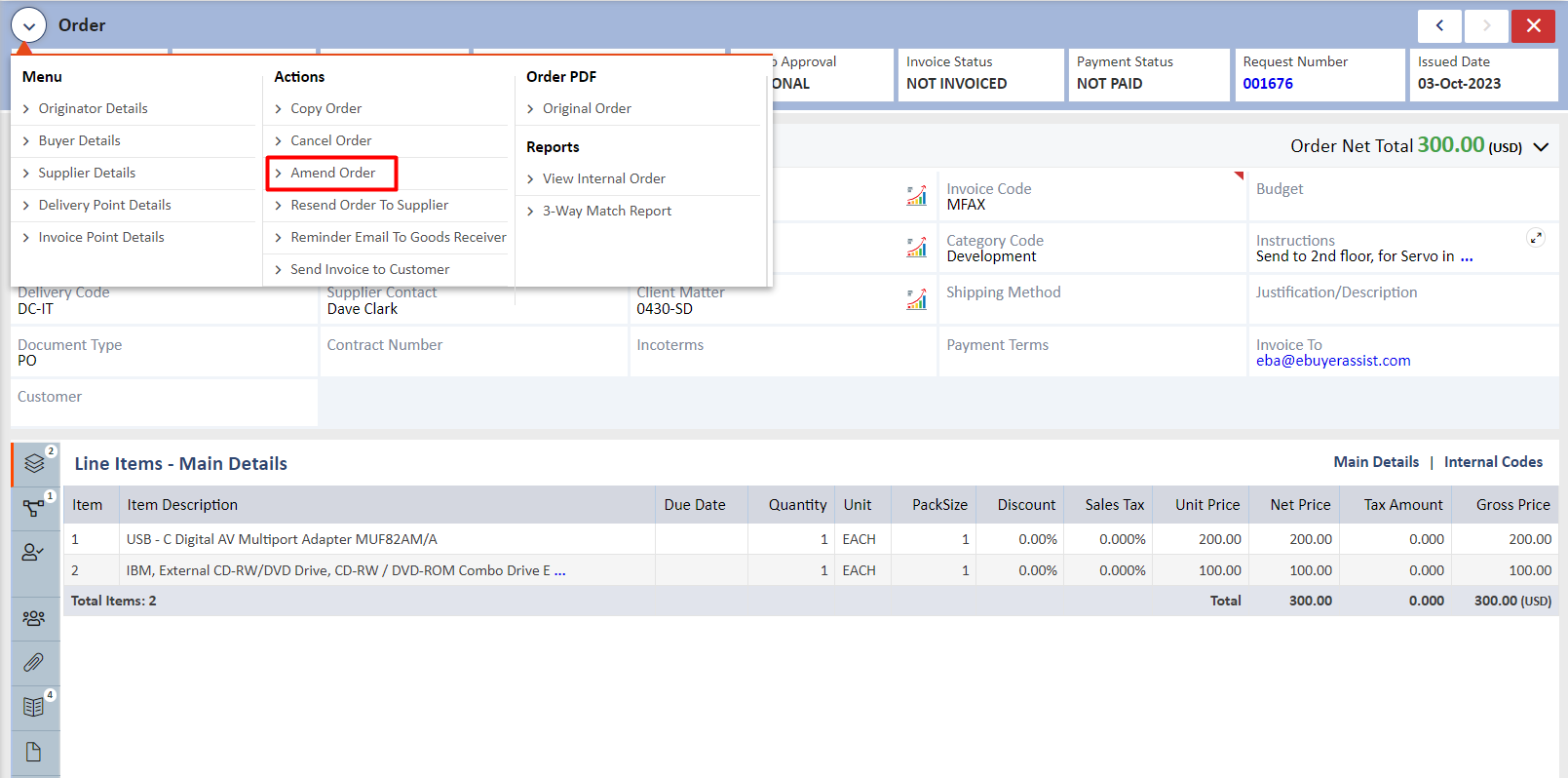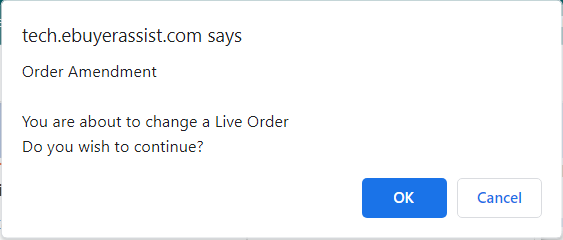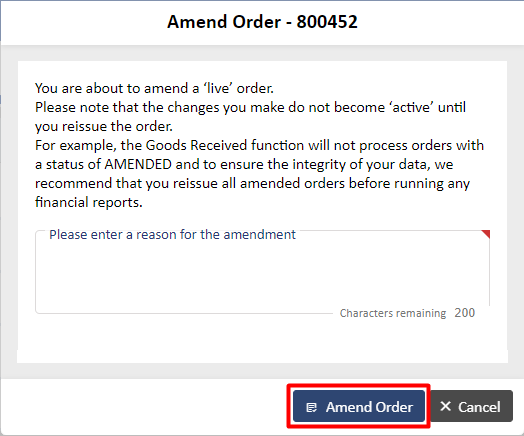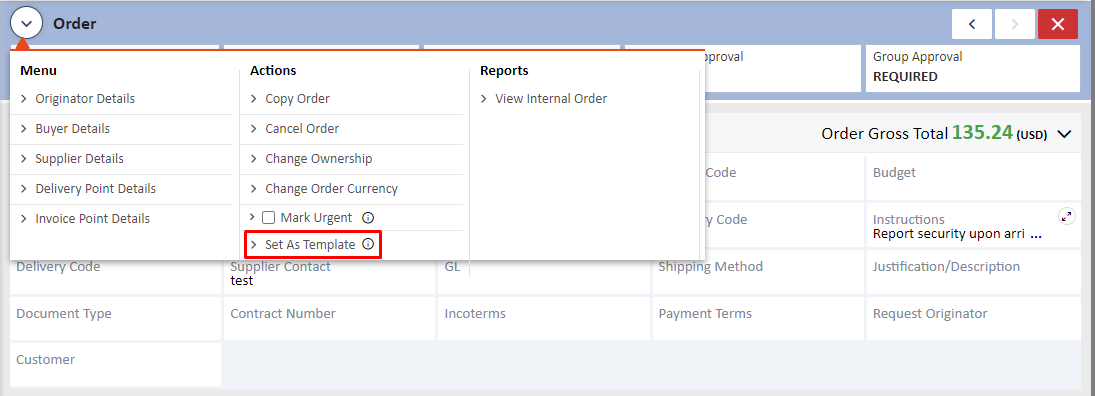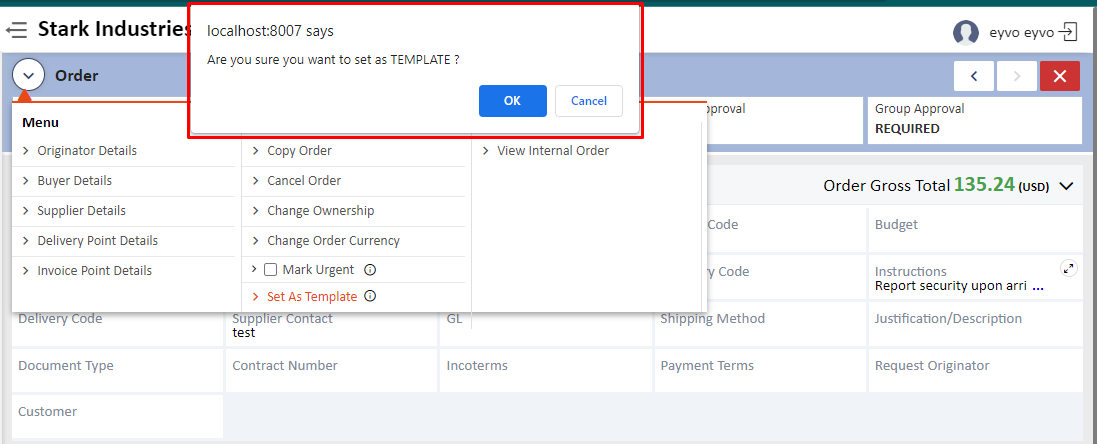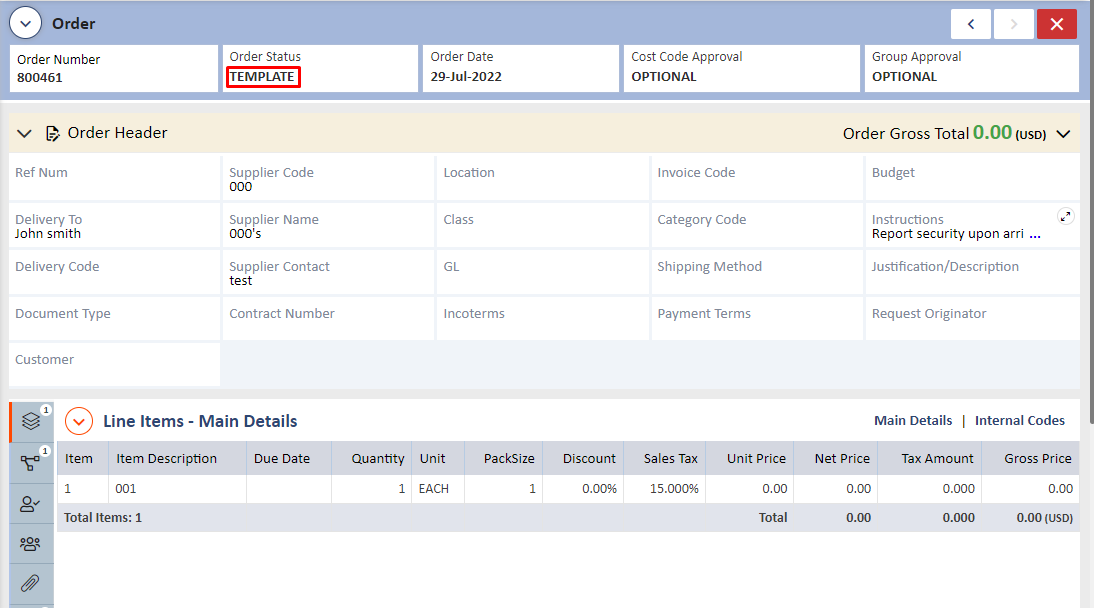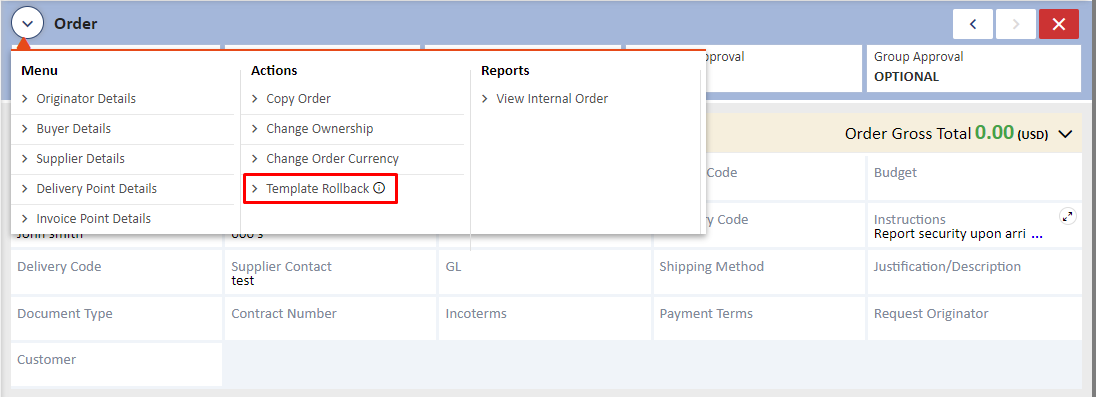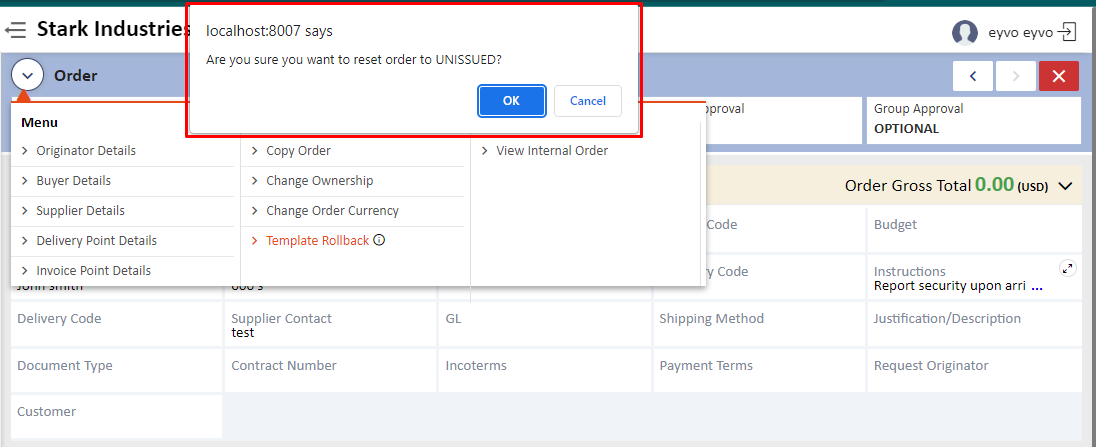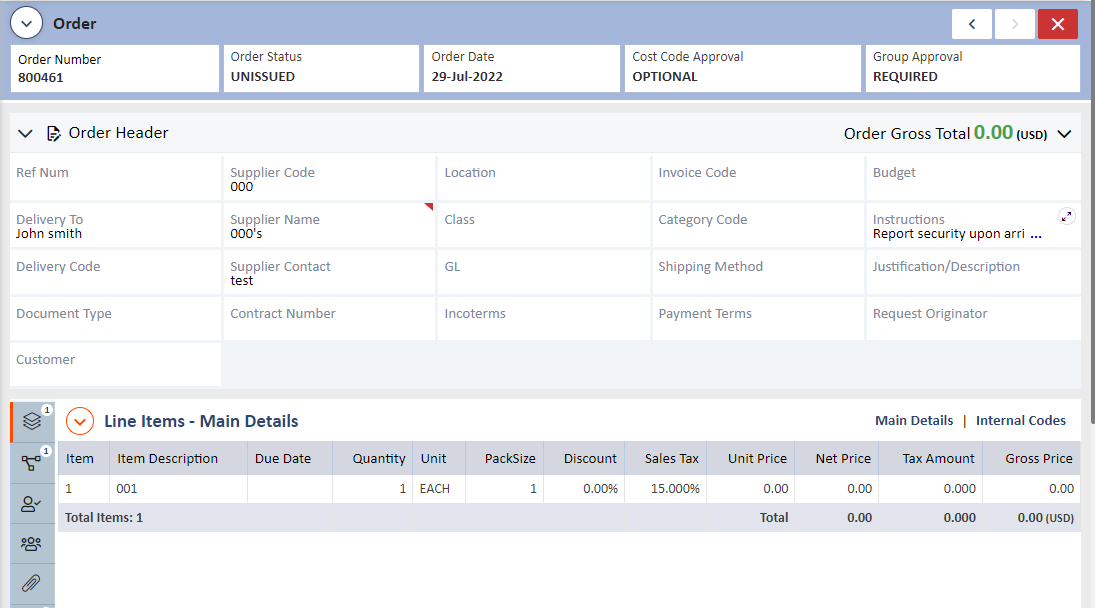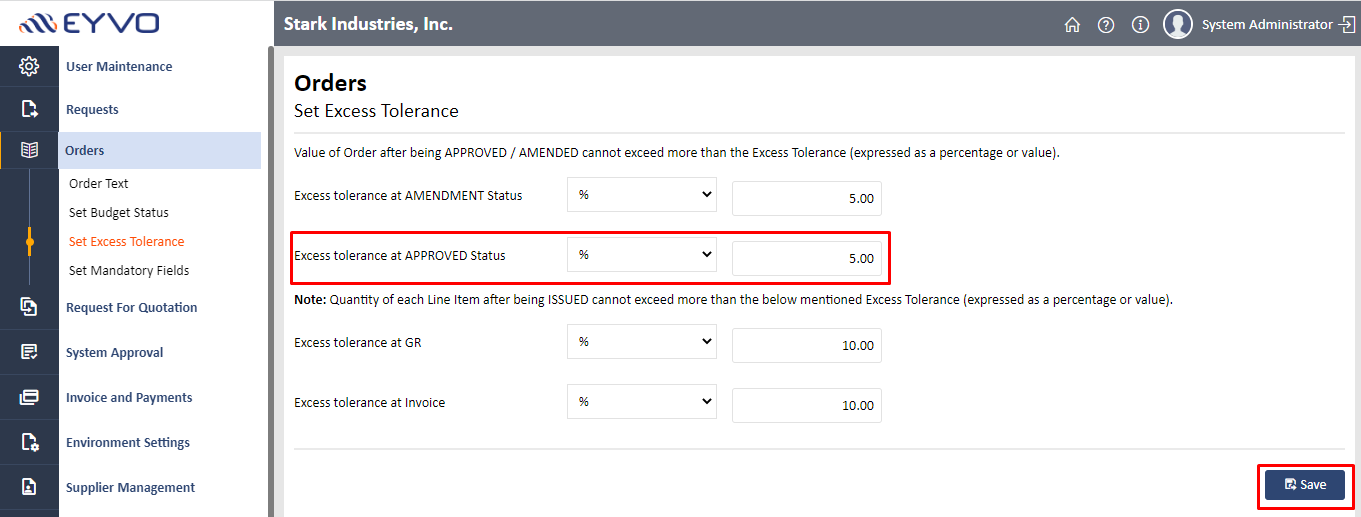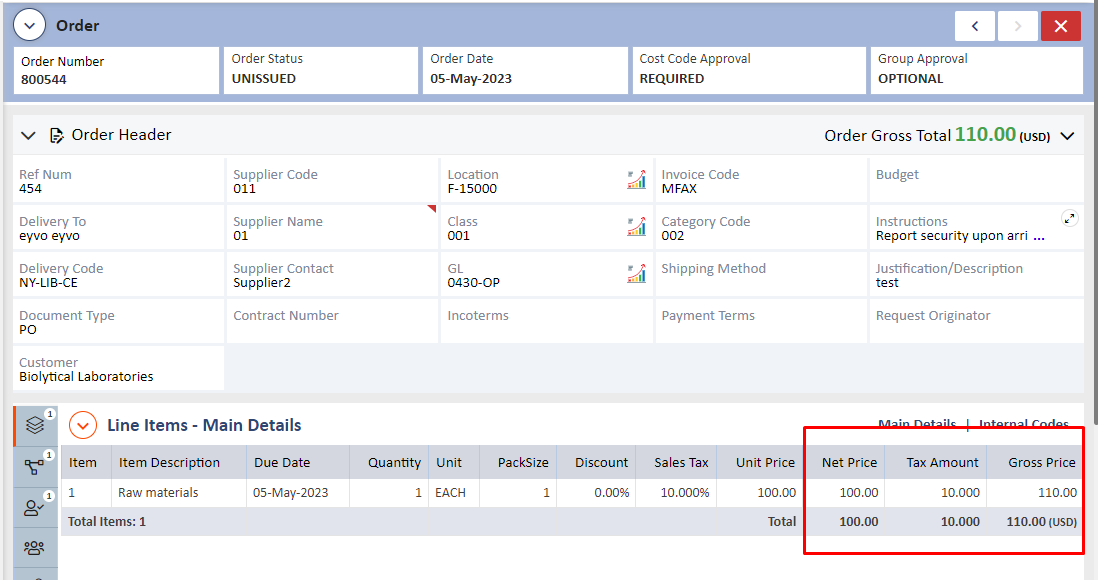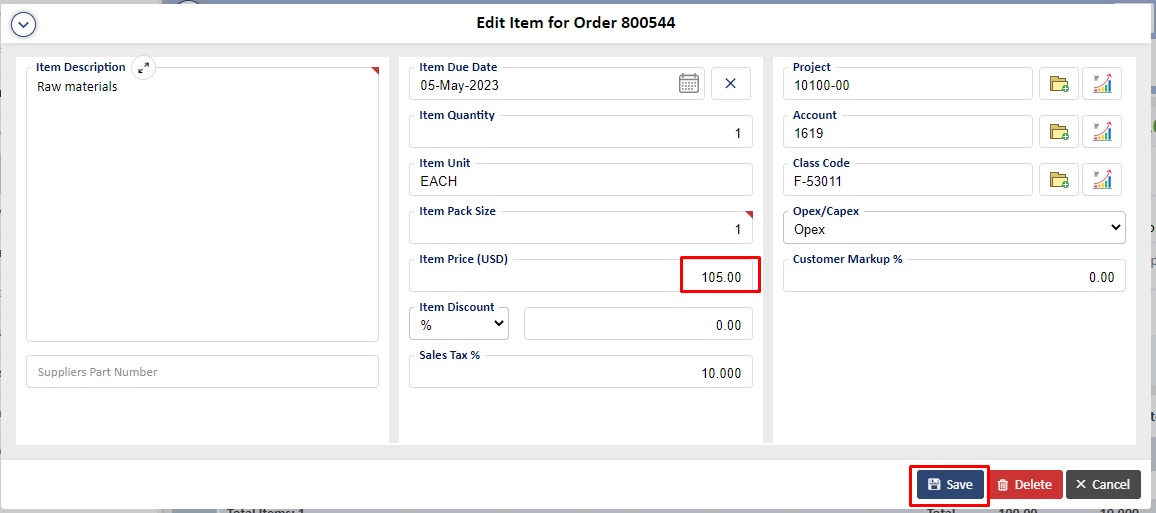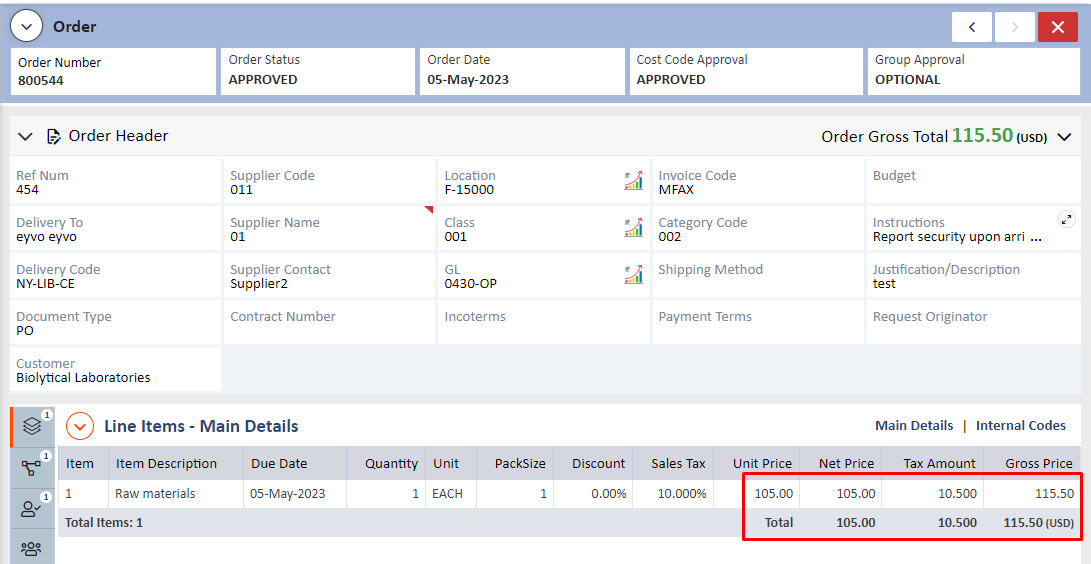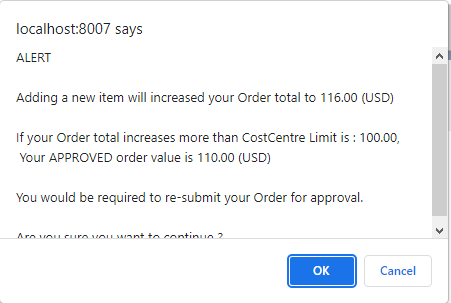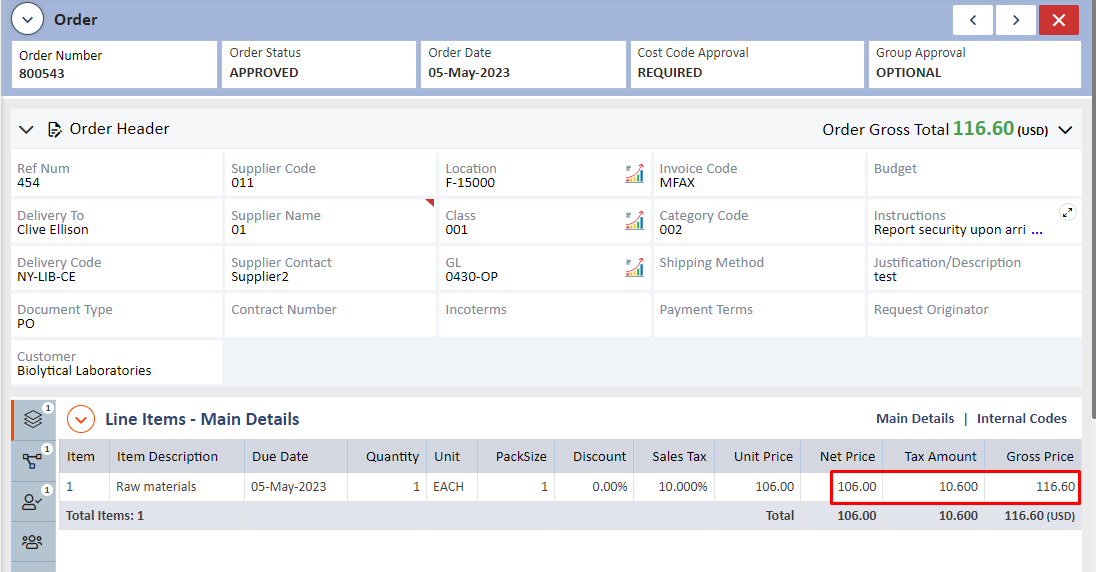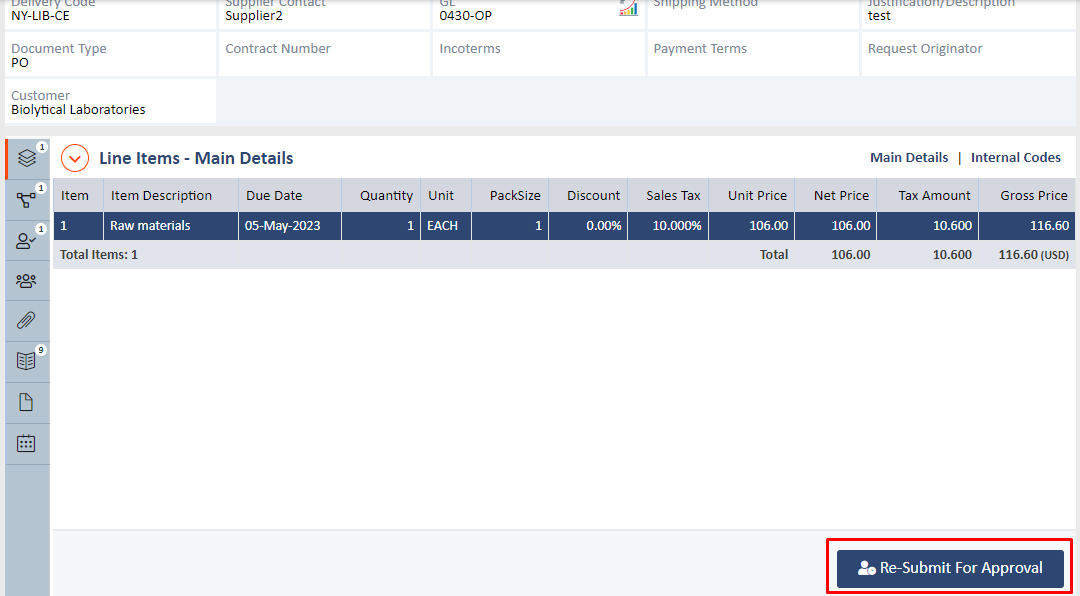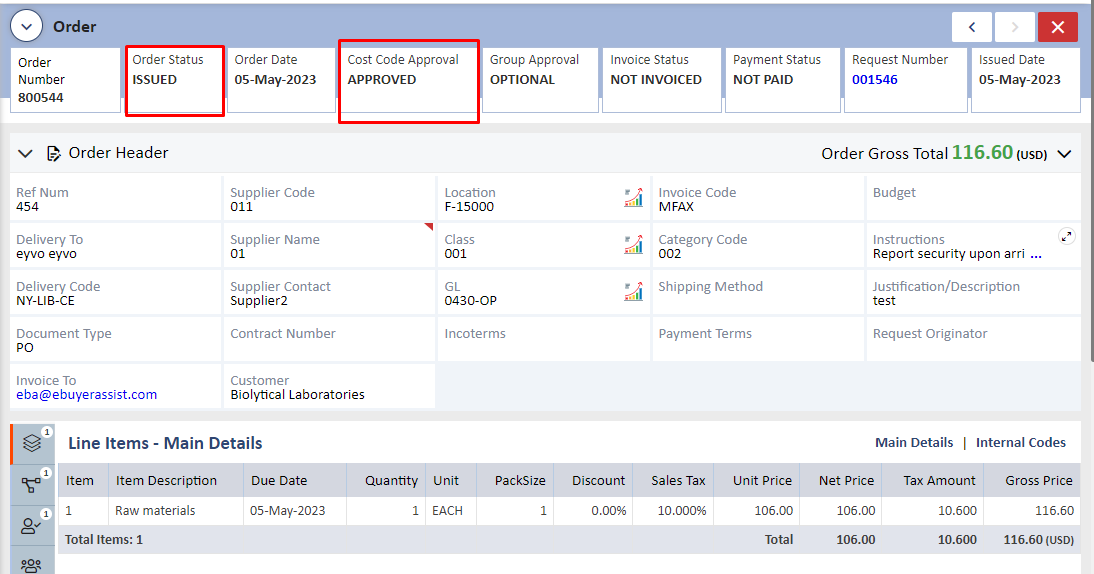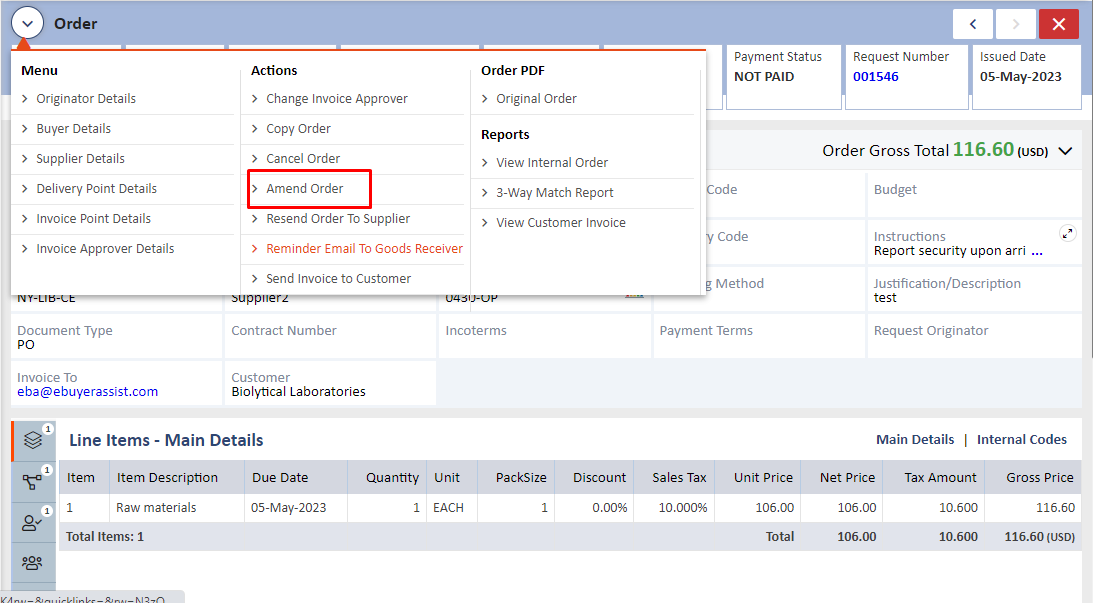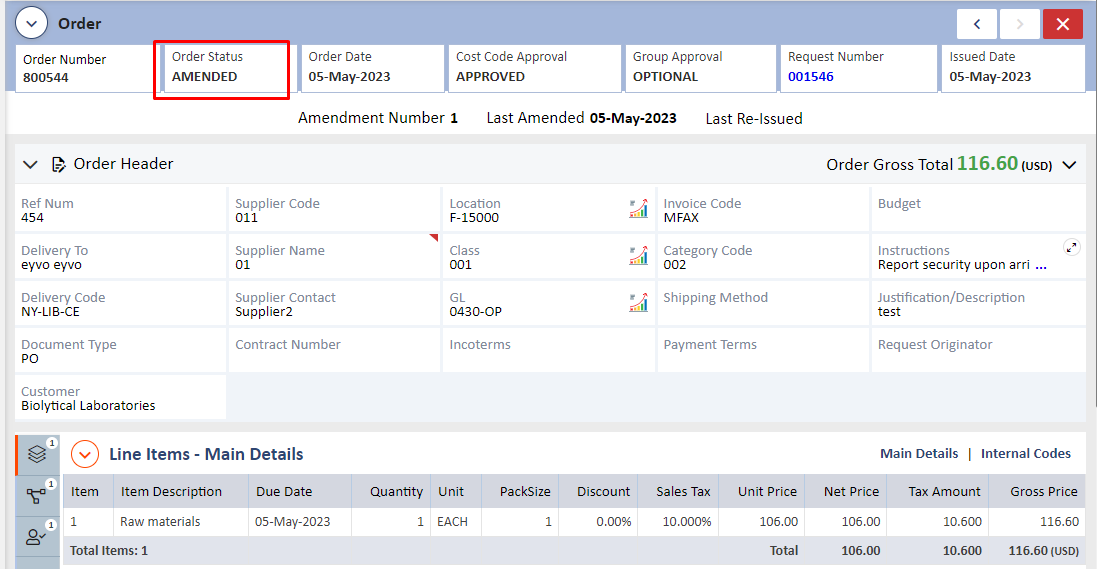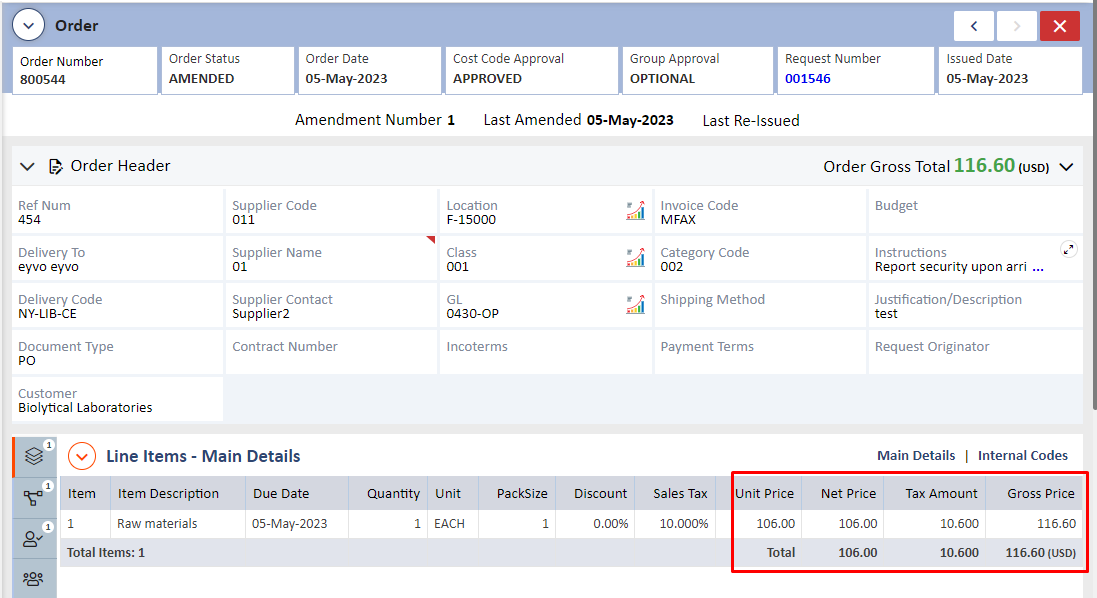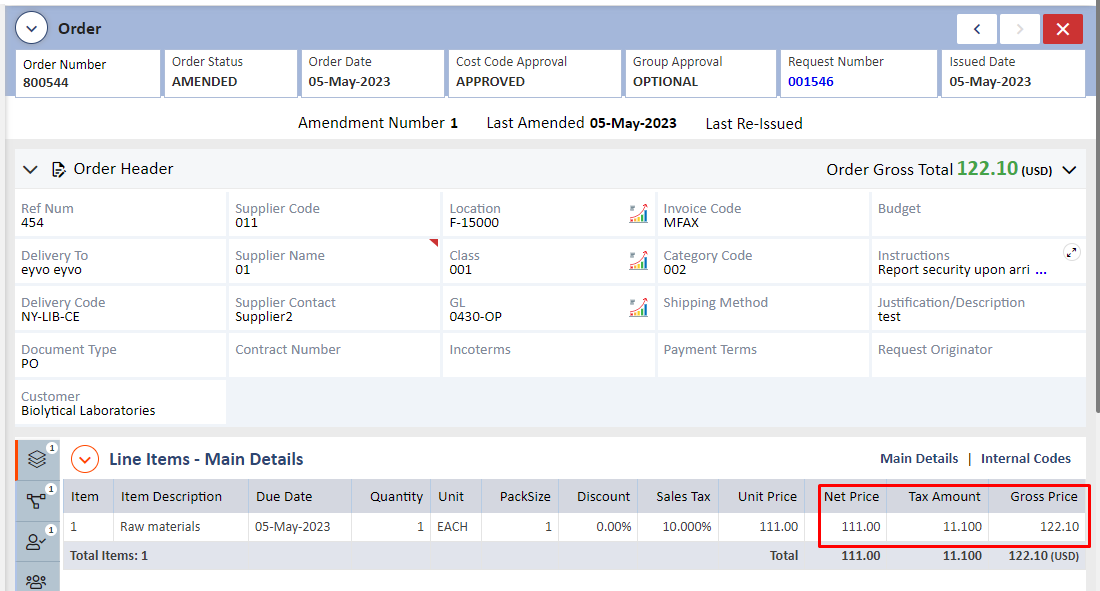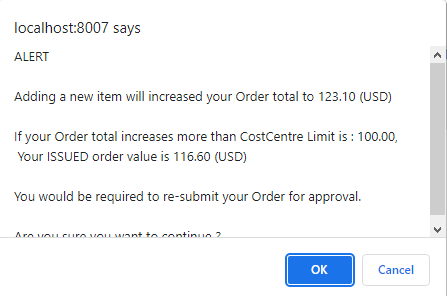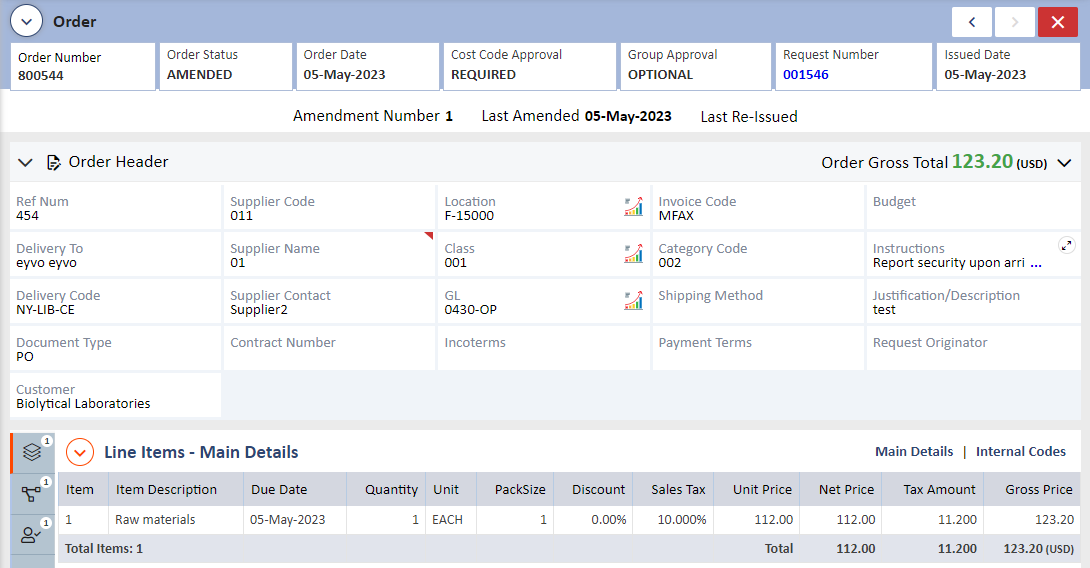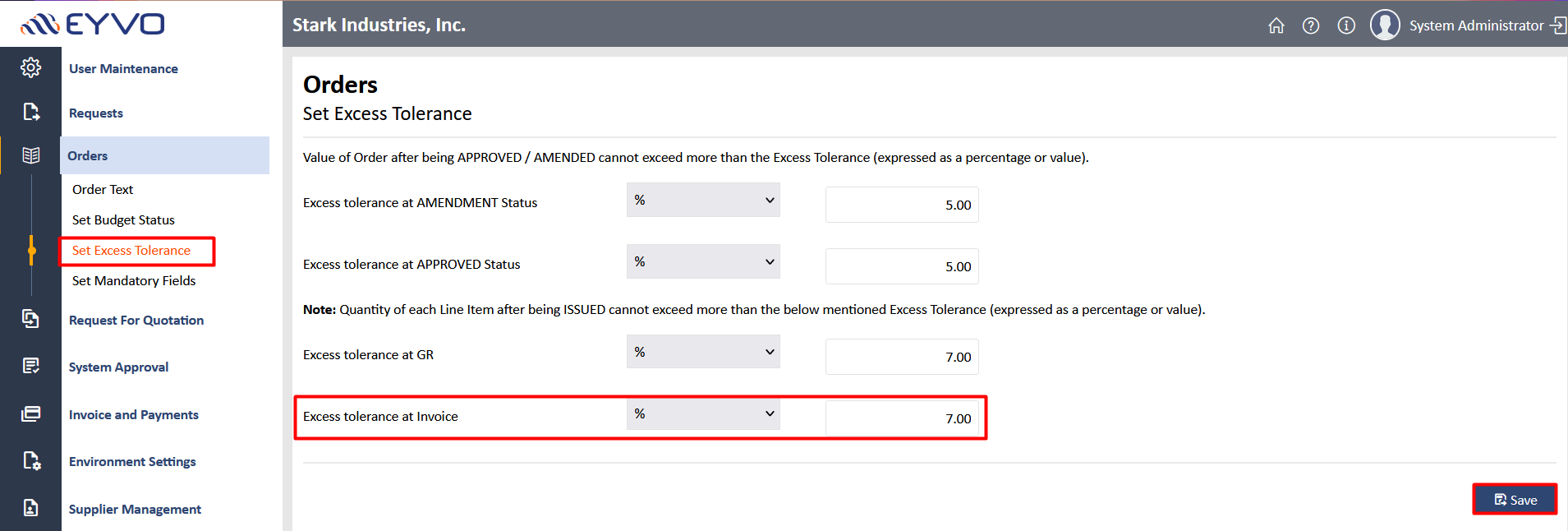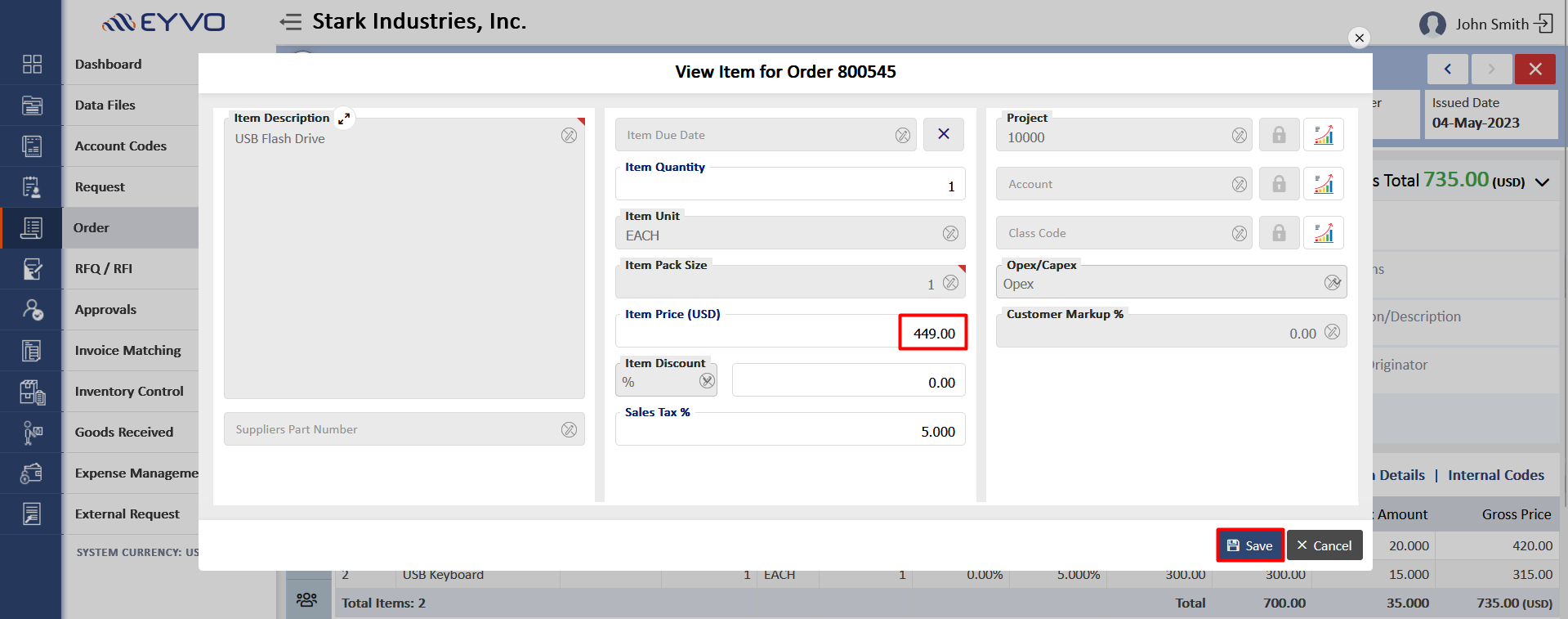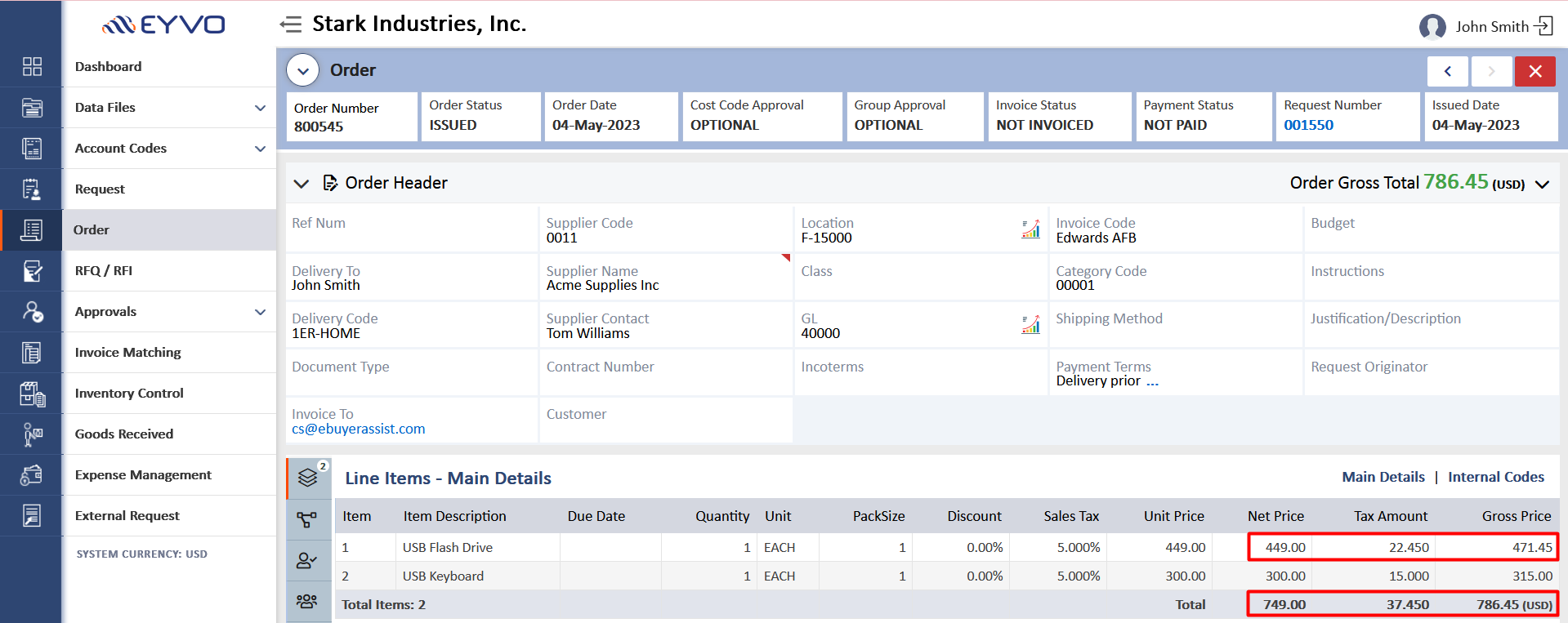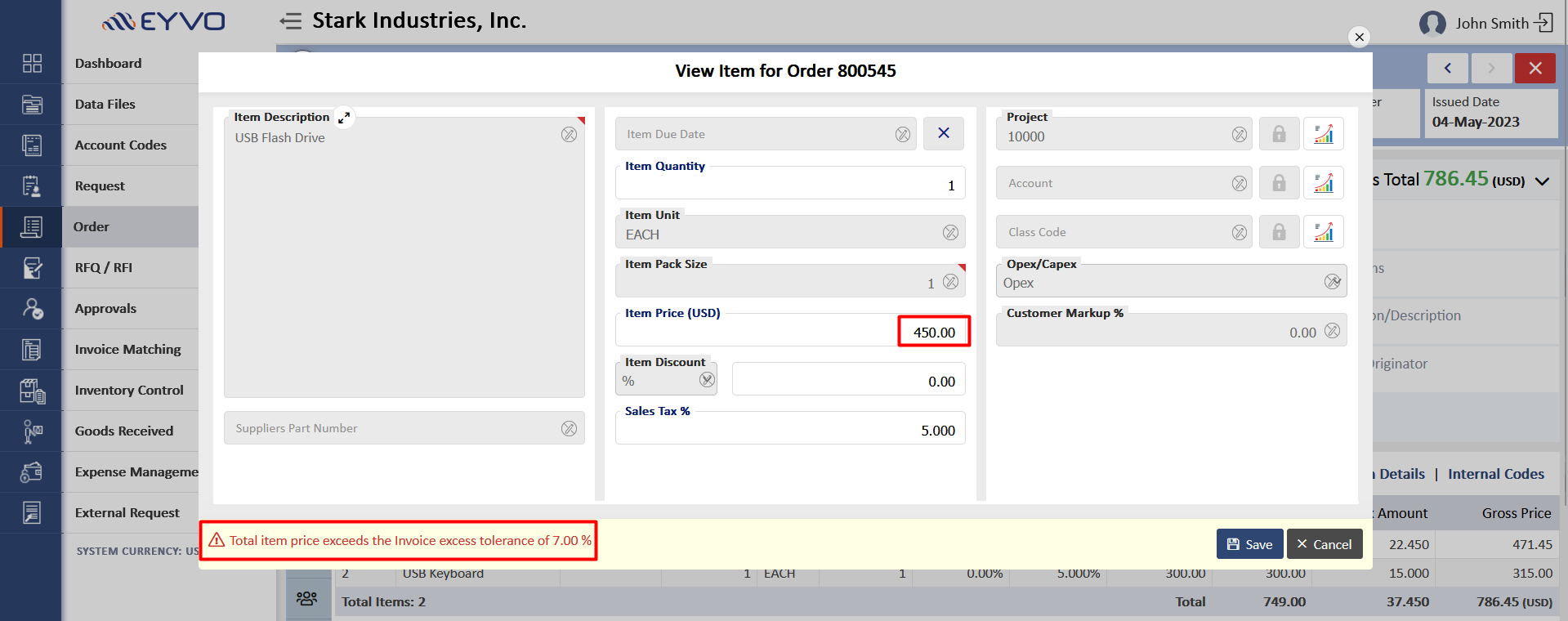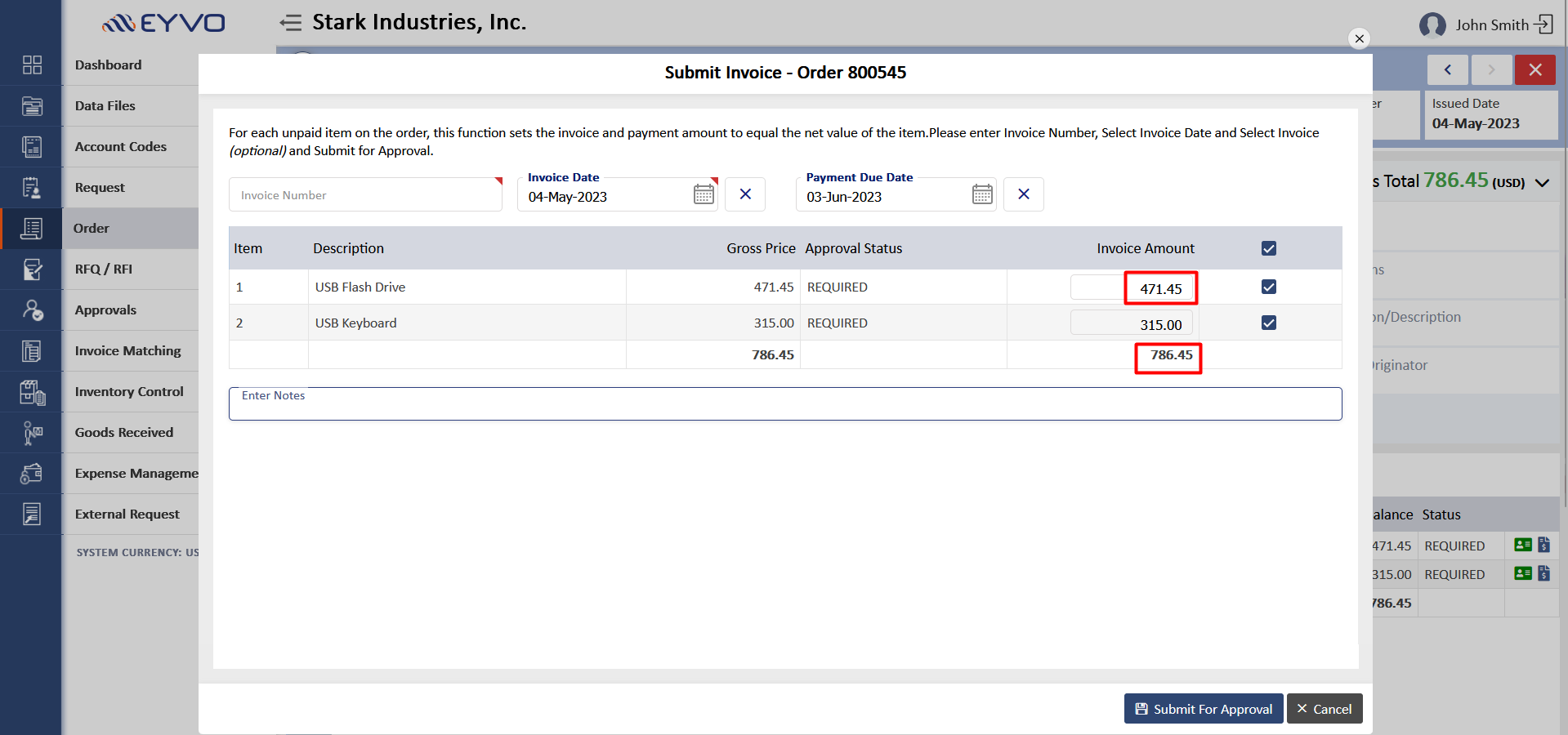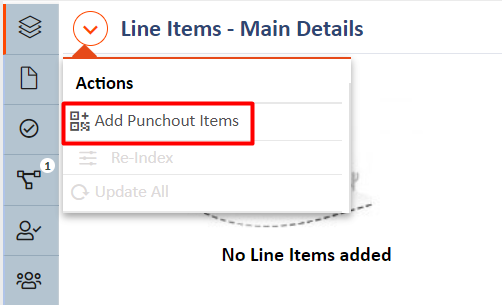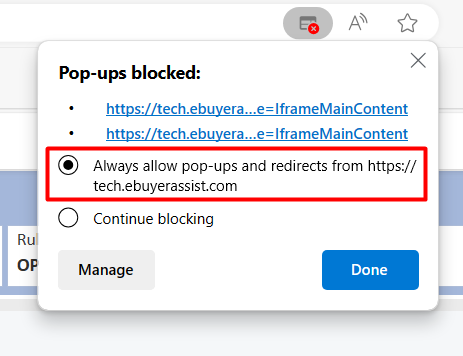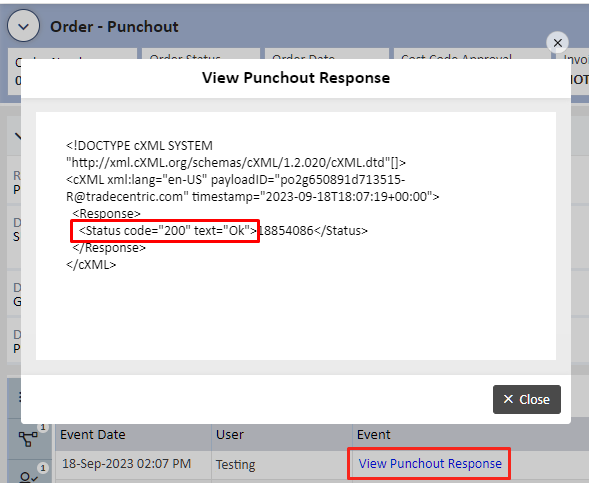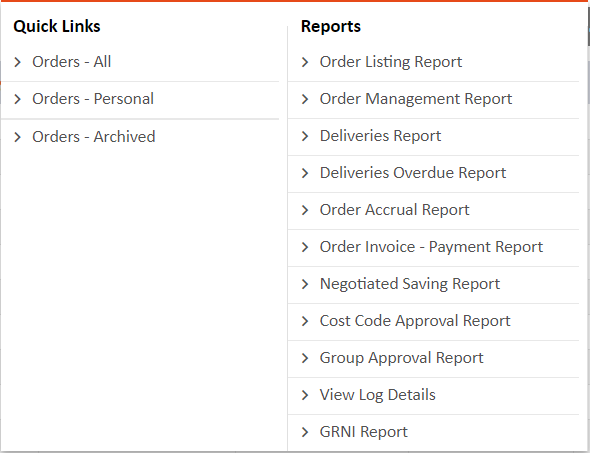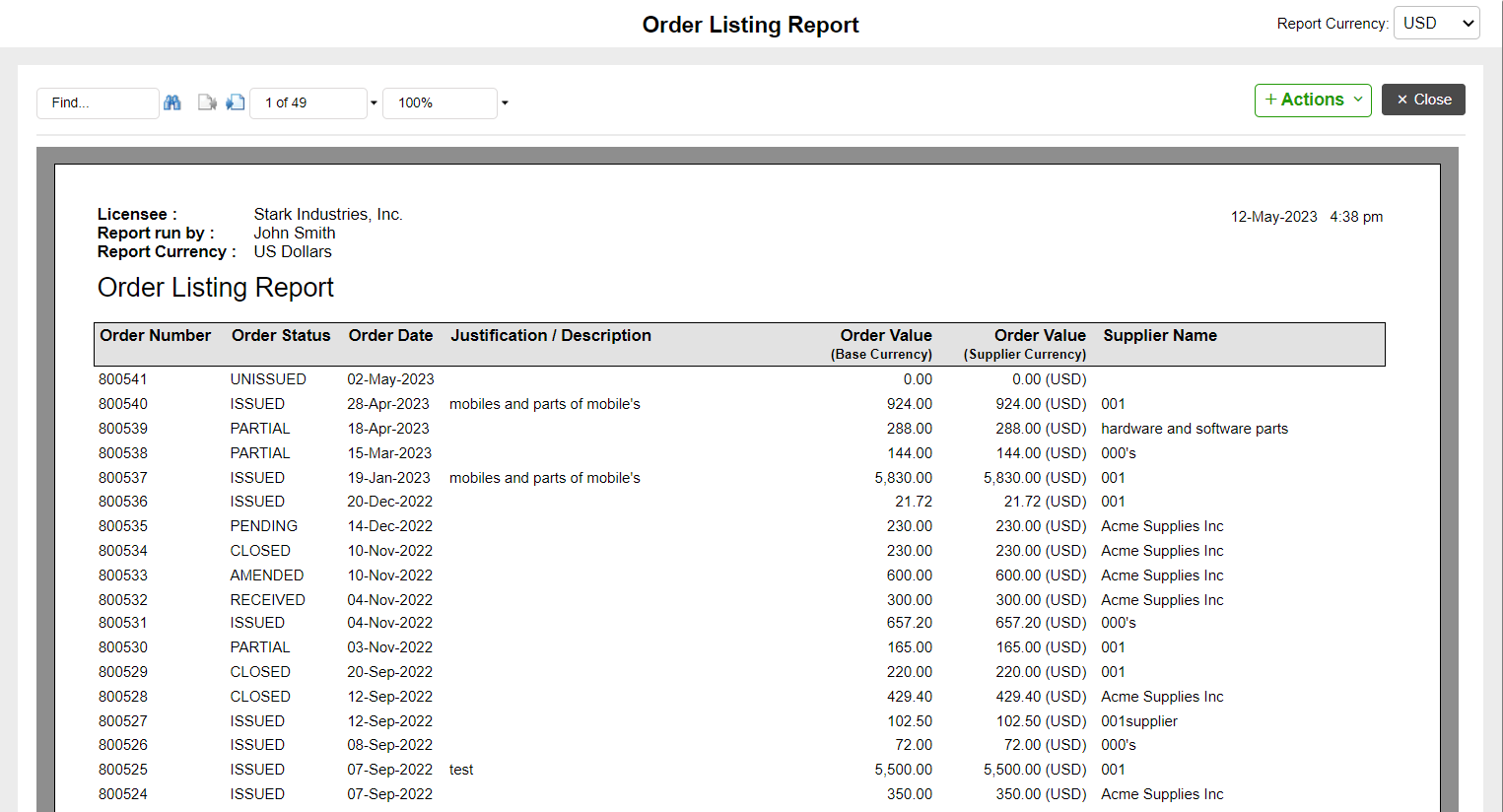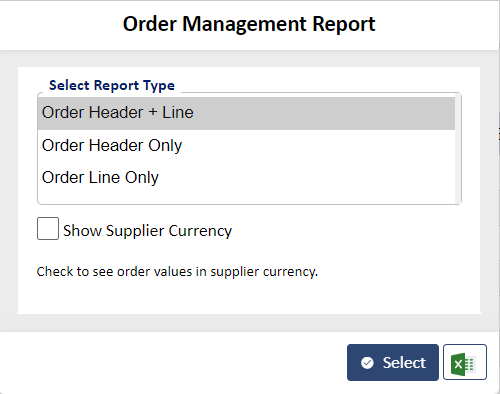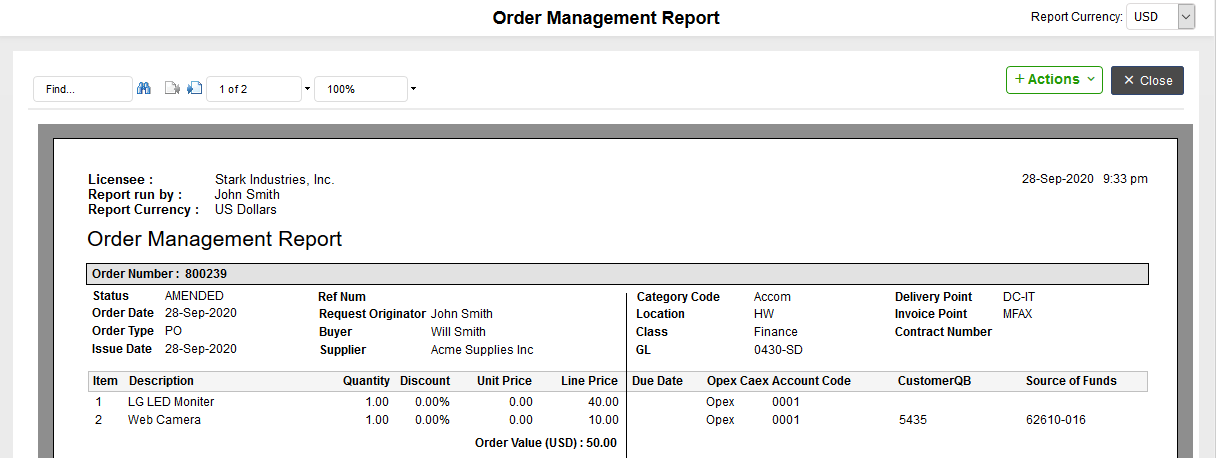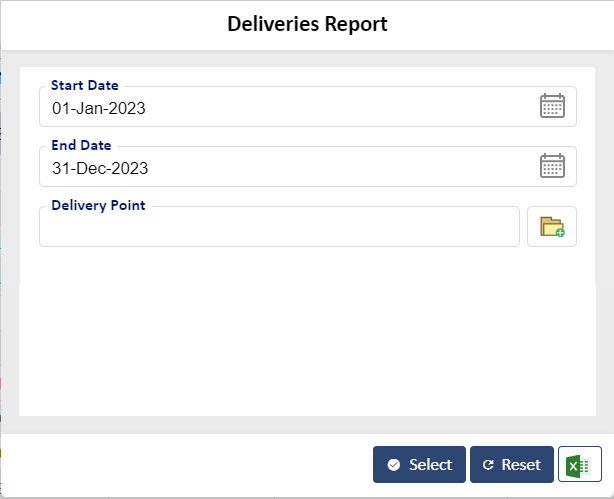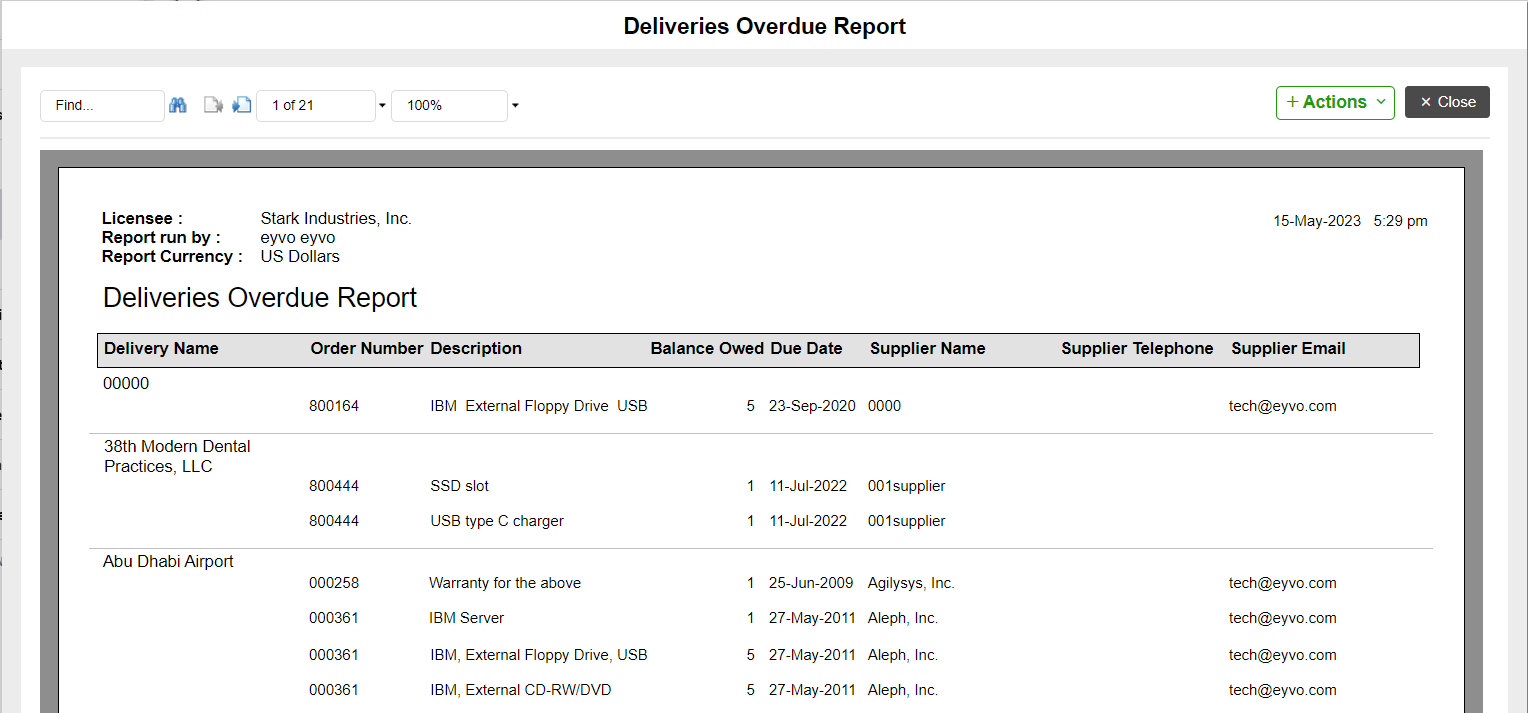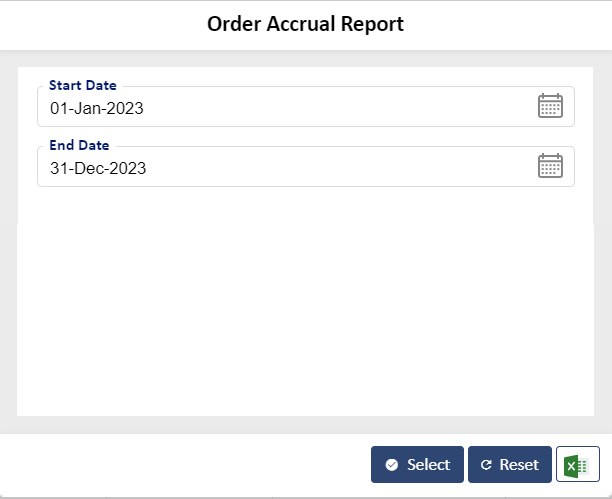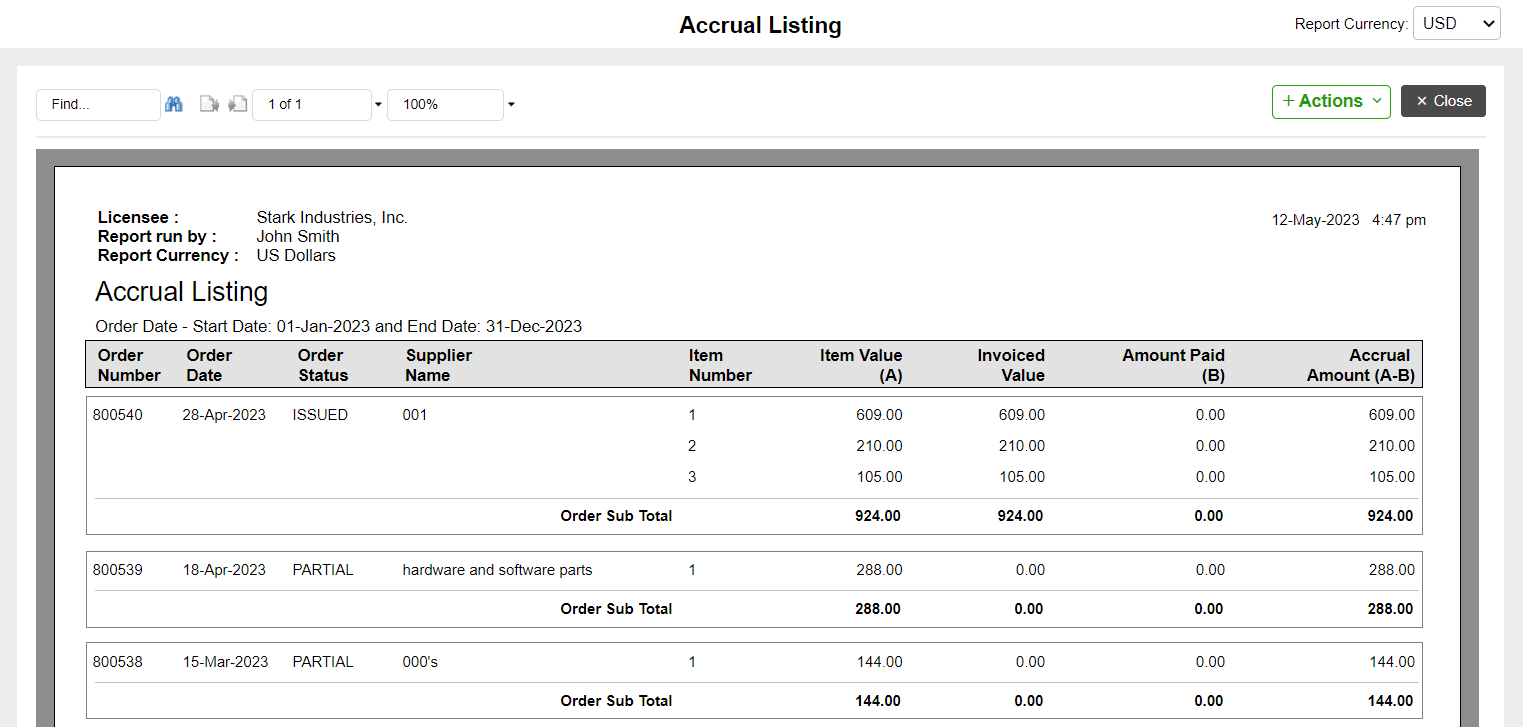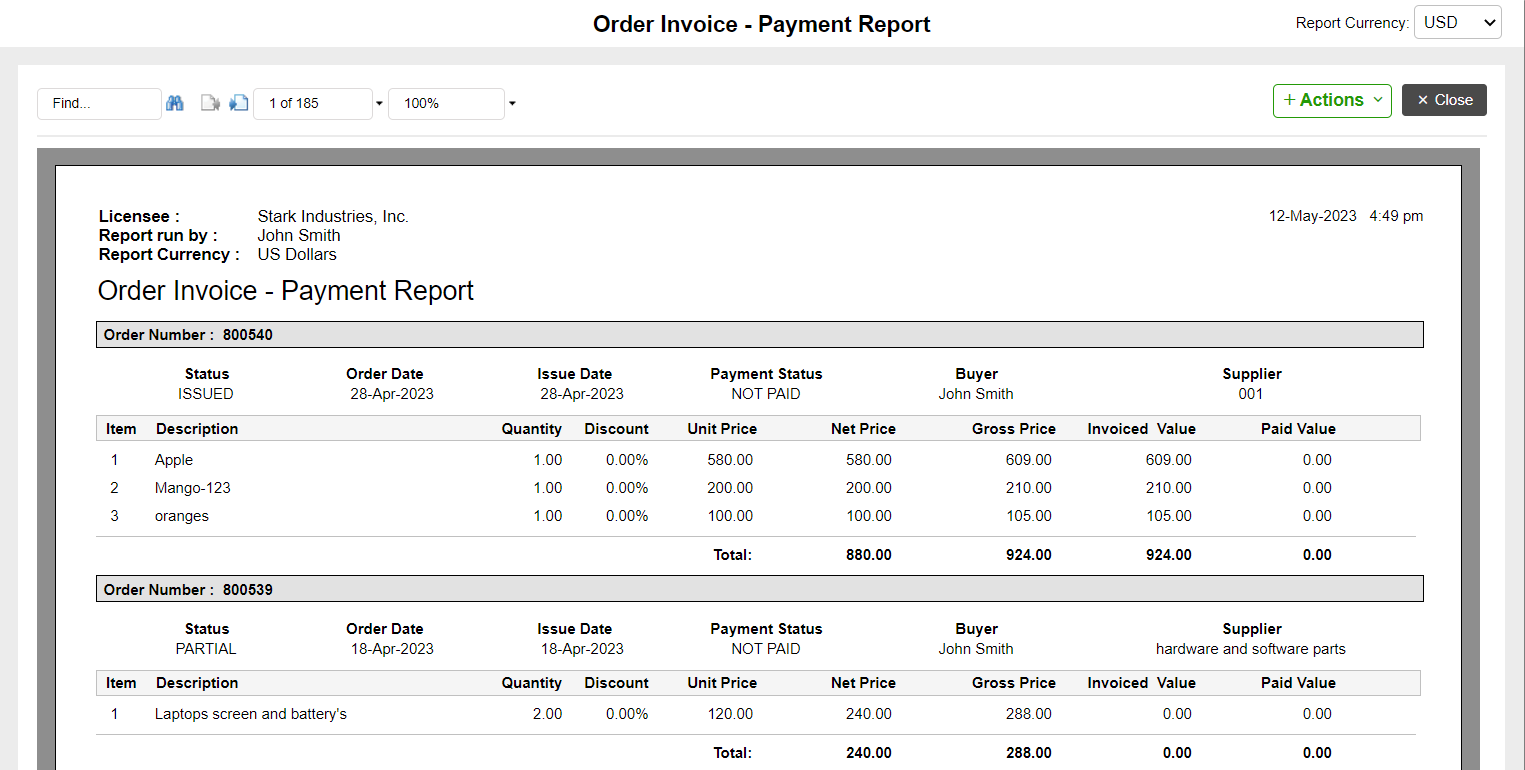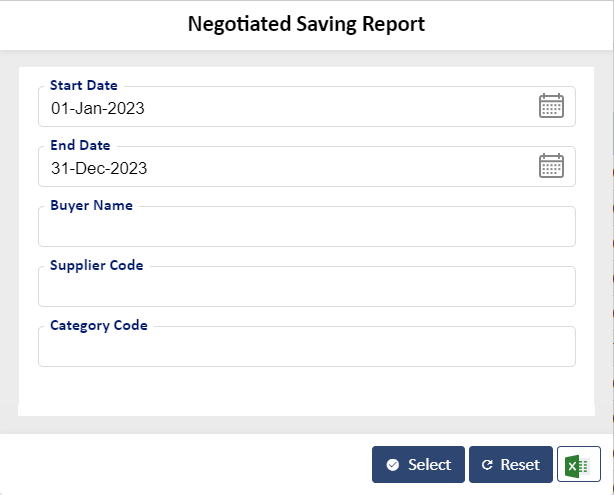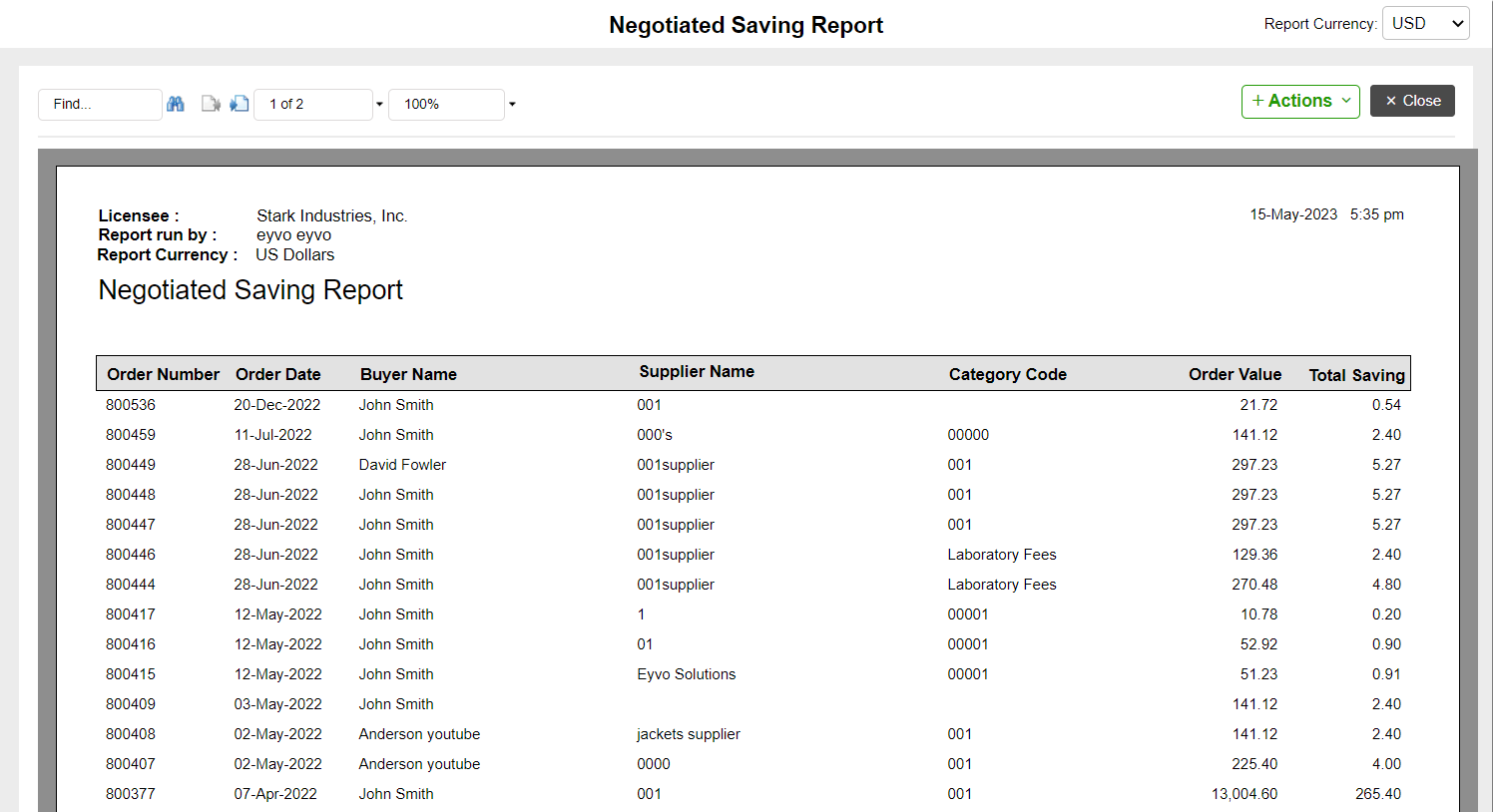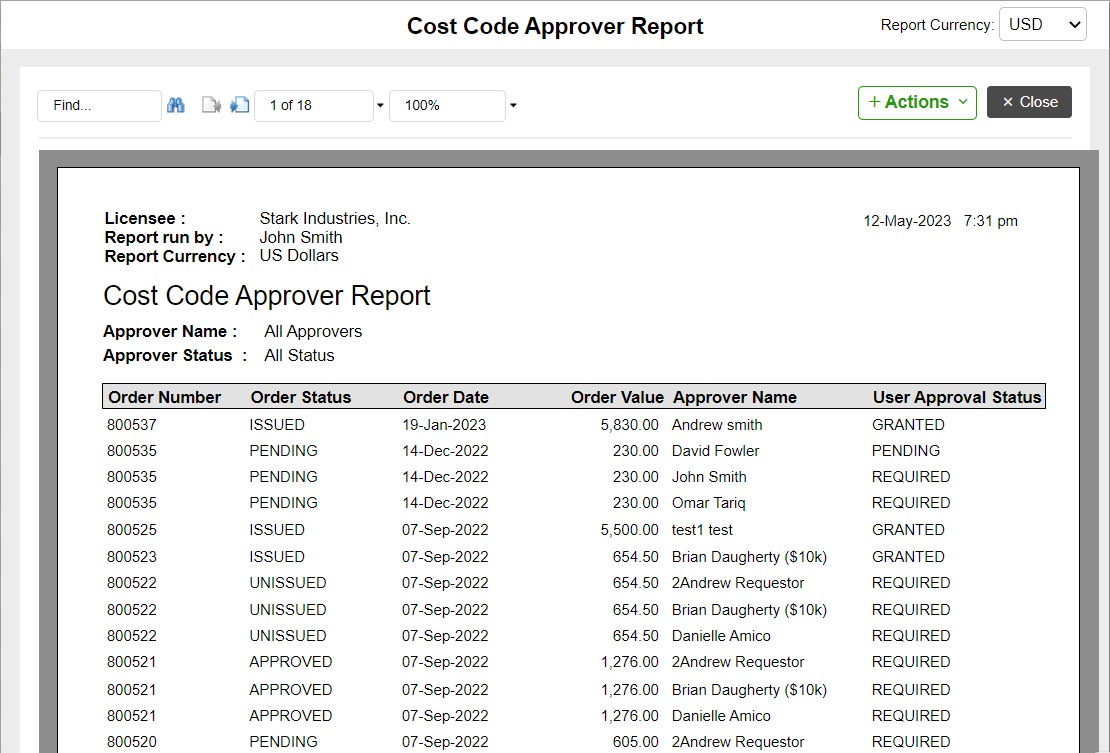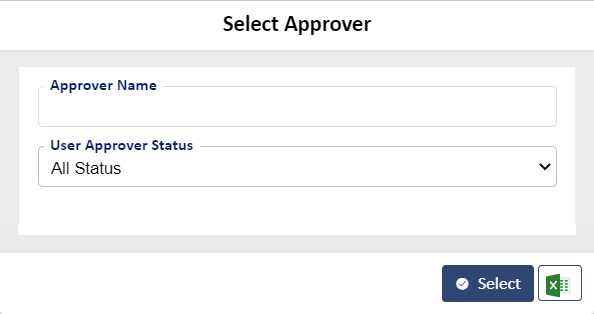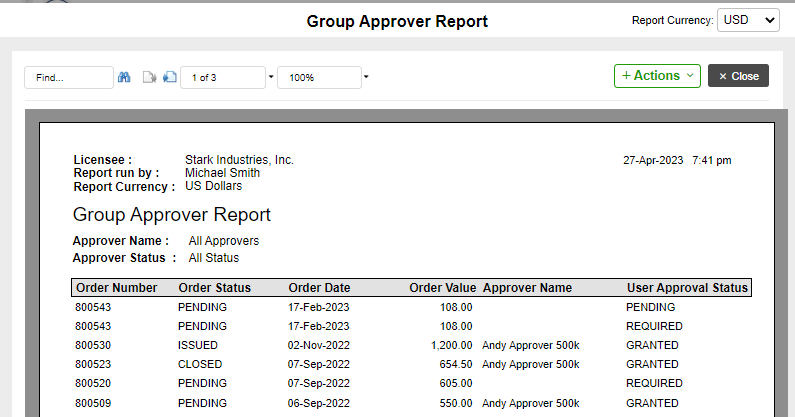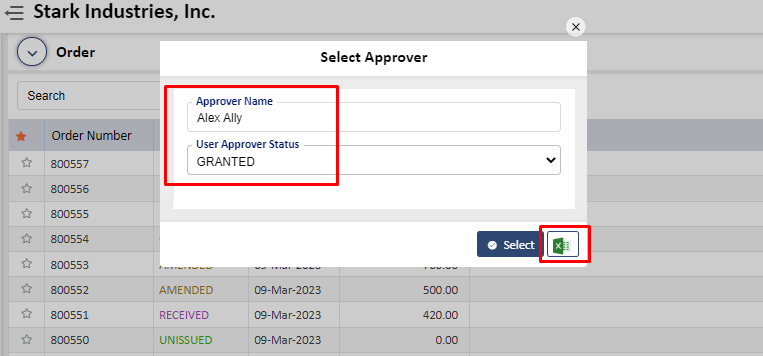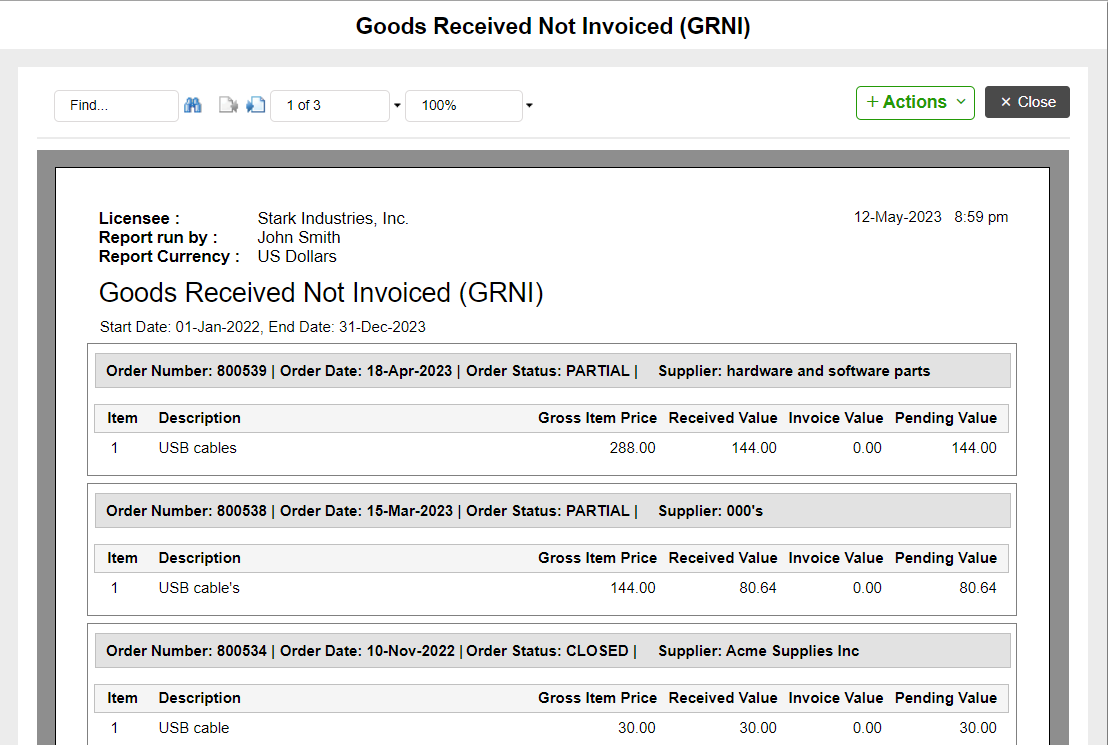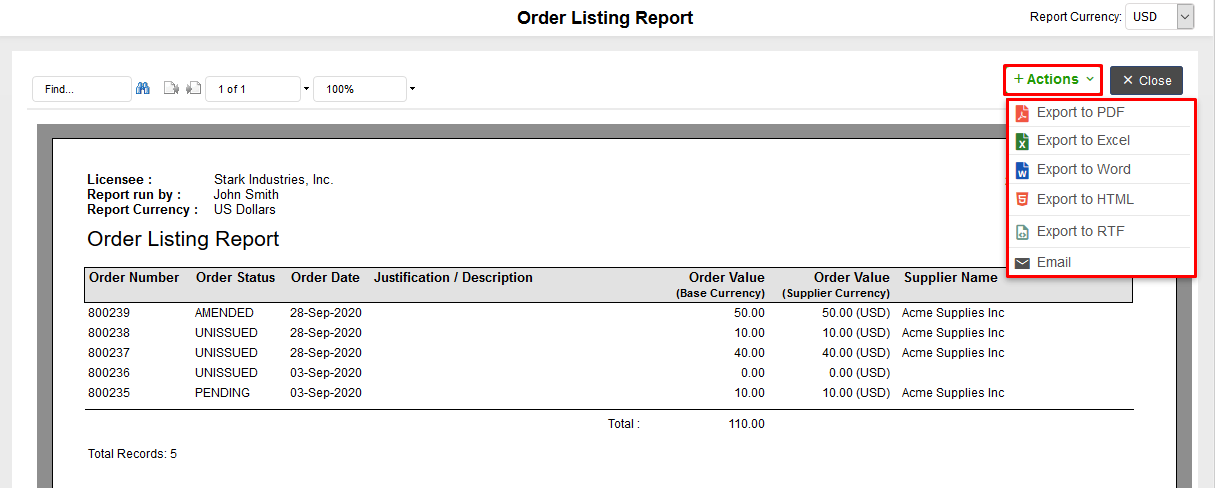EBA USER MANUAL
This document provides information on administrating Eyvo’s eBuyerAssist application. It is designed to enhance the performance and more efficient usage of the product. Using this manual, the user may find more information on configuring the application and performing specific tasks. It is intended to be used as a reference tool for users who have already completed a formal training course on the system.
eBuyerAssist provides a set of comprehensive work flow tools that will help you in improving the purchasing efficiency of your organization. This system contains all the tools required to centralize and manage your purchasing operation. The system will scale from a small department with very few users right up to a large worldwide enterprise with thousands of users.
Each user requires a license for each module that they wish to use therefore, you must purchase enough user licenses to cover the individual number of modules that are required. Although users cannot share a license, you can reallocate the existing licenses to different users.
The system employs user-level security, which allows or restricts the access of individual users to specific areas of the system. When a user logs-on, the system reads their permissions from the User file and establishes their level of access. The permissions assigned to a user decide whether a user can view, or modify the data in a particular area and if denied access, the appropriate menu option is either invisible or disabled.
Who should read this manual:
This manual is designed and prepared for daily and periodic users who will be working with eBuyerAssist as part of their normal daily routine and job function. It includes information for the different user categories such as Approver, Buyer, Senior Buyer, Requestor, etc. The status of each user is set by the System Administrator. For creating a user account, please contact the Administrator.
Technical Support
Requests for technical support should be made either through the Eyvo Website or by an email to support@eyvo.com. You can also visit http:/www.eyvo.com for more information regarding technical support.
OVERVIEW
The user application provides the users an option to maintain and manage the below:
The following flow diagram explains the various options available to you as you login to the application. The navigation and flow inside the application is designed to be intuitive and simple. These options will be explained in detail below:
Note : Users can only see the options for which the System Administrator has given permissions.
DASHBOARD
When you log into the system, the first screen that you will see is the Dashboard as shown on the screen below:
The top right corner under your (user’s) name will show you your profile along with details about our product and help documents for various modules and functions in the system.
The top left will allow you as a user to edit your personal details as well as the default codes as shown below:

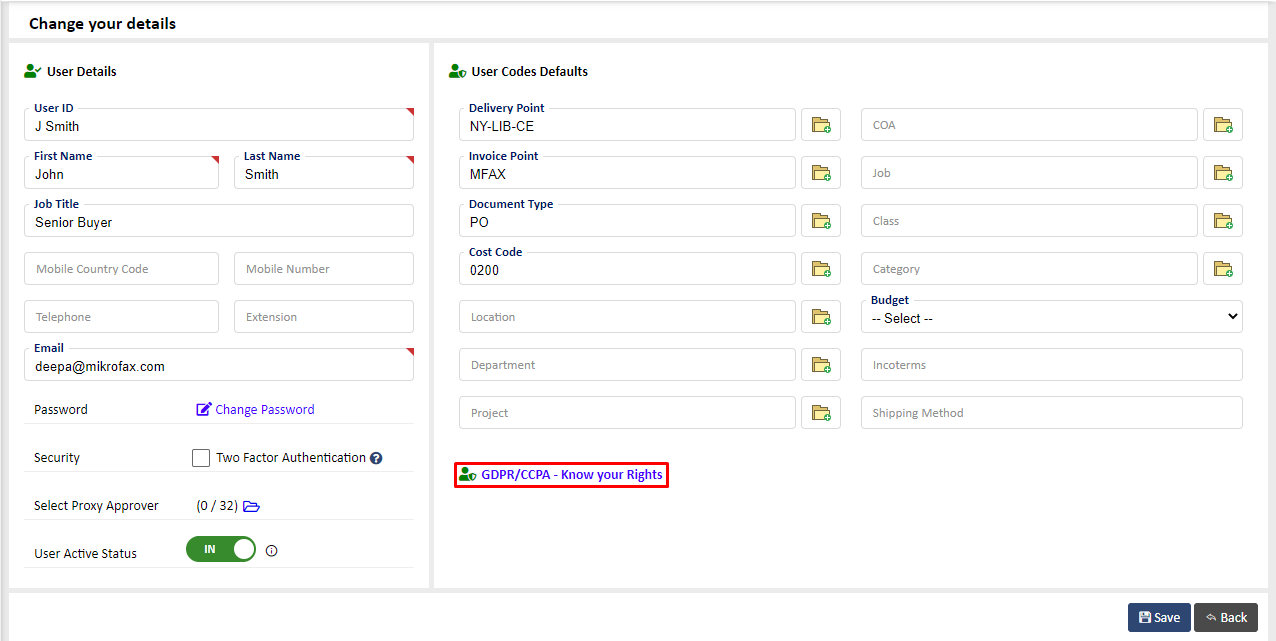
GDPR/CCPA
On the above screen, you will also see link to know more about GDPR/CCPA as highlighted.
In accordance with Legislation concerned with User Privacy, Eyvo complies with both the GDPR and CCPA stipulations.You can learn about both of these in the following links,
https://en.wikipedia.org/wiki/General_Data_Protection_Regulationhttps://en.wikipedia.org/wiki/California_Consumer_Privacy_Act
Please read Eyvo's own Privacy Statement https://www.e-procurement.com/privacy-statement/ - You have the right to know what information we hold on you and also the right to be deleted from the system under the 'Right to be forgotten rule'.
- 'Subject Access Request' This is a formal request under GDPR/CCPA that is a report showing you 'GDPR/CCPA Subject Access Request report' what information we hold on you - please click on the link in the application to access this report
- 'Right to be forgotten' To initiate the process for the right to be forgotten from the system please click on the link in the application and your request will be reviewed with respect to the legislation of your country and the application you are being asked to be deleted from - Please note that this 'Right to be forgotten' is not absolute and so this review step is mandatory to ensure your request still allows compliance from an audit perspective. Someone will revert back to you within 24hrs.
The dashboard along with showing you the system order totals and values at the top, will let you customize the widgets that you would like to see when you log in. To do so, click on the Menu button on the top right as highlighted below and choose the widgets you want to see on your dashboard:

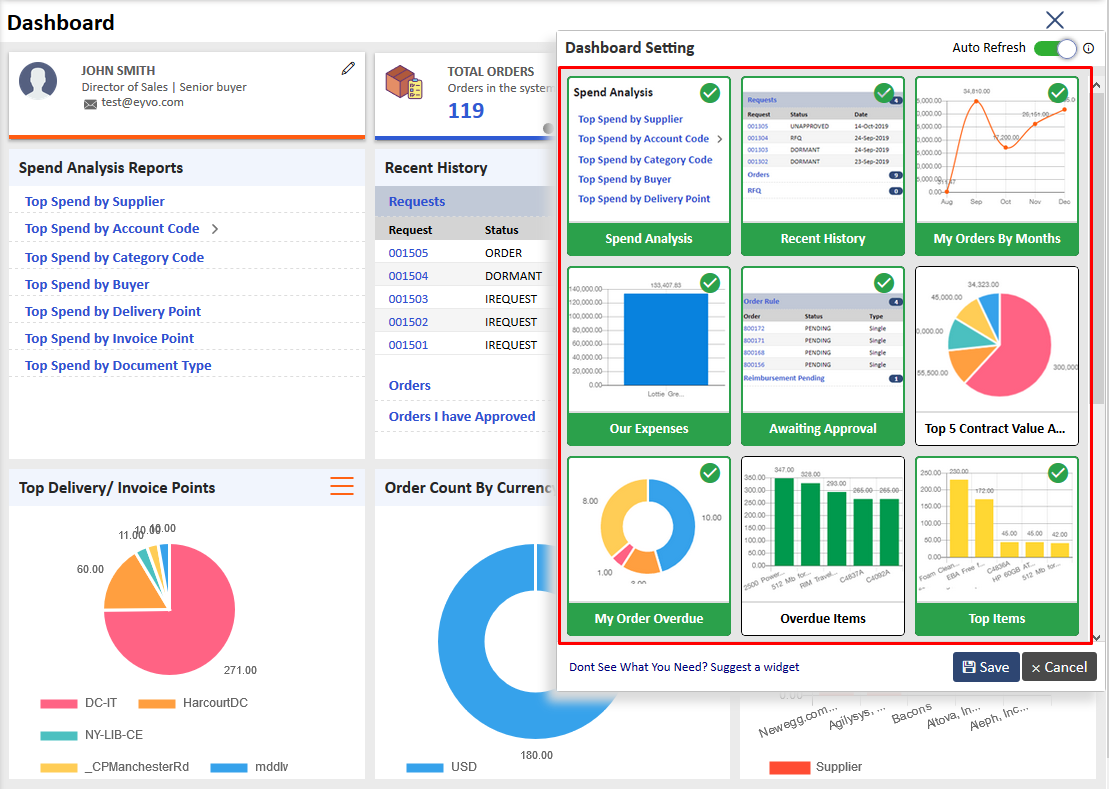
Click on the widgets and click on Save to add these. The widgets will give you an idea of the top spends by various criteria, history of your request, order, RFQ and recently approved orders as well as orders that are awaiting your approval.
Various graphs will also give you an idea of the orders and spends.
The graphs and charts when clicked on will further show you a drill down of details with an option to export as shown below in some examples:
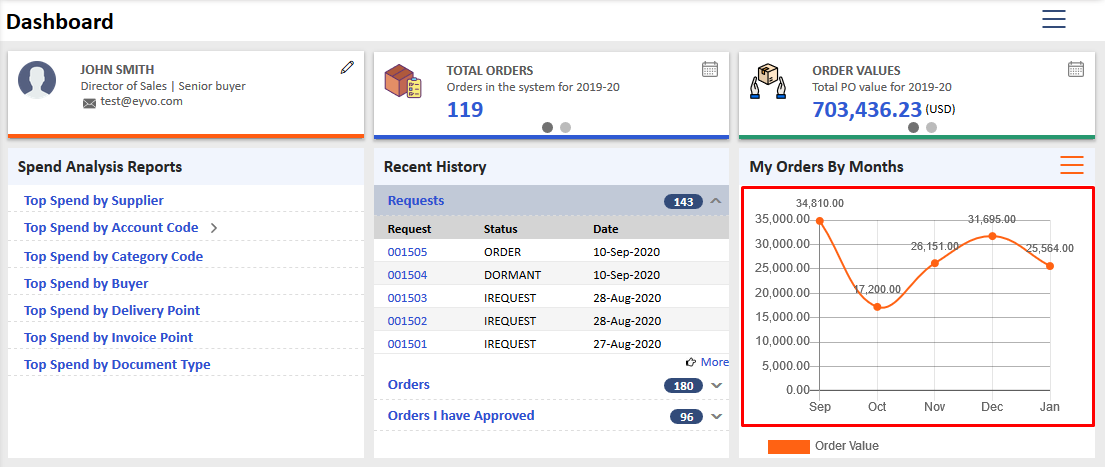
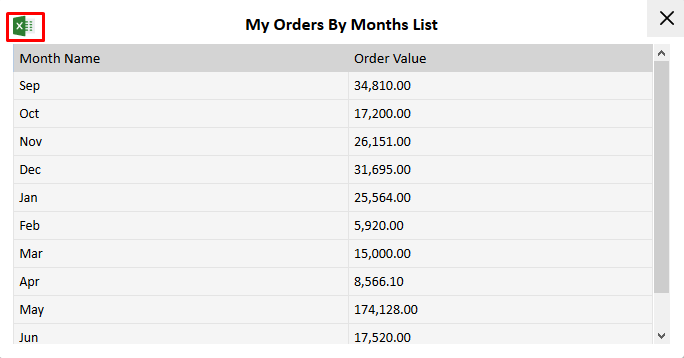
The menu options next to the widgets will also allow you to further granulate the details as highlighted in an example below:
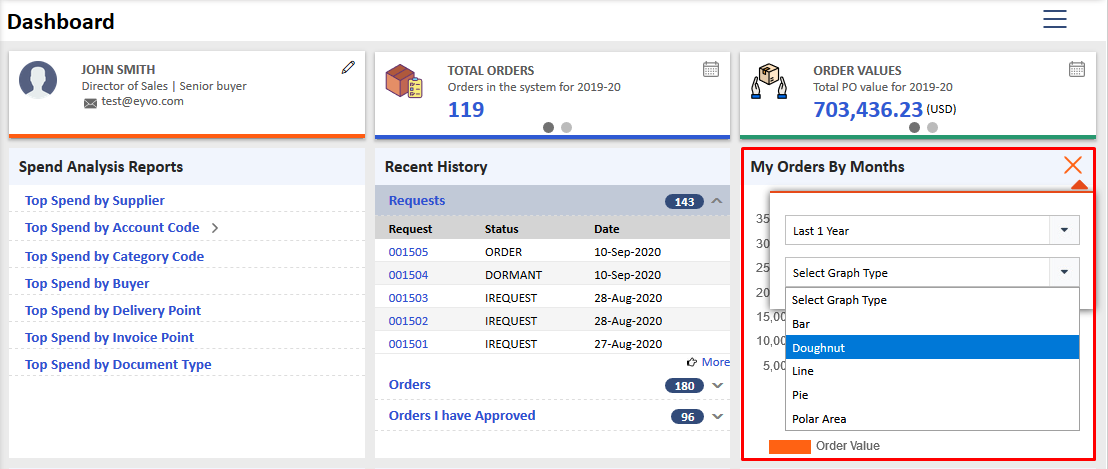
Note:The dashboard is user specific so you can only see orders, requests, RFQ, approved orders and history pertaining to you. Orders waiting for approval is shown only to those users who are request approvers or purchasing managers.
DATA FILES :
This section provides the user with options to maintain static data files such as category data files, delivery points, invoice points, items catalogs, suppliers etc.
These are found under Data Files on the left menu as shown in the screen below:
CATEGORY CODE :
Note : The steps described in this section are repeated frequently throughout the application and apply to other databases that operate in a similar fashion to the Category Code system.
1.To add a new Category code, click on “Add New” on the Category Code Listing page to see the below screen:
You can add a supplier and budget and further allocate a budget monthly by clicking on the monthly budget icon as highlighted above:
2. To Edit a category Code, click on the category as shown below:
3. To Delete a Category Code, click on that particular code and click on the “Delete” button as shown on the screen below:
4. To Search a Category Code, enter the details on the search field and choose the relevant search criteria from the dropdown on the Category Code Listing page as shown below and click on the “Search” button.
5. To do an Advanced Search, click on the advance search icon as shown on the below screen:
This will give you options to search as per the fields that you choose as shown on the below screen:
You can select various fields using the plus icons in the middle and search as shown below:

Once done, you can also save your search for future reference by clicking on the “Save Search” button as highlighted in the above screen.
The saved search results will show under Category Code> Saved Search as shown below:

These can also be deleted if required.
6. The user can Export Data in Text, XML and CSV formats. To do so, click on the “Export” button on the Category Code Listing Page as shown below.
Select the fields that you wish to export as well as the file format and click on “Export”.
After exporting the file, users can view or download it by clicking on the 'Click to View/Download File' button.
Users can save the export template by clicking on the 'Save Export Template' button if they plan to reuse the same exported fields multiple times.
After clicking 'Save Export Template', a pop-up alert will appear. Click 'Ok' to save the template, as shown below.
The user needs to enter a name for the template and click on the 'Save' button, as illustrated below.
After successfully saving the export template, it will be available in the 'Saved Export Templates' dropdown menu, as shown below.
7. To import the Excel file, the user should click on the 'Excel Import' option from the 'Export' menu icon on the listing page.

8. After clicking on the 'Excel Import' option, the user can 'Drag & drop' or select an Excel file from the system and hit save to import the data.
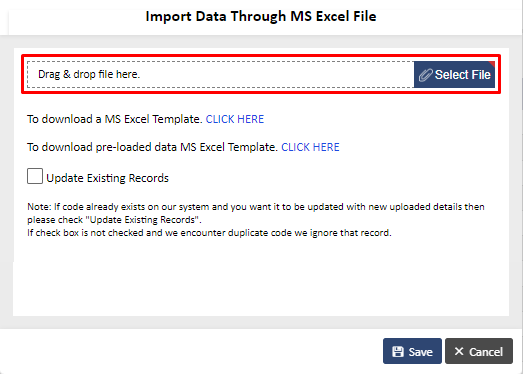
9. To download a blank MS excel template, the user can click on the 'Click Here' link. Here you can add the data in the blank excel and import it into the system.
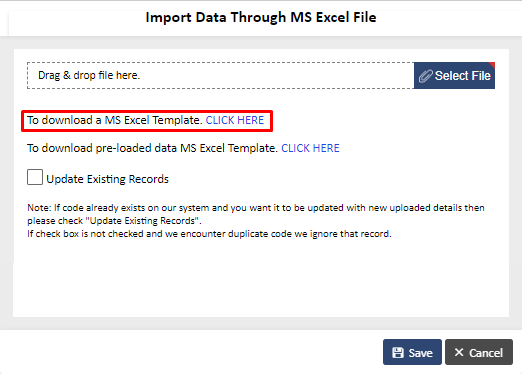
10. The user can click on the 'Click Here' link to download the pre-loaded data of the application in excel, make some changes and import the sheet.
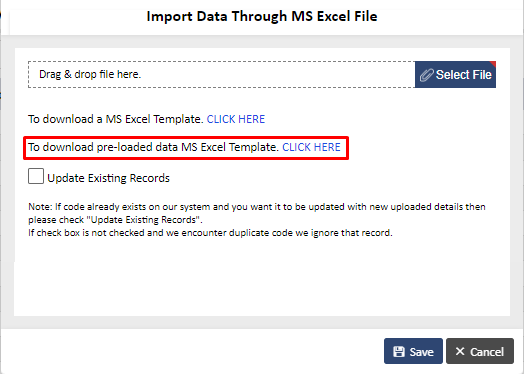
11. If the user wants to update any of the existing record(s), click on the 'Update Existing Records' checkbox while importing. Please note, that if this checkbox is not checked while updating existing records, the records will not be updated.
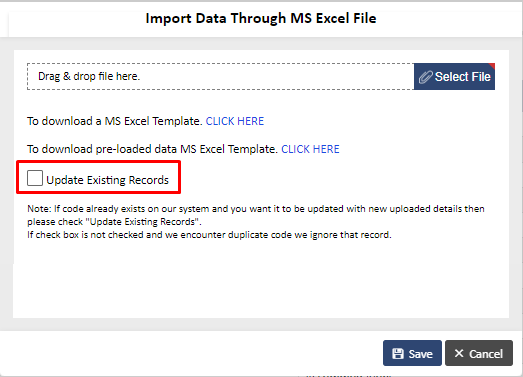
Note : Users can see the Excel Import option in all the Datafiles and Account codes.
REPORTS :
A report is an effective way to present the required data from the database based on certain criteria.
There are 4 reports under Quick Links I Reports as shown below:
a. Category Listing Report – This report lists all the categories as per the headers on the Category Code listing page.
b. Budget Analysis Breakdown – This report generates the budget, committed spend and percentage of budget as per category codes. The start and end date along with the monthly breakdown can be selected to generate this report.
Note : The committed spend will be calculated as per the Budget Status option checked by the System Administrator under Orders> Set Budget Status
c. Ordering Analysis (Pareto) – This report shows the category codes used with the number of orders they are used on and the percentage of these orders against all committed orders. It also shows the order value of those orders and its percentage share for the current financial year. This report can be further sorted by the start and end date, top codes by percentage or number and by order value or order line.
d. View Log Details – Similar to the Event Log, this will show all the details of changes done on the Category Code page. This is visible only if the System Administrator has given you access.
CURRENCY CODE :
This file maintains the exchange rate of the currencies. One of the currencies listed in the file is set as the default base currency. This enables you to raise orders with overseas suppliers in their local currency but still run your own reports and convert them all to the same base currency.
The default base currency is automatically set by the System Administrator and is used whenever you create a new purchase request. You can switch-off a particular currency for all users by deselecting the ACTIVE check box.
1. To add a new Currency Code, click on “Add New” on the Currency Listing page to see the below screen
Add details and click on “Save” to see the below screen:
2. To Edit, Delete, Search and/or Import/Export Currency Codes, please refer to same section in the Category Code File. The processes are similar across the system, so to avoid repetition we have explained it in the Category Code section.
Note : You cannot create the same Currency Code as the system’s base currency.
REPORTS :
The reports under Quick Links I Reports as shown below:
a. Currency Listing Report: This report lists all the currencies as per the headers on the Currency listing page.
b. View Log Details – Similar to the Event Log, this will show all the details of changes done on the Currency Code page. This is visible only if the System Administrator has given you access.
CUSTOMER :
A customer is a person that is outside your company for whom your company purchases items. This is an external requestor so to speak and uses our Customer Module to create requisitions. If you have purchased the Customer Module from us, you will see this option. The way this works is that a customer uses our Customer Module to create a request which is then sent into your company for further processing into an Order or RFQ.
To add a new customer, click on “Add New” on the Customer Listing Page to see the below screen: XXIV
Add the details and click on “Save” to finish the process.
Note: Apart from the details, you can add a Markup on this screen as a percentage. What this means is that when you send an invoice to the customer for items you have purchased for them, the system will automatically add this markup amount to the item price and bill the customer.
REPORTS :
There is one report under Quick Links I Reports as shown below: XXV
DELIVERY POINT :
The Delivery Point file maintains the location details of where a supplier should ship the ordered items. One of the delivery points is set as the default Delivery Point for the specified user. The default Delivery Point will be the delivery address for any new PO and it is automatically included whenever you create a new requisition. Each user on the system is assigned a default delivery point by the System Administrator. Users can change their own delivery point information if they wish.
You can enter the required delivery instructions at each Delivery Point, and the instructions are automatically included on a requisition, when you select a Delivery Point.
If there are many addresses to choose from, you can search for Delivery Points using the options in the available fields. If you have only a few, you can point and click to select it.
Add details and click on “Save” to see the below screen:
To Edit, Delete, Search and/or Export Delivery Point Codes, please refer to same section in the Category Code File. The processes are similar across the system, so to avoid repetition we have explained it in the Category Code section.
REPORTS :
The reports under Quick Links I Reports as shown below:

a. Delivery Point Listing Report –This report lists all the delivery points as per the headers on the Delivery Point listing page.
b. Ordering Analysis (Pareto) –This report shows the delivery pointcodes used with the number of orders they are used on and the percentage of these orders against all committed orders. It also shows the order value of those orders and its percentage share for the current financial year. This report can be further sorted by the start and end date, top codes by percentage or number and by order value or order line.
c. View Log Details – Similar to the Event Log, this will show all the details of changes done on the Delivery Point page. This is visible only if the System Administrator has given you access.
Document Type :
You can use the Document Types to produce a variety of order sets enabling you to distinguish between Purchase Orders and Service Orders or to classify different divisions of your company, and hence maximize the system’s cross-referencing capability. One of the document types may be set as the default Document Type by the System Administrator. The default Document Type is automatically included whenever you create a new purchase request. However, you can choose to either accept or override it.
1. To add a new Document Type, click on “Add New” on the Document Type page to see the below screen:
Add details and click on “Save”.
2. To Edit, Delete, Search and/or Import/Export Document Type Codes, please refer to same section in the Category Code File. The processes are similar across the system, so to avoid repetition we have explained it in the Category Code section.
REPORTS :
There are 3 reports under Quick Links I Reports as shown below:
a. Document Type Listing Report – This report lists all the document types as per the headers on the Document Type listing page.
b. Budget Analysis Breakdown – This report generates the budget, committed spend and percentage of budget as per the document type codes.The start and end date along with the monthly breakdown can be selected to generate this report.
Note : The committed spend will be calculated as per the Budget Status option checked by the System Administrator under Orders> Set Budget Status.
c. Ordering Analysis (Pareto) – This report shows the document type codes used with the number of orders they are used on and the percentage of these orders against all committed orders. It also shows the order value of those orders and its percentage share for the current financial year. This report can be further sorted by the start and end date, top codes by percentage or number and by order value or order line.
c. View Log Details – Similar to the Event Log, this will show all the details of changes done on the Document Type page. This is visible only if the System Administrator has given you access.
INVOICE POINT :
This maintains the details of the invoice location, so a supplier is advised where to send their invoices to. One of the locations may be set as the default Invoice Point by the System Administrator. The default Invoice Point is automatically included whenever you create a new purchase request. However, you can choose to either accept or override it.
You can have more than one invoice addresses relevant to your company. You can change these at the time of creating an order.
1. To add a new Invoice Point, click on “Add New” on the Invoice Point Listing page to see the below screen:
Add the details and click on “Save”.
2. To Edit, Delete, Search and/or Import/Export Invoice Point Codes, please refer to same section in the Category Code File. The processes are similar across the system, so to avoid repetition we have explained it in the Category Code section.
REPORTS :
There are 2 reports under Quick Links I Reports as shown below:
a. Invoice Point Listing Report – This report lists all the invoice points as per the headers on the Invoice Point listing page.
b. Ordering Analysis (Pareto) – This report shows the invoice point codes used with the number of orders they are used on and the percentage of these orders against all committed orders. It also shows the order value of those orders and its percentage share for the current financial year. This report can be further sorted by the start and end date, top codes by percentage or number and by order value or order line.
c. View Log Details – Similar to the Event Log, this will show all the details of changes done on the Invoice Point page. This is visible only if the System Administrator has given you access.
ITEMS :
The system has a comprehensive Items Database. This database can be thought of as a holding area for all the order line items you are likely to purchase from your suppliers. The items database holds item codes, descriptions, prices, recommended suppliers and is also linked to the Inventory system. The database is maintained by the buyers and the items can be added, edited and deleted. If you have the Supplier Portal Option then you can have your suppliers update their own items and update their inventory for you. Requisitioners have access to the items database in a Read-Only mode just to allow selection from the list. This also saves time and allows you to easily order repeated items. Once you have selected items from the list these items are placed upon the purchase order and do not affect the actual items database themselves. The items can then be further edited on the orders. You will see how this all works on requests and orders later in this manual.
You can assign multiple suppliers for each item each with their own pricing information. One supplier is designated the 'Main Supplier' whose details are used as default when ordering the item.
1. To add a new item, click on “Add New” on the Items Listing page to see the below screen:
Add details and select the item type. There are two types of items that can be selected – Consumable item and Service item. Consumable is any item that is not stored and generally is considered an expense from the accounting perspective. Examples could include cleaning supplies, food items, USB keys, etc. Service is any item that is measured in some denomination of time or fees. Examples could include hourly IT services, monthly landscaping service charges, delivery charges, custom fees, etc. You will also see the option to add Current Asset item if you have the Inventory module and the option to add a Fixed Asset Item if you have the Asset Register Module. These have been explained in their respective module help documents.
Once details are entered, click on “Save” to see the next screen:
The user can now add the supplier to the item by clicking on the ‘Supplier Details’ tab where the user can enter the highlighted fields as shown on screen ItemScreen-3.
After clicking on the selected supplier, the user will see 'Details' and 'Price History' tab as shown on screen ItemScreen-4 and ItemScreen-5.
In the 'Details' tab, the user can add more details about the supplier such as Suppliers Part Number,
Unit, Pack Size, Unit Price, Discount, Sales Tax, Lead Time, Tax Exempt, and Main supplier.
Note:Highlighted fields are seen only when Recipe module is switched on in the system
In the 'Price History' tab, the user can see the details of last price changed.
Also, the user can Add, Update and Delete images on the image tab.
You can also add a new Group Item by clicking on Group Items button on the Items Listing page as shown in Screen: XXXIII [A] to see Screen: XXXIII [B].

Click on the Add New button to see the popup to enter the new Group Item details as seen in below Screen: XXXIII [B]
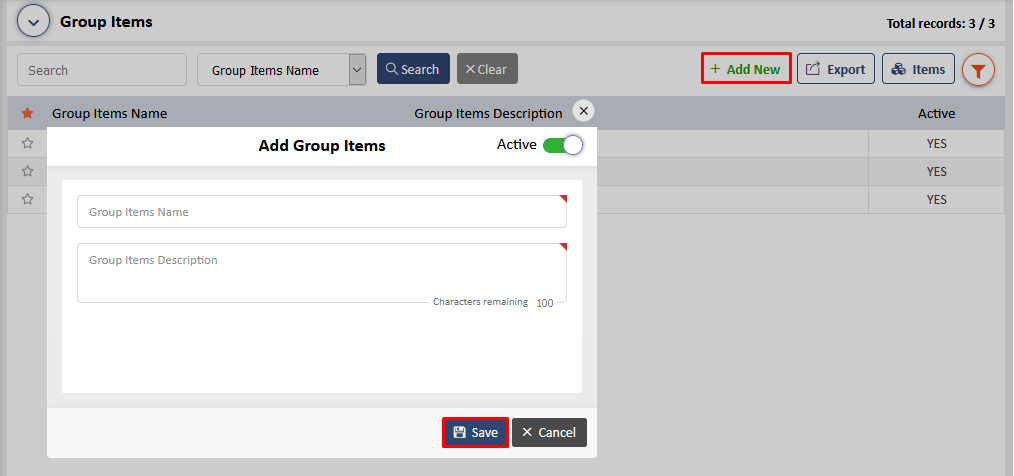
Add the details and click on Save to see the next Screen: XXXIII [C].
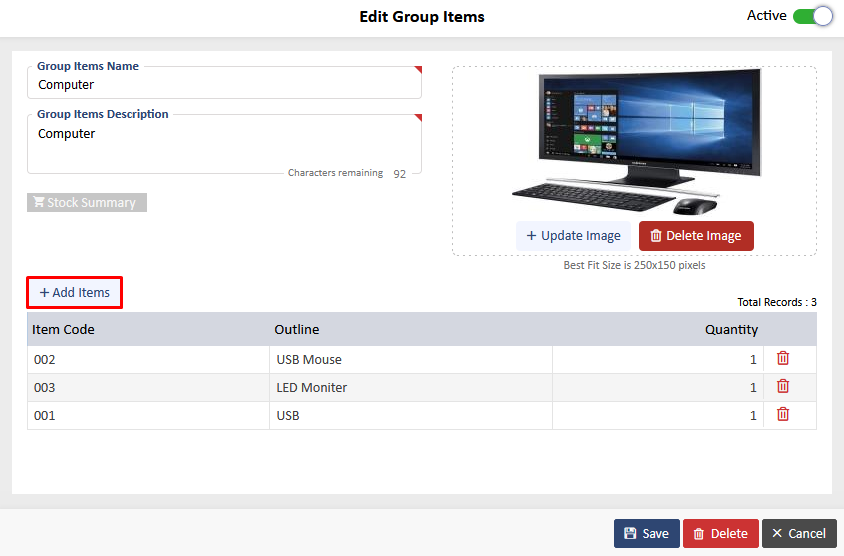
You can add Items and the image on the above screen. This Group Item when selected on a Request or Order will automatically add the Items within it. If you have the Inventory Module and the items selected are in stock, you will also be able to see the Stock Summery on the above screen.
The Group Items Listing page will show you a toggle to go back to the Items Listing page as shown below in Screen: XXXIII [D].

3. To Edit, Delete, Search and/or Import/Export Items, please refer to same section in the Category Code File. The processes are similar across the system, so to avoid repetition we have explained it in the Category Code section.
REPORTS :
There are 8 links/reports under Quick Links I Reports as shown below:
c. Items Listing Report – This report lists all the Items as per the headers on the Items Listing page.
d. Ordering Analysis (Pareto) – This report shows the items used with the number of orders they are used on and the percentage of these orders against all committed orders. It also shows the order value of those orders and its percentage share for the current financial year. This report can be further sorted by the start and end date, top codes by percentage or number and by order value or order line.
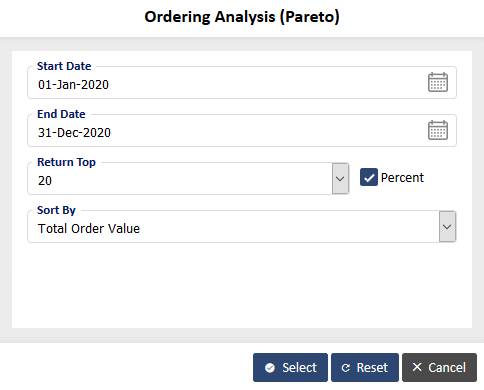
e. Total Items Ordered – This report shows the items ordered as per the start and end date selected by you.
f. View Log Details – Similar to the Event Log, this will show all the details of changes done on the Items page. This is visible only if the System Administrator has given you access.
g. Order Price History – Based on the start and end date selected, this report will show you the price updates made by suppliers against items.
h. Item Order History – Based on the start and end date entered, this report will show you the price of items with their supplier used on orders.
I. Items Label Report – This report will display items that have a designated supplier. The fields that will be shown in the report are the Company Name, Item code, Supplier Part Number, Supplier Name, Outline, Unit, Price with currency code and scanner for each item.
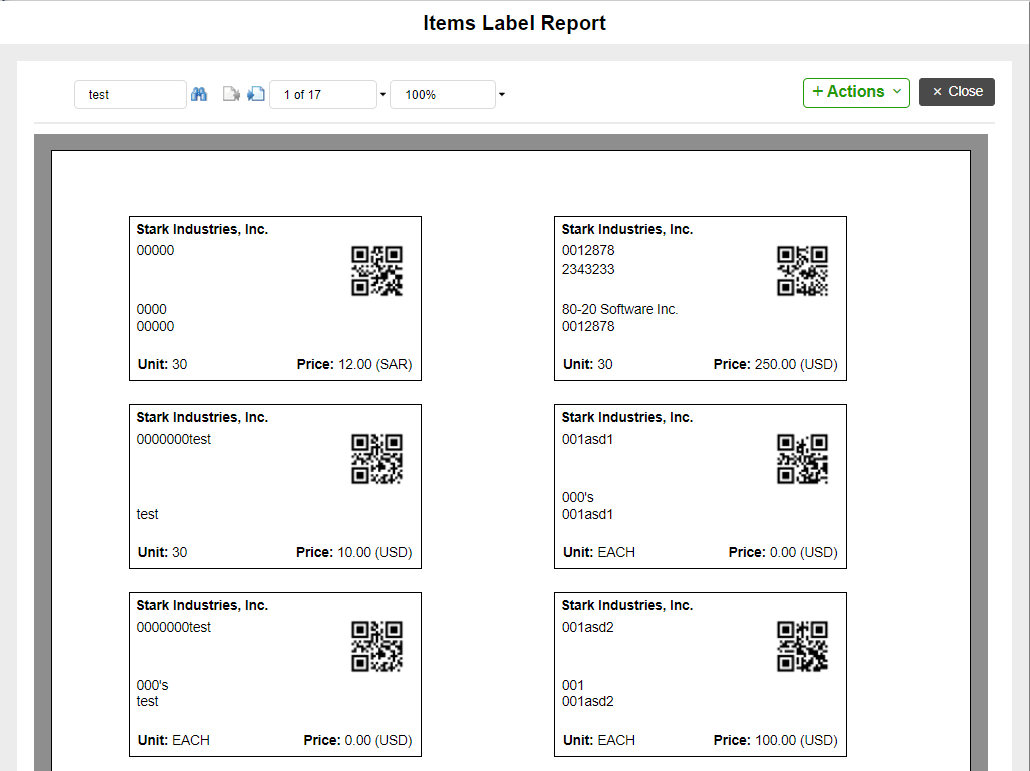
Note : Only those item(s) will be listed where Order status is ISSUED, PARTIAL, RECEIVED and CLOSED.
a. Group Items Report – This report will show you Group Items Name - Description, Item Code, Outline and Item Quantity.
f. View Log Details – Similar to the Event Log, this will show all the details of changes done on the Group Items Listing page. This is visible only if the System Administrator has given you access.
SUPPLIER :
The Supplier File stores the address, contact and financial reference details of the vendors with whom you place your orders.
1. To add a new supplier, click on “Add New” on the Supplier Listing page to see the below screen:
The Supplier Code will be unique to the system. Add the details and click on “Save” to see the next screen as shown below:
You can add all the details of the supplier on this screen. Notes and Supplier Diversity are some more options as shown in the highlighted tabs on the above screen.
If you wish to give this supplier access to the Supplier Portal, then check the box for Supplier Portal.
On the next tab, you can add The financial details of the supplier as shown in the Screen: XXXVI [C]
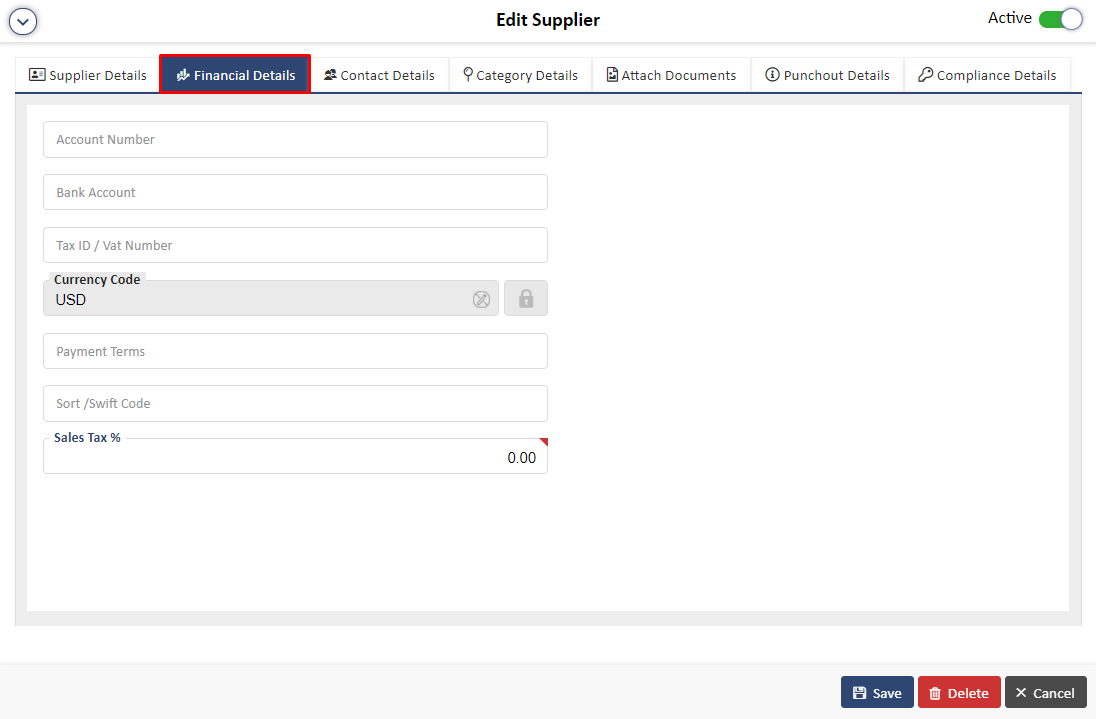
The next tab as shown in the Screen: XXXVI [D] will allow you add the contact details. You can add multiple contacts with one being the main contact for the supplier
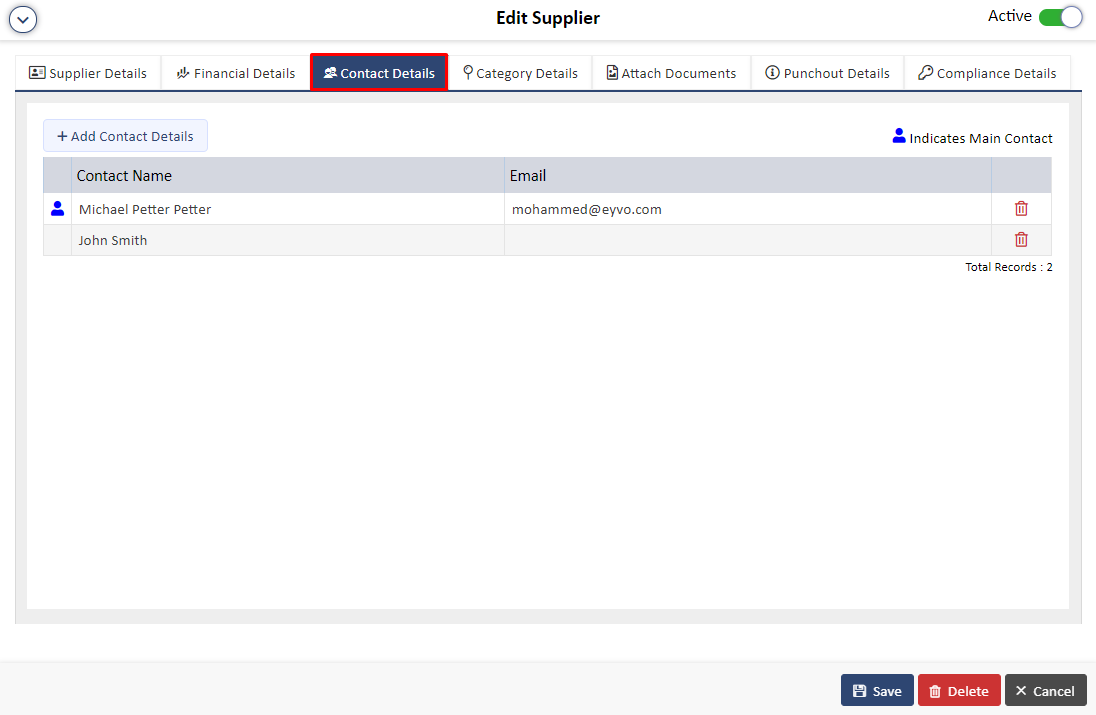
You can add the Category Details on the next tab as shown in the Screen: XXXVI [E]
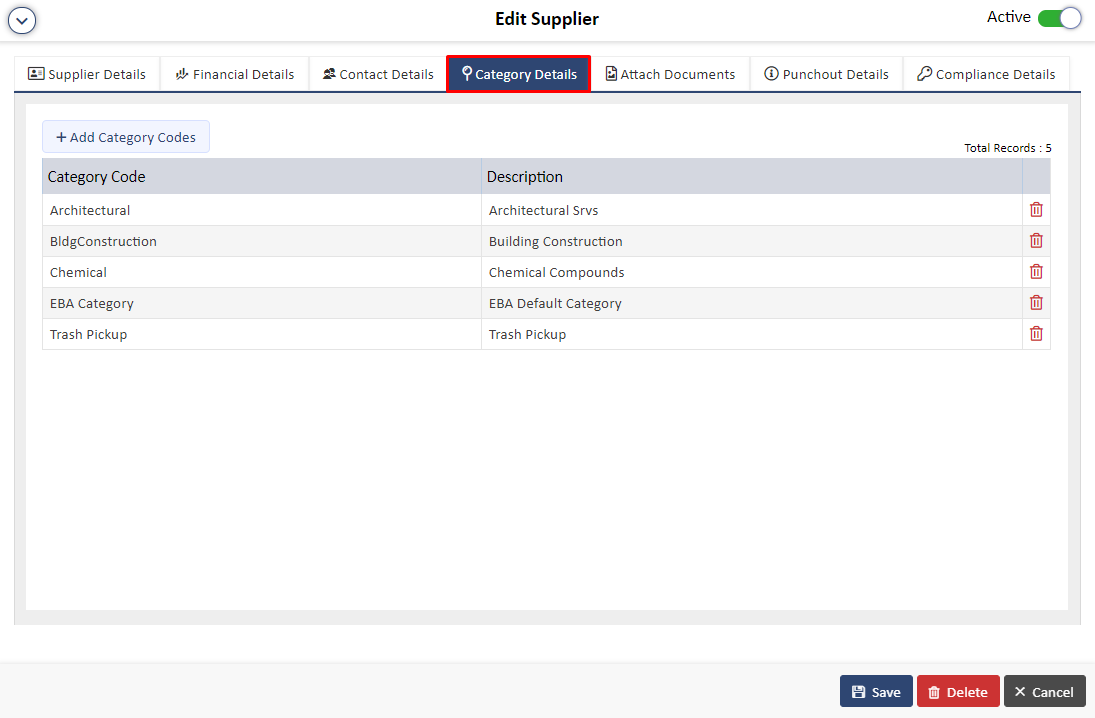
In the 'Attach Documents' tab, click on the 'Attach Documents' button to attach a new document as shown on the below Screen: XXXVI [F]. Add all the mandatory fields and click on 'Save' as shown in Screen: XXXVI [F-1].
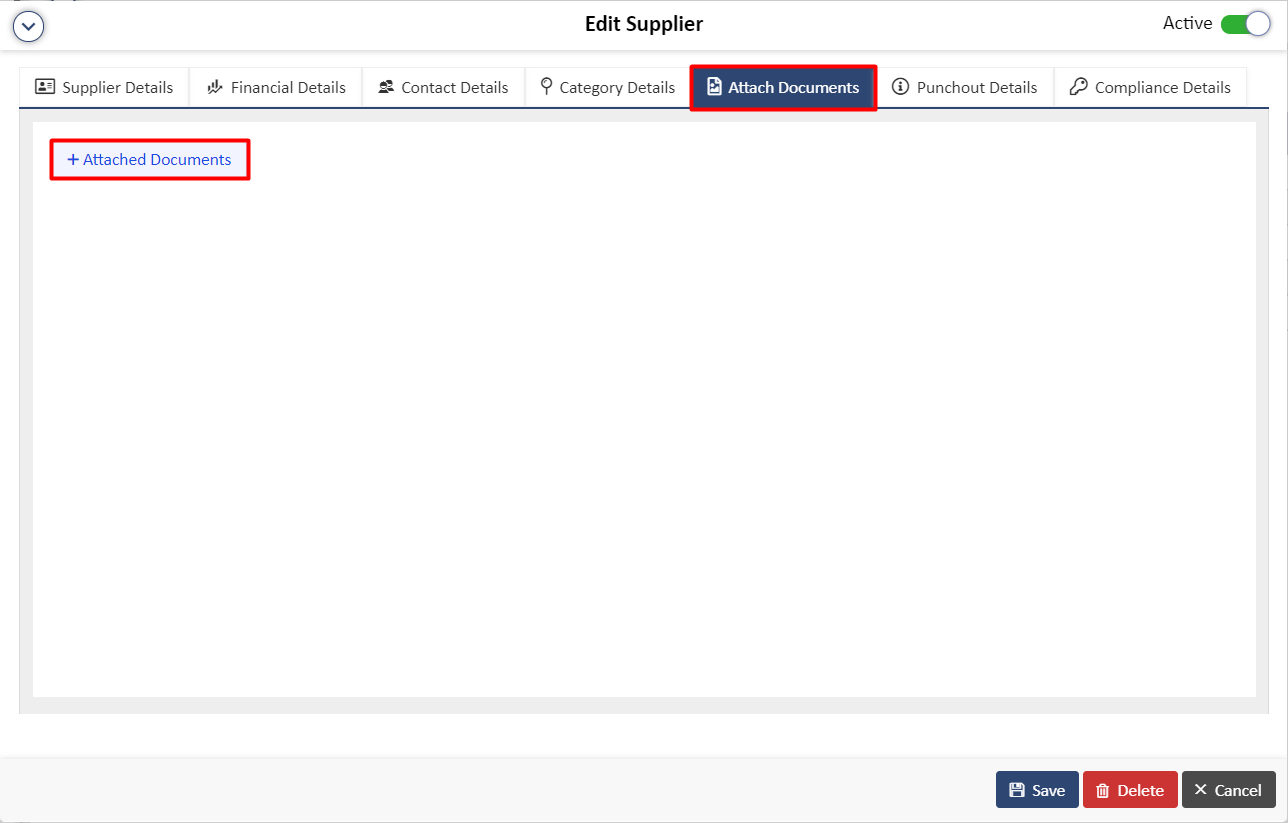
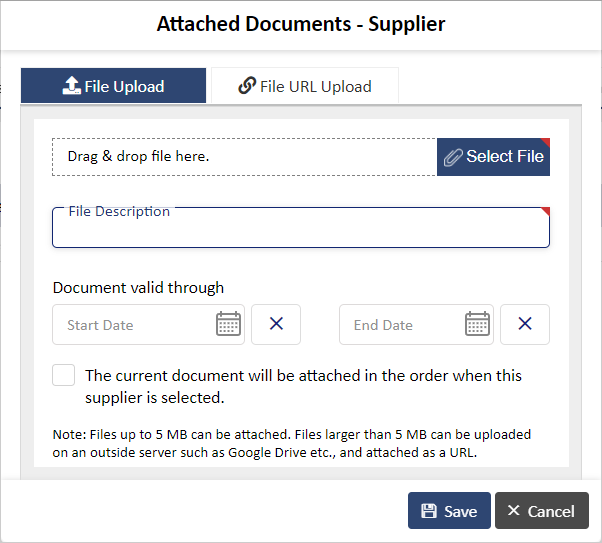
If you want to add validity for a supplier document, select the Start Date and End Date in the 'Attached Documents-Supplier' tab as shown on the below Screen: XXXVI [F-2]. Start Date & End Date are the date range for the supplier document expiry.
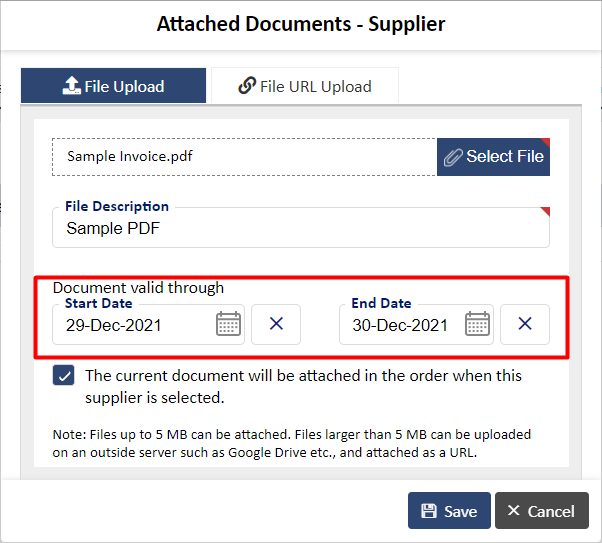
If the user selects the highlighted checkbox and uses this supplier in order, the attachment(s) will appear in the order's 'Attached Document' section as shown on the below Screen: XXXVI [F-3] & Screen: XXXVI [F-4]
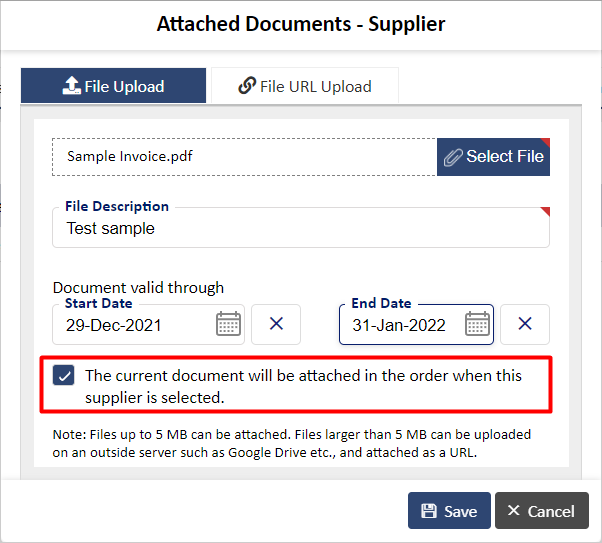
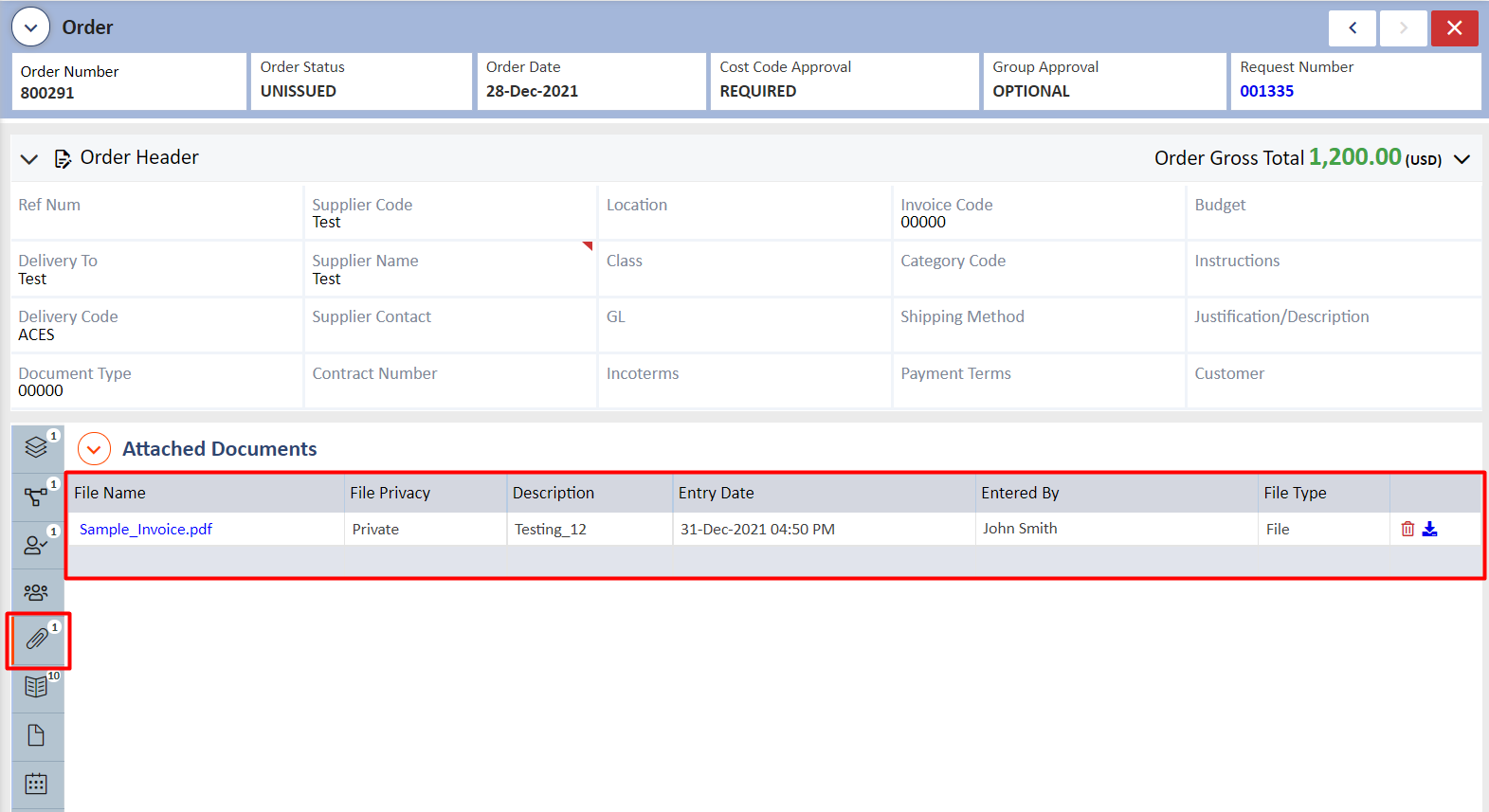
Note: If this checkbox is not selected, the attachment(s) for this supplier will not be loaded in the order.
The user can also edit the attached document in the supplier as shown on the below Screen:XXXVI [F-5] & Screen:XXXVI [F-6]
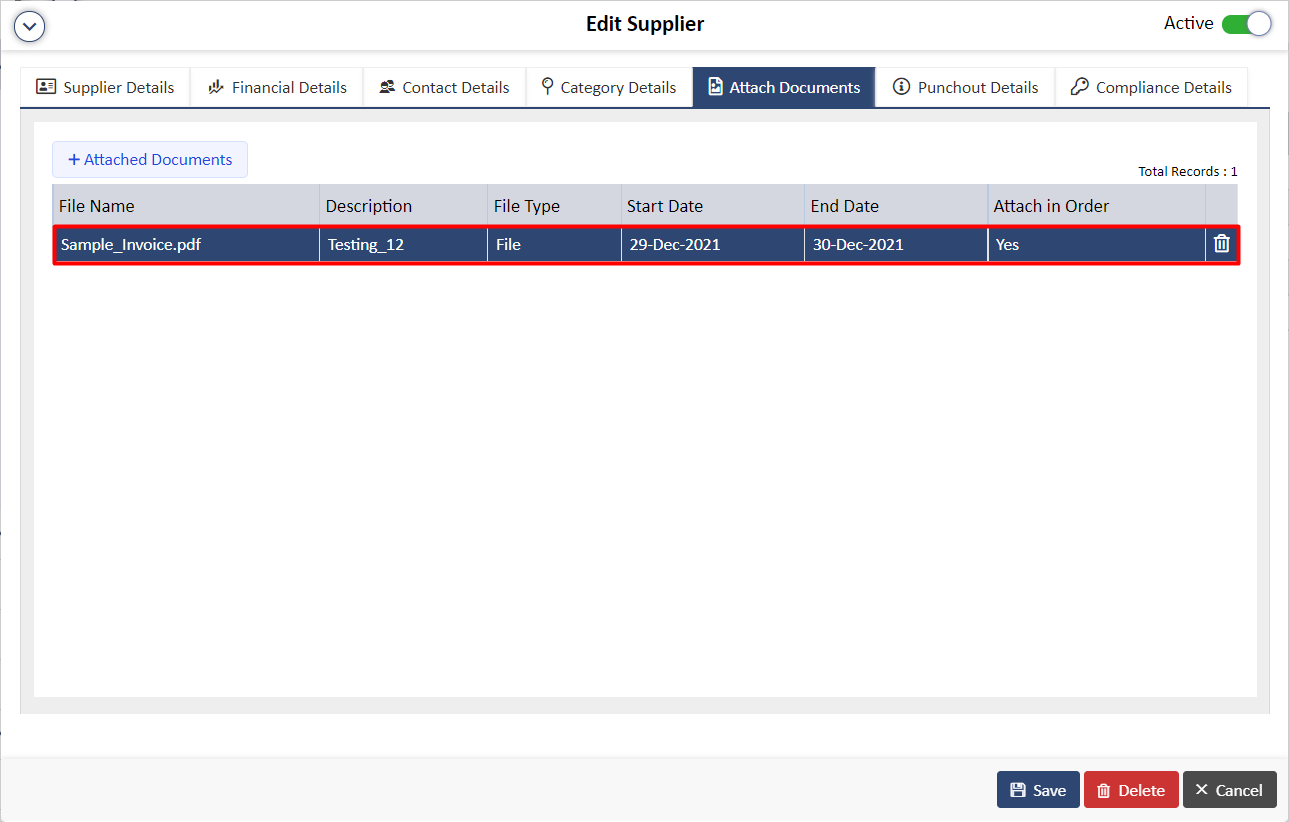
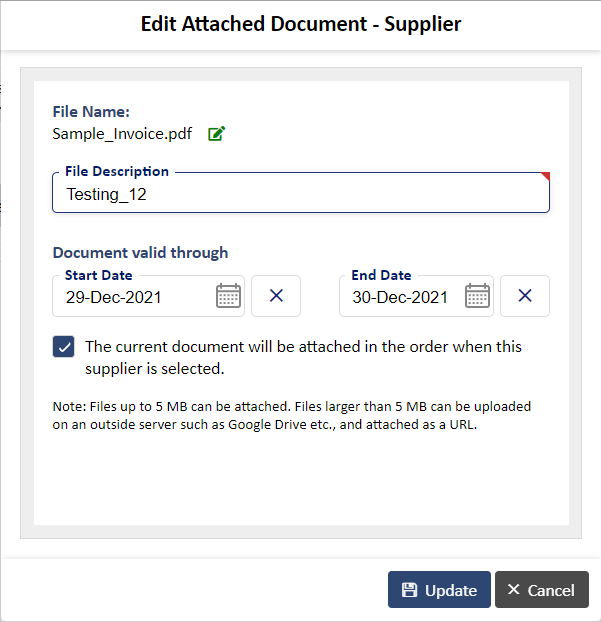
In the System Administration under the System Notifications-> Supplier Document Expiry section, the selected user will be notified about the document expiry according to the selected reminder day(s). An example of the reminder email is as shown on the below Screen: XXXVI [F-7]
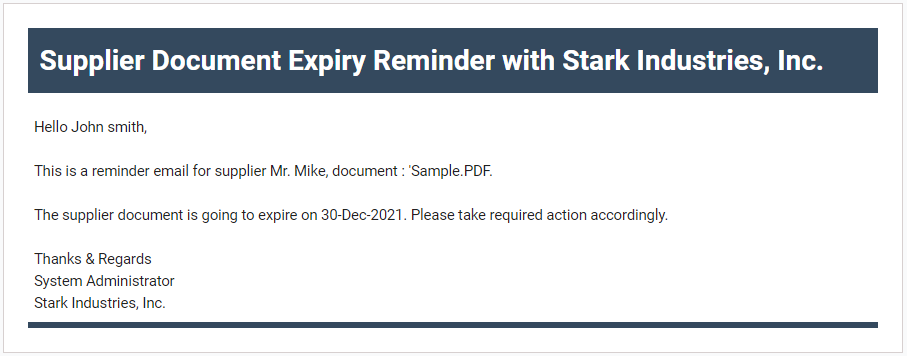
Switch ON the Punchout supplier if relevant on the next tab as shown in Screen: XXXVI [G]. Once enabled, you can add further details.
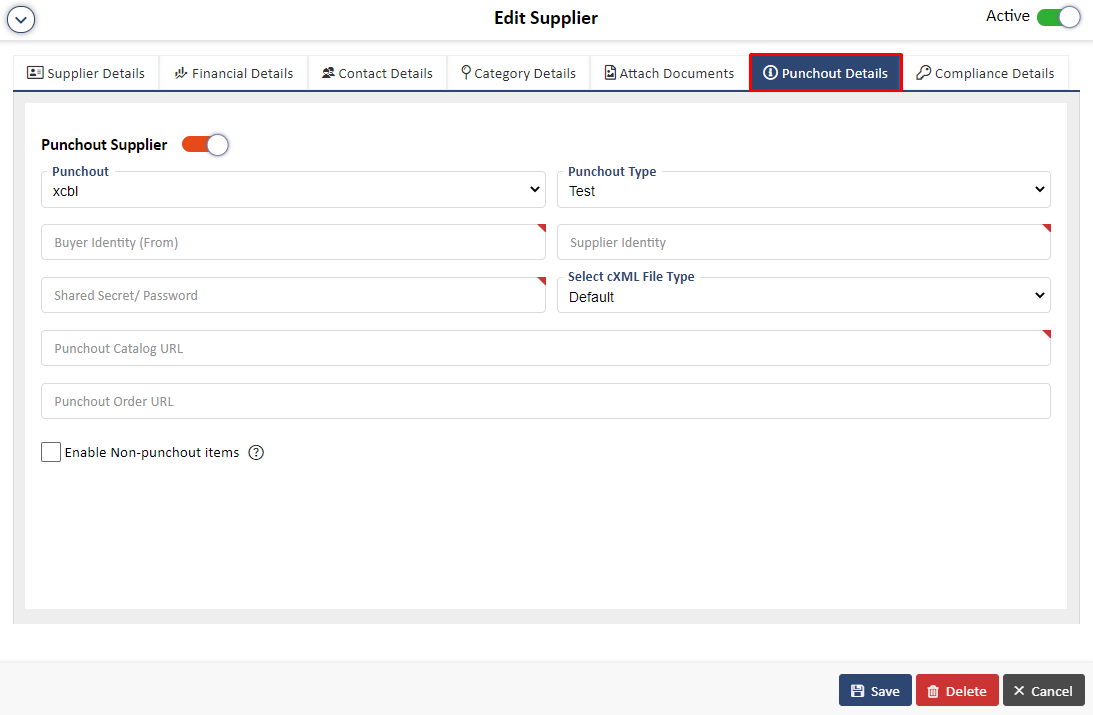
Check the box for Enable Non-punchout items. Checking this box will allow your users to select free format and your internal catalog items along with the suppliers punchout catalog items. Before selecting this option please check directly with your vendor that they do support non-punchout items on a punchout order.
An expample of a Punchout Supplier would be Amazon. What this means is if this supplier is selected on an order, the system will take you directly to Amazon's website. You will be able to select the items from their website. However, when you checkout, all the items selected will be brought back into the eBuyerAssist system. Please contact us at EYVO to complete the technical backend requirements for a Pnchout Supplier.
The Compliance Details tab as shown in Screen: XXXVI [H] will let you add all the informations related to the supplier's Organization, Risk And Compliance as shown in the three tabs under it.
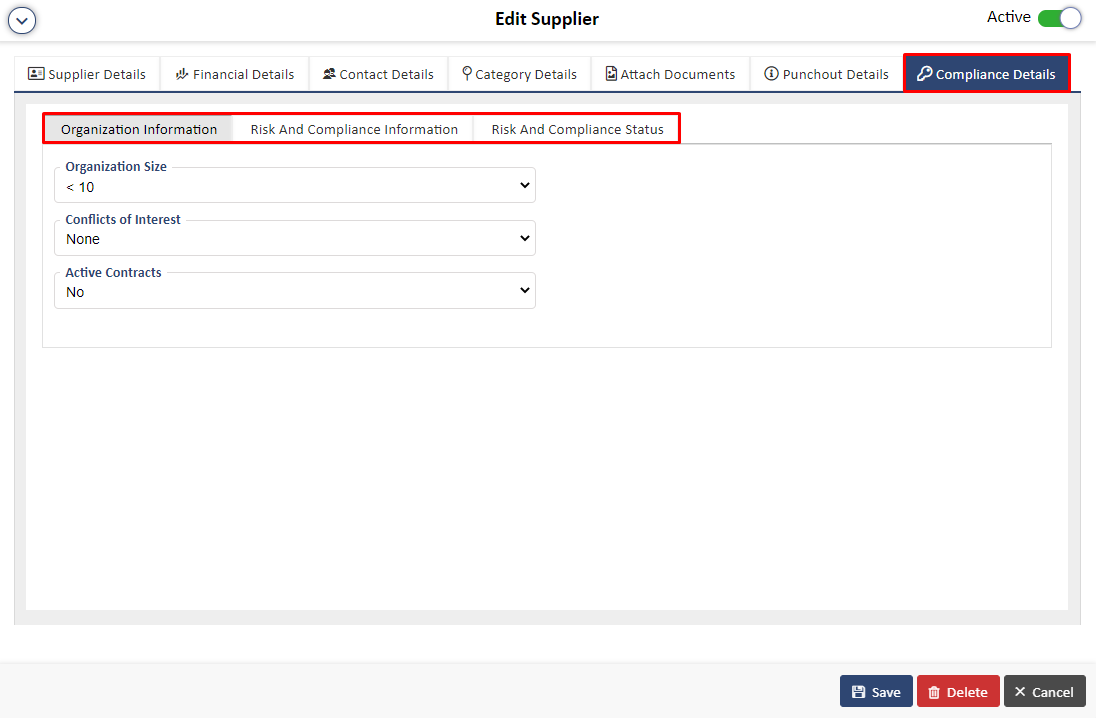
Once done, click on “Save” for this supplier to be a part of the supplier database.
Update Supplier Portal Password - This will let you change the password for this supplier to be used to login to the Supplier Portal. You can also choose to email the changes to the supplier. If the checkbox for Supplier Portal is unchecked, it means that this supplier has not been give access to the portal. In this case, the system will prompet you to enable access before you can change the password as shown in screen below:
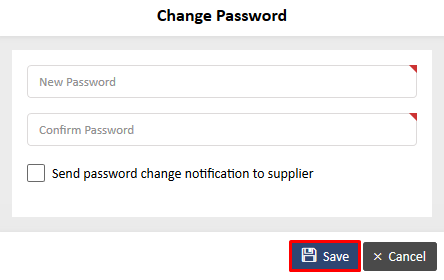
VRM Document Approval - This will show you all the documents sent by the supplier with their approval status. The documents that you see here would be the ones that the supplier has uploaded via the Supplier Portal. You can also add new documents on behalf of the supplier and send them for approval as shown in screen below:
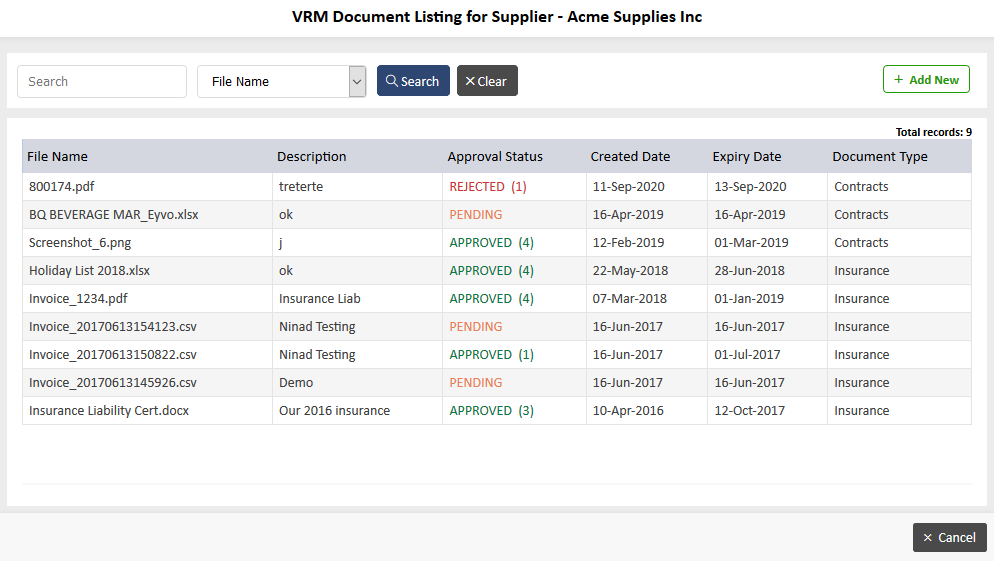
Send Supplier Credentials - Click on this if you wish to email the supplier their credentials.
The supplier needs to be given access to the Supplier Portal along with credentials to log in. To do so, you as a buyer need to go to Data Files> Supplier and edit the particular supplier’s details as shown in Screen: XXXVI [N]:

Note: You need to have the permission to read and write data files to do the above.
The next step would be to update the password for the supplier under Menu> Update Password as shown in Screen XXXVI [O] and Screen XXXVI [P]:
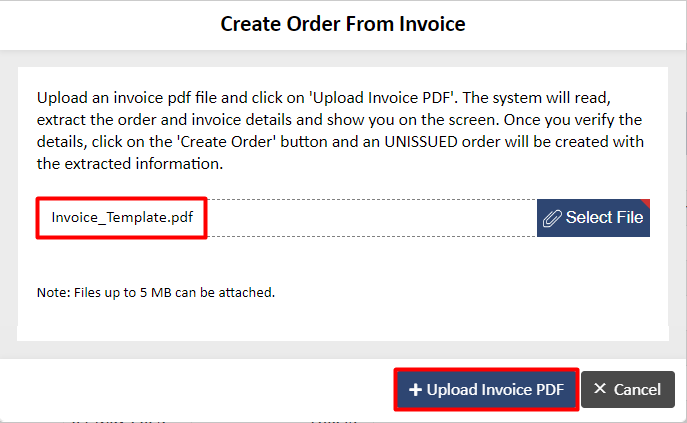
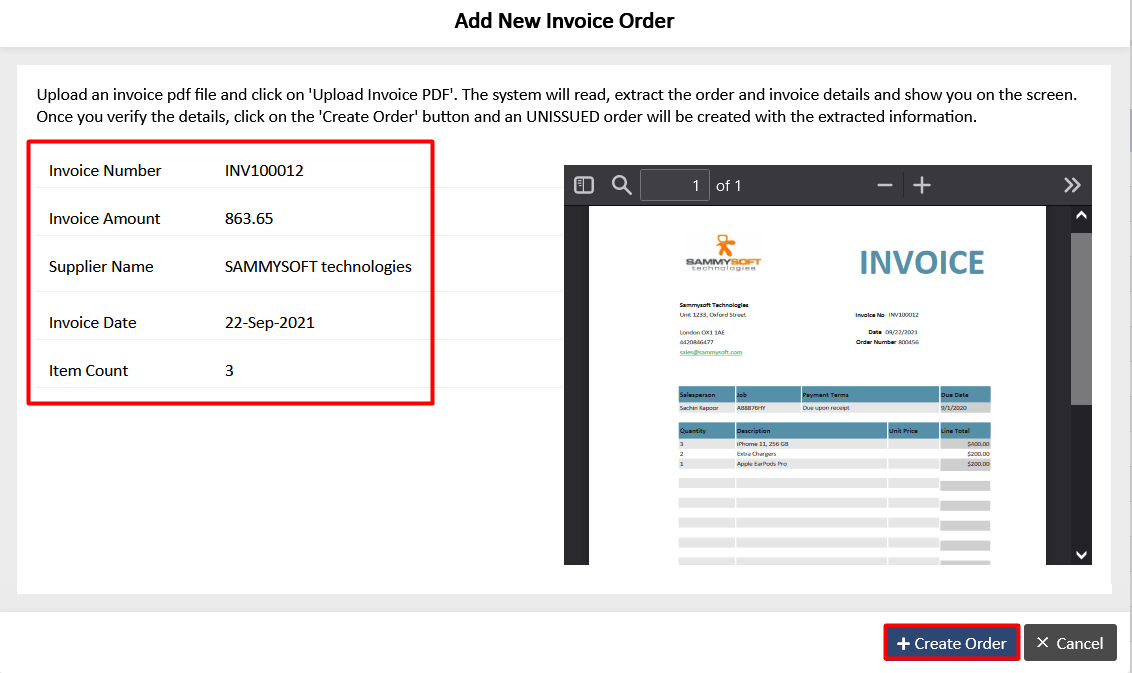
Next, you need to check the box for “Supplier Portal User” as shown in Screen XXXVI [Q].

This will trigger an email to the supplier with the login credentials and URL as shown in Screen XXXVI [R] and Screen XXXVI [S].

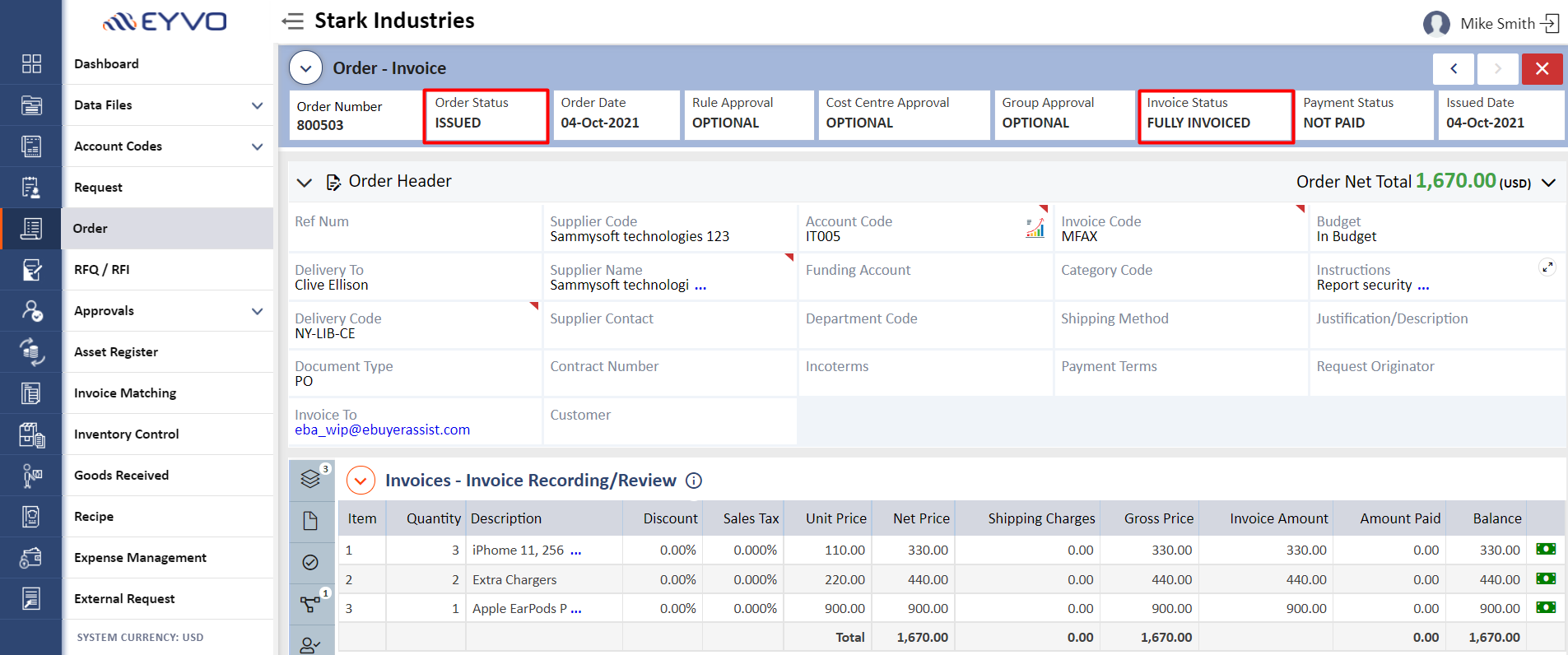
The supplier can now use the above received credentials to log into the Supplier Portal.
2. To Edit, Delete, Search and/or Import/Export Supplier details, please refer to same section in the Category Code File. The processes are similar across the system, so to avoid repetition we have explained it in the Category Code section.
REPORTS :
There are 11 links|reports under Quick Links I Reports as shown below:
- Supplier – Item Price Export – This will allow you to export the supplier data in an excel sheet to work upon. Click on the Export button to access the data.
- Supplier – Item Price Import – Attach an excel sheet here to import the supplier price into the Items database. Select the file and click on “Save”.
- Supplier Listing Report – This report lists all the suppliers as per the headers on the Supplier Listing page.
- Supplier Order Listing – This report shows the order numbers that suppliers have received.
- Supplier Detailed Listing – This report shows a lot more details about suppliers such as whether it is a small firm, ISO rated,
category codes assigned, category description and budget, etc. - Supplier Diversity – This report shows the supplier diversity spend rate and spend percentage as per the start and end date entered.
- Supplier Risk Score – This report shows the risk score of suppliers and can be filtered as per suppliers. This is visible only if you have the Vendor Risk Management function activated on your company’s system.
- Ordering Analysis (Pareto) - This report shows the supplier codes used with the number of orders they are used on and the percentage of these orders against all committed orders. It also shows the order value of those orders and its percentage share for the current financial year. This report can be further sorted by the start and end date, top codes by percentage or number and by order value or order line.
- View Log Details – Similar to the Event Log, this will show all the details of changes done on the Supplier page. This is visible only if the System Administrator has given you access.
- Supplier Price History – Based on the start and end date selected, this report will show you the price updates made by suppliers against items.
SUPPLIER CONTRACTS FILE :
The system maintains supplier contracts that are related to the actual order system such that when a purchase order is raised, you can add these files from the database.
1. To add a new supplier contract file, click on “Add New” on the Supplier Contracts Listing page to see the below screen:
Add the details and click on “Save” to see the next screen:
You can assign a Contract Manager and check the box for the manager to receive status updates. Contract documents can be added here as well. Add all the details and click on “Save” for it to be added to the supplier contracts database.
2. To Edit, Delete, Search and/or Import/Export Supplier Contracts files, please refer to same section in the Category Code File. The processes are similar across the system, so to avoid repetition we have explained it in the Category Code section.
REPORTS :
There are 3 reports under Quick Links I Reports as shown below:
a. Supplier Contract Listing – This report shows all the supplier contracts as per the headers on the Supplier Contracts Listing page.
b. Supplier Contract Due Listing – This report shows the end date of the contracts as per the number of days selected.
c. View Log Details – Similar to the Event Log, this will show all the details of changes done on the Supplier Contract page. This is visible only if the System Administrator has given you access.
TERMS & CONDITIONS :
The Terms & Conditions offer the option to include advisory details along with each Request, Purchase Order, or Request for Quotation. Each entry allows for a comprehensive description or attach file, which may contain your business's terms and conditions.
1. There are two methods available for adding new terms and conditions as shown in Screen: 1.
2. In this example, we demonstrate how to add new terms and conditions in the 'Text' tab. It is essential for the user to provide input for all the required fields. Furthermore, when adding these new terms and conditions, users can choose to enable the Order Default, Request Default, and RFQ Default checkboxes. By selecting these checkboxes, the recently added terms and conditions will be automatically attached to any new request, order, or RFQ generated. After making the necessary modifications, click on the 'Save' button to save the terms and conditions in the system as shown in Screen: 2.
For demonstration purposes, we have chosen to select the checkboxes for Order Default, Request Default, and RFQ Default. Users can choose their desired defaults according to their requirements.
Note: If the multi-company module is enabled for the user, they will have access to the Document Type option. When adding new terms and conditions, the user can choose to select the checkbox for Document Type. Once a Document Type is selected in the terms and conditions, it will be loaded in the Request, Order, and RFQ when that specific Document Type is chosen. This allows for the selected terms and conditions to be automatically applied to the corresponding Request, Order, and RFQ.
3. This example demonstrates the process of adding new terms and conditions in the 'File' tab. When creating the terms and conditions, it is important for the user to provide the required fields, including code, outline, and an attached pdf file. Additionally, users have the option to select the Order Default, Request Default, and RFQ Default checkboxes while adding new terms and conditions. By choosing these checkboxes, the attached pdf file in the terms and conditions will be automatically linked to any new request, order, or RFQ that is generated. Once all the necessary modifications have been made, simply click on the 'Save' button to store the terms and conditions in the system as illustrated in Screen: 3.
4. Once the terms and conditions are saved in the system, they will be visible on the Terms & Conditions Listing page, as shown in Screen: 4.
5. After saving the terms and conditions, the user is provided with the flexibility to switch between the 'Text' and 'File' formats. For instance, if the user initially attached a file to the terms and conditions in the 'File' section and now wishes to convert it into the 'Text' format, they can do so by adding a Body field in the 'Text' tab and saving the changes. This action will convert the terms and conditions into a 'Text' format, while the previously attached file in the 'File' tab will be removed as shown in Screen: 5 and Screen: 5.1.
6. When a new request is created, the default terms and conditions will be automatically loaded into the request. Terms and conditions that include a PDF file will be displayed with an icon. By clicking on the download icon, users have the option to either view or download the PDF file. Moreover, both the attached file and the textual terms and conditions will have a delete icon, as illustrated below in Screen: 6.
Note. To include additional terms and conditions beyond the default ones, the user can click on 'Select Terms & Conditions' from the menu as shown below.
7. The Request Document report provides visibility to the terms and conditions containing textual content as shown in Screen: 7 and Screen: 7.1.
8. Upon converting a request into an RFQ (Request for Quotation), the default terms and conditions will be automatically loaded into the RFQ, as illustrated below in Screen: 8.
9. The Request for Quotation / Proposal Document report provides visibility to the terms and conditions containing textual content as shown in Screen: 9.
10. Similar to the request, upon the creation of a new order, the default terms and conditions will be automatically loaded into the order, as shown below in Screen: 10.
11. When the user clicks on the 'Preview/Issue Order' button, they will be able to view the terms and conditions within the PO report, which includes textual content as shown in Screen: 11.
12. The user has the option to select 'Issue & Email PO' to send the purchase order (PO) to the supplier. When this option is chosen, the attached file containing the terms and conditions will be displayed as an attachment, as illustrated below in Screen: 12. Once the email has been sent to the supplier, the attached file with the terms and conditions will be included as an attachment.
13. For editing, deleting, searching, and importing/exporting the Terms & Conditions files, please refer to the corresponding section in the Category Code File. The procedures remain consistent throughout the system, and to avoid repetition, we have provided a detailed explanation in the Category Code section.
REPORTS :
There is one report under Quick Links I Reports as shown below:
a. Terms & Conditions Listing Report – This report shows all the terms and conditions file as per the headers on the Terms & Conditions Listing page.
b. View Log Details – Similar to the Event Log, this will show all the details of changes done on the Terms and Condition page. This is visible only if the System Administrator has given you access.
ACCOUNT FILES :
This section explains how the account coding of the system works with financial cost codes, budgets, projects codes etc. and to run financial analysis and cost control reports.
The Account Codes are used in requisitions and orders to perform the financial costing and financial tracking of all expenses. There are six account codes available to the user.
These can be set by the System Administrator under Environment Settings> Expenditure Code Names as shown below:
The first three codes (you can rename the files as per your business requirements) are related to the requisition header or order header and so any codes entered into these tables or databases are applied to the order as a whole. The last three are related to the order line or the requisition line.
The main difference between Data files and Account Codes is the reporting structure. Data files contain more financial information in the report. Account Codes displays the financial commitments categorized by the code.
You will be able to see these under Account Codes on the left menu as shown below:
The third one shown on the above list, Cost Centre is a special code and is used to split the cost across different cost centres. Its main purpose is to get financial approval from the cost centre holders.
1. To add a new Account Code, click on “Add New” on a particular Account Code Listing page to see the below screen:
Add the details and click on “Save” to see the next screen:
You can add the details with the budget and further allocate a budget monthly by clicking on the monthly budget icon as highlighted on the screen above to see the below screen:
2. To Edit an Account Code, click on the “Edit” icon as shown below:
Make the necessary changes and click on “Save”
3. To Delete an Account Code, click on that particular code and click on the “Delete” button as shown on the screen below:
4. To Search an Account Code, enter the details on the search field and choose the relevant search criteria from the dropdown on the Account Code Listing page as shown below and click on “Search” button.
5. To do an advance search, click on the Advance Search icon as shown on the below screen:
This will give you options to search as per the fields that you choose as shown on the below screen:
You can select various fields using the icons in the middle and search as shown below:
6. You can import an Excel file into the application. To do so, click on the “Excel Import” button on the Account Code Listing page to see the below screen:
Choose an existing file or download a template or download a pre-loaded template to work on and then import this back into the system. You can also choose to update the existing records.
7. You can also Export Data in Text, XML and CSV formats. To do so, click on the “Export Data” button on the Account Code Listing Page to see the below screen:
REPORTS :
There are 4 reports under Quick Links I Reports as shown below:
a. Account Code Listing Report – This report shows all the categories as per the headers on the Account Code Listing page.
b. Budget Analysis Breakdown Report – This reports shows the account codes with their budgets, committed spend and percentage of budget. This can be generated as per the start and end date and can show as a monthly report.
c. Ordering Analysis (Pareto) – This report shows the account codes used with the number of orders they are used on and the percentage of these orders against all committed orders. It also shows the order value of those orders and its percentage share for the current financial year. This report can be further sorted by the start and end date, top codes by percentage or number and by order value or order line.
d. Budget Analysis Detail – Based on the start and end date, this report will show the budget with its description, the orders its used on, the supplier and buyer name as well as the committed spend.
All the other Account Codes will work the same way as mentioned above. They will each have 3 reports as well with their individual details.
REQUESTS AND ORDERS
REQUESTS
Users with the user type “Requestor” can create requests whereas users with the user type “Buyer” or “Senior Buyer” can create requests and orders both.
Buyers can only see their orders whereas a Senior Buyer can see all orders in the system.
Below are the statuses of Request:
DORMANT – A request when created shows a Dormant Status.
UNAPPROVED – When a request is sent to Request Approval for approval.
APPROVED – A request when approved by request approver shows an Approved status.
PENDING – When a request it is sent to the purchase manager to assigning a buyer or for buyers to take ownership of the request
REJECTED – A request when rejected by a request approver shows the Rejected Status.
ASSIGNED – After a buyer is assigned to the request, or ownership taken by the buyer, the status changes to Assigned.
ORDER – A request when converted to order will show the Order Status.
RFQ – A request when converted to an RFQ will show the RFQ Status.
IREQUEST – A request that has the items taken out of inventory will show the IRequest Status.
CANCELLED – A request when cancelled shows the Cancelled status.
The below process is considering the user is a Senior Buyer.
This section helps you understand the process flow for creating a new request, approving it, and then creating an order corresponding to the request
- 1. You will see the Requests tab on the left menu bar. To add a new request, click on “Add New” on the Request Listing page to see the below Screen RequestItem-1.
You will see that some of the header fields such as document type, category code, etc. are pre-filled. These values are the ones that are set by the System Administrator as default values for this user under User Register. If there are no values here then the system will pick up the defaults set under Environment Settings > Default Values.
The Request Status would be Dormant at this stage.
-
2. You can change the header field details at this stage by clicking anywhere on the header fields to see the below screen RequestItem-2
Enter details as per the request and click on “Save”.
- 3. You can also look at the expense and run rate charts of the account, project and budget codes by clicking on the corresponding chart icon on the header fields as shown on the screen RequestItem-3
- 4. To add an item that is already saved in the Data Files-->Items section, click on “Add Catalog Item” as highlighted on the screen RequestItem-6
Note- For demonstration purposes, we are showing the process in Request. The user can also add catalog items in Order.
5. The user can now view the catalog where all the items will be listed according to their selected category. Also, as we have added the supplier to the item, the user can also view the supplier details as well as shown on screen RequestItem-7.
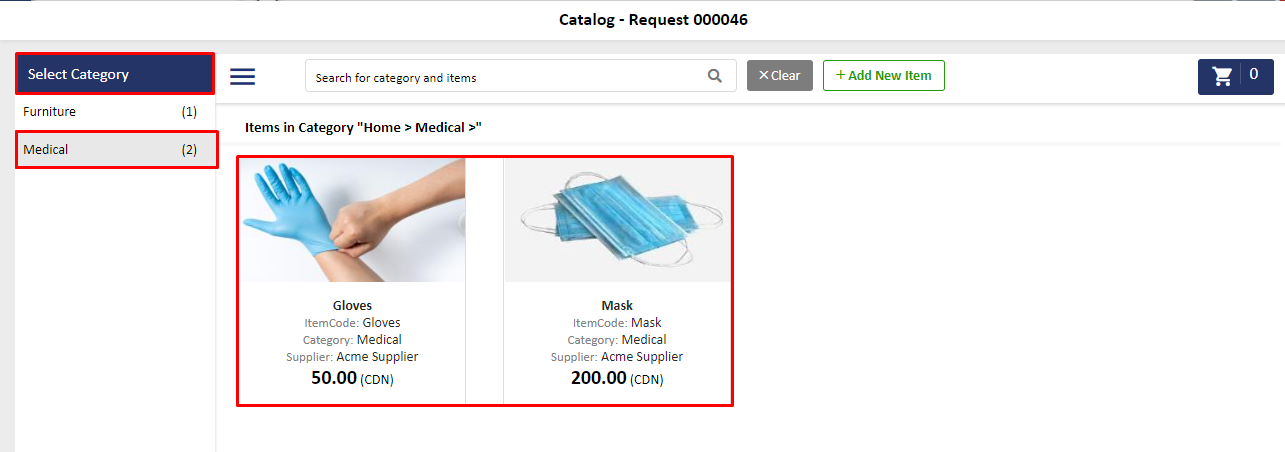
The user can also add a new item from the catalog page which will also be seen in the Data Files->Items section as highlighted on the screen RequestItem-7.1
6. If the user wants to search the item ‘Gloves’ into the request from the catalog, the user can directly click on the ‘Medical’ category to add the selected item. Alternatively, the user can also search for the item by entering either its item code, item outline, or item description as shown on screen RequestItem-8.
The item can also be searched by entering its category code as shown on screen RequestItem-9.
7. When the user hovers over the item, the user can view two buttons i.e. ‘Add to Cart’ and ‘View Item Details’.
a) If the user wants to view an item’s supplier details, click on the ‘View Item Details’ as shown on screen RequestItem-10.
b) If the selected item has more than one supplier, by default the user can view the main supplier details as shown on screen RequestItem-11.
c) Also, the user can select another supplier for the item by clicking on the 'Supplier Name' dropdown and click on ‘Add To Cart’ as shown on screen RequestItem-11.1
d) If the selected item has no supplier, all the fields related to the supplier will be seen blank as shown on screen RequestItem-11.2
e) If the user wants to add an item directly to the Shopping Cart, click on the ‘Add to Cart’ button as shown on screen RequestItem-12.
f) Once the user clicks on the ‘Add to Cart’ button, the item will be seen in the Shopping Cart as shown on screen RequestItem-13.
8. Click on the Shopping Cart icon to view all the selected items. Here, the user can view the item price, quantity, and net total for all the items as shown on screen RequestItem-14. Also, the user can edit the quantity of the selected items before clicking on the 'Submit' button. Please note, that if the supplier is not added to the item, the price will be seen as 0.
9. If the user wants to delete one of the selected item(s) from the shopping cart, click on the ‘delete item’ icon. To clear all the items from the shopping cart, click on the ‘clear’ icon as highlighted on screen RequestItem-15
10. Once the user has verified all the item details, they should click on the ‘Submit’ button. The user can now view the items has been added to the request from the shopping cart as shown on screen RequestItem-16.
11. You can add further details to the item such as quantity, price, etc. in the below screen:
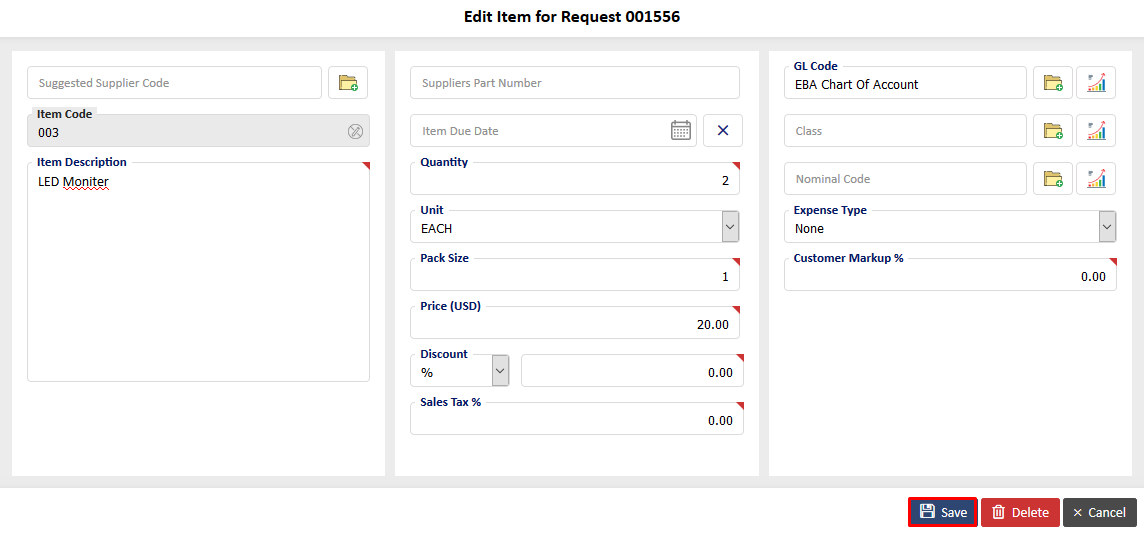
Mandatory fields need to be filled in with details to proceed. We also have a field to enter the Expense Type and this includes OPEX and CAPEX. Operating expenses (OPEX) are incurred during regular business, such as general and administrative expenses, research and development, and the cost of goods sold. A capital expenditure (CAPEX) is incurred when a business uses collateral or takes on debt to buy a new asset or add value of an existing asset. Capital expenses include the purchase of fixed assets, such as new buildings or business equipment, upgrades to existing facilities, and the acquisition of intangible assets, such as patents. We use this as an information field only. Please fill in the details accordingly.
Note: The price entered on this screen can be an estimated price. The purpose of the estimation information is to help with the approvals flow. When a user requests some goods or services we assume that they know the approximate value of the goods or services they are requesting. The approximate value should be the input here. The value does not need to be accurate and can be modified later. If the value is simply unknown then the user should put a value of 1 here.
You can add more items in the same way.
12. In the event that you wish to add items that are not a part of the items database, click on “Add New” as shown on the below screen:
13. The below screen will show when you click on “Add New”:
Add all the details and click on “Save” for it to show as a line item on the request as seen below:
15. The system will ask you to select a punchout supplier from the supplier database when you click on the “Add Punchout Items” button. When you click on the supplier, the system will direct you to that supplier’s website. Choose the items and checkout from that site.items The selected will then show as line items on the request.
16[A]. You can use the “Re-Index” and “Delete All” buttons as required. The “Update All” button can be used to mass update the codes and select due date for the items as shown below:
16[B]. You have one more option which is to select a Group Item. To do so, click on the button as shown below in Screen: XXXXXXX[B].

The Group Item that you add will include all the Items within it as well. To know more about creating Group Items please click here.
Note: You can add these various types of item on a Quick Order in the same way as shown in the above steps.
17. You can see details about the items on the right side of the line item highlighted as shown below:
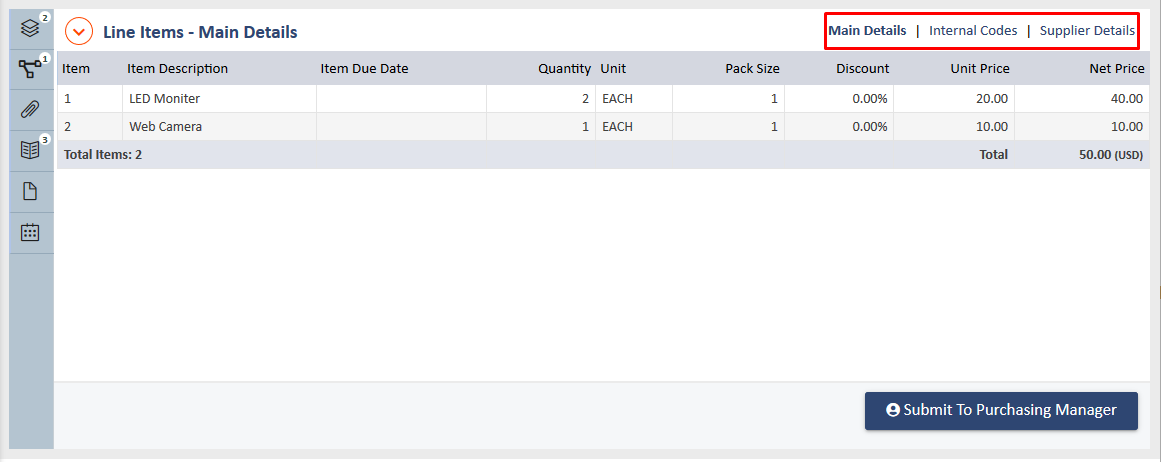
Main Details - These are the details as you see on the line item.
Internal Codes - This will show you the Item Code, Description and the three Expenditure Codes on the line item.
Supplier Details - This will show you the Item Description, with the Supplier's Code, Supplier's Name, Supplier's Part No, Supplier's Address and Contact Name.
18. The next step would be to select the relevant cost centre. This can be done under “Cost Centre Split” on the left menu of the request as shown below:
You will see that a default cost code is populated. This value was set by the System Administrator under Environment Settings> Default Values.
To account for the expenses that will be incurred, you can delete the default cost code and select the relevant cost code so that it is charged with the appropriate portion of the expense.
To do so, click on the delete icon on the cost code to delete it and then on “Select Cost Centre” to select the correct cost centre as shown below:
You can select as many Cost Centres as you need but to ease the complexity of the approvals process we would suggest you use 1 to 3 cost centres if possible.
19. You will see that the system equally splits the cost estimate across all of your chosen cost centers, e.g. if you had chosen 2 codes then the cost is split 50/50, if you had chosen 3 codes then it would be split by a third for each etc. But you can override this automatic setting by simply clicking on any one of the percentage hyperlinks to see the below screens:
You could change the split percentage or value from the drop down and click on the “Save” button. For e.g. you could make the percentage 40 on the above screen and save the change. After you click on “Re-set Values”, the split percentage of Cost Code 0430-OP would be 40% and the other Cost Code 0420 would automatically become 60%. The same can be done based on values instead of percentages. This can be selected from the % drop down as seen on the above screen.
Note : Clicking on the Cost Code hyperlink will show you its expense and run rate chart
20. In the same way, you can also add Terms & Conditions files from the database by clicking on “Select Terms & Conditions” as shown on the screen below:
You can re-index these and use the delete all button as required.
21. You can add notes, delete them and preview the list once notes are added as seen on the screen below:
22. The Event Log as shown below records the actions taken the request like when a new request is created, submitted for approval, etc:
You can also preview this list.
23. There are some more options under Menu as shown below:
The Originators Details, Delivery Point Details and Request Document will show details as a pop-up box.
You can also copy the request with all its details by selecting Copy Request.
You can cancel the request - this will show on the Request Listing page with the status Cancelled.
You can also delete the request - this request will not show on the Request Listing page and can be seen under “Delete Request History” in the Sysadmin section under Data Management> Delete Bulk History.
24. After all the details are entered, this request needs to be sent for approval. Click on “Submit To Purchasing Manager” on the bottom of the request page for the email to be sent. This will change the status of the request to Pending.
Note: If the System Administrator has assigned a Request Approver for you, then the mail will first go the Request Approver for approval. The System Administrator can assign an approver under User Maintenance> User Register.
The request is sent to the Purchasing Manager because the System Administrator has enabled this setting under User Register> Assign Purchasing Manager. If this was not enabled, you would see the button for "Take Ownership" and buyers would be able to asign themselves this request.
25. The Purchasing Manager as set by the System Administrator will receive the below email:
The Purchasing Manager needs to assign ownership to a buyer by clicking on “Click Here” in the email received to see the below screen:
By clicking on “Select Buyer”, the Purchasing Manager can assign ownership of this request to any buyer.
26. The buyer will get an email as shown below:
The originator of the request will also receive an email informing him of who the request has been assigned to. In this case, the request has been assigned to the originator itself.
The status of the request will now change to Assigned.
27. You can now create an order from this request by clicking on “Create Order” at the bottom of the request screen as shown below:
28. The system will ask you whether you want the attached document, notes and terms and conditions files to be transferred to the order. You can select these and click on “Create Order” to proceed as shown on the below screen:
29. The order will be created as shown below:
30. A new feature 'Set As Template' is added to the 'Dormant' status under the Request section. This feature enables the user to set the request as a template.
i. When the user clicks on set as a template, the user will get an alert pop-up, click on OK to continue.
ii. When you set a request as a Template, its request status will be changed to TEMPLATE and the mandatory checks for all the fields will be removed. Also, the approval buttons will be disabled as the request cannot be processed further. You can also copy this template to create new requests.
iii. Users can Rollback the Template to Dormant by clicking on the Template Rollback option as shown on the Request_screen-4. After clicking on Template Rollback, the user will get an alert pop-up, click on OK to continue as shown on the Request_screen-5.
iv. When you Rollback a template, its status will change to DORMANT and all the data will remain intact. All the mandatory fields will be enabled and the request can be processed further.
REPORTS :
There are various links and reports under Requests.
REQUEST QUICK LINKS I REPORTS:
The following can be found on the Request Listing Page under Quick Links I Reports:
REPORTS :
a. Request Listing Report – This report lists all the requests as per the headers on the Request listing page.
a. Rule Approval Report: This report shows only those requests which have Rule and Rule Approver(s) selected in the request's 'Rule and Rule Approvers' tab whether the approver statuses are Required, Pending, Granted, or Rejected. The report will show the fields such as Request Number, Request Status, Request Date, Request Value, Approver Name, and User Approval Status as shown in the screen below:
Note: The user can view a specific Approver's details by selecting the approver name and approver status from the 'Select Approver' pop-up as shown in the screen below:
a. View Log Details – This report presents information about the Add/Edit/Delete actions performed by the user within the Request module. It includes fields such as Logged Date, Logged By and Event as shown in the screen below:
QUICK LINKS:
a. Requests – All – This will sort the listing page so that all requests are shown to you.
b. Requests – Personal – This will sort the listing page in such a way that only requests created by you are shown.
c. Requests – Unassigned - This will sort the listing page in such a way that only the unassigned requests are shown to you. These will have the status as Pending.
d. Requests – Owned – This will sort the listing page in such a way that only the requests that you took ownership for are shown to you.
ORDERS
Below are the statuses of Order:
UNISSUED – An order when created, shows an Unissued Status.
PENDING – An order that is sent for approval but hasn’t been approved yet shows a Pending Status.
APPROVED – An order when approved by all the relevant approvers shows an Approved status.
REJECTED – An order when rejected by an approver (this could be a cost code approver, group approver or rule approver) shows the Rejected Status.
ISSUED – An order when issued to the supplier shows an Issued Status. The status shows as Issued if you issue and save the purchase order or issue, save and email the purchase order.
AMENDED – When an order is updated after been Issued, it shows the Amended status.
PARTIAL – An order when received partial goods, its status is Partial.
RECEIVED – When all goods on order are booked-in but not accepted or partially accepted, it shows a Received status.
CLOSED – When all goods on order are booked-in and accepted, its status is Closed.
CANCELLED – An order when cancelled shows the Cancelled status.
This section helps you understand the process flow for creating an Order, approving it, and then sending it to the supplier. We will continue from the Request section.
1. The order as shown below will have a hyperlink directing you back to the request and the status as Unissued:
The cost centres selected would be carried forward on this order. It would also have all the attachments, notes and terms and conditions files that were carried forward from the request. Along with those, the terms and conditions files that were related to the document type selected would also be included.
1(a) If users desire to add multiple items, they have the option to utilize the 'Import Items from MS Excel' functionality. This option can be accessed from the Line items menu, as shown in screen-1(a).
1(b) Once the user clicks on the 'Import Item from MS Excel' option, the below screen will appear. In case the user does not possess a template, they can easily download a pre-defined MS Excel template by clicking on the 'Click here' link, as illustrated in screen-1(b).
1(c) The user must fill in all the mandatory fields in the MS Excel File, save it, and then proceed to upload the file. They can either do this by clicking on "Select File" or simply by dragging and dropping the file directly into the system. After selecting the file, they need to click on the 'Save' button as shown in screen-1(c).
1(d) When the user clicks the Save button and selects an Excel file with 2 records, the system will process the data. If the first record contains an item code that already exists in the system, it will be indicated by a green icon. On the other hand, if the second record contains a free format item that does not exist in the system, it will be indicated by a yellow icon as shown in screen-1(d).
Note: The supplier and category dropdowns will only be visible to the user if the order header does not already have a supplier and category selected.
1(e) To add the free format item to the item database (catalog), the user should select suppplier and category from the dropdown and simply select the corresponding checkbox next to the item. Once the desired item is selected, the user can proceed by clicking on the "Update Data" button, as illustrated in screen-1(e). In this scenario, when the user clicks on "Update Data," a new catalog item will be added with the chosen supplier and category.
Note: If the user has already selected both the supplier and category in the order header, the supplier and category dropdowns will be not be visible and they can easily create a catalog item from a free-format item or add an existing catalog item to the order by simply clicking on 'Update data'.
1(f) If the user decides not to add the free format item to the item database (catalog), they can leave the corresponding checkbox unchecked. Subsequently, they can proceed by clicking on the "Update Data" button, as demonstrated in screen-1(f).
1(g) After clicking on the ‘Update Data’ button. A message will appear on the screen stating ‘Item imported successfully' as shown in screen-1(g).
1(h) After a successful item import process, the screen will display the imported data, providing users with a comprehensive view of the items that were added as shown in screen-1(h).
1(i) To download all the items added to the order, the user can simply click on the "Click Here" option as shown in screen-1(i).
2. The header details can also be changed such as codes, delivery details etc.
You will also see that Cost Centre Approval and Group Approval is “Required” now. This is because the System Administrator in this case has set that Cost Centre Approval Limit (under System Approval> Cost Centre Approval) as 2000 USD and Group Approval Limit (under System Approval> Group Approval) at 3000 USD in our example. Since the order value is higher than both, these approvals become mandatory
3. Select the cost centre for this order and its approvers under Cost Centre Approvers> Select Cost Centre and click on the cost centre hyperlink to select approvers as shown below:
Selecting the Cost Code will show the below screen on which you can select the relevant approvers and click on “Update” Do this for the second Cost Code as well.
4. Select a group for approval under Group Approvers> Select Group Approvers as shown on the screens below:
5. Once the Cost Centre and Group Approvers are selected, you can submit this order for approval by clicking on “Submit for Approval” at the bottom of the order screen as shown below:
The status will now be Pending for this order.
6. The first cost centre approver will receive an email to approve/reject the order as shown below:
The approver could approve through this email by clicking on “Approve” or click on “Click Here” for a new window to open for approval.
7. Once approved, the same email will go to the next cost centre approver in the same way as above if a second approver is required.
8. Once the cost centre approvers have approved the order, the email will go to all the group approvers as per the group selected in the same way as above. Any one member of the group is required to approve the order as shown below:
9. The buyer will then get an email notifying them that the approvals have been completed as shown below:
10. The order status will be Approved and you can preview/issue the order as shown below:
11. Clicking on Preview/Issue Order button will show you the below screen:
You have 2 options on this screen – Issue & Save PO and Issue, Save & Email PO as highlighted on the above screen.
a. Issue & Save PO – this will save the order in a PDF format to be sent to the supplier at a later stage a shown below:
b. Issue, Save & Email PO – this will save a copy of the order in a PDF format and generate an email that will go to the supplier as shown below:
Attachments, if any will be added to this email. You can add/remove files at this stage as well and edit the recipient list, subject line and body of the email text. This email will go to the supplier with a copy of the purchase order.
12. The status of the order will now change to “Issued” as shown below:
13. You will see various options under “Menu” as shown below:
a. The Originator Details, Buyer Details, Supplier Details, Delivery Point Details and Invoice Point Document will show the details as a pop-up box.
b. The Internal Order will show you the order in a PDF format that can be printed, emailed or exported.
c. You can also copy the order with all its details by selecting Copy Order.
d. You can cancel the order - this will show on the Order Listing page with the status Cancelled.
e. When a user Amends the order, the Order Header and Line Items can be edited. If there are any changes made in these fields or if the order remains unchanged, the user will get the option to Re-issue the Order.
Note : If there are any changes made to the price in any of the line items and it exceeds the set tolerance limit, the user will be asked to Re-submit the order for approval.
After making the changes, you can issue the order once again. The options available when you Preview/Issue Order will now be Re-issue & Save PO and Re-issue, Save & Email PO.
a. Delivery Point Listing Report f. You can resend the email to the supplier by clicking on “Resend Order to Supplier”
14. You will also see an option under menu “Order PDF”. This will have the Original Order file as shown below:

15. When the user receives goods and Order Status is Received/ Partial/ Closed, the user will see the 'Rollback Order' option in the menu.
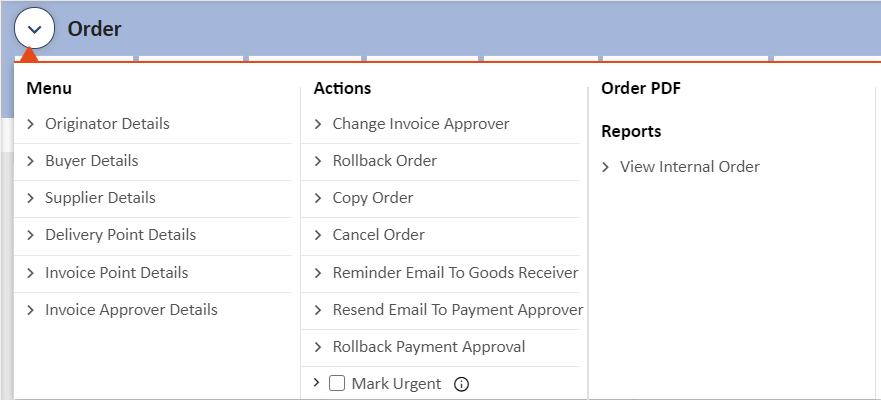
You can Rollback the order - This function will change the order status from Received/ Partial/ Closed to Issued and delete all associated Goods Received records. You can only Rollback Orders at RECEIVED, PARTIAL, and CLOSED status.
(Note:-The order(s) which has issued credit notes against some items cannot be rollback.)
(Note:- If the GR Invoice Mandatory switch is enabled and user Rollback the order then this function will change the order status to 'Issued' and delete all associated Goods Received records and Invoice attached)
16. When the Invoice status is INVOICE PENDING/ INVOICE REJECTED/ , the user will see the 'Rollback Order' option in the menu.
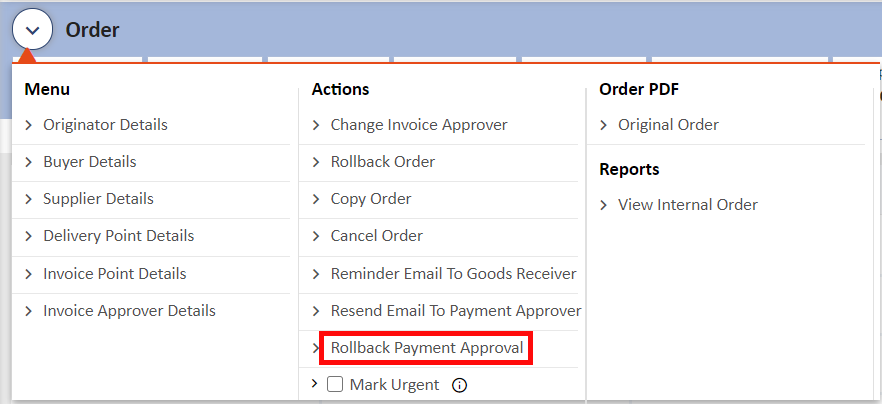
17. A Quick Order can be created as well wherein a buyer or senior buyer can directly create an order without creating a request first. The process for the order will work in the same way as mentioned above. You will need to add items, add approvers if the order split value exceeds the cost centre or group approval limits, add details and submit for approval. To create a Quick Order, click on “Add New” on the Order Listing page.
18. There is one more option on the Order Listing page which is that you can create an order specifically for a punchout item. To do so, click on“Add a New Punchout Order”. For this order, you need to select the supplier first from the list available (list will only show punchout suppliers). Once a supplier is selected, you need to click on “Add Punchout Items” which will take you to the selected supplier’s website. Add the items you need to the cart and when you checkout, the items will show as line items on the order. The rest of the process stays the same.
Note : The options for Catalog Item and Add Text Item will not be available when you create a punchout order.
19. In the system administration section under Invoice and Payments-> Order-Invoice section, switch the Order-Invoice button to 'Yes'.

In the main application under Orders, the user can view the 'Create Order From Invoice' link in the 'Add New' dropdown as shown below.

Upload an invoice pdf file and click on 'Upload Invoice PDF' as shown below

The system will read the pdf, extract the invoice number, invoice amount, supplier name, invoice date, and Item count, and will display it on the screen. Once the user has verified the details, click on the 'Create Order' button.

Once the user has clicked on the 'Create Order' button, an UNISSUED order will be created with the extracted information as shown in screen 24.Click on the 'Confirm Order' button, the user can see the pop-up as shown in screen 25.


Once the user clicks on 'OK', the order status will be updated to 'Issued' and the invoice(s) will be created for all the items. The Invoice status will change to 'Fully Invoiced'.

Note : If the invoice approver button is switch to 'Yes' and when the user clicks on 'Confirm Order', the system will send an invoice(s) for approval. Once the invoice approver approves the invoice, the invoice status will change to 'Fully Invoiced'.
Rule Approval
To begin with 'Rule Approval', the user should first check if the 'Activate Rule Approval' button is switched to 'Yes'. This can be seen under the System Approval->Set System Approval Rules section in the System Administration. Also, a rule should be added in the 'Set System Approval Rules'.
The following is the 'Rule Approval' process on the order. The process remains the same for Request.
We have switched the 'Auto Populate Rule Approver(s)' and 'Delete Rule Approver(s)' buttons to 'Yes' in the System Administration section as shown in the OrderScreen-28.

We have created a rule called 'Order Rule 1' in the system administration section. This rule has 3 criteria a) Buyer name = John Smith, b) Category code= Architectural, c) Order Value > (greater than) 100. As all the three criteria of the rule are selected in order, the rule 'Order Rule 1' is populated in the 'Rule' tab as shown in OrderScreen-29 .

As the 'Auto Populate Rule Approver(s)' and 'Delete Rule Approver(s)' buttons are switched to 'Yes' in the system administration section, the user can view the rule approver(s) loaded automatically in the 'Rule Approver' tab. Also, users can delete the populated approver(s) by clicking on the 'Delete' icon as shown in the OrderScreen-30.
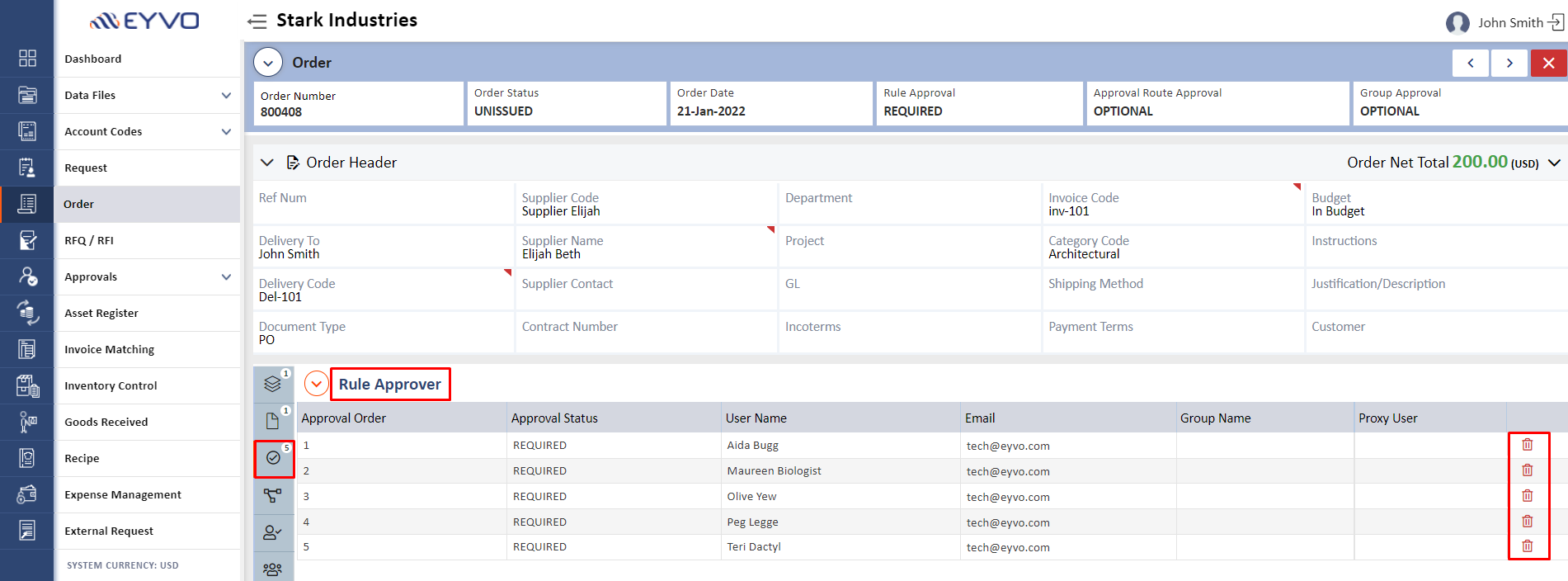
Users can also click on the 'Select Rule Approvers' menu as shown in OrderScreen-31(A). On the 'Select Approver(s)' screen, the user can select or deselect the populated approver(s) and click on 'Update' as shown below in the OrderScreen-31(B).
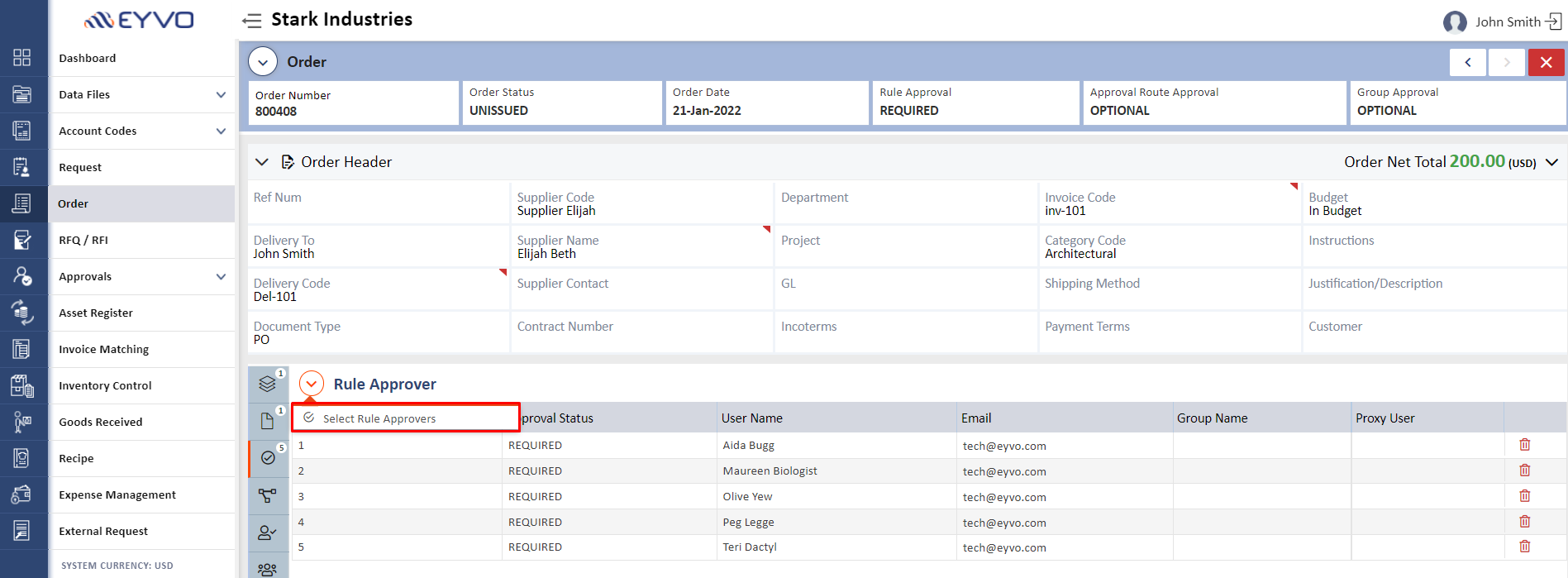
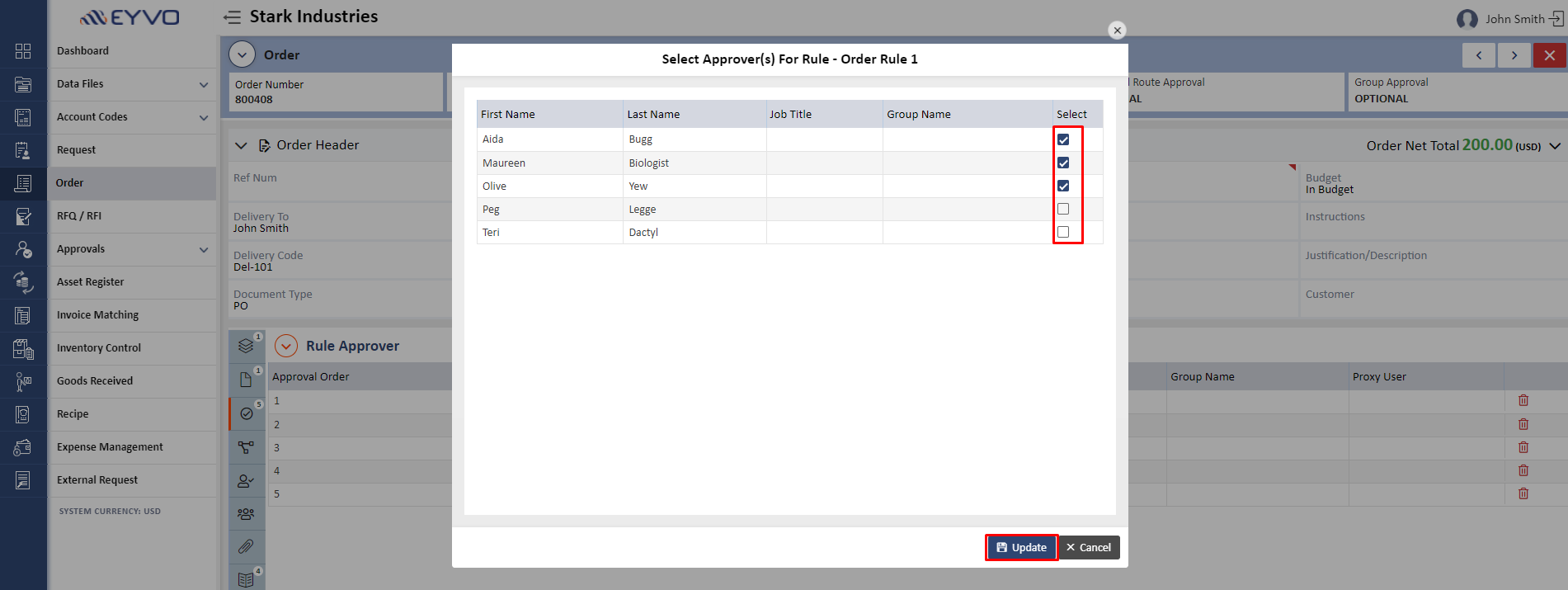
Note: When the 'Auto Populate Rule Approver(s)' button is switched to 'No', the user has to manually select the rule approver by clicking on the 'Select Rule Approvers' menu. Also, when the 'Delete Rule Approver(s)' button is switched to 'No', the user will not be able to view the delete option in the 'Rule Approver' tab.
After selecting the rule approver(s), click on the 'Submit for Approval' button as shown in the OrderScreen-32. An email for approval will be fired to the first rule approver.
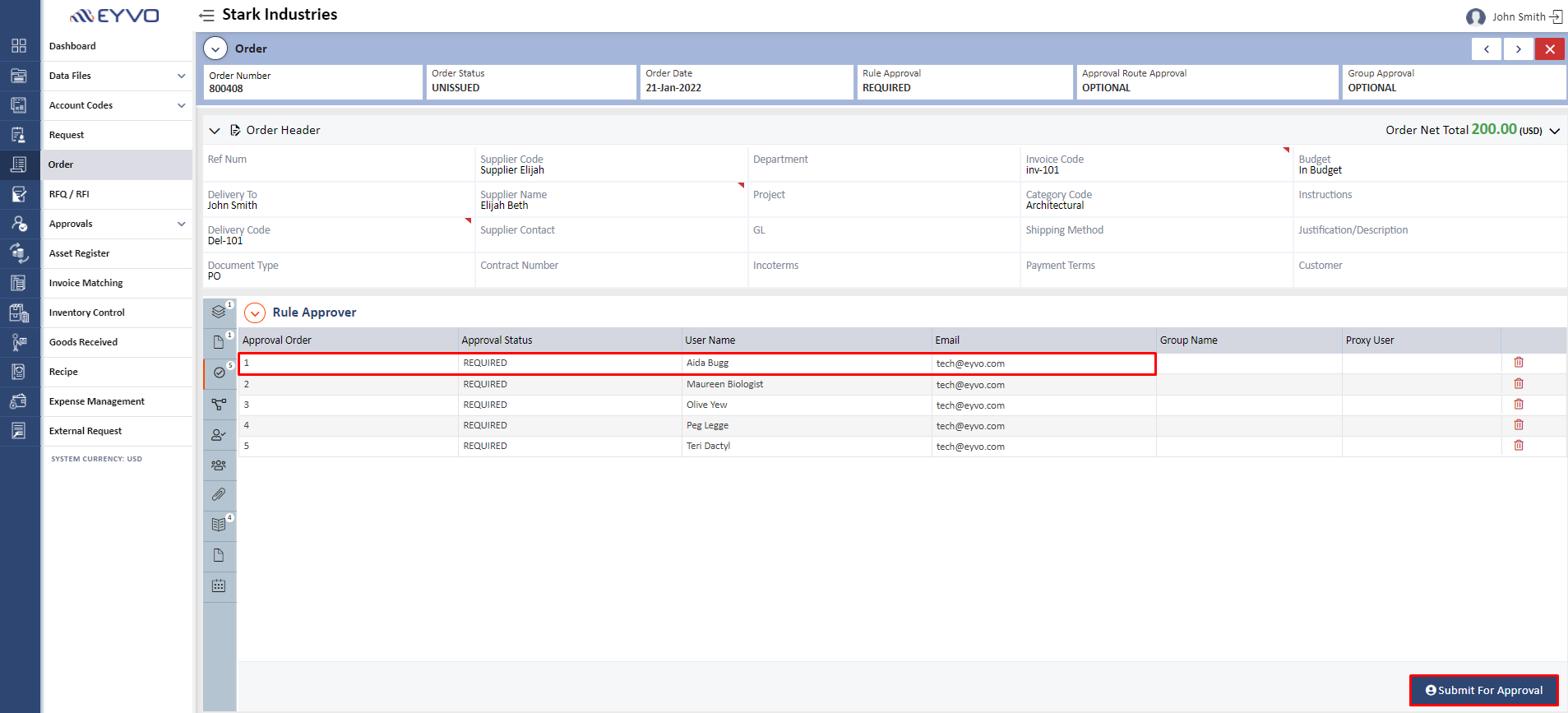
Once the order is submitted for approval, the Order Status will change from 'Unissued' to 'Pending'. Similarly, the Rule Approval status seen above the order header will change from 'Required' to 'Pending'. Also, the Approval status seen in the Rule Approver tab will change from 'Required' to 'Pending'. Users can also resend the rule approval email by clicking on the 'Re-submit for Approval' icon as shown in the OrderScreen-33.

The rule approver can approve/reject the order using one of the following ways: 1) Email- The rule approver can approve/reject the order by clicking on the 'Approve' or 'Reject' buttons. The approver can also click on 'Click Here' to view order details and then 'Approve' or 'Reject' the order as shown in the OrderScreen-34.
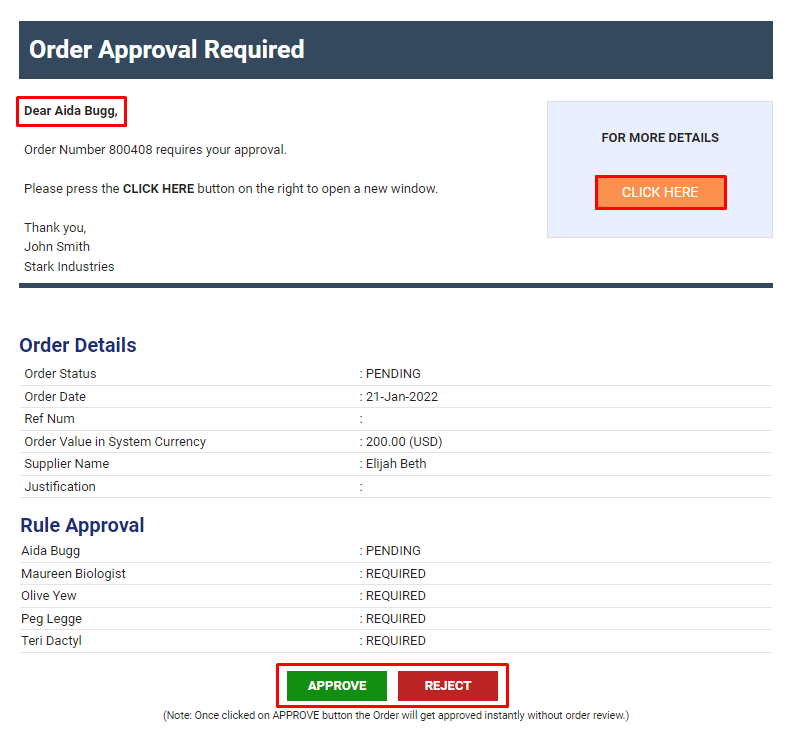
2) Dashboard- The rule approver should login to the main application. On the dashboard under the 'My Awaiting Approval' section, the approver can click on the order as shown in the OrderScreen-35. After clicking on the order, the approver will be redirected to the 'Approvals->Order Approval' tab. The user can then click on the 'Approve' or 'Reject' button.
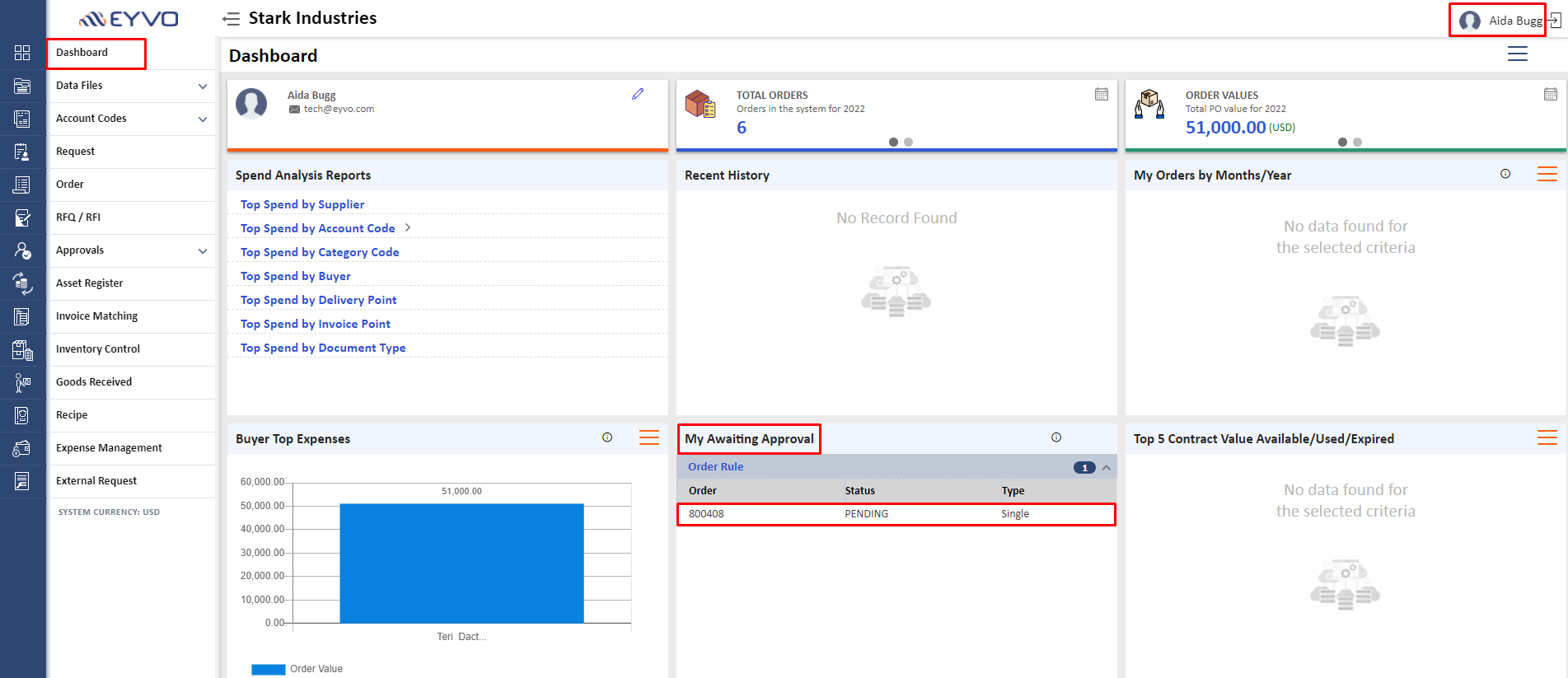
3) Approvals tab- The approver can also directly click on the 'Order Approval' in the 'Approvals' tab. Click on the order and then click on the 'Approve' or 'Reject' button as shown in the OrderScreen-36.
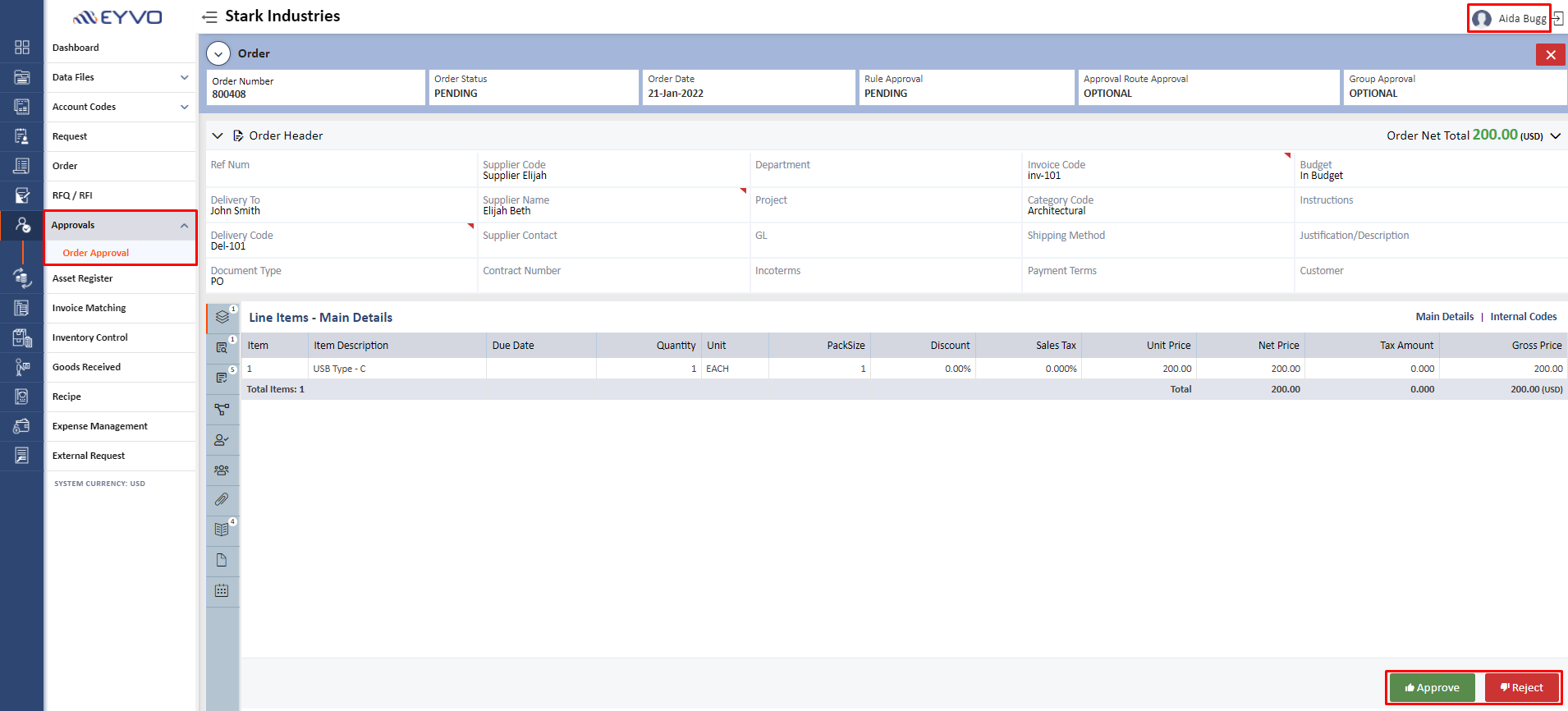
Once all the Rule approvers have approved the order, users can view the Order Status has changed from 'Pending' to 'Approved'. Similarly, the Rule Approval status seen above the order header will be changed from 'Pending' to 'Approved'. Also, the Approval status seen in the Rule Approver tab will be changed from 'Pending' to ' Granted'.
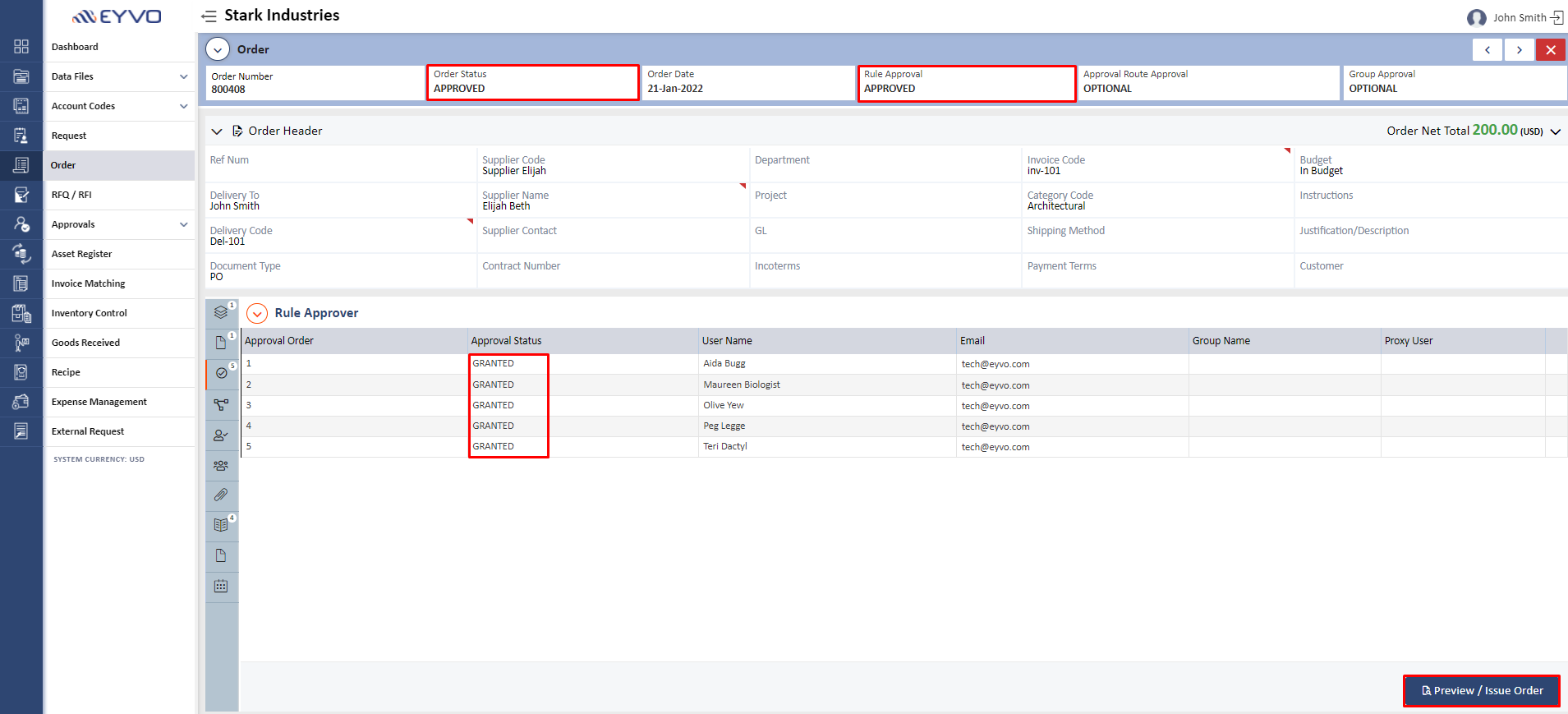
Click on the 'Preview/Issue Order' button to issue the order. After this, the Order Status will change from 'Approved' to 'Issued'as shown in the OrderScreen-37 .
Set As Template
i. A new feature 'Set As Template' is added to the 'UNISSUED' status under the Order section. This feature enables the user to set the Order as a template.
ii. When the user clicks on set as a template, the user will get an alert pop-up, click on OK to continue.
iii. When you set a Order as a Template, its Order status will be changed to TEMPLATE and the mandatory checks for all the fields will be removed. Also, the approval buttons will be disabled as the Order cannot be processed further. You can also copy this template to create new Order.
iv. Users can Rollback the Template to UNISSUED by clicking on the Template Rollback option as shown on the OrderScreen-41. After clicking on Template Rollback, the user will get an alert pop-up, click on OK to continue as shown on the OrderScreen-42.
v. When you Rollback a template, its status will change to UNISSUED and all the data will remain intact. All the mandatory fields will be enabled and the order can be processed further.
TOLERANCE
Tolerance is used to determine the acceptable range of variation from the specified requirements of a procurement process. Tolerance levels can be set for various aspects of the procurement process such as:
a. Quantity Tolerance: This refers to the allowable deviation from the specified quantity of goods or services being procured. For example, a buyer may specify a tolerance level of 5% for the quantity of goods to be delivered, meaning that the supplier can deliver up to 5% more or less than the specified quantity.
b. Price Tolerance: This refers to the allowable deviation from the specified price for the goods or services being procured. For example, a buyer may specify a price tolerance of 3%, meaning that the supplier can quote a price up to 3% higher or lower than the specified price.
In ebuyerAssist(eBA) application, we can set excess tolerance levels for four Order Statuses, including Amended, Approved, Good Received (GR), and Invoice. As an example, we will illustrate the tolerance level for invoices.
Excess Tolerance at Approved status: Setting an excess tolerance for approved status enables the user to create an order for an amount higher than the requested value, eliminating the need for an approval process. However, if the order amount exceeds the defined excess tolerance, the system will require the approval process to be completed again.
1. To set the excess tolerance for orders which are in approved status, the user needs to log in to the System Administration and navigate to the Order > Set Excess Tolerance tab. In this section, the excess tolerance for approved orders can be specified, which in this case is 5% as shown in the screen below:
Note: The user can set the excess tolerance either as a 'value' or a '%' in the system. If the excess tolerance is set as a percentage, the system will apply the tolerance based on the order's total value. On the other hand, if the excess tolerance is set as a 'value', the system will apply the tolerance when the specified value is exceeded.
2. Consider an order with one item: 'Raw materials' with a net price of 100, along with a 10% tax on the item as illustrated in the screen below:
3. After the order has been approved, the user can create an order of 105, which is 5% of the order's total net value. To achieve this, the user must select the corresponding line item and increase the unit price accordingly. The user can either add the entire excess value to a single item or divide it between one or more items, as demonstrated in the screens OrderScreen-46 & OrderScreen-47.
4. When the user enters a value that exceeds the designated excess tolerance (e.g., entering 106) and clicks the 'Save' button, an 'ALERT' message will be displayed, as shown in the screen below:
5. After clicking 'Ok' on the alert message, the user is now able to generate an order with a total gross price of 116.60. This calculation is derived from the total net price of 106, incorporating a 10% tax as shown in the screen below:
6. The user can now Re-submit the order for approval, which is illustrated in the screen below:
7. After receiving approval from the respective approvers, the order will be seen in the 'Issued' status when the user clicks on the "Preview/Issue Order" button, as shown in the screen below:
Excess Tolerance at Amended status: Setting an excess tolerance for the amended status, users can create orders with amounts exceeding the requested value without undergoing an approval process. However, if a user attempts to create an order surpassing the designated excess tolerance value, the system will prompt them to complete the approval process once again.
To set the excess tolerance for orders which are in amended status, the user needs to log in to the System Administration and navigate to the Order > Set Excess Tolerance tab. In this section, the excess tolerance for amended orders can be specified, which in this case is 5% as shown in the screen below:
8. When the order status is 'Issued', the user can select the "Amend Order" option from the order's menu. Once chosen, the order status will change to 'Amended', as shown in the screens OrderScreen-52 & OrderScreen-53.
9. The displayed order below consists of a single item named 'Raw materials' with a net price of 106 and a 10% tax applied to the item.
10. The user can create an order of 111, which is 5% of the order's total net value. To achieve this, the user must select the corresponding line item and increase the unit price accordingly. The user can either add the entire excess value to a single item or divide it between one or more items, as demonstrated in the screens OrderScreen-55 & OrderScreen-56.
11. When the user enters a value that exceeds the designated excess tolerance (e.g., entering 112) and clicks the 'Save' button, an 'ALERT' message will be displayed, as shown in the screen below:
12. After clicking 'Ok' on the alert message, the user is now able to generate an order with a total gross price of 123.20. This calculation is derived from the total net price of 112, incorporating a 5% tax as shown in the screen below:
13. The user can now view the 'Re-submit for Approval' button. By clicking on it, the system will once again prompt the approvers to review and approve the order. Once the order has received approval from the approvers, its status will be displayed as 'Approved'. Furthermore, the order can be issued by selecting the 'Issue/Preview Order' option, resulting in the order status changing to 'Issued'
Excess Tolerance at Invoice: Setting an excess tolerance for invoices enables the user to create an invoice for an amount higher than the requested value.
1. To set the excess tolerance for invoices, the user needs to log in to the System Administration and navigate to the Order > Set Excess Tolerance tab. In this section, the excess tolerance for invoices can be specified, which in this case is 7% as shown in the screen below:
Note: The user can set the excess tolerance either as a 'value' or a '%' in the system. If the excess tolerance is set as a percentage, the system will apply the tolerance based on the order's total value. On the other hand, if the excess tolerance is set as a 'value', the system will apply the tolerance when the specified value is exceeded.
2. Consider an order that has been issued with two items: 'USB Flash Drive' with a net price of 400 and 'USB Keyboard' with a net price of 300, along with a 5% tax on both items as illustrated in the screen below:
3. After the order has been issued, the user can create an invoice of 749, which is 7% of the order's total net value. To achieve this, the user must select the corresponding line item and increase the unit price accordingly. The user can either add the entire excess value to a single item or divide it between both items, as demonstrated in the screen below:
4. If the user attempts to enter a value that exceeds the specified excess tolerance (e.g., entering 450), and clicks the 'Save' button, a validation message will appear stating: "Total item price exceeds the invoice excess tolerance of 7.00%," which is illustrated in the screen below:
5. The user can now create an invoice with a total gross price of 786.45, which is calculated based on the total net price of 749 and a 5% tax. This is illustrated in the screen below:
Note: After the order has been issued, the user can also apply excess tolerance on goods received (GR) by adding more quantities to the order.
Order punchout Process
1. Navigate to "Order" and select "Add New Punchout Order" from the menu.
2. A Punchout Order will be generated, which is similar to a regular order. However, you will only see Punchout Suppliers listed when you click on the header and select the supplier.
3. Ensure you select the correct Delivery Point and Invoice Point on the order header, as these details will be transmitted to the punchout supplier.
4. Under Line Items, click on the menu and choose "Add Punchout Items". This action will open a punchout popup. If the popup doesn't appear, please review your browser's popup blocker settings and grant permission. See below screenshots.
Select "Always allow popups…"
5. Once the punchout popup window is open, select items from the punchout card and proceed to CHECK OUT.
6. The punchout window closes, and the selected items are loaded onto the order.
7. When you issue the order, click the "Issue, Save & Punchout PO" button. This option will send the punchout details to the supplier, and your order will be issued.
8. To verify that the punchout was successfully issued, check the event log and click "View Punchout Response". If the status code displays as "200," it indicates that the punchout was sent to the supplier successfully.
ORDER QUICK LINKS I REPORTS:
The following can be found on the Order Listing Page under Quick Links I Reports:
QUICK LINKS :
a. Orders – All – This will sort the listing page so that all orders are shown to you.
b. Orders – Personal – This will sort the listing page in such a way that only your own created orders are shown to you.
c. Orders – Archived – This section displays the orders that have been archived.
REPORTS :
a. Order Listing Report – This report displays all the orders listed on the order listing page. The fields included in the report are Order Number, Order Status, Order Date, Justification/Description, Order Value (in both Supplier and Base currency), and Supplier Name as shown in the screen below:
b. Order Management Report – This report can be generated using 3 criteria’s as shown below:
-
Order Header + Line will show all the details of the order header and line items as shown below:
-
In the same way, selecting only order header will show the order header details and the selected order line will show line item details.
Checking the box for supplier currency will show the currency on the reports in the supplier’s currency. When the box is unchecked, the currency shows in the base currency of the system.
Note: In some reports, users can view the 'Export to Excel' option, which allows them to download the report in Excel format as shown below:
c. Deliveries Report – This report will display orders and their corresponding line items that have not yet been received. The report will include all item due dates that have passed, those that are currently due, and those that are yet to expire. The report will only show orders with the Issued, Partial, and Amended statuses. The fields that will be included in the report are Delivery name, order number, item description, balance quantity, item due date, supplier name, supplier telephone, and supplier email.
Note: Any line item in the order that does not have an item due date will not be included in the report.
d. Deliveries Overdue Report – This report will show only those orders with their line item(s) which have still not been received and crossed the item's due date limit. The order statuses which will be seen in the report can be Issued, Partial, and Amended. This report will show the fields such as Delivery Name, Order Number, Description, Balance Owed, Due Date, Supplier Name, Supplier Telephone, and Supplier Email as shown in the below screen:
Note: Any line item in the order that does not have an item due date will not be included in the report.
e. Order Accrual Report – This report shows the Accrual Amount of an item which is calculated by subtracting the value of 'Amount paid' from the value of 'Item Gross Price' and at the end shows the Accrual Amount of 'Order Sub Total'. This report will show only those orders which have statuses such as Issued, Partial, Closed, and Amended. This report will show the fields such as Order Number, Order Date, Order Status, Supplier Name, Item Number, Item Value(A), Invoiced Values, Amount Paid(B), Accrual Amount(A-B) as shown in the below screen:
f. Order Invoice - Payment Report – This report shows the details of invoice payment whether the payment has been done or not. The Invoice payment details are shown item-wise. Here the user can see the fields related to the order header such as Order Number, Order Status, Order Date, Issued Date, Payment Status, Buyer, and Supplier, and can see the fields related to the item(s) such as Item, Description, Quantity, Discount, Unit Price, Net Price, Gross Price, Invoiced Value, Paid Value as shown in the screen below:
g. Negotiated Savings report – This report will show the savings on your orders. You could narrow the search by entering the start and end date and further by selecting the Buyer Name, Supplier Code and Category Code as shown below:
h. Cost Code Approval Report – This report shows only those orders which have Cost Code Approver(s) selected in the order's 'Cost Code Approval' tab whether approver statuses are Required, Pending, Granted, or Rejected. The report will show the fields such as Order Number, Order Status, Order Date, Order Value, Approver Name, and User Approval Status as shown in the screen below:
Note: The user can view a specific Approver's details by selecting the approver name and approver status from the 'Select Approver' pop-up. Also, the user can click on the 'Import to Excel' icon to directly download the searched data in Excel as shown in the screen below:
i. Group Approval Report – This report shows only those orders which have group approver(s) selected in the order's 'Group Approvers' tab whether approver(s) statuses are Required, Pending, Granted, or Rejected. The approver's name will be seen only for those orders whose group approval status is Granted or Rejected. The report will show the fields such as Order Number, Order Status, Order Date, Order Value, Approver Name, and User Approval Status as shown in the screen below:
Note: The user can view a specific Approver's details by selecting the approver name and approver status from the 'Select Approver' pop-up. Also, the user can click on the 'Import to Excel' icon to directly download the searched data in Excel as shown in the screen below:
j. View Log Details – This report presents information about the Add/Edit/Delete actions performed by the user within the Order module. It includes fields such as Logged Date, Logged By and Event as shown in the screen below:
k. Goods Received Not Invoiced (GRNI) – This report will show only those orders whose item(s) are received but not invoiced. For example: If an order has an item with a gross price of 110 and the user has received that item with a total value of 110 but logged an invoice with the amount of 50 only. In this case, the report will show the item with a pending value of 60. The report will show Order header related fields such as Order Number, Order Date, Order Status, and Supplier and item(s) related fields such as item Description, Gross Item price, Received Value, Invoice Value, and Pending Value as shown in the screen below:
- All the reports mentioned can be exported to a PDF, Excel, Word, HTML or RTF and can be printed or emailed as shown on the below screen:

